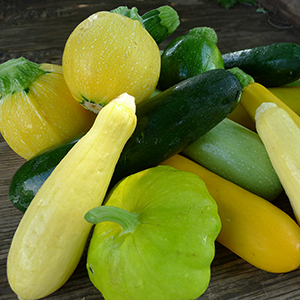
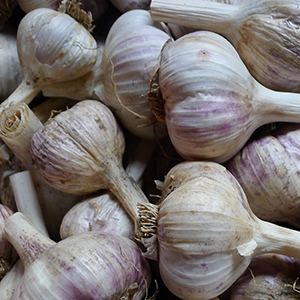
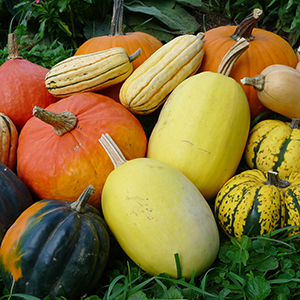

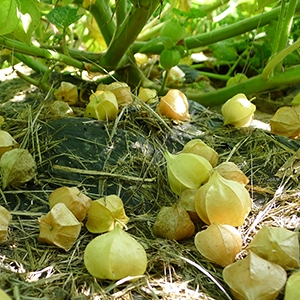
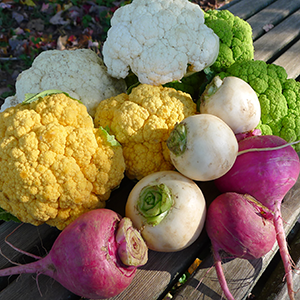
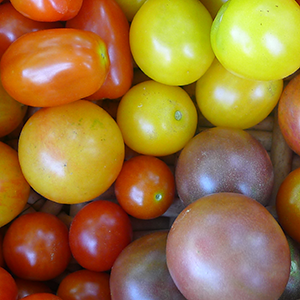



News and Notes | The Anchor Run Blog
Posts Filtered by Type - Notes From The Field |
Show Recent Posts
April 1, 2025
Spring Has Sprung
by Farmer Derek
Spring Has Sprung
by Farmer Derek

Snow peas please! Incorporating a cover crop mix of oats and clover on the 'off' beds in the pea patch.
The growing season began the final week of February with a couple days of seeding in the greenhouse and interior ground preparation in our tunnels.
The first week of seeding is probably the greatest of the season with almost 100,000 seeds sown. With nearly 100% of our crops started in the greenhouse, seeding weekly will run through early September. Even though it was cold and frozen outside, we were able to begin preparing the soil in our four growing structures for early season crops of lettuce mix, greens, and herbs. We had about three weeks to prepare these spaces. Overwintered crops had to be manually hoed a couple of times. In three of the tunnels I'm able to use the tractor for final preparation, so in those spaces we just needed to make sure most of the plants wouldn't survive and reroot. In the fourth tunnel bed prep had to be done completely manually, so besides hoeing, we also had to fork to deeply loosen and rake to clean up and structure the beds.
Into these infinitely valuable spaces were planted cilantro, dill, parsley, kale, arugula, komatsuna, radishes, turnips, bok choy, and lettuce mix.

Farmer Gabby and crew busy planting so, so much.
Planting inside and outside happened last week, on schedule and ahead of schedule, respectively.
Growing in protected spaces basically removes the most challenging uncontrollable variable from farming, the weather. Growing outside in the springtime, however, can be particularly difficult. Soil typically warms up and dries out slowly, condensing/compressing time we have available to get planting spaces ready as well as actually transplanting crops. Any window of dry weather means racing around, doing as much tractor work as possible, preparing ground to accept crops. I normally begin prep about four weeks ahead of planting time. Ground needs to be opened up with the chisel plow which helps it warm up and dry out. Next up is a pass with our 'primary shaper', a disk bedder, that mounds the soil in rows, helping it warm up and dry out even more. A final pass or two is done with our 'final shaper' that levels the beds to a height of about eight inches. With each pass of shaping I deposit soil amendments in the form of organic minerals and fertilizers. Having a rain event between each pass is actually helpful. It stimulates weeds to germinate as well as invigorates soil bacteria which help break down/digest organic matter in the soil.
With outdoor space ready to go, and anticipating a wet start to April, we hustled last week and transplanted snow peas, head lettuce, romaine, radicchio, escarole, chard, beets, fennel, cilantro, dill, kale, cabbage, kohlrabi, radishes, turnips, arugula, bok choy, and komatsuna.

Direct seeding carrots, the only crop we start this way. Everything else is seeded in the greenhouse, except for strawberries, potatoes, and sweet potatoes, whose mother plants come from off-farm and go right in the soil.

November 11, 2024
Cover Cropped, Composted, Complete
by Farmer Derek
Cover Cropped, Composted, Complete
by Farmer Derek

Broadcasting the final round of cover crop seeds in anticipation of last night's rain event.
Thanks to the warm and dry autumn, this is the first growing season where we've been able to sow cover crops and spread compost over 100% of the farm. This time of year fields are normally too moist to drive machinery in and/or temperatures are too low to guarantee decent seed germination so we simply leave crop residue to keep the soil protected over the winter. This season, however, has been quite an anomaly, at least precipitation-wise. We always try to cover as much of the farm as possible in compost and plants but are often limited by uncontrollable factors. Last week, after we finished the harvesting of field crops, we mowed, spread compost, chisel-plowed, broadcast the cover crop mix, then disked it in. About 300 pounds of winter rye, oats, hairy vetch, and crimson clover was sown over an acre of field space that was home to the fall crops we've been receiving for the past couple of months. Hopefully last night's .35" of rain plus any residual soil moisture from irrigation is enough to wake up the sown seeds.
Soon, we'll turn the page on this season and begin planning (and planting) for 2025. But for now, we reflect on this season and are most thankful for and appreciative of our wonderful crew of farmers, Alex, Andrea, Connor, Craig, and Gabby, who are amazingly hard working and importantly are good folks to work with. Our supportive membership, thank you for allowing us to grow healthy produce for you and your family.
Want produce after the official CSA season is over? Look for an e-mail announcing flash share sales at some point later this month and December. Once harvest is concluded this week, we'll take stock of tunnel greens and storage produce and will base our plan off of that.

Hand-mixed, customized cover crop blend of winter rye, oats, crimson clover, and hairy vetch.

November 4, 2024
Nearing the Finish Line
by Farmer Derek
Nearing the Finish Line
by Farmer Derek

Mulching the 2025 garlic patch.
I don't think it's fully sunk in yet that we're near the end of the 2024 CSA harvest season. It's such a long and fully enveloping, immersive ride. Beginning with seeding in the greenhouse in late February, doing so weekly through mid-September; preparing and planting in the ground in the tunnels in late March and outside in early April, doing so weekly through early-October; harvesting early-May through mid-November; caring for living creatures nonstop for almost 9 months. It's a very tight and all-encompassing connection, sometimes overwhelming. At the conclusion of harvest week 28 a weighted feeling departs, a release of joy but also something else. Making it through successfully is an accomplishment for sure, especially so with this driest of seasons. It's a team effort and we're grateful for our awesome staff of farmers as well as the overall support of our members, both in the field physically but also for the sense of community embodied in this style of farming. So thank you, everyone, who is part of this project where we're trying to nurture ourselves and this ecosystem through the growing of healthy food.

First time for everything: adding water to the garlic patch.

October 28, 2024
Exiting October
by Farmer Derek
Exiting October
by Farmer Derek

Fall scene.
Today we began planting the saved garlic cloves into some very dry soil. Our garlic has been saved annually since 2004 and is now a unique variety, or a unique mix of varieties because they're technically clone cloves and aren't mixing genes. We do set aside the biggest bulbs to split into seed so we're influencing it that way.
Each season we aim to increase the amount of garlic planted for the following season's harvest. This year we're adding about 500' more, increasing from 3000' to 3500' total. That's about 21,000 cloves to plant, or 425 pounds. After each clove is tucked into the soil, we'll cover the entire area with a thick layer of straw. For the first time ever, we may even need to add water to ensure the cloves wake up and break dormancy sooner rather than later.
Speaking of moisture, this will be the first time in 16 seasons I'll be entering a '0' for precipitation total for a calendar month. For comparison's sake, during the April-October timeframe, this season the rain we received was 20" less than last season and 15" less than our 16-year average. Pretty astounding if you ask me. However, the silver lining is that the crops have been thriving with regular well-water drinks and we've had less pest and disease pressure overall. Assuming it will rain again at some point, maybe we'll catch up on the deficit this fall and winter.

Fall carrot patch.

October 21, 2024
October Trials and Tribulations
by Farmer Derek
October Trials and Tribulations
by Farmer Derek

It's a good time to spread compost around the farm.
We're now down to the final four weeks of our 28-week Main Season CSA. It's an interesting time. Fields are really emptying out now as we officially say goodbye to the last of the summer crops, continuously harvest weekly planted lettuces and greens, and retrieve the last of the various roots and storage crops. Now, we can almost perfectly map out the remaining weeks of CSA distribution, barring any unforeseen strange weather surprises. Though even with that we've taken various precautions, like planning for the last couple of weeks of harvested greens to come out of the protective high/hoop/cat tunnels. With regular watering, crops are thriving.
Last Thursday morning gave us our first widespread frost, heavy enough that we had to delay harvesting until almost 9am, but without any damage to crops. Now we have to deal with highs in the mid-80s. Go figure. No rain is in sight, so this October may be the first calendar month in 16 seasons without any recorded rainfall at the farm.

October 14, 2024
First Frosts
by Farmer Derek
First Frosts
by Farmer Derek

Farmer Connor with a full basket of cauliflower.
Late last week, just prior to the weekend warmup, we received the first light frost of the fall season, and are forecast to have a run of frosty mornings this week. Frosts that occur when lows are in the mid to upper 30s are relatively insignificant for most of what we're growing this time of year. The only summer crops still out in the field right now are sweet, hot, and shishito peppers. We harvested them and the eggplant pretty hard last week in anticipation of these cold temperatures. If the peppers remain unscathed, on Wednesday we'll probably do one final harvest before they're mown and incorporated into the soil. We'll then try to establish a cover crop of rye or oats but that's a challenge without rainfall. Either way we'll add compost and enrich the soil that way.
The fall crops in the field should actually improve in flavor with a few light frosts as they convert starches to sugars to better deal with the cold. Most of these crops aren't bothered by cold until it drops into the upper 20s with a hard frost. Freezing cold plus wind is probably the hardest for crops to tolerate. Some of the more tender greens like lettuce, arugula, and bok choy would be the first to show any frost burn. Typically, we receive our first light frosts of the season in mid-October and hard frosts/freezes in early November. Obviously every season is different and it looks like it is going to warm up again this coming weekend.

October 7, 2024
Fall Colors
by Farmer Derek
Fall Colors
by Farmer Derek

Farmers Gabby and Andrea harvesting sweet potatoes.
The biggest piece of news from last week at the farm was the successful completion of the sweet potato harvest, amazingly completed in one work day with staff and CSA members. I'm not sure what's more remarkable, the quality or the quantity of the tubers. Even during our driest of growing seasons, the unirrigated sweet potatoes still managed to bulk up and achieve that quintessential sweet potato size and shape. Besides the occasional mammal-munched root, they're healthy and blemish-free. Now, the 8,000lbs or so of sweets will 'cure' in a warm humid room where they'll heal and convert starch to sugar. We'll test them in a couple of weeks to see if they're sweet enough to eat and will plan to distribute them during the final four weeks of the season.
It's also time to thank your luck stars, give in to the vagaries of farming and the ebb and flow of moisture. Behold, broccoli and cauliflower appear to have made a triumphant return to shares. Perhaps just an average amount will be available; we won't know for sure until we begin harvesting them this week. But during a cursory walk-through the patch yesterday, elevated florets were abundant on the broccoli and emerging white corals were numerous in the cauliflower. Dry and cool weather, consistent irrigation, and good fertility have enabled the patch to remain mostly pest and disease free and now hopefully productive. These are fickle crops for us that we can't rely on every single year the way we can others. Thus, rejoice!

September 30, 2024
Quantifiable Drizzle
by Farmer Derek
Quantifiable Drizzle
by Farmer Derek

Transplanting arugula, bok choy, and kale in the uphill plot of the movable high tunnel.
Moisture has finally condensed enough to descend as droplets of water at the farm. I believe most of the measurable rain fell with a boost from Helene on Friday. Now we're starved for some sunshine.
The farm's crop habitat is steadily shrinking. Now that we're about to enter October we'll begin a slow march away from the summer staples of tomatoes, sweet and hot peppers, and eggplant. There's still a lot of fruit out there so we'll enjoy them in our harvests for a few more weeks at least. Most of the peppers and tomatoes will be harvested green but left at room temperature can slowly ripen.
We'll also continue our transition to traditional big fall brassicas. Last week we introduced napa/chinese cabbage and soon regular cabbage, broccoli, and cauliflower will grace the pick up room. A mix of traditional fall roots like radishes, daikons, turnips, kohlrabi, beets, potatoes, and eventually sweet potatoes should be in shares through the end of the season. Cooking greens, like kale, chard, and bok choy, as well as salad greens, like radicchio, head lettuce, romaine, lettuce mix, and arugula, will be here until the end as well.
With our dwindling footprint comes field clean up and establishment of cover crops to protect and enrich the soil over the offseason. This rainfall was very much needed to encourage germination and continued growth of the oat, clover, and buckwheat mix. We probably have one more opportunity to sow this mix then will transition to winter rye and hairy vetch in the latter half of October.
In case you're keeping track, this was our driest September in 16 seasons with .75" received, 4" below our average.

September 23, 2024
Officially Fall, Officially Dry
by Farmer Derek
Officially Fall, Officially Dry
by Farmer Derek

Spreading compost on the future garlic patch.
We've now officially entered many farmers' favorite season, autumn. Temperatures are cooler, days are shorter, the sun is lower in the sky, planting is just about over, harvests are rolling in, and fields are being put to sleep. The appearance of fall seems to have begun early this year, most likely due to the shortage of rain. The pattern continues: rain is forecast, then a day or two prior to arrival, probability and amount shrink, then disappear altogether. If anyone knows of an article explaining this overall weather conundrum, please share. In the past six weeks we've enjoyed a total of a 1/2-inch of rain. All the crops are doing well, though, but the newly seeded cover crops could sure use a drink. Sweet potatoes are the one crop that isn't irrigated and I haven't dug any up yet to check their status. It's almost time to harvest them so we'll find out soon how they've faired during the driest of seasons. Often they blow my mind with what they can accomplish without much water so there is hope, especially considering the bumper crop of regular potatoes that apparently flourished in the absence of moisture.
Preparation is now underway for the very last planting of the season, garlic. This will actually be planted where winter squash grew this season. Since that is now out of the field we can apply compost and then chisel plow that in. Crop residue and the compost will have 5-6 weeks to break down before we plant the garlic. We'll make several passes with our bed shapers, depositing minerals and fertilizers as we create the ideal planting space. We're just about finished trimming and sorting the bulbs and in mid-October we'll begin separating bulbs into cloves for planting. Look for an e-mail announcing this workshift task. After planting approximately 21,000 cloves (422lbs), we'll smother them with a thick layer of straw to insulate the ground over the winter, suppress weeds next season, and maintain even moisture.


September 16, 2024
Summer's Final Week
by Farmer Derek
Summer's Final Week
by Farmer Derek

Didn't get much rain but at least we got a rainbow!
All of a sudden it's the middle of September and the autumnal equinox is less than a week away. We're hustling and bustling to clean up spent outdoor summer crops, spread compost, and sow cover crops before this coming week's forecast rain event(s). We're also in the process of removing indoor tomatoes and preparing those spaces for late fall greens, all of which have a strict plant by date (too early and they grow too fast and are more susceptible to cold, too late and they'll grow too slowly and may not mature in time). We're also busy running and installing needed irrigation (obviously) but are hoping for a reprieve this week. Some cloud water for the crops would be much appreciated, though they sure seem to enjoy the stuff that comes from 300' down.
The fields where our fall crops are planted do much better in dry conditions where we can regulate water and so far all those crops are thriving (higher clay content in soil, water drains more slowly, fields on the south side of the driveway). One interesting setback that seems to be worse than I can ever remember is cutworm damage to young crops planted over the past few weeks. Cutworms are basically just caterpillars from certain moth species that unfortunately wrap around the stems of plants and feed horizontally, severing the stem. They feed at night and bury in the soil during the day so they're hard to find to squash. It's hard to process another setback/challenge at the moment but we typically have an abundance of crops in the fall so hopefully the losses won't even be noticed a month or more from now.

September 9, 2024
Silver Lining
by Farmer Derek
Silver Lining
by Farmer Derek

Late evening in the brassica patch.
I think I write about the lack of rain in every newsletter. It sure feels that way! I just need to get used to these conditions; it's been going on for over three months now so it's nothing new. In the back of my mind I expect a pivot to wetter weather again, probably because we've endured plenty of that over the years. But my irrigation list/schedule is the longest it's ever been and, based on the forecast, will continue to grow. Luckily this time of year our footprint slowly shrinks and irrigating thirsty crops can now be accomplished over a 2-3 day stretch.
The very dry weather is also beneficial in some ways. For example, it's most likely suppressing disease organisms that favor moisture, such as the brassica pathogen that causes black rot. As of now, the big fall brassicas including broccoli, cauliflower, cabbage, and kale are looking their best. Hopefully that translates to a good harvest. Last season we lost almost all of our broccoli and cauliflower and I was beginning to contemplate skipping it entirely in future seasons if they didn't perform well this year. Healthy foliage is one thing; we need the florets/heads to stay healthy when they form a month from now.
Beets are another crop that is benefitting from dry weather. They can suffer from a foliar disease called cercospora that typically renders their leaves unharvestable which is why we mostly distribute only the roots. As of now their leaves look free of illness so we plan to give beets out in bunches with their leaves. Exciting!

The irrigation schedule has grown into its third column, right to left, slowly encroaching on the much shorter precipitation records.

September 2, 2024
Giving Back
by Farmer Derek
Giving Back
by Farmer Derek

Home to strawberries and peas earlier this season, now smothered in a soil-improving pollinator-loving ecosystem-enhancing cover crop mix of sunflowers, sunn hemp, buckwheat, and oats.
August has come to a quiet close. Wonderful weather is forecast to begin September. Where's all the rain though? The drought continues. We did receive 4.8" of rain in August, which sounds quite unbelievable. An extremely disproportionate amount fell in the span of a week, 4.3" in fact. So the total does feel misleading. Perhaps that moisture was slurped up and enjoyed at the time, but we could definitely use a bit more rain soon. Speaking of that week's wallop, whatever cover crops were growing at the time sure did take that water and make the most of it, quintupling in size, profusely flowering, now abuzz with pollinators. The magic below ground is probably even more impressive.
Now that our footprint is shrinking as land is being transferred from crops to fallow, it's a bit easier to manage the flow of water to irrigate the crops. One challenge, however, is a timely pushing of the pause button on that schedule to get in there with cultivating equipment to take out any germinated weeds while they're very small. Also, it being summer still, any weeds nestled right next to the crops that the hoes miss will enjoy the scheduled drinks of water as well and grow fast. They'll try to outcompete the wanted plants and it's our job to not let them become too much of a problem. Airflow and access to nutrients and sunlight would be the main issues. It's not really possible for us to completely remove the pressures of weeds but to instead find the maximum threshold our plants will tolerate. Ideally hoeing is all we'll need to do, but hand-weeding is obviously still used a lot on a small organic farm.

Skipper butterflies enjoy a sunflower pollen and/or nectar snack.

August 26, 2024
Dry, Again
by Farmer Derek
Dry, Again
by Farmer Derek

Fall crops in Field 2 are coming along nicely.
We're in the midst of another three week dry spell, albeit one with a few scattered sprinkles, and are trying to quickly install necessary irrigation infrastructure to thirsty fall crops. Fortunately most of these crops, including lettuce, romaine, radicchio, kale, cabbage, arugula, turnips, radishes, broccoli, cauliflower, beets, chard, celery, and carrots, are planted together in a few field spaces, which makes setting up the irrigation a lot easier. By the end of today, Monday, everything should have installed irrigation and have received a big drink from the tubes.
We're also within the final push to cultivate and weed all of these fields and are making steady progress. We're definitely in a good position now. The big fall brassicas (broccoli, cabbage, cauliflower, rutabaga) have been cultivated thoroughly twice and now just require a quick pass to pull weeds nestled too close to plants to remove with a hoe. Later rounds of fall transplants are in the process of being handweeded and should be wrapped up by the end of the week (with good workshift attendance). Next up is the big job of thoroughly handweeding the fall carrot patch. Carrots are always a challenge to grow (mostly due to slow germination and growth) but especially so when sowing in high summer when weeds germinate and grow rapidly. We need a little bit of moisture on those beds to enable more easier uprooting of the small weeds so we'll either supply that ourselves or wait for a rain event.
If you still have hours to work for your share discount, please consider doing so very soon. Opportunities will lessen as we move through September and October.

August 19, 2024
Blue to Green
by Farmer Derek
Blue to Green
by Farmer Derek

Sunrise over the Atlantic.
After eight days away with the kids, I'm back on the farm, back in the saddle. It's amazing to observe the changes of the farmscape after 4+ inches of rain from Debby followed by a week of sunshine. Most notably, weeds have germinated with a vengeance after a long dry dormancy, cover crops have had a growth spurt, and many crops, such as beans, edamame, zucchini, cucumber, watermelon, and cantaloupe wane from pest and disease pressures.
To me, August feels like a major transitional month, especially the latter half. The green sheen and abundant growth of summer fades into yellows and browns as traditional summer crops dwindle. Contrarily, sweet peppers seem to hit their full stride with glorious ripe fruits. Early fall greens like chard and arugula arrive and lettuces rebound. Daylength will quickly diminish as we approach the fall equinox, losing about one hour and forty minutes over the next month.
Make no mistake, the hustle and bustle of summer will continue. The last gasp of germinating weeds will be met head-on with our arsenal of tools. Big hauls of crops still need to be retrieved, including pie pumpkins, winter squash, and the rest of the potatoes. There's been an uptick in the amount of seeding in the greenhouse as we fill trays for the final few rounds of outdoor plants as well as all of the tunnels. After this current round of rain, spent crops will be mowed and incorporated and cover crops will be sown, nurturing the soil until we break ground again next season. The proverbial light is seen at the end of the tunnel, but it's still a long way off. Let's hope it's a smooth ride.

August 12, 2024
Recent Rainfall Rectifies
by Farmer Dana
Recent Rainfall Rectifies
by Farmer Dana

Field of greens luxuriating in the recently received abundance of moisture.
Well, I am pleased to announce that last week we were the happy recipients of 3.6 inches of rain, courtesy of Hurricane Debby. After an extended and brutal combination of heat and drought, the precipitation was a welcomed relief. All inhabitants of the farm, flora and fauna alike, are relishing the turn in weather events. Cover crops seeded weeks ago are really taking off, the trees and shrubs have perked up, and I've actually had to mow the grass. This is truly great timing as Derek and the kids will be away from the farm this week and I won't have to worry about irrigating field crops on top of other farm responsibilities.
If you can believe it, there is actually a small downside to the rain (leave it to a farmer to find fault in any weather). The cherry tomatoes, which have flourished under scheduled irrigation these last few months, are sustaining quite a bit of cracking due to the sudden increase in available water. The fruits are still deliciously edible, so we encourage you to enjoy them as you would non-cracked cherry tomatoes. The forecast looks stellar this week with highs in the low-mid 80's and no rain until possibly the weekend, so I suspect that the new ripening fruits on the vines will mature without cracking as we move through the week.
Speaking of stellar weather and being that it is the middle of August (!), Fall is on its way. Harvests will begin to reflect that over the next month starting this week with the arrival of swiss chard, like a small and cool light at the end of a very hot and dry tunnel. Enjoy and see you on the farm!

Finch finds a Fairy Ring while, in the background, a cover crop surges.

August 5, 2024
Incoming Inundation?
by Farmer Derek
Incoming Inundation?
by Farmer Derek

Seeding carrots before multiple days of forecast rain.
The perplexing precipitation pattern continued for us over this past weekend. Cumulatively, just over a quarter inch was received, which we're of course extremely thankful for. But we're also marveling at the befuddling shield over our location that has blocked meaningful rainfall for the past couple of months. There is a silver lining, however, if the current forecast holds true. With rain forecast to fall Tuesday afternoon through Saturday we only have a couple of days to accomplish outdoor tasks ahead of time. So, if we had received ample rain events from the rounds of thunderstorms that rolled through we may not have been able to transplant and cultivate and mow where we desperately need to.
We may luck out and finish what we need to before rain descends on Tuesday. Watermelon, cantaloupe, zucchini, cucumbers, and tomatoes require our farm crew 5 full hours of harvesting on Monday morning. After lunch, for four hours today we transplanted two rounds of arugula and lettuce, plus chard, radicchio, dandelion, hakurei turnips, kohlrabi, watermelon radishes, and purple daikons. Tomorrow we need to plant celery, kale, and napa cabbage. We also need to harvest bright and early for distribution, then cultivate a few thousand feet of beets, broccoli, cabbage, and cauliflower. If the weather gods allow, we'll also try to mow the 2025 strawberry patch. Then we can sit back and enjoy the wet stuff.

July 22, 2024
Carry That Weight
by Farmer Derek
Carry That Weight
by Farmer Derek

Rudbeckia delivering a scintillating visual experience.
Besides feeling good about some received rain, we're also stoked about some quality hauls of two big crops, onions and potatoes. We finished retrieving the entirety of the onions last week and the yield and quality of both the red and yellow varieties is up this year (1700lbs red, 850lbs yellow). It's satisfying and a bit of a relief when a crop you're initially worried about finishes strong. I even began doing some research a few months ago about alternative onion growing strategies due to some perceived early transplant loss and weed pressure. In late February we start with 25,000 seeds, dropping 2 into each cell of a 288-celled tray, totaling about 43 trays. These grow in the greenhouse for about 6 weeks before they're planted outside in early April. Due to a recently new pest, the allium miner, we used to cover the entire patch with row cover, held up by installed hoops, to keep the bugs away. Wind, rain, and weeds made this method unfavorable. After a few seasons of this, last year we decided to try growing unprotected again. Loss due to the bugs was no worse than when they were covered so we won't be covering again, a relief to all.
Ah, the potatoes. How did they do it? Super dry and super hot and still a fairly robust yield. So far we've harvested all of the Red Gold and Dark Red Norland varieties and have started on Yukon Gem. Like the onions, their performance is above our average. I was pretty concerned by June's weather when they were supposedly bulking up. They're a tough crop to get water to due to their acreage and also the way they grow in a relatively thin, elevated mound. I managed to put our giant sprinkler on about half the patch once during June's 3-week dry spell. During late spring their foliage was the tallest and most robust I've seen, so my thinking now is that they transferred enough stored energy from upstairs to downstairs once their tubers started to develop. Thankfully there was enough rainfall early in their life and/or they had just the right fertility in the soil. We're not quite halfway through the overall potato harvest or the number of varieties, but hopefully the overall yield and quality remains constant. By the way, during yesterday's 7-9am workshift, we harvested 3,000 pounds - thank you CSA Members!

July 15, 2024
Rain Missed Us, But...
by Farmer Derek
Rain Missed Us, But...
by Farmer Derek

Marigolds in the u-pick flower patch.
Ah, the cadence, cacophony of cicadas, it must be high summer. Sure will feel that way for the next few days. On the heels of another missed rain opportunity, this one might feel especially painful. As farmers we live without air conditioning in a non-closed-up environment and getting through the daytime bursts of heat are challenging. We pull the shades, close the doors and windows, mostly for the mind. Sitting in front of a fan provides momentary relief. When we're out in it working, shade and water breaks are a must. Even, slow nose-breathing is required. Temporary, flow-like meditative states can arise. Afterwards, a particular type of accomplishment satisfies. It toughens, it hardens. We abide until rain and cooler temperatures arrive.
Farm work marches on. Miles of aisles are mowed biweekly. Tomatoes are pruned, harvested, trellised. Fields are turned over and planted with cover crops. The last of the uncropped fields are prepared for fall veggies. Crops are seeded, transplanted, cultivated, weeded. Everything is harvested. Nothing is wasted. Large single crops are retrieved: carrots, garlic, onions, potatoes, winter squash, pumpkins. Pests and diseases attempt to make inroads. We miss the calls of the amphibians but enjoy the chorus of insects.

July 8, 2024
Just Another Heat Blast
by Farmer Derek
Just Another Heat Blast
by Farmer Derek

What's more fun than harvesting garlic in the sun while it's 95 degrees?
I'm going to try to keep this short and sweet since I haven't found time to compile the newsletter until today, Tuesday, a harvest day. Our great crew is currently out there retrieving all the delectable goodies for today's share. Very soon I will join in the process and begin washing the vegetables in the barn with Farmer Dana. Also the various u-pick crops need their aisles mowed which I'll try to get to soon.
So why am I sitting on my butt under a fan on the porch working on the computer on a harvest morning? Mainly because I spent 12+ hours yesterday working outside under the assumption we were going to receive Beryl remnants starting midweek. In anticipation of the rain that will probably end up disappearing from the forecast we embarked on the great garlic harvest of 2024, seriously altering our 20-year-old method. Instead of hanging to cure, we trimmed off some of the tops and put the bulbs under shade cloth in the hoop house. This method is used by other farms and we're excited to see how it goes for us. So far it feels very manageable and has significantly reduced the number of labor hours for the harvest. For you garlic harvest aficionados out there, we'll still host shifts for pruning and trimming at some point.
Cover crop season also commenced yesterday. The majority of our spring fields were finished being harvested so over the past couple of weeks we removed all the crop growing infrastructure, mowed, and chiseled the ground. Yesterday, over an area that used to be the home of strawberries, peas, beets, chard, lettuces, cilantro, dill, cabbage, kale, arugula, bok choy, komatsuna, radishes, turnips, and carrots, I sowed a cover crop mix. I have been using, almost exclusively, a mix of oats and buckwheat for mid-through-late summer sowings, but this year we felt compelled to diversify a bit. So yesterday I put down a mix of sunn hemp, red clover, oats, buckwheat, teff, and sunflowers.
Now we just need some rain. Stay cool.

July 1, 2024
So Long, June
by Farmer Derek
So Long, June
by Farmer Derek

Farmers Alex and Connor pruning and training the tunnel tomatoes.
Wow, that was a tough month! I really hope July is a bit more mellow. We fortunately received almost an inch of rain total last week from two quick showers. That's not enough to fully quench the farm's thirst but it should be enough to temporarily satisfy most unirrigated crops. It should also be just enough to momentarily pause the irrigation of bare ground crops but most grown in fabric will still require their weekly dose. I'm just hopeful we get back on a regular rain event schedule (but not too much too fast, please). Enduring two separate 3-week dry spells this early in the season is pretty stressful. Overall, that was our 2nd driest month of June in 16 seasons, with 1.75" received, the majority just last week. I don't have temperature data recorded, but it's probably safe to assume it was also one of the hottest months.
Just before the rain commenced last week, we did manage to transplant the 7,000 strawberry plants for a 2025 harvest. That's always a daunting task and it feels good to have that accomplished, especially so with the rain that followed. We've now entered a brief lull in transplanting for a few weeks, until the first wave of fall plants start going in, including broccoli, cauliflower, cabbage, rutabaga, beets, chard, kale, and arugula (we still have weekly lettuces and herbs to plant, however).
The gap in large transplanting projects will allow us more time for crop maintenance and harvesting. Big crop harvest events this month include garlic and carrots in the first half, and probably onions and early potatoes in the second half.
This period between spring and fall crops is also a time of managing crop clean up and dealing with residue. It's best to mow and incorporate any spring crops that we also grow in the fall to thwart pests and diseases by getting rid of any hosts. Last season this didn't work out too well and we suffered pretty significant loss in some of our early planted fall crops so we're going to make sure we get in right this year. Another technique for dealing with this issue is having a good distance between spring and fall crop locations, which we aim to do.
Happy holiday week and lovely weather!

June 24, 2024
Driest, Hottest June
by Farmer Derek
Driest, Hottest June
by Farmer Derek

Part of our biweekly maintenance plan for many of the long-season crops, like the onions and scallions above, is push mowing the aisles between beds. We intentionally allow weeds to germinate and grow to protect the soil from erosion. A goal of ours for this season had been to sow cover crop species there but we ran out of time. Either way, there's good plant coverage.
Enveloped in the hottest and driest stretch of weather in recent memory, perhaps the most challenging week in 16 seasons of farming here, we march on, doing what we can to maintain order and keep crops alive and happy. Knowing that there's nothing we can do to nudge this heatwave away, we simply battle the elements and drink lots of water. It's an endurance test of the purest kind, no need to create it artificially, unproductively. I don't need to sit in a sauna, followed by an ice bath, practice my breath-holds. I just need to get the job done, finish this task, give water where I can, and not pass out. Mind over matter, deliberate actions, focus on the moment, remain calm and steady. This too shall pass.

June 17, 2024
Irrigation Daze
by Farmer Derek
Irrigation Daze
by Farmer Derek

Adding drip irrigation to some thirsty flowers on Father's Day.
The rain missed the farm on Friday so we've been madly installing all the necessary components to run irrigation during all hours of the day, trying to give most crops a drink before the intense heat arrives. Realistically we won't be able to provide water to all crops this week but are hopeful of giving a drink to at least 75% of our footprint. We're fortunate to have 3,000 feet of buried 3-inch pipe running around the farm with headers at each main field (installed in 2013). From the headers we run 1.5-inch tubes overland along beds and mostly tap into these with .5-inch drip tape (aka trickle tape). We have a relatively new deep well and strong submersible pump providing good flow and pressure. We can probably irrigate everything every 5th or 6th day with two 6-hour cycles each day, so at a given time we can add water to 1/12 of our footprint. Let's hope for some rain this coming weekend for us and the plants.


June 10, 2024
Summer Shows
by Farmer Derek
Summer Shows
by Farmer Derek

Farmers Andrea, Gabby, and Connor seeding in the greenhouse.
Summer commences at the farm when some of our supporting cast take the spotlight and guide us through: the fireflies begin their nighttime light show, the eastern gray treefrogs envelop us with their chorus, the resident mockingbird sings us through our days of labor. Traditional summer crops also start to shine and require a lot more of our time each week.
Through the end of July we'll be spending time each week with the outdoor cherry tomatoes and the indoor tunnel tomatoes. These indeterminate varieties put on a lot of growth very quickly and require pruning, training, trellising on a regular basis. They were about 15" tall when they were transplanted in mid-May and by the end of June will probably be at least 5' tall/long. As they grow we dilute some of their vertical growth by running them horizontally on the outdoor trellis; inside we lower and lean them when they reach rafter height.
Long-season crops like onions, peppers, and eggplant require regular aisle maintenance (mowing), where we allow grasses and weeds to grow to prevent erosion, as well as the plucking of weeds from around the plants. Potatoes will be hilled once more and then left alone until we begin harvesting in early August. Sweet potatoes will be cultivated and hilled a few times until their vines overtake their raised beds. Very soon we'll begin the thrice-weekly zucchini and cucumber harvest which will hopefully continue into August. Eventually tomatoes will also be harvested on this schedule.
It feels like we're just about through the crazy spring and early summer planting bonanza. This coming week we plant the 4th and final edamame succession; the 7th beans; the 12th lettuce and herb; the final thousand feet of sweet potatoes (sent some extra). Last week we put in 1000' of leeks, 3000' of sweets, 600' of beans and edamame, 750' of cantaloupe, and 250' of lettuces and herbs. Finished spring crops are being mown and cleaned up and we're preparing ground for fall crops. We're in the thick of weed season, so join us at a workshift soon. It looks like we're in somewhat of a dryspell, so we'll be monitoring moisture and adding water where and when needed. Hope you're enjoying the wonderful harvests this time of year!

June 3, 2024
June
by Farmer Derek
June
by Farmer Derek

Looking south from the bottom of Field 5 towards a wall of peas.
We've entered another busy but also transitional month at the farm. Harvests begin to pivot away from the quick growing early spring greens in the brassica family and we start to welcome more crops in the aster family, like escarole, romaine, Italian dandelion, and radicchio, as well as those in the amaranth family, like chard and beets, and eventually additional apiaceae folks, such as carrots, fennel, and celery.
Peas and strawberries will be peaking for another couple of weeks before we transition to summer u-pick crops like snap beans and eventually cherry tomatoes, flowers, edamame, blackberries, and tomatillos. Later this month we'll probably begin to see members of the cucurbit family, zucchini and cucumbers, start to trickle in followed by hopefully an almost-overwhelming bumper. In July, nightshade members tomatoes, peppers, and eggplant will arrive but won't peak until August.
In June, oddly enough, we also begin to think about autumn. Seeding and bed preparations start this month even though those crops aren't planted outside until late July on. Big plantings for this month include sweet potatoes, cantaloupe, next season's strawberries, and leeks (and of course weekly additions of lettuce, herbs, beans, and edamame). Towards the end of June there'll be a slight lull in transplanting until July and the start of the fall crops. July is also when we begin transitioning finished crop fields to cover crops for fall and winter fallow and rest. Due to the nature of the fruited summer crops we also need to mind water requirements and will need to embark on a regular irrigation schedule for optimum crop health and growth.

May 27, 2024
Juggle
by Farmer Derek
Juggle
by Farmer Derek

Embarking on a long hot day of transplanting last week.
Perhaps we're now past the peak of transplanting after putting beans, edamame, lettuce, herbs, chard, basil, peppers, and eggplant in the ground last week, plus another round of beans, edamame, lettuce, and herbs today. Later this week we'll plant watermelon, followed by zucchini, cucumbers, cantaloupe, and sweet potatoes next week. With so much space now occupied by crops that live a long life over the summer months, we're about to transition to the crop maintenance phase of the season.
Tomatoes, for example, need trellis support and weekly pruning; peppers require a stake and twine system to buttress their branches with levels of twine added as plants grow taller; and potatoes require hilling, or mounding, of soil around the plants to encourage additional tubers. It's also peak season for weeds, so their management (aka elimination) will require our undivided attention.
For some crops, like watermelon, cantaloupe, zucchini, and cucumbers, we install fabric ahead of time to suppress weeds and give the crop a head start. For others, about two weeks after transplanting, we go in with stirrup hoes and scuffle the soil when weeds are small and most vulnerable. Some long-lived bare ground crops, like carrots and beets, may require 2-3 cultivations; most others get by with just one. Slow-growing crops like carrots and onions normally need hand weeding as well.
We're never able to remove all of the pest and weed issues from the system but through experience and planning we can mostly ensure the successful harvest of a crop by giving it timely attention.

First hilling of potatoes typically occurs right around Memorial Day.

May 20, 2024
So...Much...Planting
by Farmer Derek
So...Much...Planting
by Farmer Derek

From spring greens to future tomatoes, the Hoop Tunnel gets a makeover.
Wow, such an incredible amount of crops are going in the ground right now. In the span of two months, way more than half the farm's acreage gets planted. The first rush starts at the very end of March or early April when all of the cold tolerant spring crops start to go in the ground. Think lettuces, kale, cabbage, greens, peas, onions, potatoes, beets, chard, etc. Then in mid-May the summer crop rush commences, once the threat of frost is over, as the greenhouse and hoop house are filled to the max. Summertime crop transplants tend to take up a lot of space because the plants get large and require more growing room at a young stage. For example, 18 tomato plants, 50 pepper plants, or 38 zucchini occupy the same amount of space as 128 lettuces or 288 onions.
It takes a good amount of time to get all these summer crops in the ground because so much bed feet is devoted to them (most of them are planted one row per bed compared to three rows for most other crops). One planting of peppers and eggplant alone, for example, will occupy the same amount of space as an entire season's worth of lettuces planted over 6 months (about 5,000 feet). Over the past couple of weeks we've transplanted about 10,000 feet of crops (cherry tomatoes, tunnel tomatoes, zucchini, cucumbers, tomatillos, flowers, beans, lettuce, herbs, chard, scallions, winter squash) and will plant another 10,000 feet this week (peppers, eggplant, basil, celery, watermelon, plus more beans and lettuces). After that it will be safe to say we're well past the midpoint of the season's transplanting requirements even though we'll still plant weekly into September. Large plantings of sweet potatoes, next season's strawberries and garlic, and fall brassicas, lettuces, and beets are still ahead of us.

May 12, 2024
Back and Forth
by Farmer Derek
Back and Forth
by Farmer Derek

Baby beets receiving some much needed water a few weeks ago.
Now that we've returned to a more normal spring weather pattern with an 85-degree day followed by one with a high of 55 degrees and precipitation seemingly every-other day, we can at least suspend irrigating outdoor crops for the time being. After three weeks without any rain, we've been fortunate to receive some very delicate and drawn out precipitation events and not the inundating heavy rainfall we've become more accustomed to. We're right in the middle of the mad planting season and every week has a long list of crops that need to be planted, so fields that aren't too soggy are much appreciated right now. It's also the time of transitioning to summer season planting with beans, basil, tomatoes, zucchini, cucumbers, peppers, tomatillos, and flowers all needing to find homes in the fields. Fortunately most of the crops have a place and a space ready for them and now we just need to find the time to get them in the ground in between rain events. Some aren't quite ready to be transplanted, but by the end of next week most will be in their final location to thrive and grow for a few months.
It's mid-May and we're on the cusp of peak weed season. Abundant moisture plus warm temperatures equals rapid weed seed germination and growth. Thus, workshift season commences! CSA members participating in workshifts is an integral component of successfully growing organic crops here and we greatly value your help in the fields (which is why we offer a discount on share prices if you work)! Look for anywhere from two to four workshifts scheduled each week, weather depending. Typically we host one on Sunday mornings, one on a weeknight, and a couple during weekdays. Log in and sign up through the calendar on our website. See you in the fields!

May 6, 2024
Tale of Two Extremes So Far
by Farmer Derek
Tale of Two Extremes So Far
by Farmer Derek

Freshly added drip tape irrigation to multiple weeks of transplanted greens.
Way back in March and early April we were dealing with pretty substantial amounts of rainfall. March was a record-breaking month, then we received 5"+ in the first week of April. After that, we barely received a drop for three whole weeks. Besides rain, the temperature has been somewhat erratic as well, going from near 90 degrees to a high in the 50s the following day. It's been an interesting ride thus far to say the least, but overall the farm is in good shape and crops are shaping up nicely. Every year/season is a bit different but one thing we count on is a weather roller coaster. As a fairly diverse farm growing a wide array of crops, another sure thing is the success of most crops, and probably a failure of one or two along the way. It's not a terrible insurance policy, but it's the only one that works for a diversified organic produce farm. There's also never a dull moment and always something to do, which should be good with the right perspective. Anyway, we're thrilled to start the harvest season and welcome all of you back to the farm for another hopefully-great season!

April 2, 2024
Moist Beginnings
by Farmer Derek
Moist Beginnings
by Farmer Derek

Spreading compost during a window of dry weather in March.
During mid-March's most-pleasant, uber-necessary, where-would-we-be-without-you dry period, fields were prepared for crops that will need bed space in April, May, and even early June. I've learned over the years that it's better to have more planting space available than not enough. Perhaps because I've experienced cool, wet springs in heavy Bucks County clay-rich soil before. We craft a crop rotation over the winter months in order to ensure crops don't visit the same soil for a minimum of three years to thwart pest and disease pressures as well as manage nutrient uptake. Besides space, time is factored in, because certain fields are predictably more manageable in the spring (when it's normally cooler and moister and prep time is shorter). But then once we're out and about on the tractor we find that this field has a lot of overwintered cover crop oats that were supposed to die back in cold weather and that field has a lot of chickweed that's impossible to kill. So we have to make adjustments on the fly, especially when there's only one day to finalize more than 3000' of beds and the soil is just barely dry enough in the best of fields. It's advantageous to have as many options as possible, just in case, this time of year.

Opening fields with the chisel plow to help them warm up and dry out.
From my perspective as chief tractor operator and planting space specialist, April and May are the most challenging months of the growing season. It probably has to due with the aforementioned vagaries of winter/spring transition, being short on daylength, cooler, lower sun angle, etc, but also because SO MUCH gets planted by June 1st it's pretty astounding. If we grow crops on 15 acres in a season where we plant outside from April 1st through September 15th, I want to say that 10 acres are planted by June 1st, during the time of the most fickle weather. We have adapted and adjusted and modified our methods over the years to better deal with the crux of springtime planting.

Swollen waterways have been a common theme over the past month.
After a lot of research, observation, and experimentation a decade or so ago, we upgraded machinery to be able to open more ground more quickly, allowing it to warm up and dry out (bigger tractor, bigger chisel plow, disk bedder to make higher raised beds). These methods also tend to preserve soil structure and maintain organic matter content (a blessing and a curse). To make these passes with the tractor we need relatively dry ground because we don't want to compact the soil with the weight of the machinery (inhibits root growth). We have found that even in the worst of times, like this March, we've been able to get through these steps before wet soil returns. When beds are at least primary shaped with the disk bedder we can get out there and finalize them with our finishing shaper when needed, even in substandard conditions since moisture settles out of the raised beds in a more timely manner, and we're not driving on the soil there or putting weight on the ground where plants will call home.

Required acknowledgement of last year's garlic cloves springing to life as they transition to this year's bulbs.

November 12, 2023
Sustaining and Sustainable
by Farmer Derek
Sustaining and Sustainable
by Farmer Derek

Farmers Adeline, Gabby, and Connor.
As we conclude our 15th farming season at the helm of Anchor Run CSA, it's worth recognizing the importance and value of the many great assets that have enabled Anchor Run CSA to survive and thrive and fly into and through its 20th overall season of production.
Our crew of farmer-friends truly help run this place. Quite simply, without their help this community supported farm wouldn't be operable. Their work ethic, positive attitude, diligence, camaraderie, interest in the farm, and willingness to learn new skills, greatly improved every aspect of farm life. From completing tasks quickly and efficiently to managing the pick up room and interacting with CSA members at workshifts, everything was just a little bit better this year. Work-life balance also improved under their tutelage with fewer hours worked overall for everyone, i.e. more work was accomplished in less time.
A big thank you to Farmers Adeline, Connor, Craig, and Gabby for making this such a wonderful season!

Having the record for the longest tenured Anchor Run crew member, Farmer Craig took on a part-time roll this season, joining the crew on harvest mornings and pick up room evenings.
Along with the wonderful farm crew, our community of members is a buttress, a backbone, a beam of love and light that guides and supports this community farm project. I mean that quite literally as 100% of farm revenue is from membership dues, thus the invisible real support, but most importantly the intangible benefit of a thriving community that provides a visceral feeling of purpose and orientation. As the years have gone by I'm not out in the pick up room as much as I used to be, nor am I consistently part of workshifts, but I do revel in the acknowledgements of thanks and appreciation from you that I receive when you see me, and within your e-mail communications. The gratitude is truly mutual.
Valued CSA members, we sincerely thank you for being part of our local food community!

One of the highlights of every July is the Great Garlic Harvest, successfully completed with the help of 60 or so CSA members.

November 5, 2023
Penultimate Harvest
by Farmer Derek
Penultimate Harvest
by Farmer Derek

Spinach returns to shares starting this week.
Now that we're into the final two weeks of share pick up, it's time to wish thee well and reflect on what's been. We're fortunate to have some wonderful fall weather as we close out the 2023 harvest season. Be sure to bring enough bags - and plenty of strength - to carry home your farm share! We're planning to unload as much produce as possible over these next two weeks, from the fields and from storage (maybe 15lbs per member, so 9,000lbs total). But don't worry, a lot of the produce has a long shelf life and will hold up just fine in your refrigerator (greens and most roots), on your counter (sweet potatoes, onions, garlic), or in a cool dark spot (potatoes).
We hope you've enjoyed the harvest this year. For new members, hopefully the quantity and variety wasn't too overwhelming and you were able to find some new favorite seasonal vegetable(s). For returning members and those that have been here as long or longer than us, hopefully overall this season feels like it's up there with some of the best. If you've been with us for a while, you know (and maybe appreciate) that every growing season is different, with certain crops that perform incredibly well one year and not the next. Sometimes beloved crops disappear altogether, like husk cherries (we were unable to identify why they've been on a slow decline for a few years so decided to nix them until we figure out why).
In my mind, at this moment, I feel overall most crops performed well and met (my) expectations this season. Some yielded more than ever, like carrots. Some were a bust, like broccoli and cauliflower and standard fall cabbage. We tend to remember the extremes most easily. Pest and disease pressure was average overall, but was specifically better or worse for certain crops. Pressure on zucchini, cucumbers, beans, and tomatoes was less than normal but greater for chard, beets, and spinach. The weather this season, overall again, had fewer extremes than some years but still can claim a few anomalies. We endured our latest frost in May and many local growers lost their cold-sensitive tomatoes, peppers, and eggplant (we got lucky). May and June were very dry and we ran irrigation constantly. July turned very wet and we didn't have to irrigate outdoor crops after that. August was cool and then we sustained our hottest spell of the season in September. October and November have provided some quintessentially-perfect fall weather.
We're only now beginning to plan for next season, and of course our goal is to make the farm experience even better, or at least as good as it can be. If you have any suggestions we'd love to hear them. If you have any questions please reach out. Have a great winter. We'll be in touch periodically with updates and announcements and perhaps a flash veggie sale or two. A big, heartfelt thanks, feeling of love and appreciation for you, our farm members!

The first hard frost was right on time this fall, typically arriving in late October or early November.

October 29, 2023
Garlic Planted and Mulched, Check
by Farmer Derek
Garlic Planted and Mulched, Check
by Farmer Derek

Planting the final beds of garlic cloves for the 2024 harvest season.
A significant task was successfully started and finished last week while we enjoyed some of the nicest dry and warm autumn weather we could ask for. I have so many (bad) memories of planting and mulching the next season's garlic in either too wet conditions or with a hard deadline due to impending bad weather that I could not resist embarking on the project this past week, almost two weeks ahead of what's become our normal planting date.
Beginning on Monday and wrapping up on Wednesday, it was good to know that we had most of the week to finish the job. We even managed to plant and mulch the whole patch 'in-house', i.e. without the help of CSA members during workshifts. It's not every season that we have three full-time farmer helpers onsite this time of year and we were able to make pretty quick work of planting the almost 400lbs of garlic clove/seed spread out over 3000 feet of beds. CSA members did provide great help in splitting up the garlic bulbs into 400lbs of cloves as well as the harvesting, tying, and hanging of many thousands of bulbs back in July. So a team effort, indeed.
And that, my friends, was the very last planting of this season, this year. After using 12.5 large round bales to cover the entire area with straw, the garlic cloves will slowly wake up and send roots downward and a sun-seeking sprout upwards. Depending on future temperatures this autumn and winter, we may not see above ground growth until late February or early March. Then, it's quick growth until we eat the first iteration of this amazing plant in early May, known as 'green garlic', when the entire plant is edible.
Now that we've planted the garlic, we plan to resume distributing unused bulbs during the final two weeks of Main Season. Enjoy!

Garlic Planting Process. Step 1: run the transplanter wheels down the beds to achieve uniform spacing (3 rows, 12 inches apart, 6 inches in row) and indent soil for standard depth control. Step 2: drop the cloves into the holes. Step 3: push the cloves root side down into the soil and then cover. Step 4: spread straw mulch 2-4 inches thick over entire area.

October 22, 2023
Final Approach
by Farmer Derek
Final Approach
by Farmer Derek

Sunrise fall farm pond scene.
The proverbial light at the end of the tunnel is now visible. With four more weeks of CSA pick up, barring any extreme weather events, we should now be able to map out the harvests fairly accurately through the final week of pick up. Crops will be earmarked for specific weeks, some based on their cold tolerance and when we need to retrieve them from the field, others, like the roots and tubers, based on their storability and when they were initially harvested. Sensitive field greens will be harvested first, then hardier varieties, then crops in the tunnels.
This is the first season in eleven years that we're not hosting a Late Fall or Winter CSA. Our goal is to distribute as much of our crops as possible prior to the conclusion of Main Season. If there are tunnel and hardy field greens worth harvesting after that, and we have an abundance of some storage crops, me may host the occasional 'flash sale' over the winter months.
With the absence of the six-week Late Fall that would take us through the end of the year but with the additional two weeks of Main Season, there may be some some kinks in our system as we attempt to perfect seeding, planting, and harvesting dates for the late season crops (Late Fall CSA had around 100 full-share-equivalent members picking up each week compared to 300 during Main Season). It will be interesting to see how it shakes out and how we'll decide to perfect it next year. I really enjoy the mix of roots, tubers, greens, cabbages, etc this time of year and hope you do too!

October 15, 2023
Soil Nourishment
by Farmer Derek
Soil Nourishment
by Farmer Derek

Incorporating rye seed with the disc harrow.
Rain was welcomed and received over the weekend, depositing a solid inch on the farm, triggering the final round of cover crop seeds to germinate. This batch of winter rye was sown where hot, sweet, and shishito peppers called home, as well as the okra and half of the eggplant. The rye sown on the sweet potato patch also will benefit from this round of rainfall since we only received about a tenth of an inch the preceding weekend.
It should be safe to say that we're now finished working the soil and establishing cover crops for the season. There's a cutoff point in the fall where the risks outweigh the rewards of working the soil for the establishment of a cover crop. Plant growth slows as light wanes and temperatures drop and we really don't want much soil exposed over the winter months. From now until we receive some serious cold, the oats, buckwheat, rye, and clover that has been sown over the past couple of months will continue to photosynthesize the sun's rays, scavenge for nutrients in the soil, and provide a living cover on the fields.
The species of cover crops we sow have varying tolerances to temperature. Buckwheat is traditionally summer sown and dies with a hard frost. Oats will survive until temperatures bottom out in the upper teens and low twenties a few nights in a row. Rye and clover will survive our winters and resume growing in the spring. In April and May they'll try to reproduce and we'll terminate them by mowing at that stage. Generally, where overwintered cover crops are grown, produce cannot be planted until midsummer, after the organic matter and plant residue has had a chance to break down some. Where the oats and buckwheat grew we're able to plant our earliest crops in the spring. Overall about 75% of field space gets covered with the winter-killed species, 15% with the over-wintered species, and the remaining 10% is areas where fall crops continue to grow late in the season.

October 8, 2023
Building Farm Muscle
by Farmer Derek
Building Farm Muscle
by Farmer Derek

Celebrating the hard work of the farm crew after they successfully finished cleaning up the 2024 strawberry patch.
Some quintessential fall weather has enveloped the farm, and we couldn't be happier. Sweet potatoes are out of the ground, safe and sound in storage, converting starch to sugar while curing. The yield and quality look good this year, not record breaking, but at least meeting expectations. Probably 4,000-5,000 pounds were hand dug, carried and loaded onto the truck, and upended to create Sweet Potato Mountain in a rodent-proof warm room to hasten the curing process. Close to 2000 pounds of beets were then harvested during Sunday's workshift, loaded in the truck, and unloaded into cold storage.
The sweet potato harvest always takes a toll on my body, mostly in the form of deep muscle soreness from carrying and unloading all of the 60-70 pound bins, but this year we also had to deal with wetter and heavier soil, at least to start the week. As time went on and we moved uphill the beds dried out a bit more. Now that I've entered my 5th decade I realize that a good way to feel young is to remain physically active and in good health. It's also nice to accomplish something useful through strenuous physical activity.
A big thank you to everyone who was able to help out this past week!

Sunflower cyclops.

October 1, 2023
Let's Harvest Sweet Potatoes!
by Farmer Derek
Let's Harvest Sweet Potatoes!
by Farmer Derek

Farmers Gabby and Connor planting the final crop for a 2023 harvest, lettuce mix in the lower cat tunnel. Garlic will eventually be planted in November for a 2024 harvest.
Thank goodness for a break in the weather! I do enjoy cool, cloudy, and wet days once in a while, but almost a solid week of the same dreary weather is tough on farmers and crops alike. Us farm creatures really need the soil to dry out this week so we can smoothly retrieve the sweet potatoes. This harvest goes a lot quicker in dry friable soil and our bed lifter/undercutter tool bar is also much more effective. Once the ground is loosened, we should be able to pull the tubers up by their vines, which were planted at the crown of highly raised beds. There's somewhat of a race against time on this project because sweet potatoes don't tolerate cold weather well and very soon we'll experience some cold nights, even a frost. Sitting in soggy ground is not ideal either, and there's an approaching cold front on Friday that will trigger another rain event. So, the clock ticks. Once they're out of the ground they'll go in an insulated rodent proof room where they'll cure for a couple of weeks, slowly converting starch to sugar and healing any wounds they may have from the harvesting process.
All the other crops would also benefit from drying out. Perpetual wet feet does not benefit any of them and there definitely are signs of stress out in the fields. Right now there's an abundance of crops so a loss here and there isn't too detrimental but we always hate to see it. Some loss in farming is certainly unavoidable due to the weather factor but we've been through worse during our 15 year spell here and will get through this minor setback with most crops surviving unscathed. This is exactly where/when crop diversity is of the utmost importance.
Consider joining us to harvest sweet potatoes this week - we could use your help!

September 24, 2023
Infinite Moisture
by Farmer Derek
Infinite Moisture
by Farmer Derek

What was full of 10 foot long tomato vines a week ago is now ready for the final round of transplants of the 2023 growing season.
September has been pretty wet. This round of rain has us over 8 inches for the month and we still have a week to go. We're managing to mostly stay on schedule and finish necessary work. Last week we retrieved the rest of the potatoes, transplanted the final round of outdoor crops, and stowed the last of the winter squash. We sowed an oat and crimson clover cover crop on any ground that was bare, which included fields home to the aforementioned crops plus tomato, tomatillo, and half the eggplant beds.
Tasks this week will be limited to ones we can do while sopping through the mud. The moveable high tunnel is currently being cleaned out of tomatoes and will then be pushed over the fall spinach crop. The soil in the lower caterpillar tunnel has been amended and spaded and this week we'll plant the final round of crops of the 2023 growing season. As storage space becomes available and bins empty we'll continue to harvest fall roots like radishes, turnips, and beets. Whenever the ground dries out enough we'll turn our attention to the sweet potatoes, perhaps next week or the one after.
We're monitoring moisture sensitive crops like broccoli, cauliflower, and spinach for showing any deleterious effects from all this rain, which can exacerbate disease pressure. There's nothing we really can do anyway, but it'll at least temper our harvest expectations if there are negative consequences. But don't worry, there'll probably never be a shortage of produce in the pick up room because we always grow extra and count on crop diversity to pull us through. There just may be more of crops that don't mind too much water than ones that do.

Mow, chisel, sow, disc. As soon as crops are harvested in late summer and early fall we do our best to immediately prepare the space for a nurturing cover crop, which absorbs nutrients from the soil, protects it over the winter, and adds organic matter.

September 17, 2023
Almost Fall for Real
by Farmer Derek
Almost Fall for Real
by Farmer Derek

Mixing in with the disc harrow a cover crop of oats and peas after chisel plowing and broadcasting seeds on a Sunday afternoon before forecast incoming rain.
Last weekend we received about four inches of rain, more than all of August. Because the ground was severely moisture deficient following the hot and dry spell, that amount of rain was fairly well received and most fields soaked it up relatively quickly. The additional rain on Tuesday prevented us from transplanting outdoors all week, but we had almost ten thousand spinach and lettuce plants to transplant in the tunnels which was doable because the roof keeps the water out and we have almost complete control over the soil in there. As long as it doesn't rain too much tonight we'll get the penultimate round of outdoor crops in the ground this coming week, including kale, arugula, mustard, choy, and radishes. The final round of indoor and outdoor crops will go in the following week and then it'll strictly be maintenance mode.
Regarding the tunnels, we're incrementally emptying them of the summer tomato crops. As of today, two of three tunnels have been cleaned out. Because the second round of tomatoes is in the moveable high tunnel and we can prepare and plant crops for its subsequent move, it's possible to leave the tomatoes to their thing for a bit longer. There is some risk in this, however, because spinach, planted in the adjacent plot, doesn't tolerate excessive rainfall too well, at least in our soils. It does exceptionally well in cool and cold weather, however.
I'm assuming the heat wave two weeks ago invigorated the summer crops for a strong final push before they really taper off. We'll continue to see bountiful tomatoes, peppers, basil, and eggplant for at least another week before they slow down following next weekend's Autumnal Equinox.
This coming week we're hoping to harvest the last of the potatoes and winter squash. Very soon we'll embark on the sweet potato harvest, but due to storage constraints, we need to have all of the winter squash distributed first. As summer crops wane, upcoming harvests should begin to include other traditional cool weather crops like turnips, radishes, beets, romaine, radicchio, fennel, broccoli, cauliflower, celery, kohlrabi, bok choy, and napa/chinese cabbage.

September 10, 2023
Heat, Begone
by Farmer Derek
Heat, Begone
by Farmer Derek

Farmer Dana's sheep, fields of flowering buckwheat, and a nice sky.
I think I underestimated, undervalued, underprepared for this past week's heat wave, the longest and hottest of the summer. Perhaps because it was on the heels of a relatively cool and kind August, I forgot what it's like to work through terribly hot and humid days. Every task feels a bit harder, unexpected challenges cause a bit more stress, worry about crop tolerance and water needs increases, weather forecast and radar watching becomes constant, work clothes quickly become disgusting. Thankfully, the heat has broken and rainfall was received. Thursday's rounds missed us and Friday's were threatening to also, but we lucked out and received .4", enough to sate my stress and provide a drink to the newly transplanted, most sensitive crops, as well as the additional acre or two of cover crop seed sown where beans, edamame, early summer lettuce and herbs, and potatoes called home.
Now that it's cooling off and with fall officially commencing in ten days, the race to get the last few rounds of crops in the ground and other crops out of the ground begins, before the threat of frost actually becomes real, normally in mid-October. The final round of crops were seeded this past week, including arugula, mustard, radish, chard, and bok choy, and the first round of crops were transplanted into tunnels, including lettuce mix and spinach. Probably in about three weeks time we'll be finished transplanting for the season. Crops with a retrieval deadline include the remainder of the potatoes (about 25% left, maybe 2500lbs), sweet potatoes (hopefully 4000-6000lbs), and butternut squash. Summer crops are really starting to wane but tasty fall crops will be slowly replacing them in the pick up room, including leeks, potatoes, winter squash and pumpkins, kale, beets (maybe with their greens), and romaine.

September 3, 2023
September Heat Wave
by Farmer Derek
September Heat Wave
by Farmer Derek

Pollinator habitat and Farmer Dana's sheep.
What will hopefully be the final heat wave of 2023 descends upon the farm this week. I'm not too worried because days are shorter and the sun appears to be a bit lower in the sky, at least to start and end the day, than peak summer. Nights will hopefully satisfyingly cool off. Humidity is fortunately forecast to be moderate. On the bright side, the heat loving summer staples should enjoy this 4-day blast before beginning their slow then fast autumn decline. I'm guessing peppers, eggplant, and tomatoes have already peaked but will remain plentiful (except for cherry tomatoes, grown outside, which have really slowed down). Cucurbit family members zucchini, cucumbers, watermelon, and cantaloupe are in the rearview mirror but now we welcome their crunchier cousins the traditional butternut, the strange butternut, and the pie pumpkin for the foreseeable future. For some unknown reason the pumpkins didn't perform great this year but hopefully the others picked up their slack.
This coming week we're hoping to make a serious push to retrieve another 25% of the potato planting which will leave us with just one more variety to retrieve a week or two later. We'll also prioritize cleaning up fields, mowing, removing crop growing helpers like landscape fabric, plastic mulch, and drip tape, and then prepare those spaces for cover crops. Some areas will receive compost if they didn't earlier this year. Our deadline is the cold front inducing rainfall event forecast for Thursday and/or Friday.
We're slowly getting caught up on our battle with late summer weeds and after this weekend the fall carrots and fall brassicas (cabbage, cauliflower, broccoli) should be tidy. Weekly hoeing of successional bare ground transplants continues (lettuce, arugula, bok choy, mustard, kale, radishes, turnips, etc). This week we begin planting inside for late fall harvesting. Up first is lettuce mix (3 successions), followed by spinach (also 3 successions). Spinach seems to be extra sensitive to too much moisture so growing it under cover where we can control water is helpful. Unfortunately this doesn't always guarantee a quality harvest since spinach is also very susceptible to powdery mildew. To combat this we grow strains that have been bred to be resistant while ensuring tunnels are well vented with good air flow.

August 27, 2023
September Already
by Farmer Derek
September Already
by Farmer Derek

Pumpkin and Winter Squash season has officially begun!
And just like that, it's fall. Or not quite, but with the return of cooler season greens, the start of pumpkins and winter squash, the continuation of potatoes, and leeks just about ready, it sure feels like summer may be waning. But hang on, sweet peppers are going bonkers, tomatoes appear to be stable, cantaloupe cranks, and basil continues to bang. So, it's quite a nice mix, a good time of year to eat fresh and local.
It's also a good time of year to farm. Shorter days, longer nights, less humidity, cooler temperatures, smaller footprint to manage. Every 2-3 weeks another acre or two is put to sleep for the winter by establishing an oat and buckwheat cover crop after spreading compost. Since June, ample rainfall (too much in July) has been falling, alleviating our need to irrigate outdoor crops (huge time save). Almost all fields have now been planted with crops. We're down to the final parcel, perhaps a 1/2-acre piece of the pie. Half of this will be devoted to the 2024 garlic crop in early November while the other half will accept the final few rounds of outdoor crops, including arugula, bok choy, radishes, turnips, mustard greens, and lettuce. In about three weeks time we'll pivot to planting our tunnels for a November harvest.
Speaking of November harvests, we're taking a break this year from our long running Late Fall CSA, mostly because of the way our kids' school schedule falls and our need to take a break from the farm in mid-December. Also adding two weeks to Main Season will help us (hopefully) deplete most crops from fields, tunnels, and storage. We may host the occasional Flash Sale like we've done in the past in December, January, and February.

August 20, 2023
Finding the Space and Time
by Farmer Derek
Finding the Space and Time
by Farmer Derek

Transplanting purple kohlrabi for a mid-fall harvest prior to another poorly forecast rain event.
We're flying through the heart of the season, trying to keep pace with the last gasp push of summer weed germination, pulling ripe fruits out of the fields before unsanctioned mammal and avian visitors find the sugary orbs, getting crops in the ground on schedule, all before shorter days and cooler temperatures eventually slow life down in the fall.
Regular rainfall events and warm weather has accelerated both wanted and unwanted plant growth but also made hoeing around said crops challenging during what has been short dry windows. Miss a week or two of cultivating with our hoes and crops like arugula and napa cabbage are so big we can't even get in there without damaging them. Of course, that also means they typically are able to outcompete weeds by simply growing faster and shading them out. The ideal time to kill a week is during the thread stage, ie when the stem of the plant looks like a piece a thread and is killed easily. Later on, and they might have the strength to reroot, especially if they get rained on prior to serious desiccation.
Last week we took a gamble and hoped the incoming cold front would only bring wind and decided to hoe areas that couldn't wait for the forecast dry week ahead. Because of the more or less regular rainfall the past month and a half, some long-lived crops we've hoed still need to be hand-weeded, especially right around the crops where the hoes can't reach, and some need another round of cultivation. With the good-weather week up ahead, we should be perfectly caught up on that front. By the way, there is some inherent pleasure derived from using the right tool to undermine weeds at the right time in the right conditions. It's also great exercise.

August 13, 2023
August August
by Farmer Derek
August August
by Farmer Derek

Sunflower, a benefit to many creatures, including pollinating insects, seed eating birds, and beauty smitten humans.
Thank you, August, for being so kind so far! We're already halfway through the month and haven't suffered a 90-degree day yet. Humidity has also mostly been low and tolerable. Rainfall has been moderate and quickly absorbed, allowing us to stay on schedule with transplanting and harvesting. This is one of my favorite times of the year.
Last week we embarked on the potato harvest, finishing Yukon Gem on Wednesday, with the help of CSA members. This is the variety that ripened first for us this year. We are growing four varieties over almost 10,000 bed feet. Four hundred pounds of seed potatoes were planted for each variety. Because the seed potatoes vary in size quite considerably, the amount of feet devoted to each variety is different. Yukon Gem yielded approximately 1,700 pounds total from those 400 pounds, which is not a stellar yield but good enough for us. Dormant seed potatoes were planted in mid-April, or around the time dandelion blooms. From the 'eyes' of the potatoes grow shoots that turn into foliage that looks similar to tomato plants. The seed potato breaks down and decomposes in the soil while new roots/tubers develop around it. When these are mature the foliage begins to die back. Fragile 'new' potatoes can be harvested at this stage, but we like to wait a few more weeks while the potatoes' skins thicken and allow for longer storage potential. Next up, hopefully this coming week, will be Dark Red Norland, a red-skinned white-fleshed variety.

August 6, 2023
Halftime Preparations
by Farmer Derek
Halftime Preparations
by Farmer Derek

Eastern tiger swallowtail sampling the goods from a Tithonia (Mexican sunflower) blossom.
We're just about halfway between the Summer Solstice and the Autumnal Equinox. There are probably a few fancy names for this time, but none come to mind. This August has been kind to us so far (we'll see what tomorrow's storms have in store). After the heat and humidity and excessive rainfall of July, August has been a dream. I'm sure we'll have a few more days in the 90s, but this weather is sure a wake up call to incoming autumn.
We're always planning ahead and thinking down the road because crops need to break dormancy and germinate months before they're consumed, and ground needs to be prepared for their homes. It's a bit strange to visualize harvests for October and November right now, but this must happen now in order to harvest then. Plant growth varies significantly throughout the year (obviously), thanks to daylength and temperature, and I find it more difficult to change gears and prepare for the slow down after summer compared to dealing with the increased growth rate in late spring and through summer.
For fall harvests, there's a fine line between starting crops too early, where quick growth results in too-early maturity and susceptibility to later cold, compared to starting crops too late, when they don't have enough time to mature before the harvest season ends or cold and darkness put the breaks on their rate of growth. Because we added two additional weeks to the Main Season CSA, we'll be harvesting a bit later in November for a larger group than we've had with the Late Fall CSA.
In November my preference is to harvest most crops in tunnels where we don't have to deal with frost and random too-cold nights like we do for outside crops (and where our fingers stay a bit warmer while harvesting). It's probably impossible to pinpoint an exactly perfect time to start all the crops for all of the tunnels for the final four weeks of the season due to wildly fluctuating temperatures. To deal with this we simply grow many different crops in multiple successions. It's easy to overthink it all, but it's also good to strive for perfection a little bit, then know when to put the breaks on that thought process.

Preparing to spread our favorite late summer cover crop mix, oats and buckwheat.

July 30, 2023
Goodbye July
by Farmer Derek
Goodbye July
by Farmer Derek

Planting the first round of fall kale last Thursday.
What was supposed to be a week of drying out and catching up on tasks that wet weather had delayed the previous week became another week of dodging thunderstorms, bouncing around jobs, and being constantly soaked with sweat and/or rain. Eventually, by the end of the week, we were able to get most of the important work finished.
We're well on our way to planting and maintaining fall crops and really needed a few dry windows to hoe and transplant. Because of all the moisture in July (over 10 inches in fact) and the large planting of fall brassicas that went in a few weeks ago, we were quite desperate to knock back the weeds with our handheld tool arsenal accompanied by an improvised tractor implement before the weeds reached a critical growth stage when they need to be pulled out instead. Many hours are needed for this type of clean up and many hours of dry weather are needed afterwards to ensure the weeds don't re-root. I believe we got lucky when we scheduled this for Monday, when it didn't rain, and not Tuesday, when it poured again.
Raised-beds were reworked and touched up on Monday for a full day of transplanting lettuce, herbs, kale, rutabaga, chard, beets, celery, and fennel, which I was hoping would be Wednesday, in between harvest days. But with the ever-increasing probability and amount of moisture forecast for Tuesday afternoon I decided to try to knock some of the planting out on Tuesday, after harvesting and preparing for distribution all morning. The rain came, with lightning and thunder, and we were forced to suspend outdoor activities and pivot to indoor tunnel tomato work. Again, we were 'lucky' and 'only' received 8/10 of an inch of rain and resumed transplanting Wednesday afternoon, when the ground was barely okay with us being out there with the tractor and transplanter. We finished the week's transplanting goal on Thursday afternoon and are now caught up with that. We have some mowing to do this coming week that we didn't fit in last week but overall are in good shape.
The weather looks perfect for outdoor work this week. I'm excited to begin preparing ground for cover crops and considering them asleep, off-limits, out-of-sight, out-of-mind, resting until next growing season. Our farm-mind slowly recedes from encompassing all 15 acres as we establish buckwheat and oats to nurture the soil through the late summer and fall months.

July 23, 2023
Charm of the Third Try
by Farmer Derek
Charm of the Third Try
by Farmer Derek

Magical unphotosynthesizing parasitic ghost pipes in the woods.
Finally, the 2023 garlic is out of the ground and safely hanging in the barn! Last November we planted almost 16,000 cloves which turned into bulbs for this year's harvest. We didn't harvest that many today; we distributed approximately 3,500 as green garlic in the spring and another 1,000 or so as fresh garlic the past couple of weeks. Still, it's quite an endeavor tackled by 60 folks working together. We even finished up an hour early and moved on to the onions, which are almost all out of the ground. Next big harvest task will be potatoes, probably sometime in early August. Their above ground growth dies back and their skins thicken, telling us when they're ready and storable.
The soil on the farm did not dry out enough last week so we weren't able to get any plants in the ground. We did spend a lot of time on tomato trellising (of course), harvesting crops, mowing and weed-trimming, seeding. This coming week we'll play some catch up with transplanting and ground prep, hopefully planting lettuce, cilantro, dill, celery, fennel, kale, rutabaga, chard, beets, basil, and dandelion. We also need to break out the wheel-hoes and clean up the massive broccoli/cauliflower/cabbage planting. That's all on top of the weekly seeding, harvesting, and tomato maintenance work. We've got a great crew so there's no doubt in my mind that it won't be a productive and satisfying week.

July 16, 2023
Fully Saturated and Then Some
by Farmer Derek
Fully Saturated and Then Some
by Farmer Derek

Watermelon sneak peak, coming to you in early August. Do they appreciate all this rain, these sweet oblong heavy fruits? In our past experience the answer is no, at least the round variety we used to grow. Pretty sure the ancestor of the modern watermelon is a plant from arid regions of north Africa.
It could probably be worse than this. We're lucky our fields reside on relatively high ground on the upper reaches of minor tributaries and aren't part of any riparian flood plains. The diversions and waterways we've established over the years help deflect the worst of the heavy rainfall. Nothing prevents the significant amount of water from falling on the fields except for our tunnels that are currently protecting tomatoes. Since Friday morning we've received 5 inches of rainfall, this is by mid-morning Sunday, with another couple of inches forecast for today. Having farmed here for 15 years now and dealing with all types of weather extremes, I don't panic hopefully as much as I used to, knowing this will pass and damage should be minimal. Still, it does stir up some unpleasant feelings knowing precious soil and nutrients are being washed out to sea. Sorry ocean critters.
What's next? The farm season marches on. We're still seeding each week, now well into our fall crops. We continue to transplant each week as well. Last week we transplanted 7,500 cabbage, broccoli, cauliflower, brussels sprout, lettuce, and herb plants over 5,000 bed feet. We're supposed to transplant fennel, beets, kale, rutabaga, and chard this coming week but that may be delayed. Tomatoes receive their weekly maintenance and are entering what will hopefully be a time of good yields. Thrice-weekly zucchini and cucumber harvests continue to take up a lot of our non-distribution day time. Hoeing and weeding take up a minimal amount of time right now but will soon increase with the amount of late summer and fall crops that are going into bare ground. Aisle maintenance is also peaking with warm season grasses and annual weeds trying to establish a foothold there. At least they do provide protection and prevent soil erosion!
On a good note, we did finish harvesting a record amount of carrots this past week. Yield and quality are probably the best we've had. Incredibly, the total weight harvested by staff and members is approximately 6,500lbs, or 3.25 tons! I didn't do much of the harvesting myself, only wielding the tractor and tool that loosened the beds, but I did get to lift each 60-70lb bin and put it in the cooler. Much better than a gym membership I swear.
Enjoy the rain day/weekend/week!

July 9, 2023
Coulda, Shoulda
by Farmer Derek
Coulda, Shoulda
by Farmer Derek

Farm dog Finch, a nice sky, and the third and final round of zucchini and cucumbers.
Well, the fancy weather forecasting computers misinterpreted the rain gods' vibrations (data) and we could probably have hosted The Great Garlic Harvest this morning. Sometimes it's all a guessing game for us, a gambling game, picking the probabilities and possibilities. Wouldn't it be super nice to be sitting here knowing that 15,000 garlic bulbs are hanging in the barn, curing? Unfortunately we have to wait one more week to harvest and hang those goodies, but they should bide their time in the soil just fine. Also, it did give me the opportunity to disappear from the farm with the kiddos and spend some quality time playing in the ocean for half the day.
There's also another two beds of carrots to retrieve, approximately 500 feet, from the fields. Last week, with the help of many members, we cleared four beds of direct seeded, mostly straight, carrots, and one bed of transplanted, mostly interwoven and oddly shaped, carrots. Overall the yield, size, and quality of spring sown summer carrots looks great and we'll all be a little orange in a month or so.
Additional traditional summer crops are starting to grace us with their soon-to-be-plentiful presence. Cherry tomatoes are ripening, eggplant are fattening, and basil plants are bushing. Cucumbers and zucchini seem to be peaking (at least I hope anyway, so much weight...a big thanks to Farmers Gabby, Connor, and Adeline...they hauled in over a ton last week). Peppers should be picked soon and even tunnel slicing tomatoes are turning red. Heavy hauls from the pick up room indeed.

July 2, 2023
Heating Up
by Farmer Derek
Heating Up
by Farmer Derek

Farmer Gabby trellising tomatoes.
Last week was a bit of an anomaly as we had to work around wet weather and soil. After receiving almost five inches of rain over the preceding weekend and early part of the week we had to wait until Thursday afternoon and Friday morning to get back out in the field with the tractor and resume (most) transplanting. No matter, though, because there's plenty of farm work to do that doesn't involve heavy machinery, including planting the final round of zucchini and cucumbers, tomato pruning and clipping, aisle mowing, weeding, and harvesting.
With the beans that we put in later in the week, we're now finished planting summer crops, except for a few more basil successions. Our attention now is shifting towards field prep for fall crops. As of today (Sunday) all of our fields (about 13 acres) have at least received the first step towards accepting crops, that is, opened up with the chisel plow. My goal is to begin field prep for a crop at least a month in advance so that the weather and soil creatures can mellow the soil and break down organic matter but also to get weeds to germinate and be terminated by following passes with the tractor as we make and finalize raised beds.
During this coming week we'll strive to harvest all of the spring carrots as well as the garlic. A lot of workshifts have been scheduled over the next 7 days and we'd love to have your help accomplishing these tasks. Hope to see you!

June 25, 2023
Summer Rain
by Farmer Derek
Summer Rain
by Farmer Derek

Caterpillar tunnel tomatoes, pruned, clipped, and looking healthy. Big thanks to the farm crew for the great tomato trellising work!
What time is it? Tomato time! Sorry, not for ripe fruit, but for pruning, clipping, trellising, hours and hours each week. All of the tomatoes that we farmers harvest are now grown under cover in three of our tunnels. The u-pick tomatoes, all cherries, are still grown outside. Inside growing allows us to regulate the water supply and importantly keeps rainfall off foliage. All of the tomatoes are pruned to one main trunk and elevated off the ground. This allows for increased airflow and helps leaves dry off quicker, all attempts to keep disease at bay for as long as possible. It also makes harvesting a lot easier.
In June, tomato plants grow super quickly so each plant requires weekly maintenance. By mid-July we might go in there every other week. In the tunnels the plants will (hopefully) outgrow the space and will be lowered and leaned, i.e. more twine that they're connected to will be unspooled and the spool hardware will be moved a couple of feet down the wire it's suspended from. For the cherry tomatoes we try to buy time by leaning them as we go, so instead of growing vertically they might be continuously clipped at a 45 degree angle.
The soil in the tunnels is primo real estate and gets amended very heavily with compost, amendments, and organic fertilizers to support three crops each growing season. Since the high tunnel is moveable we're able to rotate tomatoes on a 3-year cycle but the other tunnels will have one year off after two on. So far, as long as we're maintaining and/or improving soil health we've only seen great production from repeated use of tunnel space for tomatoes and other crops. Maybe down the road we'll feel motivated to add another tunnel or two so that we can rotate indoor crops better, but for now all seems well.
Upcoming this week we have our big strawberry planting. In case you missed it, we treat our strawberries as annuals and rotate the patch around the farm, terminating the planting after its done fruiting in late spring or early summer. We then plant seven thousand new, dormant, bare root 'tips' in raised beds for a harvest the following season. They've been kept at 28 degrees since last fall, hence their dormant state. Once they're put in the ground here, they quickly wake up, shoot up leaves to soak up the sun's rays, and even try to flower and fruit. We try to prune these off so they don't waste important energy on this task since we don't want them to fruit until next spring and would rather have them spend their resources establishing themselves with great root systems and prolific foliage. If all goes well we can look forward to a bountiful harvest next season!

June 18, 2023
Summer Arrives After Some Much Needed Rain
by Farmer Derek
Summer Arrives After Some Much Needed Rain
by Farmer Derek

Farmers Adeline, Gabby, and Connor departing Field One during a day busy with seeding, cultivating, mowing, and harvesting.
Last week's rainfall quenched our collective thirst. I speak for the farmers and the crops. You probably wouldn't even be able to perceive the almost 2" of rain that fell across five days as everything slurped it up immediately, except for the small puddle that remains on the bottom of the lowest pond (glorified bird bath). It had been 6 weeks since the last soaking event and we're so thankful for the satisfying amount. Even the way it fell was just about perfect; we didn't experience any heavy thunderstorms and no erosion occurred.
The timing of the rain events was pretty good too. Based on Friday's original forecast we had expected to receive an additional inch or more of heavy rain but we got lucky I guess and only received .4" and by Monday morning we'll be rolling right along. Anticipating a deluge, I finalized 3,500 feet of beds for the 7,000 strawberry plants for a 2024 harvest that are slated to arrive the final week of June. This is probably the farthest in advance I've ever been able to have future strawberry beds wrapped up, and it feels good to have that done for another year.
Speaking of strawberries, the 2023 harvest is just about over. Peas are peaking, and while not quite as exciting as strawberries, fresh spring peas are a delicacy. Eating seasonally and locally provides waves of ephemeral treats that we can eat our fill of for a few weeks until we're fully satisfied with the immersion. Then an 11-month break ensues while we recover the desire to consume the special food again. Some produce we eat all year, like lettuce and other greens, as background nourishment, but others come and go only once on our trip around the sun.

June 11, 2023
Peek at the Peak
by Farmer Derek
Peek at the Peak
by Farmer Derek

Entwined transplanted carrots on the left and straight slender direct seeded ones on the right. They're different varieties so they may taste different too. Don't bother peeling them. We'd read that transplanted ones would probably mingle more. This was a trial and it's cool to know that transplanting carrots is possible. To be harvested and distributed in the near future, hopefully after some much need precipitation.
So far, so good. Shares have been plentiful, crop growth is healthy and robust, pests and diseases have been at a minimum. Of course, we're only entering harvest week #6, with 22 more to go afterwards. But farm work and field prep wise we're a solid 40% of the way through the growing season and thus far things have been good. It's been very dry, yes, but we're able to irrigate (not everything though). Other than the drought, the late frost, and the wildfire smoke, the weather has been fairly kind. We're desperately hoping for a nice soaking rainfall this Monday and I plan to stay positive until then. We're not quite at peak produce just yet (that comes in July or August) but some crops have already shown their full potential. Strawberries have been particularly plentiful this season; snow pea vines are the tallest I've ever seen (which hopefully translates to lots of fruit); lettuces and chicories have been large, crisp, and bolt-resistant. Spring spinach was simply harvested, a miracle, for just about two weeks. Overall only the tiniest amount of spring crops had to be regarded as pure fertilizer, such as the first outdoor planting of arugula, which went to seed too quickly. A portion of the second outdoor bok choy did the same. But other than those, it's been a complete harvest. I'm satisfied.

June 4, 2023
Driest Spell Continues
by Farmer Derek
Driest Spell Continues
by Farmer Derek

Before and after potato hilling. Piling soil up around the plants temporarily eliminates weed pressure and also provides additional space for the tubers to grow. Now they just need a decent drink.
I'm pretty sure we're in the midst of the driest stretch of weather during any growing season of the past 15 years. Fortunately it hasn't been hot too often and generally the weather has been pretty glorious. Most crops are being irrigated every 5-7 days. We still haven't set up irrigation on the garlic, potatoes, or carrots. If it doesn't rain this week we'll probably need to figure that out or sustain lower crop yields.
Overall the farm is in great shape, probably partly due to the lack of rain and the resultant lower weed, pest, and disease pressure, but also because of our great farm crew. June, July, and August are big months, although June is interesting because it's sort of a transitional period between insane intense spring planting and the big heavy harvests of summer crops. With the right mindset and a glimpse of the bigger picture it can all be fairly enjoyable (the bigger picture being autumn will arrive eventually with cooler weather and less to do).
That said, we're not quite out of the big spring planting period just yet. This week we have 3,000 sweet potato vines to plant; about 6,000 leeks; another round of beans, edamame, lettuces, and herbs; as well as the first of the cantaloupe. There will be a slight gap then we begin the 2nd half of the season's plantings at the end of June with 7,000 strawberry plants for a 2024 harvest; followed by the big fall brassicas broccoli, cauliflower, cabbage, kale, rutabaga in mid-July; as well as carrots, lettuces, fennel, greens, and much more in late-July through September. In July the big harvests should commence with carrots, garlic, and onions. August brings potatoes and winter squash. September is sweet potatoes. October is all of the other roots. But let's not get too far ahead.

May 28, 2023
Incredible Irrigation
by Farmer Derek
Incredible Irrigation
by Farmer Derek

Setting sun illuminates crops and irrigation tubes.
What we're thinking about most right now is the lack of rain. What we're doing with much of our time is setting up, connecting, and running irrigation. It appears that we'll get through May with just over half an inch of rain, making it our driest month in 15 years of farming here. I don't feel panicked about it just yet. Everything around me still looks lush and green. Setting up irrigation, though time consuming and something I'd rather avoid doing, always happens at some point during the growing season. So getting it up and running now is fine. With no rain in the forecast we'll cycle through the fields on a 5-7 day rotation. Thirstier crops in high production, like the peas and strawberries, will get a drink at shorter intervals. Our well supplies a finite amount of water at a given time but we can irrigate our current footprint, maybe 5 or 6 acres, in a given week. Right now we're exclusively using drip tape and currently have irrigation on all crops except potatoes and carrots. As our footprint expands to our mid-July maximum, without rain, we'll continue to add tubes and tape where needed.

May 21, 2023
Luck and/or Experience
by Farmer Derek
Luck and/or Experience
by Farmer Derek

First measurable amount of rain in two weeks. Thankful for even this small amount.
Apparently we weren't safely beyond the last frost of the spring season when we began transplanting warm season sensitive annuals outside two weeks ago. Temperatures plummeted to the mid-30s on Thursday morning, our latest frost in 15 seasons. It feels especially late this year since spring basically arrived in February. We got very lucky; our crops hardly sustained any damage. But we have a lot of experience with our only method of dealing with this kind of weather: floating row cover. Unless it's elevated above crops with hoops and is of a heavy enough grade it can actually create more damage. I think due to its white color it warms up less slowly than plants' leaves and that added amount of time of frost actually causes more damage. Luck was the location of the cherry tomatoes; they receive the very first rays of the morning sun. Almost the entire crop survived unscathed. The ones that had damage to their leaves were on the upper ends of the beds and sat in the shade of some high grasses for too long. A tray of leftover tomatoes outside of the hoop house, further down the hill and in shade until mid-morning, sustained the most damage. So it's not only the temperature and frost but length of time of exposure. The other sensitive crops, peppers, beans, and basil, appear fine. The peppers and basil are short in stature so perhaps the warmth of the ground saved them. Some beans got burned by the frost but not many. Overall we feel very fortunate and can hopefully now assume frosts are over until October.

May 14, 2023
On the Farm Again!
by Farmer Derek
On the Farm Again!
by Farmer Derek

The greenhouse is still home to a lot of plants, mostly bug and temperature sensitive ones.
What fun to see old and new friends on the farm again!
The first harvest week has concluded and everything ran pretty smoothly, thankfully. Transitioning back to thrice-weekly harvesting and distributing seems daunting at first as we adjust our work schedules to accommodate these new tasks. A big shout out to our farm crew for coming in an hour earlier and adjusting so well to the harvest routine. It's a pleasure to collect and eat the proverbial fruits of our labor, plants we've been nurturing for the past few months. It's also been great welcoming you back to the farm! Everything we work so hard to raise is destined for you, our members. I'm hopeful adding a trip out to the farm to collect your share blended in with your busy schedule and that you're now enjoying some of the early spring greens and roots.
Out in the fields we're still planting like mad. Now that we're (hopefully) past the frost date we can begin establishing heat-loving crops in earnest. Last week we transplanted 3000 feet of peppers (can't have too many sweet peppers, right?), 1200 feet of u-pick flowers (expanded per Farmer Dana's request), the first succession of snap/string/green beans, the 7th round of lettuces and herbs, as well as spring celery, additional chard, and more scallions. Crops were cultivated and many, many beds were prepped for future crops. Over the next few weeks we'll plant watermelon, winter squash and pie pumpkins, sweet potatoes, leeks, tomatillos, edamame, cantaloupe, zucchini, cucumbers, as well as more lettuces, beans, scallions, and herbs.
Extensive crop planting will transition to crop maintenance and eventually big harvests. For now we revel in the return of an abundance of greens and an internal spring cleaning!

May 7, 2023
Off to an Early Start
by Farmer Derek
Off to an Early Start
by Farmer Derek

Last week was cool and moist but provided endless entertaining skies. We also began transplanting warm season crops like zucchini and cucumbers (above) as well as cherry tomatoes.
Officially this is our earliest start to a harvest season. Except for this past week, overall it's been a warm and dry spring. Every season is markedly different, sometimes to the benefit of the farmers and the plants and sometimes not. We were plowing the fields in February, a first. We planted tunnel crops on March 23rd and direct seeded carrots on March 22nd, the earliest for both. This year we devoted four tunnels to early spring crops instead of setting aside two of them for the first round of tomatoes. Our goal was to harvest earlier this season and the weather has helped make that possible. Besides allowing for earlier harvests, the tunnel crops, particularly the brassica family ones (arugula, kale, choy, radishes, turnips) look the best they ever have in the spring. Covered production can make a huge difference and inspires us to erect more tunnels in the future.

April 17, 2023
6 Weeks and 2 Seasons Later...
by Farmer Derek
6 Weeks and 2 Seasons Later...
by Farmer Derek

Transplanting snow peas on a cold morning in late March. I do believe it was the coldest conditions we've endured while transplanting. Ice was forming in the root balls and my gloved hands slowly lost mobility. Fortunately it did warm up eventually and the peas themselves didn't seem to mind the abuse.
When we last wrote, it was still officially winter, feeling like spring, and now, after passing through what felt like midsummer, we're rejoicing in legitimate springlike conditions. So much has happened on the farm since early March and we've barely had a minute to sit down and collect our thoughts - but here we'll go and attempt a brief synopsis!
Ninety percent of field space has now been managed in some way. Fields for summer and fall planting have been mowed because the warm weather instigated cool annual weeds to initiate their quest for seed making. Fields home to late spring crops like watermelon, sweet potatoes, and winter squash have been chisel-plowed and opened up during this exceptionally dry April. Compost was spread on fields that missed out last summer and fall. Preparations are well underway to finalize beds for the first round of frost sensitive crops like tomatoes, peppers, eggplant, and okra. The entirety of early spring crops has been transplanted in what felt like a record-setting pace. When conditions allow, farm work progresses uninhibited. To quantify the massive amount of seeding and transplanting that has taken place, that's 22,000 feet of beds and 81,000 crop plugs/plants that have gone in. Tunnel crops are thriving and have been cultivated and watered. The mile of carrots has been cultivated and this week we embark on the three miles of wheel hoe passes on the other early plantings.
Residing within the mild, dry, and almost perfect spring farming conditions we've had a few challenges. Weather related, of course. The weekend following the aforementioned cold day of transplanting peas and the first round of brassicas had two fairly cold nights with temperatures bottoming out in the upper 20s with a pretty hard frost. Heavy enough to actually burn some of these cold-tolerant crops. The peas made it through completely unscathed because they spent a couple of weeks prior hardening off in our unheated hoop house. The brassicas, unfortunately, were only hardened off for a few days which is probably why they initially showed some damage (just some frost burned leaves). But don't worry, they've bounced back just fine and were ready for their next battle: water deficit. So far we're on pace for our driest April in 15 years and irrigation had to be installed and run earlier than I can ever remember.
Overall everything is good and we're looking forward to seeing you on the farm soon!

Direct seeding a mile of carrots into the best early spring raised beds we've ever had, thanks to warm and dry conditions during prep. This plot was home to fall broccoli and cauliflower and did not have any overwintering weeds.

March 7, 2023
Unofficially, Spring has Sprung
by Farmer Derek
Unofficially, Spring has Sprung
by Farmer Derek

Harbinger of incoming springtime.
The farm's winter slumber has ended.
We began seeding in the greenhouse last week, spending two full days, 49 man hours, delicately dropping about 100,000 seeds into 50,000 cells in 225 trays. I believe it's our biggest seeding week of the season. We'll be seeding weekly through September and every day those seeds and seedlings in the greenhouse and hoop house (where they harden off before going outside) will require adequate water and temperature regulation. Crops and varieties spend anywhere from 3 to 12 weeks in the greenhouse and hoop house before being planted outside.

And it begins! Farmers Gabby and Connor embark on seeding 25,000 onions, 2/cell, into 288-celled trays.
Oddly enough, outdoor field preparation actually commenced prematurely in February, for the first time in 15 seasons.
Each season there's a very brief window of opportunity to get into the fields with the tractor to open the soil with the chisel plow and follow with a couple of passes of raised-bed making. This year that window opened a few weeks ago in February and may now stay shut until later in March. We're in good shape. I was able to prep beds for basically all of the early April planting space needed. The beds aren't finalized, but they're formed well enough that when there is a large enough gap in precipitation events they will dry out fairly quickly and allow us to get the next round of work accomplished.

Farmers Gabby and Adeline loosening the soil in one of the caterpillar tunnels.
Under cover, we're busy preparing four tunnels for early spring crops of spinach, chard, kale, arugula, bok choy, radishes, turnips, and lettuce mix.
This is all done manually. Actually, that's not quite true this year. We did have Farmer Dana's sheep go in there and mow down any crop residue or weed growth, which did save us time and resources mowing. We'll be forking, hoeing, and raking and removing any crop competition over the next few weeks before we plant in late March.

December 19, 2022
Happy Winter Solstice!
by Farmer Derek
Happy Winter Solstice!
by Farmer Derek

The sun sets on the 2022 growing season.
We made it! And just in time, with the challenging cold and wet weather headed our way late in the week and over the weekend. Thank you for your support during this brief Late Fall CSA season, it sure flew by. I hope you enjoyed the produce mix this time around. It's a bit different every year thanks to the vagaries of Mother Nature, as well as our own decisions, but we do try our best to craft a balanced share.
Because we are adding two additional weeks to next year's Main Season, which will probably extend that season until the week before, of, or after Thanksgiving (depending on when distribution begins in May), we aren't sure what the 2023 Late Fall CSA will look like. At this point anything is possible. The farm could hibernate earlier and descend into winter slumber with the conclusion of Main Season, there could be flash sales in December, or there could be something like a 4-week Late Fall season. This winter I'll be developing our 2023 Crop Plan and there will be plenty of updates and edits to make for growing and harvesting next November since we'll have 300 members picking up each week instead of the 100 we now have for Late Fall. Timing and space arrangements in the tunnels will need to be heavily adjusted and modified. We can all look forward to more spinach!
We began our late season experiments following the 2011 season, so I think this was our 12th Late Fall CSA (or maybe 11th). It has been an interesting journey, one where we've learned a lot, realized what's possible, made many mistakes, and tried our best to get better every year. We couldn't have done it without your support, and we're grateful. A lot has changed since those early days. Growing under the protection of tunnels went from nothing to more than a quarter acre of sheltered growing this year. Two additional rodent proof climate controlled produce storage rooms in the barn were built. Proper storage techniques for roots, tubers, cabbages, alliums, etc. and having fresh quality greens from protected spaces are the bare essentials for a successful winter program and we realized early on that that was what we needed to figure out.
I hope you have a nice winter and are able to enjoy the holidays. We'll be in touch.

December 12, 2022
Thankfully Green
by Farmer Derek
Thankfully Green
by Farmer Derek

Wonderful morning sunshine.
What's happening outside on the farm these days? Mainly harvesting, with some clean up and maintenance thrown in. We're harvesting lettuce mix, spinach, arugula, mustard, sometimes kale, from the tunnels, and outside kale when the weather allows.
About a third of total tunnel space is devoted to lettuce mix so we can have a consistent late season supply. We finished harvesting the two plantings from the 450' of beds in the upper caterpillar tunnel and are now pulling from the 160' of beds in the hoop house. Soon we'll switch over to the 210' of beds in the minimally heated greenhouse where quality is more consistent probably due to keeping the temperature from dropping below freezing, constant airflow, and dry heat at nighttime (set for 35 degrees). The greenhouse is our guaranteed harvest space for mid and late December lettuce mix. The other two plantings have interior hoops and supplemental row cover on top to prevent cold injury.
We're thrilled to have a good supply of spinach again. It caught illness each of the previous three seasons and we were close to giving up on it. Hopefully its productivity this season will be replicable in the following years. Our goal is to have spinach for a longer period of time next fall. We may even try to grow it in the spring again. Spinach has a much higher tolerance to low temperatures so it doesn't receive extra hoops and cover on the inside of the lower caterpillar tunnel. We do close it up on subfreezing nights though.
Two plantings of arugula and one planting each of mustard, bok choy, and red russian kale live in our high tunnel. These are treated the same way as lettuce mix with interior hoops and cover. We've been growing winter brassica greens for over a decade now and are fully confident in their abilities, though bok choy is the most sensitive to airflow/cold/moisture issues. This year's batch will hopefully be harvestable but it currently looks a bit unhappy.
Curly kale currently occupies 560' of beds in the hoop tunnel. Like the spinach, this also doesn't get hooped and covered due to its exceptional cold tolerance. We've barely touched this crop and will probably have a lot leftover after Late Fall for some flash sales in January and February. Currently field curly and toscano kales are holding up well. Toscano kale is almost done. I think this is my favorite variety.
I hope you're enjoying all of the greens!

December 4, 2022
Twelfth Month
by Farmer Derek
Twelfth Month
by Farmer Derek

Frozen field on a cold morning.
I've been spending more time inside than outside lately. I'm sure I've already mentioned this, but before the end of December I try my best to complete all of our cold-season administrative tasks such as ordering potting soil, irrigation components, fertilizer, miscellaneous tools, millions of seeds and plants (literally), and anything else we need to run the farm for another year. (Plus, the World Cup is on and is now in the knockout rounds.) My goal is to finish this work so that I can actually take some extended time off, both mentally and physically, after the Winter Solstice.
Besides ordering off-farm supplies, I also attempt to put the finishing touches on our crop plan and rotation, largely done in conjunction with ordering seeds and plants since quantity needed is directly related to harvest goals and in turn field space required, tabulated through our crop plan and rotation spreadsheets. Farm needs, inputs and outputs, are also 100% related to our number of CSA shares sold because 100% of what we grow is distributed to our members. There's a bit of a gamble, or calculated assumption, that we'll once again meet our membership goal, which is one reason we try to encourage early registration by offering a 5% share discount. More shares sold by the time we're ordering and planning gives us more confidence in our expectations, as well as helping with the farm's significant winter cash outflow. We've been fortunate to meet our membership goal each season and aren't increasing the number of shares sold, so as long as retention remains stable, we feel fairly confident we can plan for the same number of shares each year.
In this latitude, in this climate, for now at least, winter still separates the growing seasons. The blank canvas we're given each spring can feel auspicious and heady as we're able to basically start fresh with the goal of perfection. We can modify varieties of crops, methods of growing in a continual attempt at improvement. We learn from last season's successes and failures as we embark on the new one.

Some of the radical radishes on offer until the end of Late Fall.

November 28, 2022
December Dreams
by Farmer Derek
December Dreams
by Farmer Derek

Uncovering lettuce mix in the upper caterpillar tunnel.
I hope you enjoyed your Thanksgiving feast with family and/or friends. Like me, you're probably looking forward to vegetables and salads before the next round of holidays engulfs us. Fortunately there will be a lot of healthy and fresh greens coming your way during the remainder of the season. Tunnel greens survived the serious cold+wind event two weekends ago and may not need additional interior cover for a while (until lows drop below mid-20s again). Field kale took quite a beating from the wind and subfreezing temperature and its fate waits to be seen. It may be harvestable or it may be fertilizer for next year's crops.
We're now within the Persephone Period of cold-season growing when daylength drops below ten hours and crop growth is minimal. For us in this latitude the timeframe is November 15 - January 30. It's essential to have all crops established well before the period begins, but not too early to increase susceptibility to cold injury. There is a 'perfect time' to plant for Dec-Feb harvests. Lucky for us our goal is no longer to grow through the winter and instead wrap up the harvest season when fall departs (the exception being an occasional flash sale). It's nice to know that growing in the dead of winter in this location is possible, however. Us middle-aged farmers (I am now 40!) need some time off to recover, travel, plan, and dream.
Over this next month I will be finalizing most of our 2023 growing plans and securing all materials and supplies to run the farm for another year. On a daily basis this will hopefully be balanced by a walk outside coupled with some physical labor and a good stretch. At least two days each week will be spent harvesting and distributing shares. The Winter Solstice will be here before we know it, real winter will descend, but daylength will slowly increase, then rapidly increase, and spring will be right around the corner. Let's take it slow.

November 21, 2022
Real Cold Arrives, Briefly
by Farmer Derek
Real Cold Arrives, Briefly
by Farmer Derek

Farmer Gabby outside the upper Caterpillar tunnel, currently protecting lettuce mix, after she and Farmer Sarah erected interior hoops for heavy-duty row cover. Photo courtesy of Farmer Sarah.
I'm perennially hopeful that we can make it through the end of the year without the need for extra protection inside the tunnels, but that has yet to happen in 10+ years of Late Fall CSA. It's okay, though. Once we go through the trouble of erecting interior low hoops, placing sandbag anchors, and unfurling the inner cover, crops can safely endure outside cold temperatures down into the single digits. That kind of cold typically doesn't arrive until after the New Year and we're not pushing crop production that long anymore. Over the years it has been very interesting to observe the tolerance of plants in unheated spaces throughout the fall and winter months. For now, though, our goal is providing great harvests through the five weeks of Late Fall CSA. Depending on the regrowth of greens, status of storage crops, and farmer interest, we may do an occasional flash sale after the New Year. This week we embrace the Thanksgiving holiday. Hope you have a good one!

This is what the interior of three of our tunnels currently looks like. We declined coverage on the spinach and curly kale due to our confidence in their cold tolerance.

November 13, 2022
Until the Spring
by Farmer Derek
Until the Spring
by Farmer Derek

Spreading woodchips during a beautiful and warm fall day on the experimental blueberry patch.
I guess we made it! Week 26 is here, the final Main Season harvest. It always seems to arrive unexpectedly for some reason. Perhaps because much of the growing season speeds by in a blur while the infinite work surrounds us. Fortunately time moves more slowly with diminished daylight/length in colder temperatures. At least from a farmer's perspective. This is the mind over matter time of year for us. We dive deep into the recesses of our brain while reflecting on the successes and failures that occurred during this growing season and how to improve next year. Next year is a big one. It's the 20th season of Anchor Run CSA and our 15th leading the way. To the many of you have been here with us since the beginning and those that have hopped on and off along the way, we sincerely thank you for your support. Farming is our life's work, our passion, our interest, our love, and we graciously appreciate being able to share the harvest with you. Please have a good and restful winter, enjoy the holidays, and bask in the warm low sun that filters through the windows on a cold day. Spring will be here before we know it.

Retightening the curtain rope on the modified Hoop Tunnel west end.

November 6, 2022
2023 Garlic is In!
by Farmer Derek
2023 Garlic is In!
by Farmer Derek

Farmer Dana, normally behind the camera, is still smiling after spreading straw mulch on 16,500 square feet of 2023 garlic. Photo courtesy of Farmer Sarah.
We're enjoying some seriously warm and strange early November days. It makes for a great time to work and play outside. With the forecast looking so good from the perspective of last weekend, we made a push to plant and mulch the 2023 garlic. Soil was just barely workable last Monday before that small rain event and we began planting the next day. Besides harvesting for CSA pick up, about all we accomplished last week was preparing beds for and planting and mulching the garlic, in addition to continued hoop tunnel endwall modification. In total we planted around 300 pounds of garlic cloves at 6 inch spacing in 3 rows on 11 250-foot beds then used 14 large round straw bales to cover those beds. The straw will smother weeds, provide moisture retention, and insulate the soil over the winter so the garlic doesn't frost-heave out of the ground.
We're into in the final two weeks of Main Season. With the five additional Late Fall weeks following that, the finish line is in sight and we're now in try-to-distribute-all-farm-produce mode. That means identifying and calculating exactly how much food is still in field, what the yields from the tunnels might be, and the amount of crops in storage. Late Fall membership is approximately 35% of Main Season so we have these next two weeks to really pare down supplies. Our goal is to try to unload as much as we can without overwhelming you while providing a nice balance of goods. We could send you home with 10 pounds of radishes at one pick up, but instead will spread those 10 pounds out over 7 pick ups.
This will be the final week of pick up for some Half Share A members. Thank you for joining us and the farm on this journey, thank you for your patronage, thank you for your support. We hope you have a nice restful winter and plan to return to the farm in the spring.

It was a pleasant morning to wrap up the garlic planting.

October 30, 2022
Water and Color
by Farmer Derek
Water and Color
by Farmer Derek

The ends of the Hoop Tunnel are being modified to enable easy tractor access. Inside resides curly kale for Late Fall.
It's a nice time of year. Even though it's been our wettest October in 14 seasons (3 inches above the average), the beauty of the fall foliage makes it all worth while. We continue to retrieve crops from the fields while our managed footprint outside shrinks. Most of our storage crops have now been harvested for safekeeping. Last week we pulled in the remainder of the beets, hakurei turnips, and red cabbage. While crops are coming in we're also continuously unloading crops that were harvested a while ago like potatoes, garlic, and onions. After curing for a couple of weeks, sweet potatoes will grace the pick up room during weeks 25 & 26. The supply of most greens remains steady and plentiful. The new variety of fall kale remains impressive. In fact all of the fall brassicas have performed well this year. On the horizon is trying to find a window to plant and mulch the 2023 garlic. Typically we do this around election Tuesday and will plan to do so again this year (we may try to fit it in this week if weather cooperates). Approximately 300 lbs of cloves are separated from bulbs, though every year we plant more than the previous year because we feel we can never have too much garlic. Hope you're able to enjoy this great fall weather outside amongst the trees and colorful leaves!


October 23, 2022
Warm Up
by Farmer Derek
Warm Up
by Farmer Derek

Frosty sunrise.
This beautiful autumn continues even though we did endure four straight mornings of almost-heavy frost and one or two mornings of possibly subfreezing temperatures. All of our crops currently growing are cold and frost tolerant and didn't mind the dip in temperature. Any lingering annual summer weeds bit the dust, or more accurately, froze up real good. Frost and light freezes sweeten the crops as they convert starches to sugars while they deal with the cold. We did have to adapt and adjust our harvest schedule since the frost didn't burn off fully until after 9am.
I am very thankful for our 15 years of farming experience during weather and temperature fluctuations this time of the season. Knowing that we didn't have to cover any of the crops with floating row cover really saved us a lot of time and effort (and oftentimes frustration). We put a lot of trust in the forecast low but always do assume it will get colder on the farm than the forecasts show. So we are careful but don't want to engage in unnecessary tasks. Years ago I did make a decision to put up more tunnels for growing on the shoulder ends of the season to purposely avoid dealing with row cover out in the field. I guess we had enough frustrating experiences with it and wanted the guaranteed protection of the tunnel instead of the gamble with the covers in the field. A lot of the time the cold is preceded by and concurrent with extremely windy events. Billowing cover on top of plants can inflict more damage than frost on uncovered plants.
Hey, go Phillies!

October 16, 2022
Out of the Fields
by Farmer Derek
Out of the Fields
by Farmer Derek

We missed the opportunity to take pictures while harvesting sweet potatoes but here is proof that they're no longer in the soil. Following harvest, we sowed the final round of cover crop seeds (winter rye) and incorporated them with the disc harrow. The sweet potatoes need to 'cure' in heated storage for a couple of weeks where they'll slowly convert starches to sugars.
I know I think and say this way too often, but I do love this time of year. It's the combination of perfect weather for working in, the colors of the farmscape, the worklist getting shorter, the fields looking nice and tidy, and the shrinking of the farm footprint that we need to be conscious of right now. It's also the comfort that comes with stowing a good harvest of roots, tubers, and storage crops to carry us through many weeks of CSA distribution. Yields of almost all crops this fall have been ideally satisfying. I can't think of one crop I'm disappointed with. On the other hand, I don't think anything is what I would call a 'bumper', more just a perfect amount below that threshold. Our goal over the next five weeks of Main Season and the following five weeks of Late Fall will be to distribute shares that are an ideal balance between fresh greens and lettuces, roots and tubers, necessary alliums, and specialty crops like fennel, celery, cabbage, and napa, all while trying to give you as much choice as possible in the pick up room.
Our list of storage crops to pull out of the ground continues to shrink. With the aforementioned sweet potatoes successfully retrieved, what's left includes rutabaga (everybody's favorite!); the final round of beets; more storage radishes (if needed); napa, red, and savoy cabbages; and hopefully carrots (sown late after an unexpected initial germination failure).
While in storage crops still need to be maintained. Moisture and temperature requirements vary. We are fortunate to have three separate crop storage facilities. Sweet potatoes are currently curing at 75 degrees in their own room with the remnants of the winter squash harvest. Potatoes and onions share a cold and dry storage room set at 45 degrees. All other storage crops go in our moist and cold cooler, set at 38 degrees. In there we still monitor the crops and occasionally hose them down with water. Space constraints are still an issue. Each unit is the size of an old horse stall, because that's what they were. Rumor has it that when there is a full moon on Halloween on a Friday a horse named Anchor runs out of the barn with a cabbage, a squash, and a potato on its back.

October 9, 2022
Fall's My Favorite
by Farmer Derek
Fall's My Favorite
by Farmer Derek

Fall greens in morning light.
There is something especially enjoyable about the early fall season from the perspective of this type of farmer in this general climate zone, when sunshine returns after five days of hurricane-remnant rain quenches the land's thirst and the first frost descends. The farmscape is particularly appealing this time of year, with crops of varying colors, shapes, and sizes sharing the space with oats and buckwheat cover crop against a background of trees beginning their foliar transition. Perhaps it's also, or mostly, having more time to notice the beauty now that the pace and quantity of work is less demanding.
That said, most of our days are still filled with a lot of farm work. The aforementioned rain out last weekend and early this week gave me time to begin reflections and analysis of this season's successes and failures while simultaneously updating some of our crop plans for next year. Fortunately, most of that work can be accomplished near the wood stove. After a full day of that, though, I felt it was a bit premature to fully mentally embrace and plan for 2023 and decided to shelve this work for a later date.
Thankfully the rain was intermittent enough to work outside when necessary. We still battle summer weeds with the weed-whacker in the aisles and by pulling them out of the beds. Monday was a rough day since we had to harvest and wash in windy rainy cold conditions that seemed to catch us all by surprise. On Tuesday the farm crew was able to finish processing the hanging garlic and get caught up on leek clean up under the protection of the barn. On Wednesday we transplanted another round of crops in the tunnels, including arugula, lettuce mix, and spinach. The greenhouse was emptied out of all seeding supplies and infrastructure to make way for planting in the ground. Fabric had to be pulled up and the ground was forked to loosen it and help dry it out for before being manually hoed and raked into beds. Thursday was another harvest day but most importantly sunshine returned. Friday we harvested some storage crops and removed the 10-year-old greenhouse film that has an advertised life of four years.
Regarding the weather, this coming week looks mostly fantastic. Our goal is to harvest the hopefully 5,000 pounds of sweet potatoes from 3,000 feet of beds. Workshifts are scheduled for Tuesday and Wednesday for members to help with this fun task.
Hope you are having a nice weekend outside!

While harvesting, farmer Dana came upon this garter snake sunning itself on the leaf of a cauliflower plant.

October 2, 2022
Four Inches and Counting
by Farmer Derek
Four Inches and Counting
by Farmer Derek

Working in an oat cover crop with the disk harrow Friday before the rain.
Last week we continued cleaning up fields and putting them to sleep for the winter months, planted another round of crops in a few of the tunnels, seeded the final round of greens for transplanting later on, and did a lot of harvesting. With Ian incoming we knew this might be the final chance to sow cover crop seeds this fall. We harvested the rest of the leeks, green peppers, and first planting of fall beets; removed stakes and twine; pulled up fabric and drip tape; mowed; chisel plowed; spread cover crop seed; and worked the seed in with the disk harrow. We sowed oats which will terminate when it gets cold this winter and allow us to probably plant peas early next April. We sowed rye in spots where we don't think we'll grow any crops until later in the season. Rye overwinters and grows vigorously in the spring. When incorporated after plowing and working in, it takes a couple months to break down and re-feed the soil and the following veggie crops.
Three tunnels, or 62% of covered beds, are now filled with late fall and early winter greens. We transplanted another round of lettuce mix, spinach, chard, and kale last week. These spaces were prepped with the tractor after spreading compost and gypsum but were planted by hand. After planting we watered in each plug (about 5,000 total) to make sure there is good root to soil contact. We'll eventually apply drip tape and will irrigate the tunnels about once a week.
After 31 weeks of sowing seeds in the greenhouse, we finally deposited the last of them (arugula, mustard, kale). These will go in ground in about 3-4 weeks and will hopefully be ready to harvest at the end of December. They need to be decently established by mid-November when daylight drops below 10 hours per day; growth really slows down then.
Hope you're enjoying this rainy weekend!

Moveable high tunnel being pushed by the tractor from position one (established oat and buckwheat cover crop) passing over position two (newly sown winter rye cover crop) and ending in position three (protecting late fall greens like arugula, bok choy, mustard, and kale).

September 25, 2022
Pivot and Modify
by Farmer Derek
Pivot and Modify
by Farmer Derek

Hoop Tunnel with endwalls removed for tractor assisted ground preparation.
We officially transitioned from outside to inside planting last week. Tardy by a week, the final round of outdoor plants went in, including head lettuce, bok choy, arugula, red mustard, and turnips. We planted the first round of crops in the tunnels, including lettuce mix, chard, spinach, and curly kale. Over the next four weeks we'll make weekly deposits and will eventually fill each of our six protected crop places for November and December harvests.
Except for two, each of our tunnels are of a slightly different design, length, width, height. Five of the six are stationary as well. Four of the six are used for growing during spring, summer, and fall whereas two are only used for early winter. Due to the confines of the covered space, most of our prep work has been done manually. It wasn't until we put up the most recent caterpillar tunnels which have flexible endwalls that we were able to amend and prep with the tractor. Most appealing and influential was the use of our old spading machine which can, in one pass, loosen, aerate, and incorporate amendments and organic matter. Last week, prior to using the spader, I decided to test whether or not I could pull our compost spreader through. It worked. Accomplishing both those tasks inspired me to re-do the endwall construction on the Hoop Tunnel so that I could pull those machines through there as well. So now, including our movable tunnel, four of our tunnels can now be amended and prepped with the aide of the tractor, greatly reducing the amount of labor and time it takes to have these spaces ready for planting into.

Dark, rich, and fluffy soil thanks to a healthy dose of compost and the spading machine.

September 18, 2022
Underneath It All, Soil
by Farmer Derek
Underneath It All, Soil
by Farmer Derek

Pollinator habitat expanding into seldomly mown waterway, accomplished on its own, through seed dispersal, with flowering buckwheat cover crop seen to the right.
Last week began with 2.5 inches of rain, most of it falling overnight Monday, which temporarily filled the lower pond for the first time since June. The 5 inches of rain that fell during the span of a week was about the same that fell in all of July and August. The deficit is still obvious as most of the areas around the farm soaked up the moisture pretty quickly, albeit not at exactly the same rate. Ample sunshine, low humidity, and wind helped dry out the ground so that by Thursday and Friday we were able to cultivate a few thousand feet of recent transplants, though one field was in perfect shape to be hoed whereas the other one remained a bit sticky.
We have two distinct soil types on the farm, basically split by the driveway. To the south, the soil has a high clay content, erodes easily, is susceptible to crusting, and dries out slowly. To the north, it's more of a sandy and rocky loam with a higher concentration of organic matter that drains well and dries more quickly. With optimal conditions, such as minimal rain, the south side performs incredibly during late summer and early fall. Crops grown there at this time of year are healthy and can achieve epic size. Trying to grow crops there in the early spring when the soil is colder and wetter is more challenging and is best avoided. The north side soil is much more forgiving during adverse conditions but probably requires more water, though the high amount of organic matter helps retain moisture.
The perfect type and amount of rainfall has helped establish the large areas of cover crops. This week we'll be flipping the rest of the u-pick area into oats and buckwheat. If you notice a strange smell on the farm, it's the buckwheat, currently flowering in a few locations around the farm. Buckwheat is great for beneficial insects and also makes phosphorous in the soil more available to subsequent crops. Maybe that's why it smells the way it does.
This coming week we'll transplant the last of the outdoor crops (didn't get to it last week due to wet soil and the need to prioritize cultivation). We'll also being planting inside the tunnels, with the first round of lettuce mix, spinach, and chard going in. Over the next 3-4 weeks we'll fill up each of our 6 tunnels for November and December harvests.
Happy incoming Autumn and the Equinox!

Freshly germinated oat and buckwheat cover crop.

September 11, 2022
Rainfall Sandwich
by Farmer Derek
Rainfall Sandwich
by Farmer Derek

Spreading compost and establishing cover crops before Sunday's round of rain.
It's been a long while since we had two perfect light and steady rain events bookending a week. Timing for today's and tomorrow's precipitation isn't exactly ideal (rather it occur on a Friday evening at the end of a workweek) but sincere beggars can't be choosers. The ground is so thirsty that it would take a lot of water to delay work and keep us out of the fields for an extended period of time. We transplant the final round of outdoor crops this week after 5.5 months of doing so weekly and we'll do whatever we can to stay on schedule. I am grateful for the return of weekly rain events; it relieves some serious farming anxiety and warms the heart.
For another month or so we'll be striving to put fields to sleep for the offseason. Two weeks ago we finished cleaning up the zucchini, cucumber, cantaloupe, and watermelon field. Last week the winter squash plot as well as the bean and edamame field were mowed, composted, chisel plowed, and sown with cover crop seeds. Next up is the field that has been home to the other u-pick crops of tomatoes, husk cherries, tomatillos, and flowers. Following closely behind them will be peppers, eggplant, and okra. The sweet potato and leek patches will probably be the final areas sown in cover crops for the season. Most of the fall crops we'll be harvesting and enjoying in October, November, and December will leave enough crop residue behind or have enough 'volunteer' chickweed to keep the soil covered for the winter months. Also, at some point in the fall the benefits of working the soil and trying to establish a cover are outweighed by the risk of minimal plant growth and coverage to keep the soil protected.
This coming week we also pivot to preparing tunnel space for fall greens like lettuce mix, arugula, kale, bok choy, chard, spinach, and mustard. These areas are mostly manually prepped with forks, hoes, and rakes. Timeliness is everything at this stage of the growing season. Adjusting seeding and transplanting dates forward or backward a week or two can shift the harvest date drastically. Shorter, cooler days lengthen the time for crops to reach maturity. Lettuces can take twice as long to mature in the fall as they do in the summer. In the winter, it can triple. Planting early, mid, and late fall crops too soon though and they can grow fast and be more susceptible to frosts and freezes. Making notes and keeping good, accessible records helps navigate this time of year. It's a fun ongoing experiment.

Off farm river bath.

September 4, 2022
Incoming Rain (?) Preparations
by Farmer Derek
Incoming Rain (?) Preparations
by Farmer Derek

Anchor Run customized cover crop mix of 3 parts oats and 1 part buckwheat.
What looks to be the first real and promising rain event in months is forecast to descend on us early this week. Hopefully it's not a dud. Last week and this weekend we spent a lot of time working towards this eventuality, preparing for a nice soaker. Fields that were previously home to spring and summer crops like zucchini, cucumbers, potatoes, cantaloupe, watermelon, onions, chard, peas, herbs, and lettuces were cleaned up, mowed, amended with compost, chisel plowed, sown with cover crops, and disked to incorporate seeds. About 20,000 feet of beds, or almost 3 acres, was put to sleep for the winter.
We're hopeful this rain event stimulates direct sown carrot seeds also. Our sowing from a month ago didn't tolerate the heat and dry weather so we had to try again. Early last week we received just under a quarter inch of rain. Crops are very thirsty, but rather than add our own water, we're trying to patiently wait for rainfall.
The last of the winter squash (butternut) was retrieved from the field this past week. Winter squash and pumpkins will likely be part of shares for around month or more. The room in the barn they're currently being stored in will eventually be the home of sweet potatoes, assuming there are some in the ground after what has been a very dry summer. This year's July/August rainfall combo is, in fact, our driest in 14 seasons. At the farm during that span we did receive 5.5" of rain, which isn't terrible, and is probably better than too much rain. I haven't checked temperature records but I don't think it's been hotter than other seasons. Either way I'm glad it's September and we're beginning to rest and restore fields.

Broadcasting cover crop seed where onions grew earlier this year.

August 27, 2022
Month, Season, Task Transition
by Farmer Derek
Month, Season, Task Transition
by Farmer Derek

Peaking peppers on a hot summer day. Photo courtesy of David Graham.
August exits and September enters this week. According to some, summer also transitions to fall. Cooler (and shorter) days couldn't come soon enough. This time of year is marked by the continued harvest of long season, one-time planted crops. It begins with garlic, followed by onions, potatoes, winter squash, leeks. Some traditional summer crops continue to wane, like zucchini, cucumbers, melons, tomatoes, and eggplant. Sweet peppers are still peaking but will eventually slow down.
Removal of all these crops means space is now opening up for cover crops. After a large contiguous plot of field space is empty, we'll mow, spread compost and amendments, chisel plow to loosen the soil, broadcast oats and buckwheat, mix it all together with the disc harrow, and voila, field space is put to bed for the winter. That is, as long as we receive some decent rainfall for the cover crop seeds to germinate. If time and weather don't allow for spreading compost and amendments now we'll postpone that step until later in the season after the cover crop is already established. We have another few weeks of sowing oats and buckwheat, then it'll be just oats or oats and crimson clover, then winter rye for any ground that opens up in October. By November it's too late to disturb the soil and we'll just leave crop residue on the surface as a winter blanket.

Behind the scenes look at Farmer Dana washing some Lovelock lettuce. Photo courtesy of David Graham.

August 21, 2022
Getting There
by Farmer Derek
Getting There
by Farmer Derek

Transplanting the final round of fall beets last Friday. Per Farmer Dana's request, we're growing golden beets as well as the standard red.
Last week we enjoyed a taste of the consistent cooler weather that is sure to come. Unfortunately that too-brief respite was followed by a return to the heat of summer. No matter, we still crushed it. We spent a lot of time harvesting, cleaning up, and transplanting. Harvesting takes up a lot more of our schedule this time of year. Cucumbers, zucchini, and melons need to be harvested three times a week, eating up a couple of hours each time. Ripening peppers are peaking, which is wonderful, and take a couple of hours on harvest days to collect. Potatoes have all been harvested, probably about 5,000 pounds worth. A big thanks to members for helping with that! With the conclusion of potatoes, it's now time to turn our attention to the thousands of pounds of pie pumpkins, butternuts, and other winter squashes that beckon our call. We'll probably begin harvesting the early varieties this week.
Even though it's been very dry, grasses and other weeds have been growing like mad, probably robbing our crops of their irrigation water. We're still playing catch up, but we made great progress last week getting the 2023 strawberries mowed and almost fully weeded. In two weeks they went from being fairly neat and tidy to an insane jungle where they were barely noticeable. Fall broccoli, cabbage, and cauliflower had towering pigweed (amaranth), bind weed, and grasses in the aisles that were trying to assert their influence over the beds of crops. After weed whacking for six hours over two days the patch now is more-or-less picturesque. Still to be mowed are peppers, eggplant, and leeks, to be easily accomplished this week.
So many crops went in the ground last week; it was the final large outdoor planting and forced us to even work late on a Friday, which we strive to avoid. Red and golden beets, dinosaur/toscano/lacinato kale, lettuce, chard, arugula, napa/chinese cabbage, kohlrabi, red and purple daikons, salad and watermelon radishes, salad turnips, cilantro, and dill all went in. Satisfyingly, we're now left with only about 3,000 feet of unplanted field space, all nestled together in one location. This space will be filled over the next four weeks, then we'll begin planting inside our tunnels. It's hard to believe we're at this stage of the season already and are thankful to have made it this far with (what we think) have been nice and steady harvests and shares. Hope you've been enjoying everything!

Mid-day sun and heat were hard on the pup, and us. The soil was hot to the touch even before lunch. Using the water-wheel transplanter is essential this time of year.

August 14, 2022
Re-Energize
by Farmer Derek
Re-Energize
by Farmer Derek

Sunrise in North Carolina.
A big shout out, feeling of gratitude, appreciation, super large THANK YOU to our crew for taking care of the farm this past week!
We're now feeling refreshed and rejuvenated. Frolicking in the surf, viewing ocean and shore dwelling species, paddling to our hearts' content, ignoring the world-at-large, was just enough playtime. We're excited to buckle down and hustle through the final month of summer. Plant growth, both the wanted and unwanted kind, is at the end of peak growth. Weeds, particularly, are growing quickly and trying their best to set seed to continue their genetic line. This coming week we'll try our best using our toolkit to subdue these foes and tidy up the place. After this last gasp, germination of summer weeds like amaranth and galinsoga ends, our main competitors this time of year. Wanted summer crops like zucchini, cucumbers, tomatoes, and eggplant are slowing down somewhat, especially during this respite from hot weather, but also because diseases that plague these crops are slowly getting a foothold. Peppers this year are perplexing. We're harvesting a ton, but there are a lot of culls in the field due to blemishes on the fruit. We've never seen them suffer this much but overall yield is adequate. Every time we harvest we have to do a thorough fruit check. Ripening fruit are especially hard hit by the annoying blight. Tomatoes, on the other hand, have been awesome (and backbreakingly heavy). Moving tomato production inside was one of the best decisions (and investments) we've ever made. They've peaked but should be around for another month or so. In September we'll have to begin preparing the tunnels for fall lettuces and other greens and bid farewell to the 2022 tomato harvest. Before we know it the Fall Equinox and the glory of Autumn will be here.


August 8, 2022
Notes from Vacationville
by Farmer Dana
Notes from Vacationville
by Farmer Dana

Cantaloupe harvest photo from some years ago.
Our family left the farm for a much needed vacation and handed the reins over to our wholly capable and incredible crew for the week. Since the beginning of March this swath of land has asked 7 day work weeks of us and we have obliged devotedly, tending and coaxing productivity, in constant conversation with the myriad of variables that is our diversified organic farm. By the time August rolls around we are spent and, while it feels like an impossible task to extricate ourselves from this habitat, it's a respite we afford ourselves in order to restore physical and emotional reserves. We are so so grateful to Sarah, Craig, Gabby, and Meghan for allowing us this break and taking such great care of the farm and animals while we are away! Please cheer on our indispensable crew if you see them this week, they truly deserve it! We'll see you farmside next week, refreshed and ready for the remainder of the season.

Common buckeye butterfly.

July 31, 2022
Rain Friends Respond
by Farmer Derek
Rain Friends Respond
by Farmer Derek

A welcome sight unseen for weeks.
Some much needed rain finally fell on the farm this past week (understatement). Since the 75% chance and up events have all missed us over the past month I figured we would receive some showers during a 30% chance event instead. The rain fell overnight so we weren't able to frolic and celebrate under the drops themselves but the soothing sounds made it through the open windows as a welcome midnight lullaby. This was an adequate drink for most of the crops and will give us brief relief from running irrigation daily. With how dry it's been, plus the incoming heat, we'll probably have to cycle irrigation through the fields again this coming week. But oh so thankful we are for the nice precipitation.
On Tuesday and Wednesday we transplanted a big round of late summer and early fall crops including kale, rutabaga, lettuce, cilantro, dill, celery, fennel, basil, beets, and chard. Even with the aid of the waterwheel transplanter these baby plants faced a challenging battle for moisture acquisition and retention with the parched soil. Next up for them and us is the task of weed management. One of the blessings of the extreme dry weather was less weed pressure due to fewer weed seeds actually germinating in the soil near the crops. Irrigation initiates some of the process but it seems to be more beneficial to our transplants, growing quickly and outcompeting their unwanted guests. We'll still need to get in there with our hands and hoes but we at least have a head start.
Last week we wrapped up the 2022 onion harvest with the help of CSA members. Approximately 3,000lbs of red and yellow onions are now being safely stored in our temperature and moisture controlled room. Considering the weed pressure we dealt with in late May and early June, this crop looks great. I think we've finally established our onion growing, harvesting, curing, and storage system and have two varieties that perform very well for us. I mostly love being able to bypass the standard curing process most farmers take where they pull all of the plants and lay them out somewhere under cover to dry out. For us, trimming off the tops, placing the onions in bins, and stacking in our low moisture cool room does the trick. It saves us a lot of time and hassle and seems to work just fine. I don't know about you, but I've been loving eating the red onions (and garlic!) raw as an addition to whatever else I'm eating. My body must need something they're providing, so I'm obliging. I don't think Dana minds.

July 24, 2022
Yes We Can, Irrigate
by Farmer Derek
Yes We Can, Irrigate
by Farmer Derek

Approximately 7,000 feet of reused drip tape was applied on the newly transplanted broccoli, cabbage, and cauliflower.
What time is it? Irrigation time! We've now added water to all of the crops we're physically able to. Those less fortunate include the u-pick flowers, sweet potatoes, herb garden, and regular potatoes. Adding water to the fields is a serious investment in resources. Sometimes we don't have enough material or enough time to set up the necessary infrastructure and sacrifices have to be made. It comes down to which plants tend to tolerate water stress better and where they're at in terms of maturity. For example, everything in the herb garden appears to be doing just fine, possibly due to the addition of infinite amounts of wood chips over the years (thanks Gareth!). Many of the potato varieties are nearing harvest readiness and aren't bulking up anymore. Sweet potatoes seem to do well no matter what as long as they're able to outcompete the weeds when they're young. The flower patch is probably thirsty and could probably use a drink, but that's hard to justify right now. If the next round of rain misses us we may consider setting up some overhead sprinklers out there.
I think by now we've fully adjusted, mentally and physically, to this new weather pattern. I'm not afraid anymore. Dry, windy, 100 degrees, no problem. Accept and adapt. Surely we'll see more of these types of events in the years to come and knowing how to prepare and survive is key. We're fortunate that we have a nice deep well that supplies enough water. We're fortunate that we have the ability and time to give all these food crops a drink when they need it. Things could change but for now we utilize what we can to ensure an ample harvest. Stressful? Sure. Satisfying? Maybe later. Tired? Nope, energized because August is almost here, then September and the glory of fall.

Sometimes I remember to wear a mask when it's this dry and dusty. I always remember the noise-canceling headphones for auditory entertainment.

July 17, 2022
Farming It Is
by Farmer Derek
Farming It Is
by Farmer Derek
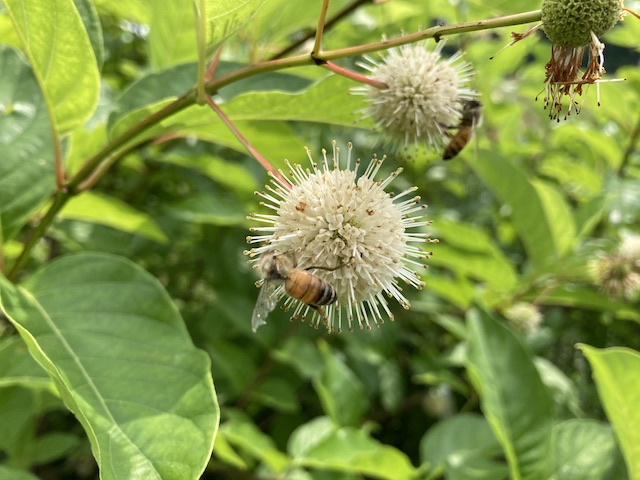
Honeybees on buttonbush blossoms.
Fifteen years farming full-time and I still forget how challenging (and/or frustrating) it is to grow produce during a dry spell in the heat of summer. But then, just like that, some unexpected rain falls overnight, barely audible over the drone of the box fan in the window, puddles on the driveway are woken up to, and the magical gift of rain is given and a brief feeling of contentment returns. Three-tenths of an inch last night should be enough to staunch the outgoing life-force-flow from the 6,100 broccoli, cabbage, and cauliflower plants that went in 3,500' of beds last Tuesday, preceding the disappearing act of dissipated forecasted rain that night. The subsequent four bright sunshine 90 degree days fully tested their resolve and our skill at transplanting successfully while making it apparent that transplanting with the water-wheel transplanter is essential. Stress test indeed.
Rejoice! Sixty percent of the onions were harvested on Friday by a CSA workshift and the farm crew, all of them red and of intermediate day length sensitivity, meaning they began bulbing when day length reached 14 hours or so, sometime in early/mid June. They are some of the nicest onions we've grown and we're excited to share them with you. We bypass some of the fancy curing process for onions and instead simply trim the tops about an inch above the bulb when some of the tops begin falling over and the onions begin to have the papery skin on the outside. They go right into our dry and cool storage room where they will continue to dry and cure somewhat. These aren't meant for longterm storage. The other 40% of onions are a long-day variety, meaning they don't begin to bulb until day length reaches 14-16 hours, and thus mature later. I think we've narrowed down our onions to two good and reliable varieties. Growing only two varieties instead of five makes staying on top of harvesting at the right time a bit easier. Enjoy!
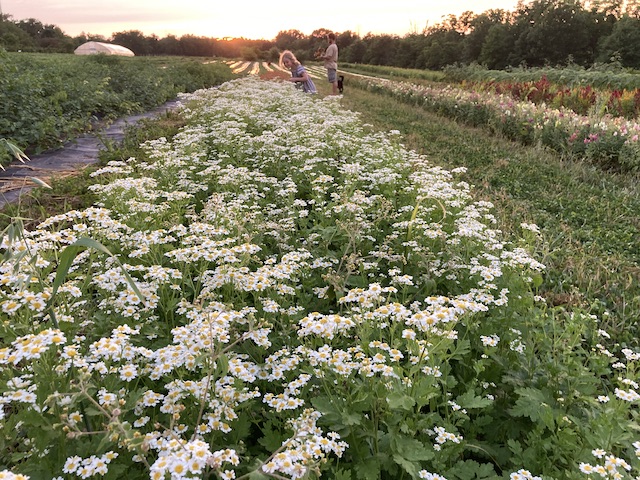
Collecting flowers while the sun sets.

July 10, 2022
Garlic (is) History
by Farmer Derek
Garlic (is) History
by Farmer Derek
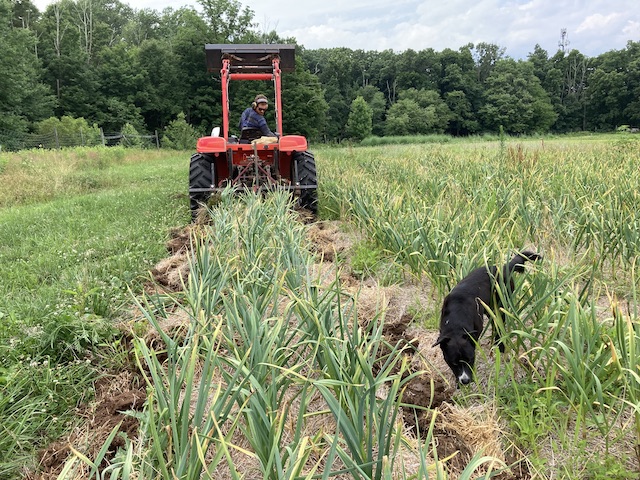
The first step to harvesting garlic is undercutting the beds which fractures and loosens the soil for an easier pull up of the plant.
Around 15,000 garlic bulbs have been harvested, retrieved, bundled, hung, and pruned with the help of 60 farmers and CSA members. We started pulling at 8am Sunday morning and just after noon the final bundles were hung in the barn. This is a monumental undertaking and we're so thankful we can accomplish the task with help from our food community. The garlic looks good, too.
This crop was planted last November from cloves saved from last year's harvest. Garlic cloves have been saved and planted from each harvest over the past 18 farming seasons at Anchor Run. Garlic bulbs/cloves/seed were last purchased in 2003 or 4 and I've heard that it's now safe to say we have unique varieties to our farm (I'm not 100% certain this is true, however, since we're planting parental clones in the form of cloves but apparently there are studies that found that changes can occur when environmental conditions change among other things).
Bundled garlic will hang and cure in the barn for a couple of months. Garlic that was pruned today will be distributed immediately as 'fresh and uncured'. Skin is removed more easily and the taste is more mild. These bulbs can be stored on your counter. This year we're not going to refrigerate the fresh garlic which can cause it to deteriorate more quickly in storage. Enjoy!

A few of the many helpers today that may have a certain smell about them for a while.

July 3, 2022
The Pond is Dry
by Farmer Derek
The Pond is Dry
by Farmer Derek

Spring/summer carrot check - not quite ready but looking totally good!
Serious consideration of adding underground water to the crops is underway. After two rounds of rain missed us on Friday and Saturday evenings the pond is now dry and the farmers are a bit worried. This is a regular annual circumstance, though the exact timing shifts by weeks or months forward or backward. We accept our fate of connecting drip tubes, running out 1.5" header lines, erecting sprinklers, etc, on a Sunday when our bodies would rather rest.
The crops we'll irrigate first are the ones grown in covered beds that already have drip tubes buried near crops' root zone. These include cherry tomatoes, peppers, eggplant, zucchini, new strawberries, winter squash, and cucumbers. We'll work incrementally, starting with the most vulnerable plants first, because we can only irrigate so much bed feet at a given time. We'll try to hook up and add water to all summer crops that meet these criteria before the day is out. To provide crops with a serious drink requires a minimum of four hours so if we're lucky maybe we'll get three groups watered today.
Bare ground crops, like lettuce, beets, chard, celery, beans, flowers, potatoes, etc, will most likely have to wait for the next round of rainfall due to limited time and infrastructure constraints but mostly because they'll be fine. Our relatively heavy, clay based soils predominately face north and have high organic matter resulting in good water retention and less evaporation. It takes a while to harm bare ground crops and in 14 years I've not seen them suffer from lack of moisture. Their growth may slow a bit but they're content being idle for a minute.
Like I said, dealing with dry times is normal. We monitor the weather forecast frequently and strive to only irrigate as a last resort (rain is more beneficial to crops than groundwater). After three months of regular and sometimes excessive rainfall, adding water feels a bit unnecessary and a waste of valuable time. Unfortunately all that extra water percolated below root zones or flowed out to sea. Typically what happens is we'll spend a week or so installing and running irrigation then we'll re-enter a wet period and won't use it again. But you never know so we still have to go through the motions to keep our plants happy and productive. And that should help us sleep better at night.
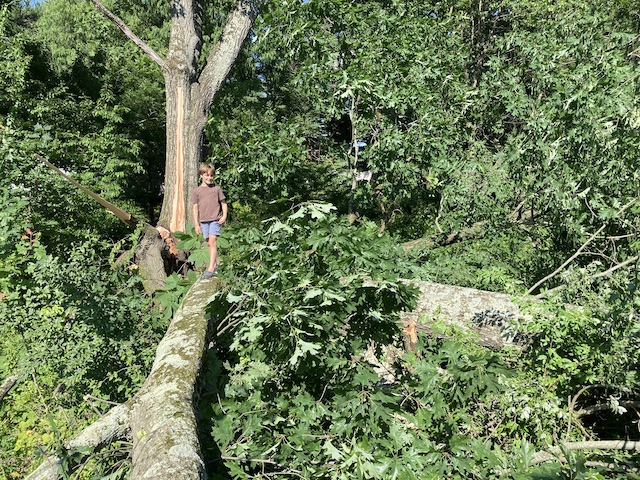
An ancient oak, perhaps 200 years old, split in half on Sunday and crushed 40' of deer fence. We've been waiting for this to happen for years as the crack has grown. Fortunately no one was nearby when it occurred.

June 26, 2022
Departing June
by Farmer Derek
Departing June
by Farmer Derek
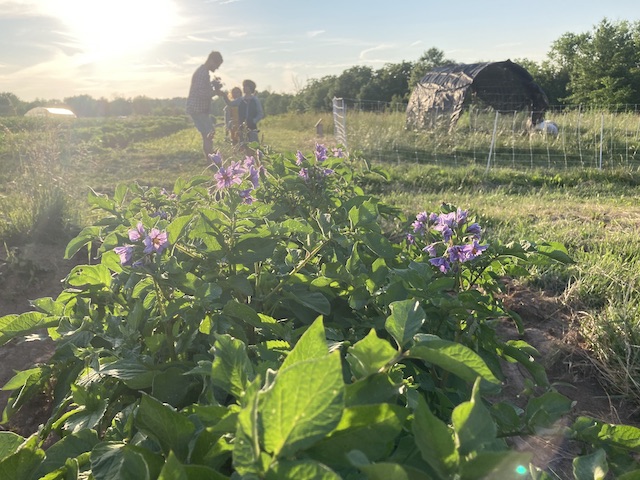
Flowering potato plants.
Last week was another good one. June has been pretty kind to us. The only blemish on her record are the wet harvest mornings, with another one forecast for Monday. On non-harvest days we'll schedule indoor tasks when it is actively raining, but on Monday and Thursday mornings we're out there at 7am almost no matter what (lightning forces us inside). Besides aforementioned harvesting, a big portion of the week was spent staking and twining peppers to help support them when they begin bearing fruit (they flop over fairly easily). We also cultivated the 3000' of sweet potatoes, partially by hand with hoes and also with the tractor, and laid fabric for the final planting of zucchini and cucumbers. We planted the final round of watermelon in the Hoop Tunnel after a failed cucumber experiment made that space available (the watermelon were a make-up for a less than stellar early outdoor planting that succumbed to the cold, wet May).
Upcoming this week will be planting 7,000 bare root strawberry tips for a 2023 harvest. This is a big job and will hopefully coincide with a well-attended workshift. At this point we don't know when they'll arrive (they're coming from our berry plant source in Massachusetts) but we'll probably send out a 'we need help' e-mail.
Soon we'll schedule the Great Garlic Harvest, most likely for Sunday July 10, weather permitting. This is a great community event, with 40-50 CSA members working together to harvest, tie, and hang the 10,000 or so garlic plants over a 4-hour period. It goes surprisingly smoothly and we normally actually finish on time. And we all end up smelling great (it's best if both members of a couple come...jk).
Also soon to be added to the workshift schedule is the harvesting of carrots. This is a kid-friendly task. We basically just pull carrots out of loosened soil, twist off their tops, and add the roots to a harvest bin. We'll probably embark on this task over the first couple weeks of July.
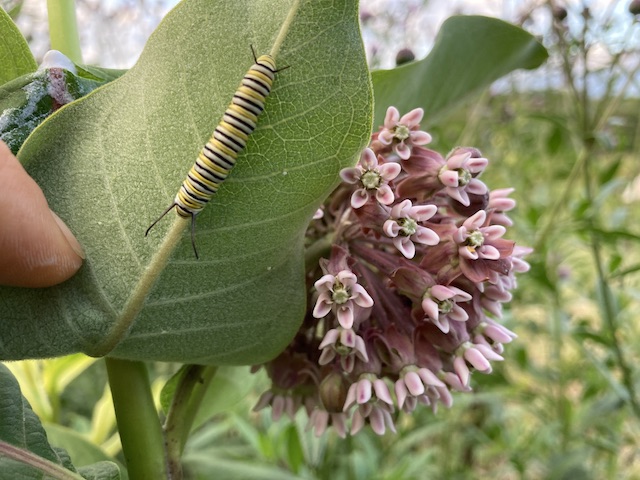
Monarch butterfly larva on her preferred food, milkweed.

June 19, 2022
Progressing
by Farmer Derek
Progressing
by Farmer Derek
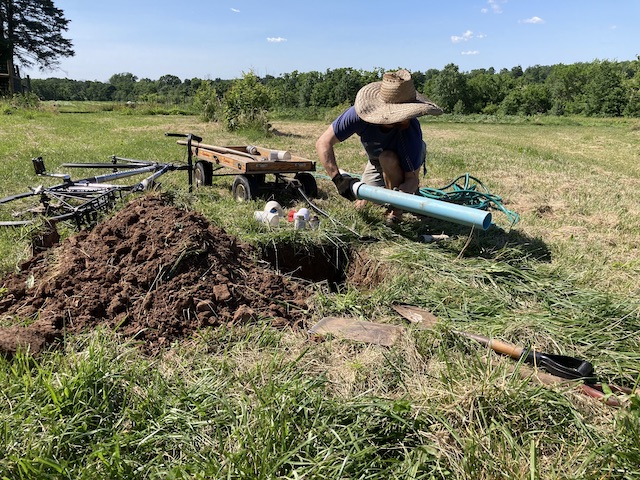
Father's Day surprise pipe and irrigation system repair.
We enjoyed a productive, busy week on the farm. We hilled potatoes for the 2nd and final time; added another layer of trellising to tunnel and field tomatoes; cultivated a few rounds or beans, edamame, lettuce, and herbs; transplanted additional rounds of cantaloupe, beans, edamame, lettuces, and herbs; repaired the flail mower and mowed the entire farm; chisel plowed ground for fall broccoli, cauliflower, cabbage; continued bed preparations for the 7,000 strawberry plants that will arrive next week; removed floating row cover from the winter squash patch; weed-whacked 2 linear miles of pepper, eggplant, okra, and basil aisles; deposited about 10,000 seeds into trays; and harvested a couple thousand pounds of produce. It was a good week even though we endured the first severe thunderstorm and flash flooding event of June, on a harvest morning, and had to wait it out in the barn. By then we did need some rain and can at least avoid thinking about irrigating for another week.
Now that the Summer Solstice is here, harvests will begin to slowly transition away from some spring staples. Greens will lessen just a bit as early summer crops trickle then flood in. Scallions arrive and will continue for a couple of months. Strawberries and peas wind down but beans and flowers rise up. Cherry tomatoes, tomatillos, and husk cherries aren't too far away. Cabbage, fennel, beets, and carrots will be here soon as spring roots like radishes, turnips, and kohlrabi give way. Cucumbers and zucchini arrive and will hopefully stick around all summer.
Long, warm days with ample sunshine and regular precipitation means weeds will be germinating and growing quickly. We strive to cultivate with wheel and oscillating hoes at the right time when weeds are still small and easily killed. This is done weekly and normally most crops only need one pass. Occasionally this time of year two passes are needed. Adequate dry weather between rain events allows for this schedule. Sometimes it doesn't work out and hand weeding is necessary. Either way it's very rare that we lose a crop to weed pressure. Timing is everything!

Foraging bee in a borage flower.

June 12, 2022
Sky to Ground
by Farmer Derek
Sky to Ground
by Farmer Derek
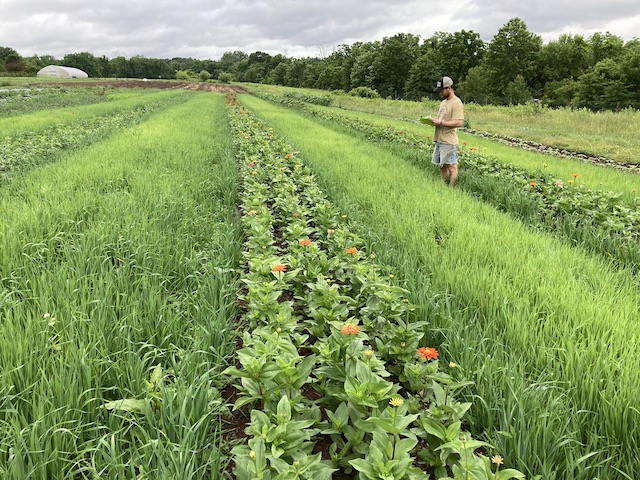
Beginning to bloom, the u-pick flower patch is looking good and should be open to members very soon.
Last week was a catch up clean up maintenance kind of week, with a smattering of transplanting and harvesting thrown in. With the help of CSA members we weeded about 80% of the onion patch. After trimming the plants in the 'living mulch' aisles with our very effective at this weed-whacker and pulling/cutting the weeds right around the onion plants, the patch is starting to look almost 'good as new'. The onions are very appreciative to have some unobstructed views and consumption of the sun without rubbing shoulders with more aggressive plant family members.
We also fortunately found time to give tomato plants in the caterpillar tunnels some much much needed attention. Tomatoes are a sprawling, vining crop that we train to a one leader system, which requires consistent weekly removal of 'suckers' (smaller side growth shoots). Due to some good weather the past couple of weeks we spent all of our time doing outside work, reserving tunnel work for wet weather. It stayed dry, and we got behind, and each tomato plant had about 10 suckers to remove and 4' of vine to clip to suspended string. It was slow going work, but a nice change, and we're all caught up there now. Until this week when we need to go back in there and prune and clip additional new growth because they grow like mad this time of year.
I almost forgot about transplanting leeks, another huge project that is now off this year's to-do list. Getting those and the 2nd round of tomatoes in the ground more-or-less marks the transition from springtime with summer harvest in mind to summertime planting with fall harvest in mind (demarcation is not clear-cut). I was just surprised to learn (or be reminded) that we actually seed fall broccoli, cauliflower, and cabbage this week. Seeding these crops and having them grow happily in trays in the greenhouse during the hot summer is a bit challenging. We start by putting the 48 trays with 6000 seeds in them under the shade cloth in the hoop house to keep the hot sun from heating the potting soil and tray too much (which can cause erratic germination). Once they begin germinating we'll move them back into the greenhouse which better protects them from pests but unfortunately can be excessively hot even when constantly venting. We've left them in the hoop house after germinating in the past but almost lost them after flea beetles discovered them and eagerly devoured their leaves. With the help of a household vacuum cleaner we managed to save the baby plants, but we'd like to avoid having to do that again. Thus, they'll grow in the greenhouse for 4 weeks until they're ready to be transplanted outside. Which also means I need to begin ground preparations this coming week. Wow, time flies.

June 5, 2022
June Transition
by Farmer Derek
June Transition
by Farmer Derek
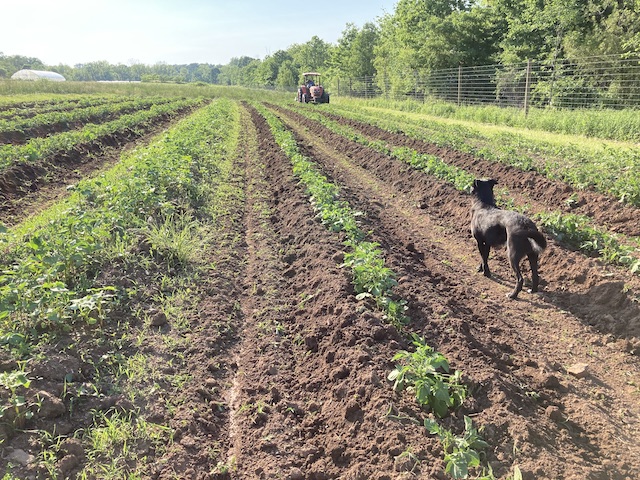
Hilling potatoes. Before on the left, after on the right. Mounding soil around the plants theoretically increases yields.
This is surely some perfect weather. Low humidity, cool nights, plenty of sunshine, warm but not hot days, sandwiched between decent rain events. This is ideal weather for ripening strawberries. It also helps us farmers grind through the last week or so of peak crop planting. It feels endless, this time of infinite sowing, but we're soon rounding a corner into maintenance of long season crops and eventual harvest of those crops. We'll still plant some crops weekly, like lettuce, cilantro, dill, and beans, and have a lot of crops to plant for late summer and fall harvest, but soon the bulk of transplanting will be behind us.
Last week 3,000+ feet of sweet potatoes were planted, as well as zucchini, cucumbers, lettuce, basil, cilantro, dill, beans, edamame, chard, and cantaloupe. This coming week the 2nd round of tomatoes goes in, as well as 1000 feet of leeks, which more or less marks the end of the big spring planting time. At the end of June or early July we'll transplant the 2023 strawberry patch plants, begin sowing seeds for fall crops, and begin thinking about establishing season-ending cover crops, starting another phase of the growing season.
Last week we began installing trellising on the u-pick cherry tomatoes. One hundred 7-foot metal posts were pounded, wire was strung, and tomato plants were pruned and clipped to the wire. As the plants grow for the next couple of months additional levels of wire will be added and plants will be secured and kept elevated off the ground (for ease of harvest and disease suppression). Next in line are the tunnel tomatoes which desperately need to be pruned. Twine will be suspended from the tunnel rafters for the vines to be anchored to. Soon the 3000 feet of sweet and hot peppers will need to be staked and held up with twine. Eight thousand feet of potatoes were hilled and cultivated last week. We'll try to do this one more time before the plants get too big for us to safely drive the tractor over. We'll begin harvesting these potatoes in August.
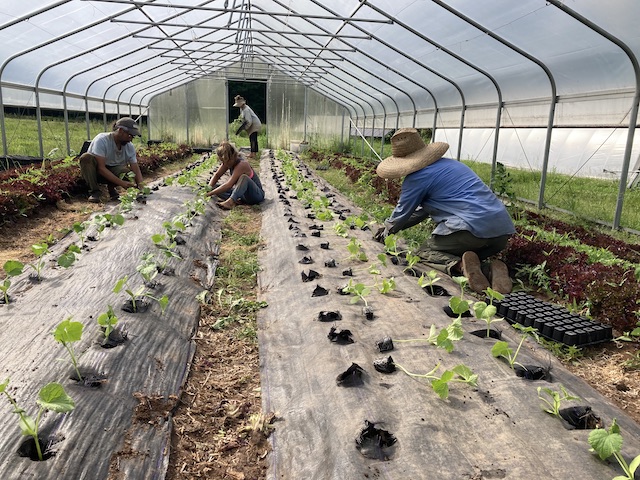
Transplanting the 2nd round of cucumbers in the Hoop Tunnel.

May 29, 2022
June Already!
by Farmer Derek
June Already!
by Farmer Derek
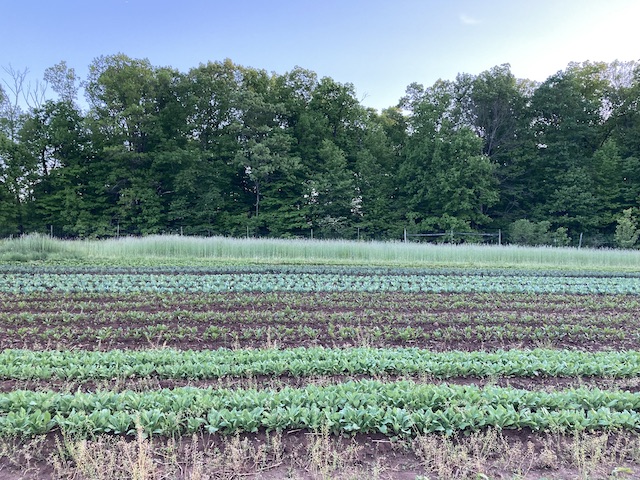
Spring crops on a spring evening.
Meteorological summer begins this week. It feels like just yesterday we were planting spring crops and worrying about frosts and freezes. Most of the traditional summer crops like zucchini, cucumber, watermelon, tomatoes, peppers, and eggplant are now in the ground and are probably appreciating these warm and long days
Field space is quickly being consumed by crop production. Probably about 75% of the farm has been planted or will be by the end of June. In order to get crops in the ground we begin preparing about a month in advance. We take our time with soil/ground preparations, enlisting the help of mother nature along the way. Before each crop gets planted we make 4 or 5 passes with the tractor. If there is plant residue, either in the form of a cover crop or a previous cash crop, we shred it up with the flail mower. We then chisel plow to open up and aerate the soil (vertical shanks spaced about 12" apart, no inverting of soil, structure left largely intact). We wait a week, use our disk bedder - which is equipped with two sets of two disks, a few s-tines to loosen soil, and a rolling basket to break up clumps and level the bed - to hill or mound the soil and rough in raised beds. Another week passes, weeds hopefully germinate after a rain event, soil microbes digest some organic matter and convert it into food for the following crops, and we then come through with our cultivating bed shaper which is equipped with s-tines, side knives, and a shaper pan, to put the almost-finishing touches on the raised bed. Ideally another week goes by and we have another rain even to stimulate weed seed germination and we hit the beds one final time before planting. With each pass of the tractor and tillage tool we deposit a small amount of organic fertilizer right onto the bed where it gets mixed into the soil. These are techniques 14 years in the making and are continually updated and evaluated.

May 22, 2022
It Begins!
by Farmer Dana
It Begins!
by Farmer Dana
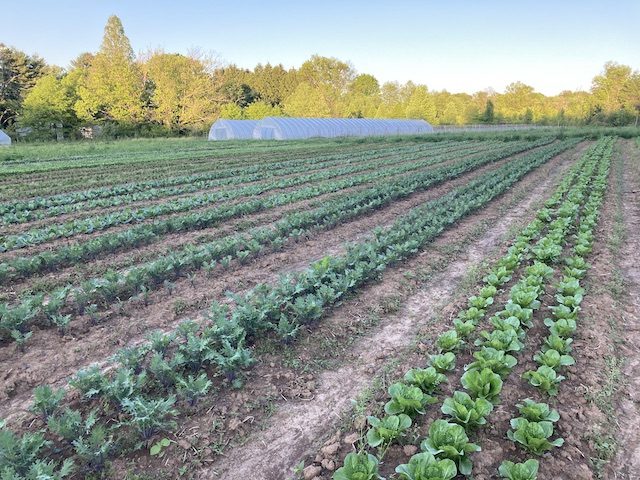
Early season crops have received 14" of rain (and counting!) since they were planted at the very beginning of April.
Here we are! The start of the harvest season. Already it's been an exciting year with the wettest April + May in 14 years. But with the hard work from our stellar and dedicated crew the farm and crops are looking beautiful and harvests ahead are looking good. Many thanks to Craig, Sarah, Gabby, and Meghan for bringing their positivity and A-game to the fields every day! Thank you, also, to our membership for your support of our local food system. Especially in recent years the value of direct access to real and healthy food has become more apparent, and we are humbled and grateful to provide this service for our community. We're looking forward to a bountiful season and to seeing new and returning faces on the farm - here we go!

March 24, 2022
2022 Growing Season Officially Underway
by Farmer Derek
2022 Growing Season Officially Underway
by Farmer Derek
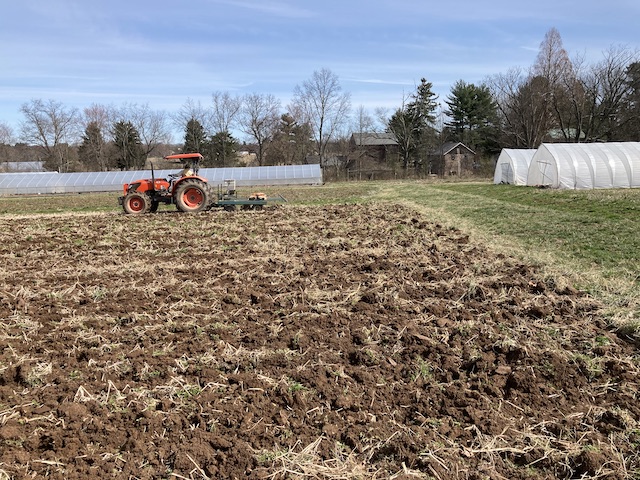
Breaking ground on the 2022 growing season!
Happy spring everybody! We hope this note finds you well and ready to embrace this round of our eight- or nine-month photosynthesizing tour around the sun. As daylight slowly increases, the soil warms and beckons our interaction, visible plant life wakes and excites our senses, we feel energized by the positive prospects of new beginnings and the blank canvas that is the farm every spring. Growing mostly annual crops, the farm gets a bit of a fresh start each spring, with a connection to the past that permeates the soil through our management.
Spring is a very, very busy part of the growing season. More than half of the crops that we'll harvest this year will be sown and planted and soil will need to be prepped to accept during this brief span of time. Throw in some challenging weather with wildly fluctuating temperatures and we're in for quite a ride. This is our 14th season here and we still feel excited, happy, nervous, thrilled, amazed, as well as a sense of awe. And honored and thankful for your support!
Seeding in the greenhouse began four weeks ago and will continue weekly through September. As of last week, the space is 100% full of crops. As soon we get past this current extreme cold we'll move seedlings to the hoop house to harden off. Preparing fields to accept those seedlings began last week when soil conditions became workable. I'm always super thankful and humbled when our heavy soil dries out just enough in mid-to-late March for tractor work. There may only be a two-day window to do initial soil preparations of 25,000 feet of beds for early April crops, but it somehow seems to always work out okay. Now we wait for the next round of dry ground to put finishing touches on those rough raised beds and as soon as the forecast looks temperate enough we'll begin planting outside. Peas, kale, kohlrabi, cabbage, turnips, radishes, bok choy, chard, beets, lettuce, romaine, lettuce mix, escarole, endive, radicchio, fennel, cilantro, parsley, dill, scallions, and onions will all be transplanted by hand during the first couple weeks of April. Carrot seeds will be sown directly into the soil with our antique human powered drill seeder and seed potatoes will be manually deposited in row and covered with soil by rakes and/or hoes.
Besides growing outdoors, we also have 4 tunnels that we'll be growing crops in during the spring and summer. Space in two of those is being manually readied for early greens.
With the harvest season a month and a half away and workshift opportunities right around the corner, you will begin to hear from us more frequently. We hope you had a nice and restful winter and are now ready for the bustle of springtime - see you soon!

December 20, 2021
Winter Solstice Recognition
by Farmer Derek
Winter Solstice Recognition
by Farmer Derek
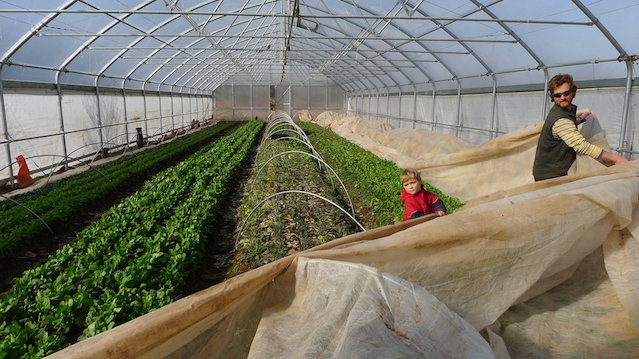
Uncovering High Tunnel crops on a sunny day a multitude of years ago. We once again had to participate in the covering and uncovering game this week.
It's fitting that we're experiencing the coldest couple of nights of the season as we officially transition from Fall to Winter. The warm days of December last week were nice but also felt like a guilty pleasure. This week we'll have the challenge of trying to harvest greens after a really cold night and will have to wait until the crops are sufficiently thawed. Even if the greens freeze overnight, by late morning on a sunny cold day they should be fully perked up and ready for harvest. Outside it may be 35 degrees, but inside the tunnel it'll be in the 50s. By mid-afternoon we even need to keep the doors propped open to vent the heat so the crops aren't too coddled. It looks like we'll be able to leave the covers off again by the end of the week. We're pretty sure we're going to host a flash sale Wednesday 12/29 and will have a good amount of greens we'd like to thrive at least until then. After that they can hibernate, senesce, become fertilizer for the next round of crops.
This harvest continuation known Late Fall is short and sweet and really flies by. It's hard to believe we're in week #6 already. We thank you for your support and membership in our CSA. We hope you enjoyed and appreciated the harvest. Every year is a bit different but it seems like we're finally striking a nice balance between the type of crops in the shares. After next week's flash sale there'll be a gap in shares until at least February and you'll have some time to catch up on unused storage crops in roasts and soups, perfect for warm January meals.
With the Winter Solstice we arrive at our nadir, the longest night, but also our new year of lengthening days, heightening and warming sun, positive energy, and a gaze towards the future. But we hesitate and enjoy this downtime. Our sunshine winter with less than 10-hour days (Persephone Period) lasts from November 15th through January 31st. It's our time to rest, reflect, and plan before the next growing season truly arrives. We're right in the middle of this farmer-winter. We hope you also find this time of year restful and festive. Happy holidays!
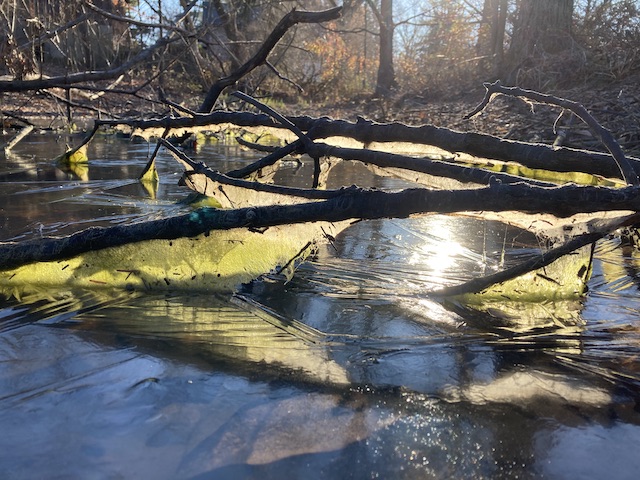
Ice and frozen algae on the pond during its shallowest December depth.

December 13, 2021
Warm Week Ahead
by Farmer Derek
Warm Week Ahead
by Farmer Derek
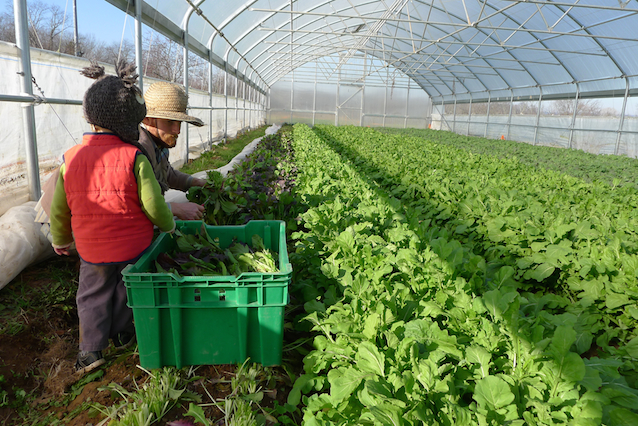
Harvesting mustard greens mix in the movable high tunnel about 5 years ago. Back then we direct seeded greens; now we transplant.
Thanks to La Nina, climate change, regular fluctuations, or a combination of those plus other circumstances, this Late Fall season has felt like a warm dry breeze. In ten years of growing during the darker months it's probably not the first time temperatures have mostly stayed consistently above freezing, but this time around growing fresh crops feels a bit easier to do. Perhaps it's the aforementioned 10 years of experience with less mystery and uncertainty about how crops can deal with low light and colder temperatures. There was a season maybe 5 years ago when we had a balmy November and December and it felt like we could easily grow all winter long, then as January rolled around we endured extremely cold temperatures and highs stayed below freezing. So winter is still yet to come officially and I do hope we receive some legit cold for the natural cycles and systems to operate normally. Cold winter weather helps break the pest and disease cycle and makes farming organically without any sprays possible. All crops are currently uncovered and tunnels are being vented during these warm sunny days and above-freezing nights.
We're down to the final two weeks of Late Fall CSA but are already considering hosting our first 'flash sale' due to continued regrowth of tunnel greens and an excess amount of certain storage crops. Our goal is to fully harvest all greens and distribute all storage crops by the end of the season so we can finally fully rest but sometimes it doesn't work out that way. Late Fall CSA shares are meant to contain approximately 10-12lbs of produce and I believe we've been giving out about 14-15lbs weekly. Thanks to some bumper crops like sweet potatoes, potatoes, beets, and carrots this year's Late Fall harvest has felt particularly bountiful and full of variety. Now that we have sufficient tunnel space, greens are also in high supply. We're looking forward to very satisfying shares these final two weeks. Look for an e-mail announcement if we proceed with a flash sale. If it doesn't occur Wednesday 12/29 it won't happen until February.
Hope you're able to spend some quality time outside this week!
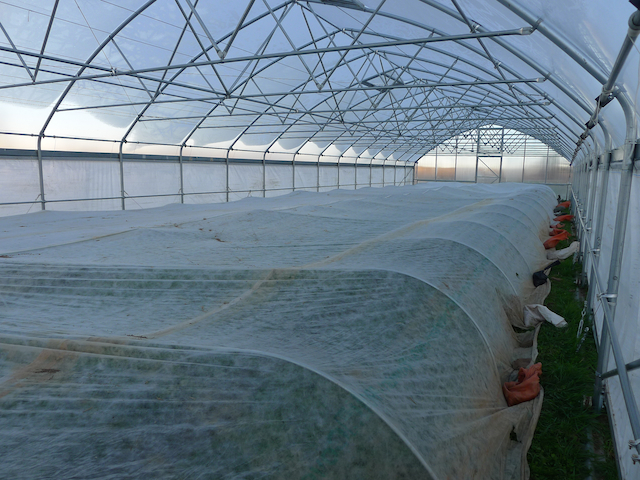
Interior tunnel covering fall and winter greens a few years ago. This is the first year we haven't had to add extra protection to crops in the high tunnel and based on the current forecast it looks like we may not have to at all.

December 6, 2021
Giving Back to the Soil
by Farmer Derek
Giving Back to the Soil
by Farmer Derek
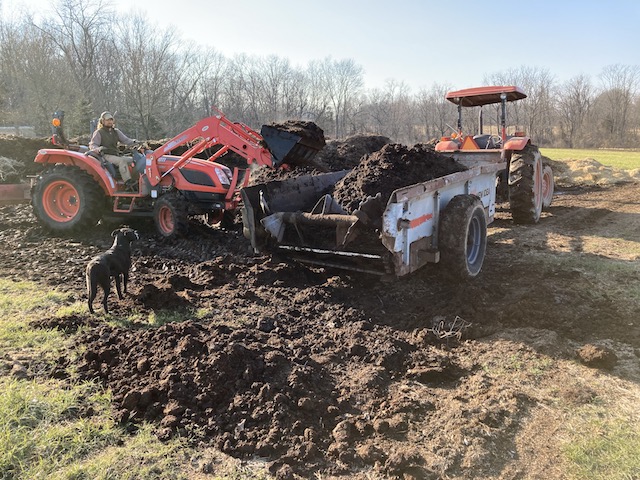
Happy World Soil Day (December 5th)! Thanks to our driest November in 13 years we decided it was a good time to give back to the soil and spread some compost on fields that were next up in the compost application rotation. After last Thursday's deposits in Field 2a were complete, every nook and cranny of the farm received a compost dose within the past year. We view adding compost from horse manure and bedding as a quasi-luxury. We accept for free loads of manure and bedding from local horse farms and let it passively compost for 6 months to a year and spread it whenever adequate time, dry fields, and space allow. Because the compost isn't always fully broken down or monitored closely we only spread it prior to sowing cover crops or after cover crops are already established (not before cash crops). We also have more available time to devote to spreading compost the latter half of the year. It's a fairly time consuming task which is why we may only spread compost on 10% of the farm over a 2 or 3 day period at a time. We appreciate the addition of organic matter to the soil, especially in our fields that have a high clay content. In our tunnels where we may grow 2 or 3 crops each year, I think we need to make sure we add a heavy application of some good quality compost at least once a year. Last year we purchased some certified organic mushroom house compost for this purpose. In our outdoor fields where we only grow one crop and follow it with a cover crop and add sustaining amendments the compost is sort of a bonus. Most outdoor locations probably, on average, only receive compost once every two years. This year was an exception, or maybe from here on out it can be the norm since hopefully we continue to improve our systems and continue to find time and conditions right for spreading. Adding compost and then mixing it in is ideal, but this time of year we don't disturb the soil so it just rests on top until we mix it in during the spring and summer. As it breaks down it will feed all the little soil critters and in turn feed the crops. We appreciate receiving it from local farmers since we don't rotate our own animals on our produce fields.
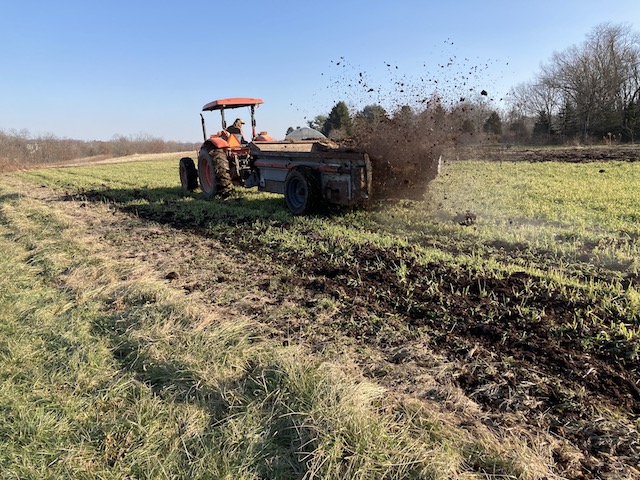

November 29, 2021
Digestive Aids
by Farmer Derek
Digestive Aids
by Farmer Derek
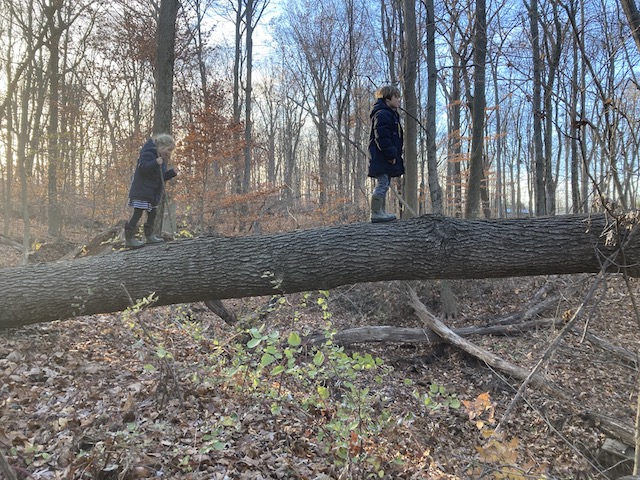
Adventure in the woods.
Hope you had a good holiday and are ready to eat a lot of vegetables!
To follow up on last week's tough decision to provide extra protection to the tunnel greens or not, we did decide to play it safe and not throw caution to the wind. Better safe than sorry my friends. After all, once the hoops and covers are in place all we have to do is remove them once in a while to harvest or vent on hot days. We also assume that at some point this fall and early winter temperatures will actually bottom out at a damaging degree. This time around the lows didn't get quite cold enough but based on prior experience we never really know. Earlier this fall we woke up to temperatures in the mid-20s after a forecast low-30s night.
Of course, we played with the variables a bit. We only covered portions of tunnels where crops haven't been harvested yet except for the curly kale in the high tunnel, which we left to fend for itself. Plants are too big to safely cover (fabric needs to be suspended well above plants to allow for that thermal warm air pocket; if it rests on plants we've seen worse damage than actually no cover). Kale is also super hardy. In Caterpillar Tunnel 1, where we've already harvested head lettuce and lettuce mix (which will regrow), we left endwalls open. In Caterpillar Tunnel 2, previously harvested arugula and mustard greens, that are happily regrowing, were left uncovered next to covered plants. We'll be able to observe success or failure of cold tolerance of these crops.
Besides dealing with the complexities and intricacies of cold season growing, we're tackling other items from our master farm and life winter to-do list. Seeds, strawberry plants, fertilizer, soil amendments, and greenhouse supplies have been ordered. Potting soil and potatoes should be secured this week. The master seed list and seeding schedule has been updated but we still need to extract the greenhouse and transplanting specific list as well as cross reference crop family bed feet and planting dates to facilitate updating the master crop rotation. There's a lot of maintenance and repair work to do: fenceline clean up and rehabilitation (pesky deer have begun thwarting 8' netting); barrel root washer overhaul; annual tractor and machine servicing; employee housing remodeling; etc, etc, etc. It's more or less the same as past winters though for sure there are more big projects going on now and I can't relax quite as much as I'd like to just yet. At least we're enjoying a pretty nice and dry autumn which will allow for outdoor admin-balancing work and fun time.
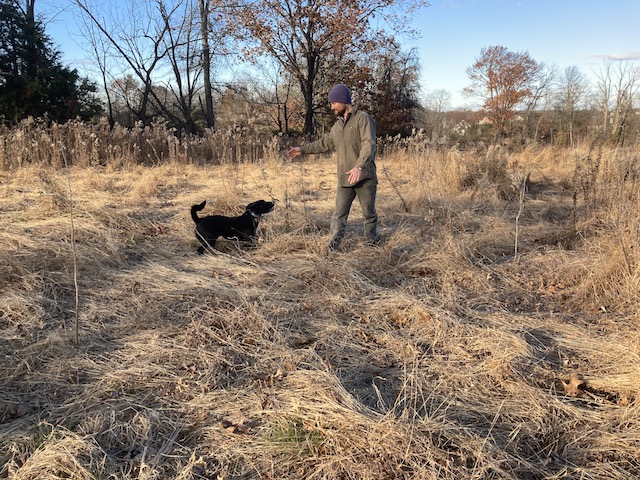
Farm dog training.

November 21, 2021
Cold Prep (or not)
by Farmer Derek
Cold Prep (or not)
by Farmer Derek
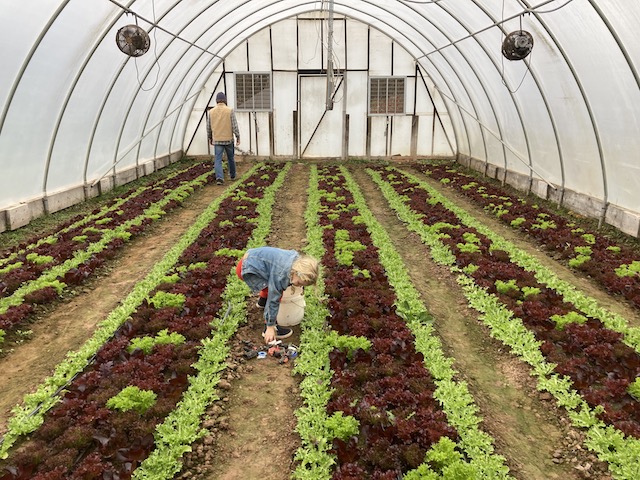
Lettuce mix in the Greenhouse, where supplemental nighttime heat keeps inside temperatures just above freezing.
All season long we monitor the overall weather forecast but this time of year we focus more on the temperature than the precipitation prediction. Because just about everything we're currently harvesting is under protection in a tunnel and we're no longer disturbing outside soil, rainfall doesn't matter so much. We're still retrieving field kale because that has a very high tolerance to cold and sometimes even overwinters. All other crops, plus additional kale, reside inside. However, those cold tolerant crops have a varying degree of ability to withstand cold temperatures. Aforementioned kale, as well as spinach, are the most hardy, followed by bok choy, arugula, mustard, chard, and lettuce. Age of the crop matters too. Generally, younger is hardier if mature crops spent most of their life growing in warmer conditions.
At this point all of the crops in the tunnels have been exposed to sub-freezing conditions a few times so they should be fairly well acclimated. The roof overhead prevents moisture from settling and freezing on leaf surfaces and causing frost damage that way. During the day the sun heats the indoor space and closing it up at night hopefully traps some heat to keep tunnel temperatures warmer than outside. If nighttime temperatures are forecast to bottom out in the low 20s or teens we erect an interior tunnel which adds even greater protection by keeping warmer air right around the plants.
Over the years crops have survived and gone on to thrive even after single-digit outdoor temperatures. Interior covers kept the temperature in the mid and upper 20s around the plants. They froze, looked lifeless on the ground, then a few days later after temperatures warmed a bit, they perked up and resembled their good old selves.
This coming week I'm now seeing lows forecast in the mid-20s which is on the cusp of breaking my low-temperature-confident-no-damage-will-occure threshold. I may hold out and give full trust to the plants, or I may give in and provide the extra protection. Why not just add the extra cover and be done with it? Good question. Trying to erect interior hoops around large and mature plants is challenging to accomplish without damaging the crops or getting them dirty. Putting extra covers over the hoops traps more moisture and can sometimes promote mold/rot/decay due to lack of airflow and requires removal during warm sunny days. The covers can be a pain to work with due to their size. Why do it if the plants don't really need it? Hopefully growing during this time of year for 10 seasons now enables us to better predict an outcome and avoid either unnecessary work or unnecessary damage. We shall see.
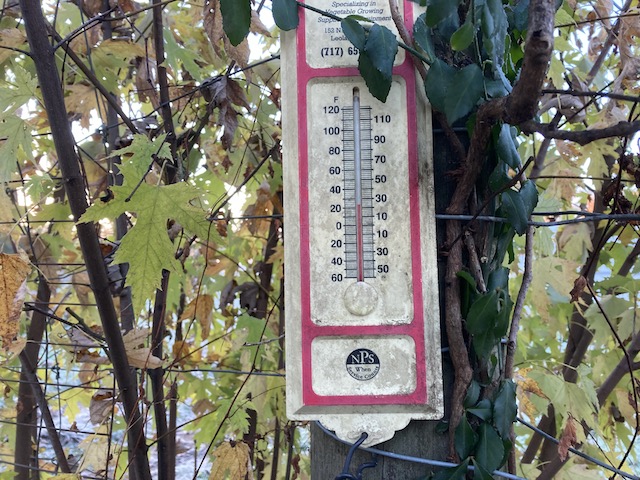
Thermometer showing 24 degrees outside of one of our fields a couple of weeks ago when forecast predicted lows in the 30s. What happens when they predict lows in the mid-20s?

November 15, 2021
Late Fall Ready
by Farmer Derek
Late Fall Ready
by Farmer Derek
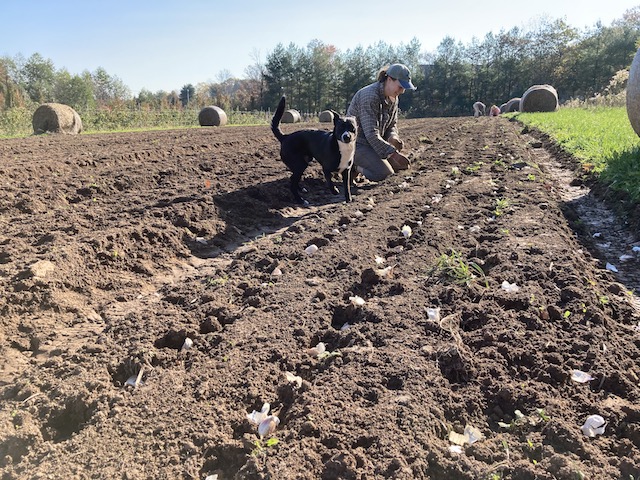
Farmer Addie and farm dog Finch planting the 2022 garlic.
Welcome to the 2021 Late Fall CSA season! This is the 10th year we've offered an extended season harvest, which is hard to believe. It feels like just yesterday we were beginning to wrap our heads around season extension and distributing shares this time of year. There's been a lot of experimentation and trial and error to identify the best crops to grow and harvest as well as store through the winter months. We're very close to having our systems in place but of course will always continue to test, modify, tweak, especially when it comes to fresh greens. Our tunnel footprint, where the vast majority of our greens are harvested this time of year, has more than quadrupled since year one. After dealing with floating row covers and low hoops in the field for a few years it became very apparent that to grow into the winter in a less stressful manner tunnel space is essential. Wind, snow, and deer have wreaked havoc on outdoor fabric, not to mention the challenge of trying to harvest in freezing conditions, completely exposed to whatever weather is happening on the days we need to harvest. Our storage space has triple since year one, too. We now have three different insulated, climate controlled, rodent proof storage rooms, one for cold and humid (beets, daikons, cabbage, carrots, greens, etc), cold and dry (onions, garlic, potatoes) and relatively warm (sweet potatoes). One upgrade we discussed but haven't implemented (yet?) was adding heat to the pick up room area (except for the occasional space heater when outside temperatures are below freezing). When we were entertaining the idea to distribute continuously through the winter months we seriously thought about this upgrade, but we've since discontinued the desire to try to harvest and distribute in January and February, except for the occasional flash sale. As of now a 32-week harvest season feels long enough. In January we try to get off the farm for a much needed break. In February preparations begin in earnest for the upcoming growing season. We exit the Persephone period (less than 10 hours of daylight) and tunnel greens begin a strong regrowth period. This is when we most likely will host a flash sale or two. By late February we're back in the greenhouse seeding for outdoor spring transplanting and the cycle begins again. Thank you for joining us for this segment of the journey!
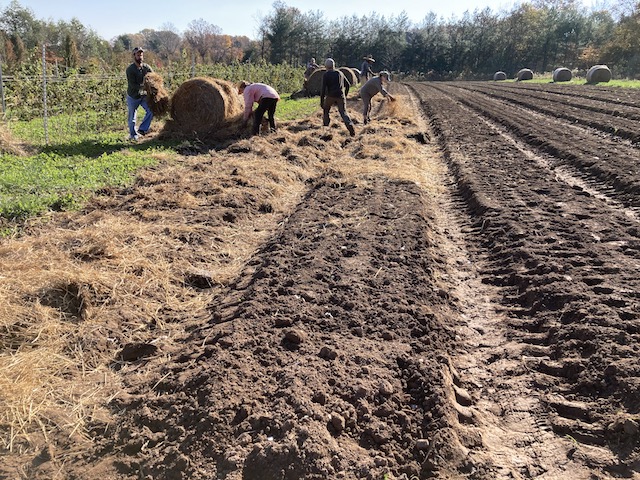
Mulching to insulate the garlic cloves, smother weeds, and retain moisture.

November 7, 2021
Good Food Around the Bend
by Farmer Derek
Good Food Around the Bend
by Farmer Derek
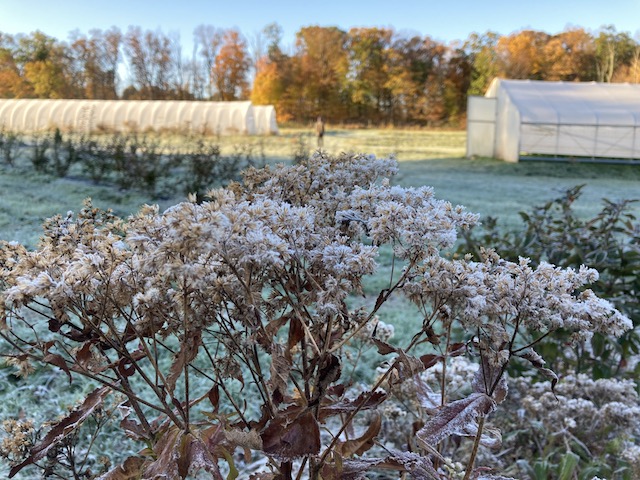
Frost hairs covered nearly everything on the farm 5 mornings in a row last week with temperatures bottoming out in the mid-20s.
Well that seemingly came out of nowhere! From no frosts to 5 consecutive frozen mornings just like that. Thankfully the crops we grow this time of year are hardy enough to tolerate this wild swing (sadly except for the lingering peppers). We hope for a slow transition to cold temperatures but this time around we bypassed the 30s and went right into the 20s. Praise be to the plants for getting through it unscathed. Since the original lows were forecast only for the low 30s we didn't take any extra precautions except for lowering the sides of the tunnels a bit but not all the way. I was surprised that first morning when the temperature obviously went much lower than the forecast 33 and woke up to a blanket of heavy frost and mildly frozen plants even in the tunnels. Just having that roof over their heads though keeps the frost from settling on top of the crops and burning the leaves, blemishing them and eventually causing that dead tissue to deteriorate. But by leaving the doors open and sides slightly up, enough subfreezing air crept in anyway giving them a good taste and wake up call for late fall and winter weather. If anything, it should help slow the growth of some of the tunnel crops that were speedily reaching for the sun during this overall balmy fall.
While mornings were too cold to comfortably do much outside and fields remained moist I spent a lot of time preparing plans and making purchases for next growing season. I like to do a lot of the crop planning early in the slower season while everything is still relatively fresh in my mind. I also reworked the spreadsheets for our seed information, greenhouse seeding, transplanting, and crop rotation bed feet data into one spreadsheet so I can basically update all of that simultaneously which will greatly expedite the process and limit my computer staring. It's also sort of necessary because I need to know how much of a crop and variety we're growing so I can most accurately order the correct number of seeds because we don't like to save seeds from one season to the next due to their sometimes unpredictable loss of viability. I do really enjoy planning the growing season from the comforts of a warm house with some good music going. Because we mostly grow annual crops we start fresh each year with expectations of perfection.
To hope for the best crops the following year we need to collect and record whatever data we can use to make good decisions and plan. Most of it begins with soil health, our number one resource. We collect soil samples in the early fall and send them to the lab for analysis. The results drive our inputs, highlighting mineral concentrations, organic matter, pH, etc. We couple the results with perceived health of cash crops and cover crops. Since our soils here have been managed organically for almost 20 years and we have tests going back that far, taken every three years, we have a good idea of the direction our farm management is going. Suffice it to say, our soils are in really good shape and we mostly just need to apply maintenance amounts of compost, fertilizers, and amendments. But because it's not only overall amounts but also ratios of the minerals, minor tweaking does take place here and there. For example, based on the this year's soil test, one of our fields is deficient in potassium relative to others and the organic fertilizer we'll add there next year will have more of that than say phosphorous. It's all a work in progress, but the goal is sustainability and regeneration.
Thank you for your support!

October 31, 2021
Member Appreciation and a Look Ahead
by Farmer Derek
Member Appreciation and a Look Ahead
by Farmer Derek

Wandering around the farm on a quintessential fall day.
The final two weeks of 2021 Main Season CSA are here! Thank you for joining us on another harvest trip around the sun! We hope you've enjoyed the produce, the farm, the bounty, the variety, the flavor, the freshness, the views, the barn, and everything else. It wasn't a perfect season nor a perfect share but we sincerely tried our best, worked as hard as we could to provide you, our members, with as fine a CSA share as we could craft. Community Supported Agriculture is an amazing system, and we thank you for your support. Without you we wouldn't be able to do what we do.
On that note:
2021 Late Fall CSA begins the week of November 15th for Full, Medium, and Week A Half Shares (Week B begins the following week). Sign up here to continue receiving a farm share through December! Shares will be very similar to what we distribute these final two weeks of Main Season (roots, greens, cabbage, etc). Pick up day options for the 6-week season include Wednesday and Saturday.
Next year marks Anchor Run's 19th growing season! 2022 Main Season CSA should be the same as this year, or may be the best ever! Share prices will increase on 1/1/22 but if you sign up here and pay in full by 12/31/21 you can secure your share with this year's prices.

October 24, 2021
Turning
by Farmer Derek
Turning
by Farmer Derek
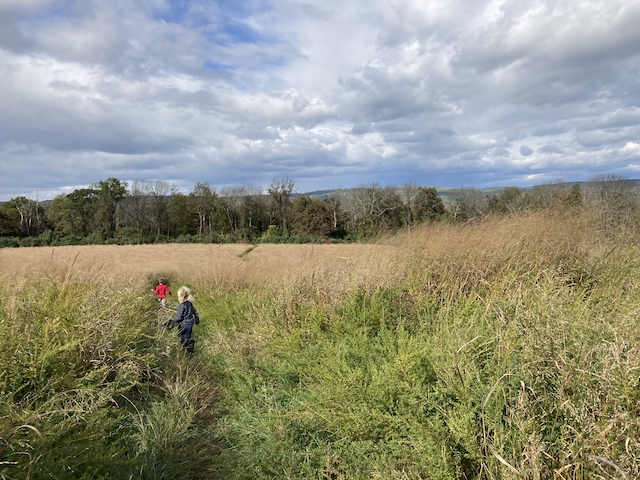
Off farm hike.
The final round of 2021 crops was planted into five beds in the greenhouse last week. This batch of lettuce mix and endive should be harvested in late December. Weekly transplanting commenced the first week of April and varied each week from more than an entire day's worth to a couple of hours. Not transplanting will open up time for other tasks now.
Over the past couple of weeks we were able to give our new berry patches some attention. The raspberries, which were planted in 2020 and should be harvestable next year, were weeded and trellised. The blackberries, planted just this year and already with some 8' long canes, were trellised and woodchipped (besides having been cultivated and weeded at least 3 or 4 times earlier this year). Organically managed berry plants don't seem to remain productive (for us) for more than 3-4 years so we'll probably try to incorporate them into our long term crop rotation, adding new patches every few years in an attempt for a continuous supply. This year was a gap harvest year, unfortunately, while last season's initial great blackberry fruit set was setback by disease and cane injury from cold, prompting patch removal and replacement.
We're now gearing up for the annual big garlic planting. Garlic seed has been saved at the farm since the 2004 season by setting aside approximately 300lbs from the summer harvest. With the help of CSA members we'll split bulbs into cloves, plant the cloves into raised beds, and cover the patch with straw to insulate, protect the soil, and prevent frost-heaving. We're hoping to plant the garlic the first week of November.

October 17, 2021
Wrapping It Up
by Farmer Derek
Wrapping It Up
by Farmer Derek
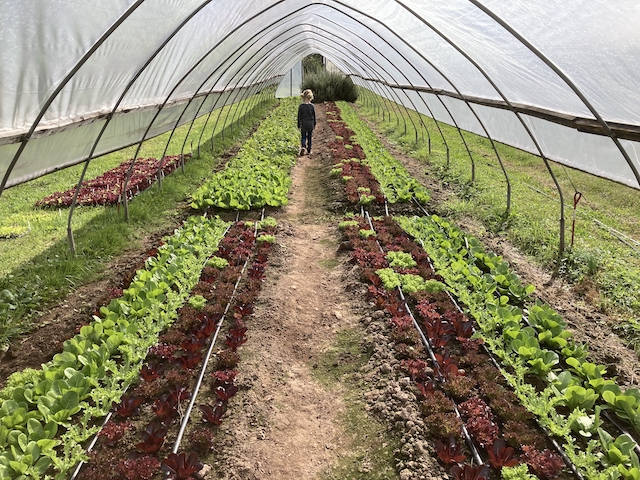
Hoop House greens (and reds).
The time for outdoor soil disturbing tractor work is concluding. We don't want to unnecessarily leave any soil exposed over the winter months and our window to sow and establish a cover crop is shutting. We sow a mix of buckwheat and oats in August and September then switch to rye, which germinates and tolerates colder weather better, in October. The oats and buckwheat will grow a lot during the warmth of late summer and early fall but will die back over the winter and enable spring planting of produce crops whereas the rye will overwinter and grow tremendously in the spring which in turn will require a substantial amount of time to break down before we can plant produce, typically in July and August in those locations. All cover crops will scavenge for nutrients, harness the sun's energy, and add soil fertility and contribute to the soil food web for the benefit of next year's crops. They also add a nice and tidy element to the farmscape.
We have one more outdoor planting to make this year: the 2022 garlic! These raised beds are just about ready to go (you never know how long soil could stay wet this time of year) but will be re-shaped one final time before we plant the cloves on or around election day. After planting we'll apply a thick layer of straw mulch to insulate and protect the soil and cloves over the winter so they don't frost-heave out of the ground. The straw also suppresses weeds and retains moisture and adds plenty of organic matter. We'll probably require some help from members so if you still have hours to contribute for your discount your help would be appreciated! Also on this subject, over the next couple of weeks we'll spend workshift time in the barn splitting bulbs into cloves from the comfort of a chair (an easy-on-the-body event).
Last week we planted the final three beds of greens in the hoop tunnel and this coming week we should plant the five beds in the greenhouse, ending seven months of regular transplanting. It also ends eight months of seedling maintenance with daily watering of transplant trays. Once crops are in the ground in the tunnels they'll need added water every week or so until late November or whenever freezes become common then we'll switch to every two weeks.

October 10, 2021
Pivot
by Farmer Derek
Pivot
by Farmer Derek
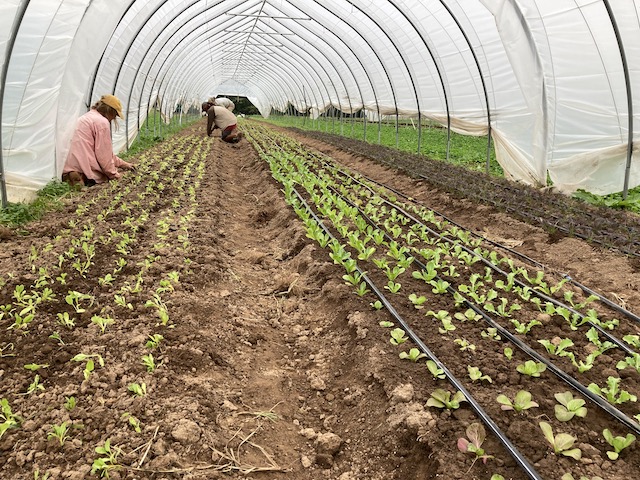
The farm crew transplanting in one of the caterpillar tunnels last week.
The tunnels are continuing to slowly fill up with fall greens like lettuce mix, radicchio, endive, arugula, kale, mustard, chard, and bok choy. We've planted in the high tunnel, hoop house, both caterpillars, and one of four beds in the hoop tunnel. The other three beds will be filled this week, then it's on to the greenhouse. After that, planting will be officially wrapped up for the season. Crops are more densely planted inside due to the limited real estate. Beds require manual preparation and planting. Tidy, colorful, weed free rows are satisfying. Weed, bug, and disease (somewhat) pressure is less this time of year. Mammal pressure exists, as well as mildew on lettuce and spinach, but if we're lucky the indoor fall and winter plantings are pretty easy to manage.
Before temperatures drop into the low and mid 20s at night we'll set up small hoops inside the tunnels where we can add another cover to keep plants extra protected. These greens are cold hardy down into the teens and through the autumn months shouldn't need extra protection that frequently. For now, they just need to be watered in right after planting and irrigated once a week, eventually every two weeks. We're hopeful there'll be a nice slow transition to cooler weather to get these crops properly acclimated to the cold season and not just a sudden deep freeze. Some years we receive a light frost in early October (36-38 degrees) and a decent hard frost in late October (28-30 degrees). It feels as if this fall is warmer than past seasons and hope we don't have a sudden plunge. If we do we'll just cover them with heavier fabric or double it up. These plants are remarkable and many overwinter just fine even when the doors are left open and covers kept off after the Late Fall season wraps up. We wish them luck, and we wish for you to join us for the Late Fall CSA! Membership is limited to about half the Main Season. Thank you!

October 3, 2021
Sweet Story
by Farmer Derek
Sweet Story
by Farmer Derek
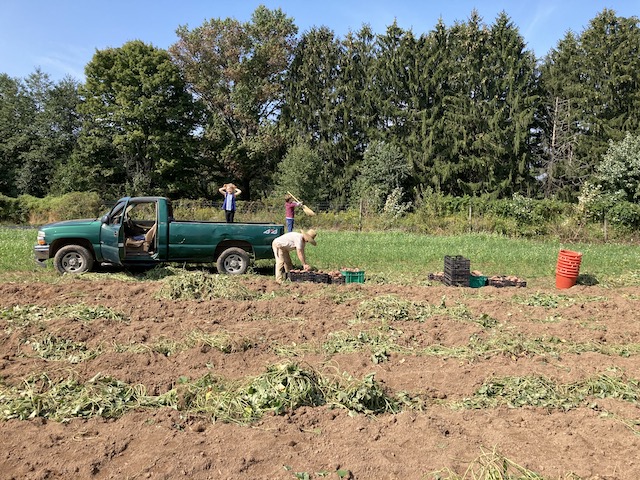
Retrieving the final heavy bins of an epic sweet potato harvest. A big thanks to all the members who helped over the past few days!
A few cold days and nights and a weather forecast originally portending daily rainfall this week triggered the sweet potato harvest switch. The forecast has changed and it's now hot again but we all worked hard and harvested about 90% of the sweet potato crop over the past few days. The haul this year is once again substantial and after a couple weeks of curing and sweetening in the barn, the sweets will be distributed for your culinary enjoyment. During the curing process starches are converted to sugars, wounds heal, skins thicken and toughen, and shelf life is extended. We pile them up and use a space heater in an insulated room to provide them with the necessary curing conditions. Based on how my body feels, I believe this was the most weight I've moved and stowed in the barn in a three day span in my career. I think I handled every single basket and bin of sweets that went into storage, either going into the truck, going from the truck to the storage room, or both. I'm going to estimate we put away about 6000 pounds which explains why I'm so tired, my arms and upper body have a slight ache, and I'm afraid I'll have sweet potato nightmares. Thank you food community for your help harvesting this wonderful crop!
How did we get here? Fields overwintered in a cover crop, were chisel plowed in early May, raised beds were made in late May, sweet potato slips (aka baby vines) were planted in early June, the crop was weeded a few weeks later, beds were hilled/cultivated like regular potatoes, vines quickly took over and established themselves mostly smothering and outcompeting weeds, and almost 4 months later we weed whacked aisles and undercut/lifted raised beds to loosen the soil and expedite harvest. Then the hard work really began. Again, thank you for helping!

September 26, 2021
Fall Feel
by Farmer Derek
Fall Feel
by Farmer Derek
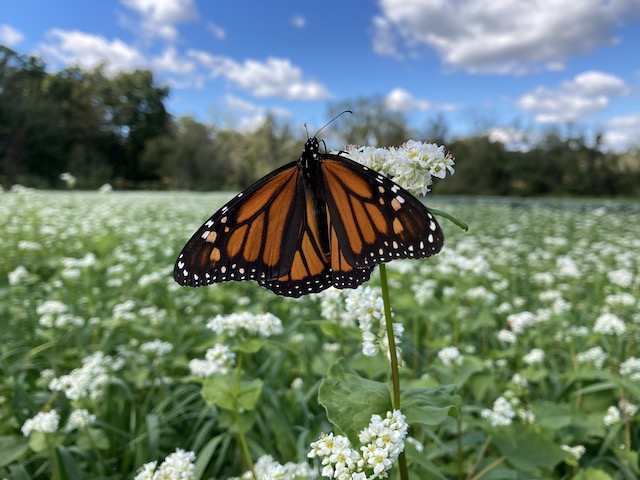
We're always somewhat hesitant to sow buckwheat in the cover crop mix due to its ability to flower and drop seed so quickly but we're hopeful that since we waited until late August this year the seeds won't mature in time. Also, the flowers provide so much quality forage for the insects and add some beauty to the landscape that it's hard to resist. When you arrive at the farm and wonder what the strange smell is, it's probably the buckwheat.
Another best weather of the season moment is upon us, following some much needed and appreciated rainfall. Since Ida slammed the region, we've had 3 pretty dry weeks before Thursday's 2" of decent precipitation. The farm is definitely acquiring a fall look with much of the space now covered in an oat and buckwheat cover crop mix. Some summer crops still linger but will probably slow down immensely with the current and upcoming more pronounced cool weather. Fall crops are thriving in the cool, dry, and less humid conditions and we're trying to keep up with the bounty by harvesting storage roots like radishes, turnips, beets, and kohlrabi before they reach the size of a heavily inflated balloon. Besides organizing most of our plantings by crop family for future rotation purposes, we also try to organize around the time of year crops are planted and harvested, to minimize having to run around all over the farm managing different places and spaces. This time of year our footprint condenses and reduces to perhaps a quarter of the summer maximum and all of the harvested crops are coming from 3 of our 7 fields. It's a nice feeling.

September 19, 2021
Prepping for Fall
by Farmer Derek
Prepping for Fall
by Farmer Derek
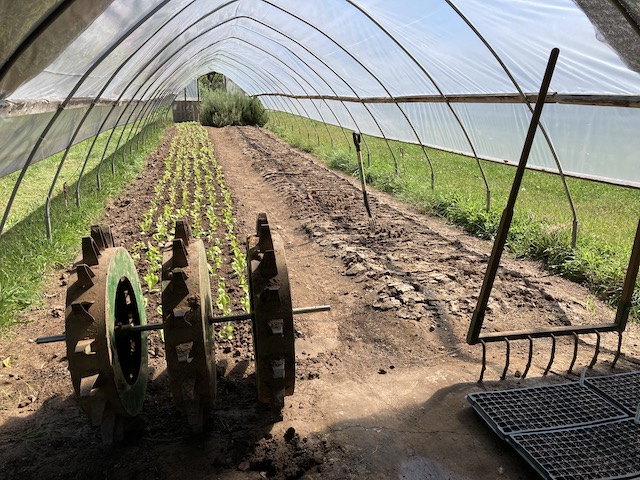
The hoop house is undergoing its annual transformation from a home for transplants to a warm and sheltered space for late season greens.
The fall equinox is here, probably this farmer's favorite time of year. Last week we rushed around cleaning up multiple locations on the farm, pulling up weed suppression fabric and irrigation lines, removing tomato trellising, mowing crop residue, in order to sow and incorporate cover crop seeds to nurture and protect the soil over the winter. It's a joyous time, because once those cover crop seeds are sown, that field is effectively put to bed until next season and can be safely ignored until we begin updating our crop plan and rotation this winter. The cover crop plants will scavenge for and absorb nutrients and photosynthesize the sun's energy, adding to the soil food web, which will then nourish the produce crops next spring as the cover crop plants break down in the soil.
Last week we also sowed the final produce seeds of the season (lettuce mix, endive, arugula, mustard, bok choy, swiss chard), completed the final outdoor crop planting (bok choy, arugula), and transplanted the first round of tunnel greens (lettuce mix, head lettuce, endive, radicchio, curly kale) for November and December harvests. So far 2.5 of the 6 tunnels are planted. Over the next month we'll fill the rest of the space with successions of swiss chard, spinach, lettuce mix, arugula, mustard, and bok choy.
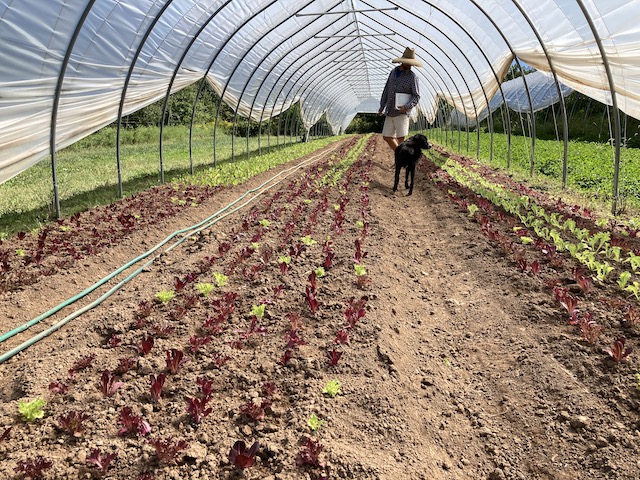
Lettuce mix, to be harvested in a couple of months.

September 12, 2021
A Tale of Two Epic Harvests
by Farmer Derek
A Tale of Two Epic Harvests
by Farmer Derek
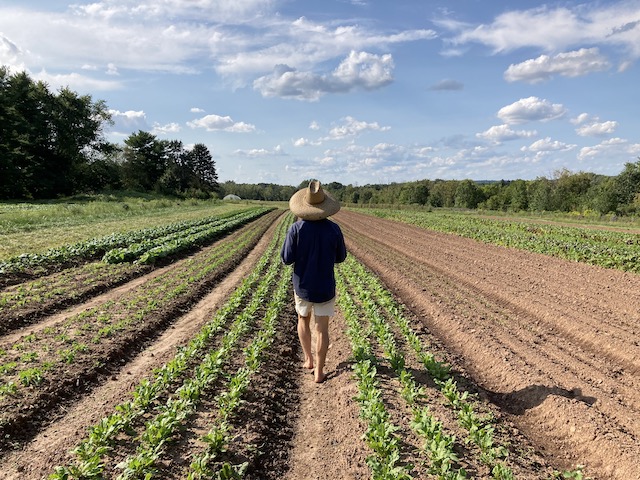
Field 3 crop successions of kale, napa, mustard, and arugula.
Last week we finished harvesting what will probably go down as the best yield of potatoes the farm has had. A big thanks to workshift attendees and our crew for getting all of tubers out of the field! I don't know the total weight harvested just yet but I'm guessing it is around 10,000 pounds. We planted 1,600 pounds in April and a decent average yield would be about 5 lbs harvested for each pound of seed planted. Throughout their time in the soil, the potatoes vigor and health was apparent. They sprouted consistently and uniformly and had the tallest and healthiest foliage we've seen. From the tractor seat while harvesting the amount of the potatoes running through the digger seemed to be more than usual. The harvest was so big that we couldn't even fit them all in their normal home in the barn. Suffice it to say we should all be enjoying potatoes for quite a while. We eat potatoes pretty regularly, almost always cut and roasted at 400 degrees for an hour on a baking sheet lathered in olive oil. They become crispy on the outside, soak up some of the oil, and really melt in your mouth. I never tire of them.
The farm crew also wrapped up the winter squash collection over a long day with a lot of heavy lifting. This crop also performed very well this year. Quite honestly I was close to giving up on growing this crop after 3-4 years of disappointing yields caused by bug, disease, and pest pressure. Each of the past few seasons we tweaked growing methods and continued to trial different types of winter squash and varieties. Quality did not improve. This year we reverted to a more traditional growing technique, covered plants with row cover immediately after planting, and narrowed down the type and varieties of squash, each bred to have powdery mildew tolerance. This year the winter squash was grown at the bottom of a field whose beds used to be incorrectly oriented which resulted in soil easily eroding downhill and probably deposited nutrients there as well. Either way, this season plants were vigorous throughout their life cycle and the retrieved fruits look great. We're hopeful they healed and cured in the field and will be enjoyed in shares for a while.

September 5, 2021
Tranquility after the Storm?
by Farmer Derek
Tranquility after the Storm?
by Farmer Derek
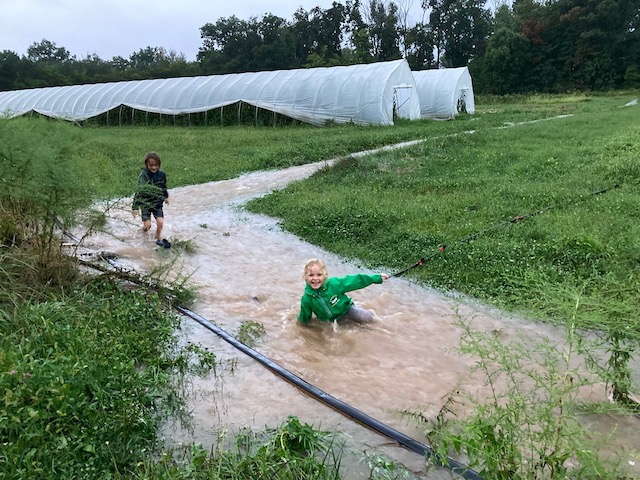
Finding some joy during the flash flood in a working waterway.
What a crazy week. We hope you made it through Ida okay, considering. For us and the farm, overall, it could have been worse, much worse. No tornados touched down here and there was hardly any wind at all. Power was not lost. We received 8" of rain and about 4-5" of that came down in an hour or so. Without established waterways (thanks NRCS!) the damage would have been much greater. We endured your typical flash flooding and its effects. I hate to say it, but we're kind of used to it by now. This flood was a bit higher, a bit stronger, and a bit longer in duration, but it wasn't that much different that a thunderstorm dropping 2-3" in an hour. My homemade dam got washed away and the local creek beds were scoured pretty good, but it did make for an interesting stroll on Saturday. Seen in our little creek were frogs, minnows, and many water striders. We also saw a spicebush swallowtail. Since the rain missed us the previous weekend I was pretty eager for some wetness to help our cover crops get established. Most of our fields are covered in lush crop residue (and weeds!) and fabric so those areas survived unscathed. I was most worried about our late summer and fall crop areas which have more exposed soil but even those areas had less washout than expected. Again, praise be to the waterways! I try to pitch most of our fields slightly so excess water does drain out the aisles and not punch through the beds and it mostly worked except in a few spots. I would say that the driveway and downstream of the bridge to Field 1 sustained the most damage (see below). Best of luck with your own clean up and the stress this has caused! Let's hope it's the last of the season...
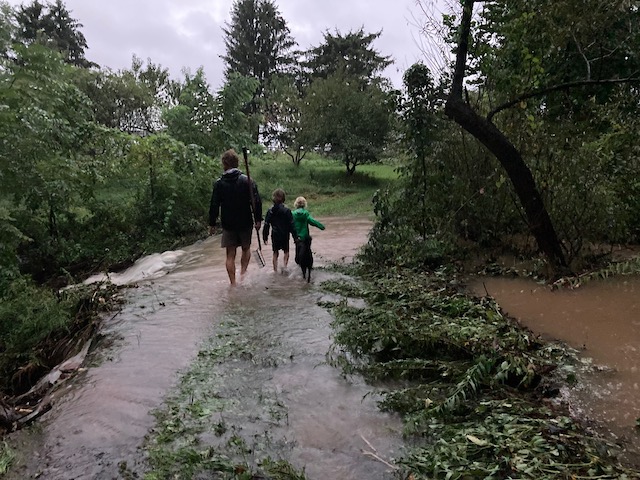
Walking across the bridge back from Field 1 with a pretty extensive downstream washout.

August 29, 2021
Satisfying September
by Farmer Derek
Satisfying September
by Farmer Derek
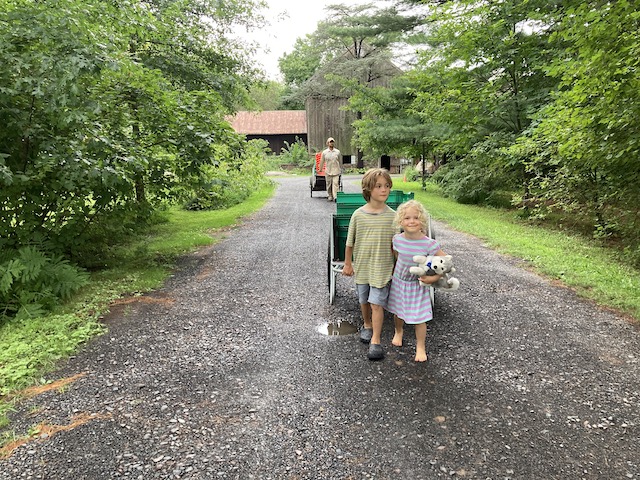
Short lived but earnest help from the tykes.
The story of last week was cleaning up and sowing cover crops, humidity and heat, tomato tonnage, forecast rain and its disappearance. The stars finally aligned where time, soil conditions, weather forecast, and empty field space intersected in the space at this place. I love getting fields cleaned up, spent crops mowed and detritus turned into the soil, sowing cover crops, and putting fields to sleep for the winter. It's hard to resist the urge to begin this process when there is so much other work to be done maintaining and harvesting current crops and I've done my best to wait until we have ample time.
In reality we could begin sowing cover crops on some fields as early as mid-July but typically there is so much other more important farm work that we let those fields sit idle until we're ready. Ideally after produce crops are harvested and fields are spent we'll mow, spread compost, chisel plow, sow a cover crop mix, and disc-harrow it in. When fields sit idle they're really still active, but just in the growth of grasses and weeds which need to be mowed periodically. If we're really on our game and soil conditions are right we might spend some time stale seed bedding where we expose soil, allow weeds to germinate, then kill them with some more soil disturbance. Again, this is hard to find the time for in July and August.
All in all probably 15% of the farm was turned over to cover crops last week, say 2 acres or so. It doesn't sound like much but it was a challenge sandwiching that in when the soil dried out just enough by Wednesday afternoon to do the initial chisel plow loosening due to Fred's Sunday and Monday rainfall and seeds can't get sown and disked in until Thursday harvest day afternoon while forecast simultaneously was espousing 2-3 days of rain starting mid-afternoon and it takes a minimum 4 hours to sow the seeds and incorporate them. Phew! We made it and the subsequent failed forecast and dryness probably helped dispatch the weeds and grasses that had been thriving in some converted fields. With Ida incoming midweek it appears we'll eventually receive the ample rainfall needed for proper cover crop seed germination.

August 22, 2021
Let's Talk Tomato
by Farmer Derek
Let's Talk Tomato
by Farmer Derek
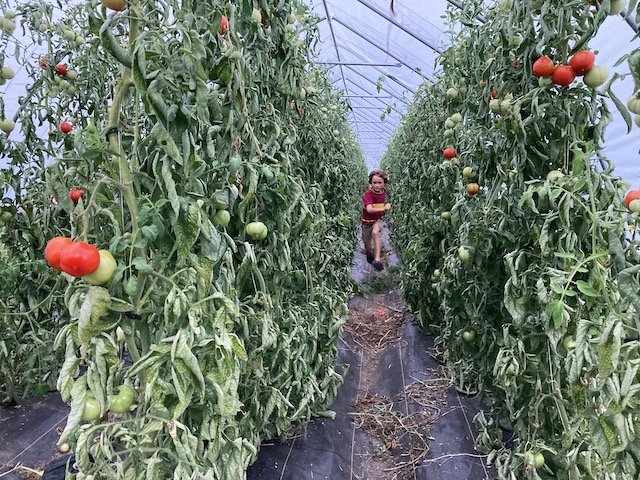
Outrunning the aforementioned zipper spider.
Now that we're into week #6 of harvesting tomatoes, have harvested 4-5 tons total, have distributed about 30lbs to full shares over that time (20lbs to medium and 15lbs to half), and the tomatoes do not appear to be slowing down just yet, it feels like it's time to reflect on their success this year. Undoubtedly a new all time tomato harvest record will be set this season. Besides the great yield, what's most pronounced this year is the sustained quality of the fruit and health of the plants. But why?
After a few successive years of disappointing or underwhelming tomato yields, reduced plant vigor and health, and a too short harvest window, we decided to reevaluate and try to improve this most important crop. The main issue with the tomato plant is its susceptibility to multiple diseases, both soil- and air-borne. We practice crop rotation to attempt to thwart soil-borne pressure, which typically kept plants healthy for their first two months in the ground. However, since we choose not to spray anything, organic or obviously otherwise, it's almost impossible to prevent air-borne disease from impacting plants, typically a couple of months after planting. These types of issues can migrate from the south where they have a better chance of overwintering or they could originate in the residue of last year's planting or even wild host plants that are related to tomatoes. Plants grown outside where rainfall hits the plants and the surrounding soil with their leaves remaining wet for long periods of time makes them much more susceptible to disease pressure. The 'easiest' solution for us is to grow tomatoes under cover, in a greenhouse, high tunnel, hoop house, etc, where rain is kept off foliage.
We've been growing heirlooms under cover in our movable high tunnel for a decade and 2nd-succession hybrids in our hoop tunnel for 4 years. The movable tunnel has 3 positions so each plot will see tomatoes once every 3 years. The stationary hoop tunnel, however, has been home to tomatoes for 4 years now. At the end of last season we erected two more tunnels, known loosely as caterpillar type, to provide an indoor home for our first planting of red round slicer hybrids, which we've grown outdoors until this season. These tunnels were placed in an area that had heavy soil, water saturation issues, and overall just poor performance. To ameliorate these factors we created waterways around the tunnels, using the soil from the waterways to elevate the tunnel plots. The tunnel plots then received an abundance of organic matter from incorporated straw and mushroom house substrate as well as calcium and micronutrients from aragonite and an organic fertilizer blend. When the soil was dry we spaded this mixture together, made beds by hand, installed landscape fabric to warm the soil and suppress weeds, planted the tomatoes, irrigated as needed, and voila, the best quality, most prolonged harvest, and best yield we've seen here. The second planting of tomatoes, in the hoop tunnel and high tunnel, are now yielding as well, so that when the caterpillar tunnels begin to slow, those should pick up the slack. Our goal was to have a sustained midlevel yield of say, 3-5lbs per week, but due to the happiness of the tomatoes in the caterpillars, I'm sorry to say that yields will be more in the 6-9lbs/week range. We hope you love tomatoes!

August 15, 2021
Back in the Farm Groove
by Farmer Derek
Back in the Farm Groove
by Farmer Derek

Goofing around on a sea kayaking day trip.
After a rare mid-season trip off the farm to visit Maine, we're refreshed and ready to be immersed in farm tasks again. The farm was in the best of hands while we were away and everything was well taken care of. An enormous, from the bottoms of our hearts, Thank You goes out to our incredible farm crew Pat, Sarah, Craig, Addie, Jeff, and Wayne!
Since coming back late Friday afternoon we've done our field walk, had Saturday CSA distribution, reshaped a few thousand feet of raised beds for this coming week's round of transplants, mowed and weeded the leek patch, irrigated everything that was thirsty, and harvested about a million cantaloupe. Thankfully the heat wave has now passed. And we are definitely fortunate to have received some rain while gone.
This coming week we have a lot of crops to get in the ground: radishes, turnips, kale, napa cabbage, arugula, kohlrabi, lettuce, romaine, radicchio, chard, beets, cilantro, and dill. All prior to the forecast midweek inundation. Crops need to be cultivated, harvested, irrigated. Weeds need to be pulled, aisles mowed...farm to tend. We're excited to be back!

August 8, 2021
About the Middle
by Farmer Derek
About the Middle
by Farmer Derek

New view.
Some of your farmers left the farm for a brief trip so this week's reflections will hopefully be brief. Harvest week 13 is underway which means we're about at this season's midpoint. Meanwhile I sit and look out at a rocky coastline during low tide while wearing a flannel shirt for warmth under cloudy skies. Our farm crew is currently hustling and bustling under a hot sun on a hot day on a busy harvest morning. Our incredible farm crew has enabled us to take an off-farm excursion. We're extremely appreciative of their efforts, knowledge, and hard work managing the farm in our absence. Cheers to everyone back at the farm!
The farm is currently stuck in a dry spell. In four week's time we've had less than an inch of rain. Plenty of 90 degree days and plentiful sunshine have left plants very thirsty. The bulk of my time last week was spent addressing those needs, adding drip tape tubing where possible and running irrigation almost everywhere. We even set up some overhead sprinklers which we haven't used for a few years. Newly germinated fall-harvested carrots would have a hard time accessing water from the drip tape but the sprinklers deposit water over an entire surface area.
Summer crops are at their peak (patiently waiting for eggplant and okra) and fall crops are being planted. Last week more napa cabbage, beets, chard, kale, and lettuce went in as well as arugula and daikon and storage radishes. The north facing aspect and pretty good organic matter in the soil helps our crops tolerate dry times. Even though it's stressful in its own right, we'd much rather it be too dry than too wet. Those same heavy soils that get us through a drought can drown and suffocate plants during unending wet times, which we've been through a few times over the years.
Hope you're well and are able to stay cool this week. Give an extra 'thanks' to your farm crew for us!

August 1, 2021
Weather Respite
by Farmer Derek
Weather Respite
by Farmer Derek
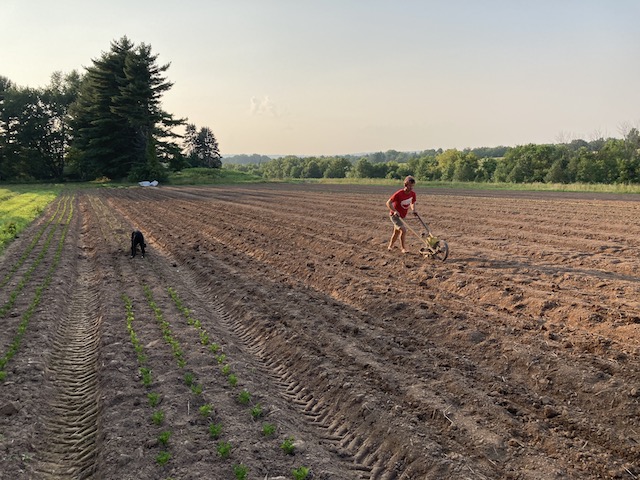
Pushing the antique drill seeder a few evenings ago.
We're tremendously thankful and appreciative of these cool days and nights that followed just barely enough rainfall last Thursday. That .65" was the first rain that fell in almost two weeks. In anticipation of adequate rainfall we sowed just under a mile of fall/winter carrots and are hopeful they receive another drink of precipitation today. We trialed a method of weed control prior to planting that involved covering the 60'x210' patch with silage tarps for a month to stimulate weed seed germination followed by termination through occultation (sun starving the seedlings). The goal is to remove weed pressure and reduce the weed seed bank in the soil so that the carrots have a better success rate and labor is reduced.
Besides seeding carrots for fall and winter consumption, we've been busy transplanting many other late season treats. Celery, fennel, kale, chard, beets, cabbage, napa cabbage, broccoli, cauliflower, kohlrabi, hakurei turnips, and lettuce have all been planted in the past couple of weeks. The hoop house is filling up with successions of arugula, romaine, salad radishes, daikon radishes, radicchio, kale, chard, beets, and lettuce. We have about 3 more weeks of sowing for transplanting outdoors in September then we transition to a few weeks of sowing for transplanting into tunnels during late September and early October. Crops transplanted in September and October will be harvested in November and December (Late Fall CSA season).
Very soon we'll begin sowing cover crops over spring and early summer veggie crop fields. Last week we spread compost on those areas and worked it in with a chisel plow. We'll try to subdue the grasses and other weeds that have taken over these spots since the edible crops were harvested with another pass or two with the tractor. This should give the oats, rye, wheat, clover, buckwheat cover crop seeds a better chance of successful germination and growth. We're planning to sow the cover crops seeds a bit later this year to avoid them maturing this fall and dropping their own seeds and becoming a weed problem next year (mostly a buckwheat issue).
Enjoy this great weather! Come to a workshift if you can!

July 25, 2021
Peak Season - Sign Up for a Workshift Soon!
by Farmer Derek
Peak Season - Sign Up for a Workshift Soon!
by Farmer Derek
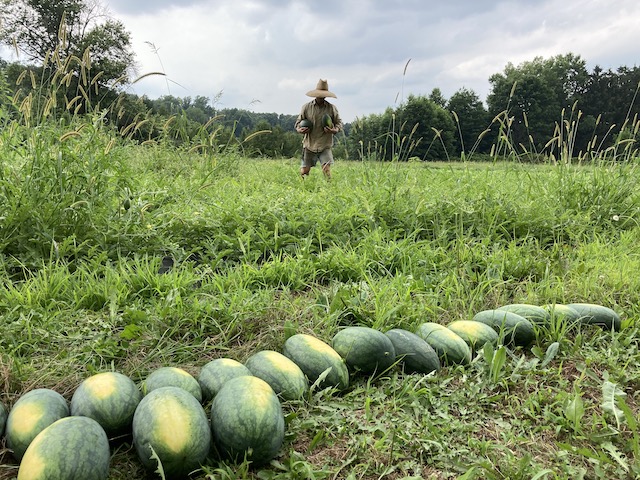
Melon season has commenced, starting slowly but surely increasing exponentially.
Peak season is upon us! Peak weed germination and growth, peak harvests and overall weight, peak exhaustion, and probably peak heat. If you signed up for a share with work discount please consider helping out soon. Workshifts continue through the fall but frequency wanes and workload lessons during the shoulder seasons.
Right now farm focus is on keeping crops happy and healthy during intermittent rainfall and a dry spell, fluctuating temperatures and a weekly return of heat, pest and disease pressures becoming pronounced around the farm, maximum sunshine and resultant aisle maintenance, and the continuation of big plantings needing retrieval. Many thanks to all the members who helped complete the massive garlic and carrot harvests! Our attention now turns to gathering onions, potatoes, and melons, with winter squash close behind.
Please consider signing up for a workshift soon (link below). Thank you to those who have already completed their hours!

July 18, 2021
It's Always the Weather
by Farmer Derek
It's Always the Weather
by Farmer Derek
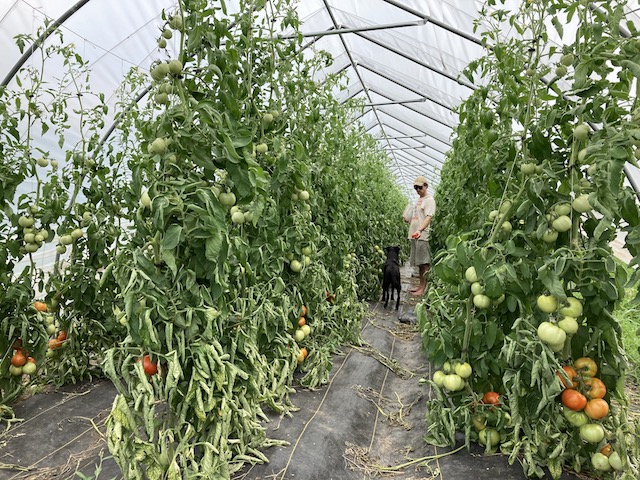
First planting of tomatoes in the new caterpillar tunnels are laden with fruit and running out of room to grow.
Some nasty storms rolled through the region to begin and end last week. Both times the farm was spared the worst. Other local areas weren't as lucky. We hope you fared well. Unfortunately we've come to expect flash flood inducing storms on a regular basis and have done what we can to minimize their impact. The waterways have helped immensely. Since they were installed a few years ago the worst we've experienced was a 3" deluge in about an hour or so, which is nothing compared to the 10" that dumped on lower Bucks last Monday. I'm not sure what that would have looked like here but it wouldn't have been good. Seeing the photographs of floods and damage incurred in Germany and parts of Europe really highlights the power of weather and water. Ten seasons ago we endured our worst stretch of weather when Hurricane Irene and Tropical Storm Lee rolled through. In about a month and a half we received 21" of rain, about 5 times the average.
Even considering the rain and extremely oppressive heat, last week was good and productive. Farmers and members harvested the rest of the carrots, approximately 2 tons, and the overall size, quality, and yield is perhaps the best ever. Garlic processing was wrapped up and the quality of that is also incredible. Tomatoes in the new tunnels are beginning to ripen in earnest. The plants are huge (7-8' tall), heavily laden with fruit, and are still healthy. Ripe tomatoes have great appearance and flavor. The soil in these tunnels had copious amounts of straw, mushroom compost, and aragonite (calcium) worked in and it appears we got it right so far. Keeping the rain off tomato plants makes a huge difference too. We transplanted another couple of rounds of lettuce, the last of the beans for the season, and some of the big fall brassicas (broccoli, cauliflower, cabbage).
Soon we'll move on to harvesting the next few rounds of large storage crops like onions and potatoes. Intermediate day onions may begin to be retrieved late this coming week once we finish sweet potato weeding. They tell us they're ready when their tops begin to flop over and start to dry out. Foliage of early potato varieties are just starting to undergo senescence. Underground they undergo a 'hardening-off' process where their skins toughen and thicken which is what protects them during storage. If we retrieve them before they're ready they would be considered 'new potatoes' and would need to be consumed right away. Harvests are already big so we never feel the need to retrieve potatoes early.
We're looking forward to a more agreeable weather pattern this coming week and hope you are able to spend some good time outside!

July 11, 2021
Much Rain Some Gain
by Farmer Derek
Much Rain Some Gain
by Farmer Derek

Just another pollinator super worker on cosmos in the cut flower patch.
Another hot and bustling week has come and gone. It was a quasi-duplicate of the week before with mid-90s dealt with midweek prior to a serious rain event. At the farm we faired better than some; all of the destructive thunderstorms kept a safe distance while providing some stellar light shows. While closing the gates Friday evening I marveled at the sights in the sky as the sun set basking various types of cumulonimbus clouds in some dazzling shades of orange, purple, white, gray, blue, etc. It was a glorious sight only made possible by profound atmospheric disturbance seen from atop a rolling Bucks County hillscape. The chittering swallows and air-dolphin goldfinches swooping and flying over the beautiful farmscape contributed to the spectacle.
A major milestone was met as we ended the week: seven thousand strawberry tips were planted for the 2022 harvest season. That monumental task was split by Elsa, which actually made planting easier by moistening the soil for us. Besides the harvesting of a few thousand pounds of zucchini and cucumbers last week, we also transplanted more beans, lettuce, cilantro, and dill; pruned, clipped, and trellised multiple rounds of tomatoes; prepped the soil for and tarped the fall carrot patch in hopes to promote weed seed germination followed by termination; cultivated various crops; and started the big carrot harvest.
This morning, with the help of 50 or so CSA members and farmers we harvested approximately 12,000 garlic plants and tied and hung around 11,522 of them. The remaining few hundred await our attention and some will be given out 'fresh' for a few weeks. To be honest and very happy to report, the bulbs look the best they have in years if not ever here. Thank you everyone who came out and helped today!

July 4, 2021
July July July
by Farmer Derek
July July July
by Farmer Derek
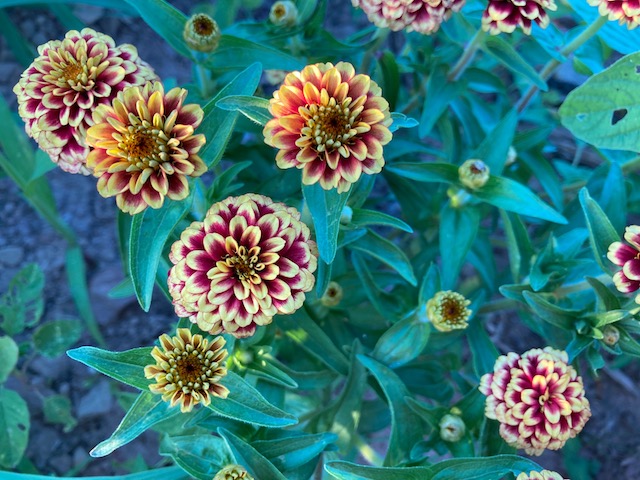
New zinnias in the cut flower patch.
It's July. It's a holiday weekend. Stay cool my friends.

June 27, 2021
Rain on Time
by Farmer Derek
Rain on Time
by Farmer Derek
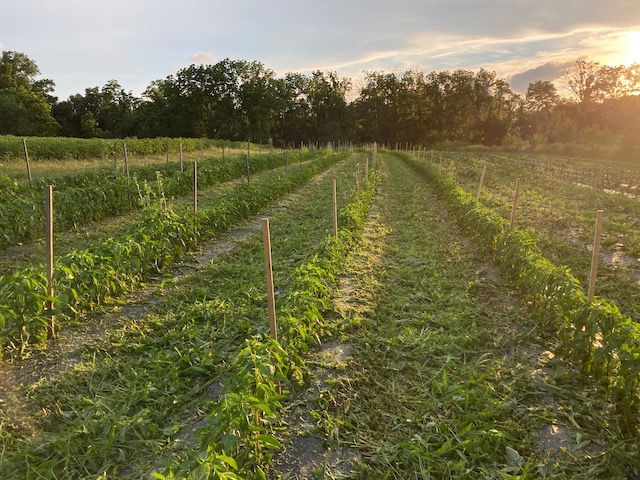
Sunset pepper patch.
As we brace for another round of heat we've begun running through the irrigation iterations and thankfully have hopefully received just enough rainfall to quench the thirst of the bare ground crops. High 'value', long term, sensitive, needy, thirsty, hungry crops like tomatoes, peppers, eggplant, watermelon, winter squash, cantaloupe, husk cherries, tomatillos, zucchini, and cucumbers are all grown in raised beds that are covered in products derived from ancient creatures found underground between layers of sedimentary rock that have been exposed to heat and pressure and when these products are applied a tube also derived from aforementioned transformed lifeforms is simultaneously applied in the soil to distribute water when needed. We strive to responsibly and minimally use these nonrenewable products but alas there is no renewable and sustainable equivalent available at this time. That said, using these products to produce healthy organic food seems to have struck a reasonable balance tipping on the positive side of the overall scale.
It's hard to believe we exit the month of June this week. Summer's in full swing. We'll transplant the final round of zucchini and cucumbers and busily prepare for incoming 7,000 strawberry plants that will make up the 2022 harvest. Seeds are being sown for fall harvest, spring crop areas and residue are being cleaned up and turned into the soil to feed beneficial lifeforms found there, and we plan for the big carrot and garlic harvest. If conditions allow we'll probably begin harvesting carrots the first week of July and garlic Sunday July 11.
Good luck enduring the heat wave!

June 20, 2021
Summertime
by Farmer Derek
Summertime
by Farmer Derek
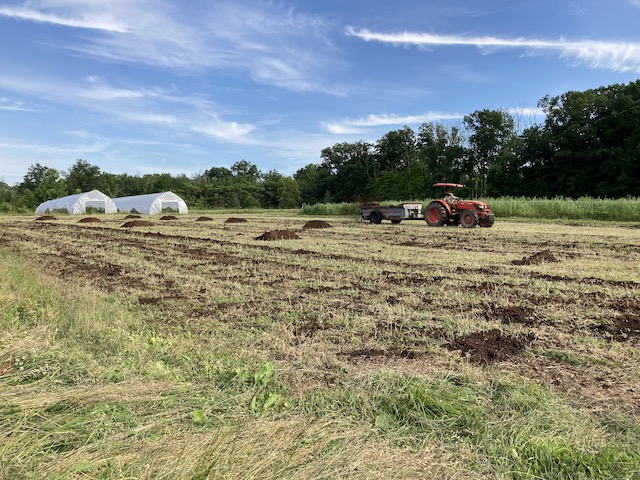
Spreading compost on next year's strawberry patch, soon to be planted.
Summer has officially begun and we're able to enjoy the longest days of the year amid pretty decent weather. Days also begin to progressively shorten and we can't help but think about the future. We're in a time when spring crops like lettuce, kale, peas, and strawberries are winding down or bolting and going to seed, traditional summer crops like zucchini, cucumbers, beans, peppers, and tomatoes are about to get cranking, ground preparation is commencing for summer planted/fall harvested crops like broccoli, cabbage, and cauliflower, and early spring planted crops like onions, carrots, and potatoes are bulking up. One foot's firmly planted in the here and now, the other is down the road making sure all pieces are in place for harvesting through December. Farm fields are full of crops. Around 90% of the fields have now been worked and only 2 of 15 fields await crops. Mind, body, and farm are one this time of year.

June 13, 2021
Squelch Squerch Squelch Squerch Squelch Squerch!
by Farmer Derek
Squelch Squerch Squelch Squerch Squelch Squerch!
by Farmer Derek
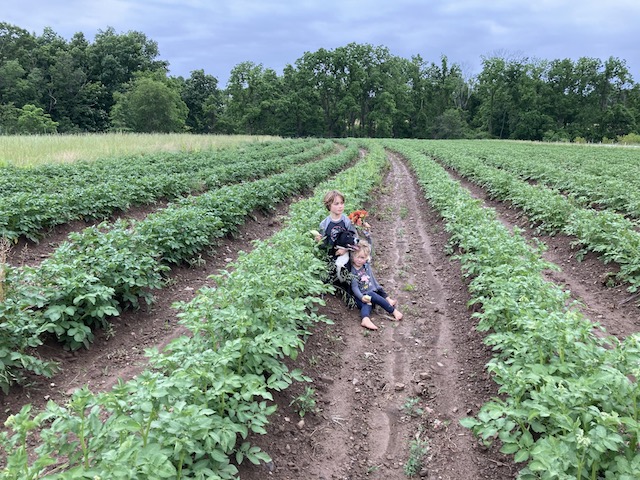
In 13 years we've not seen such a healthy and consistent potato patch. It's been hilled/cultivated twice. Many variables affect the success of crops but here we'll thank the chemical, biological, and physical properties of the soil in this field, good dry weather after seed potatoes were planted, and subsequent plentiful rainfall while plants have been growing up and out in raised beds.
At least it didn't snow, hail, tornado, hurricane, tidal wave last week. Four more inches of rain dropped including a midweek flash flood event (2" in about an hour). Fields are squishy squashy and are unable to hold any additional water. The slow 1.3" received Friday was immediately discharged into waterways. Mostly fields and crops are tolerating the inundation well except for areas newly bed shaped where soil is fully exposed. Those areas give me heartache when I see soil washed downhill, downstream. Soil is a farmers most cherished resource and losing any always makes me feel plenty guilty.
But no need to dwell on the negatives! Soon we'll depart this current weather pattern and will return to blue sky, ample sunshine, low humidity, and dry soil. At least we hope!
Crops are doing really well and harvests have been great. Very soon summer's bounty will descend and we'll be enjoying fresh cherry tomatoes, homemade salsa, grilled zucchini and eggplant, cool cucumber salad, sweet carrots, and fresh cabbage slaw. This week we welcome beets, garlic scapes, and zucchini. Zucchini will probably start at a trickle and in the not too distant future you'll be giving it away.
As soon we can get into the fields again we have a lot of areas to cultivate, mow, and weed whack as we try to beat back the unwanted plants that are thoroughly enjoying the hot wet weather. But we do appreciate them growing in our aisles to keep our precious soil in place!
Last week we transplanted sweet potatoes, the second and final round of tomatoes, and weekly lettuces, beans, and edamame. This coming week the final rounds of watermelon and cantaloupe will be transplanted. There'll be the ever-so-slight reduction in weekly transplanting until late summer and fall harvested crops begin to go in but there'll be so much else to do that we won't even feel it.
Please remember to wear appropriate footwear when doing u-pick!

June 6, 2021
Dry to Wet, Cold to Hot
by Farmer Derek
Dry to Wet, Cold to Hot
by Farmer Derek
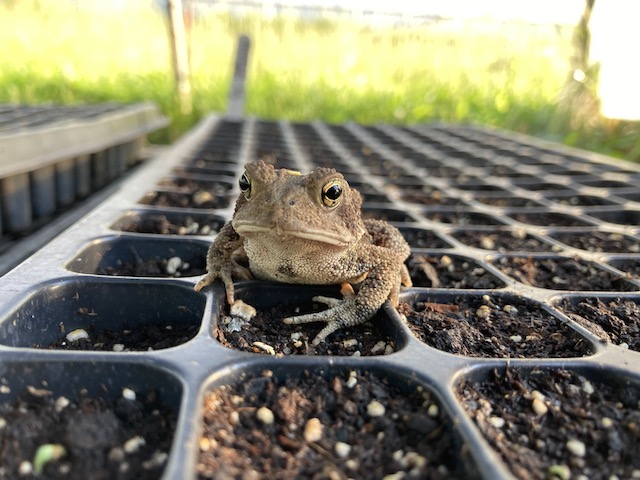
Guardian of the germinating lettuce under the shade cloth in the hoop house.
What can I say? A month's worth of rain in a week following the driest 3-week stretch in May I can remember, along with record heat and record cold. It keeps us on our toes, I guess. But it could be worse. Overall crops are thriving and healthy and farmers are in good spirits.
Now that we're into June we're slowly transitioning from lots and lots of planting to additional maintenance (weeding, mowing, trellising, etc) and extra harvesting. Three thousand sweet potato slips go in the ground this coming week - if it's dry enough to get into the fields - which basically wraps up our large spring plantings. In the past couple of weeks leeks, cantaloupe, winter squash, watermelon, zucchini, cucumbers, eggplant, and okra were transplanted along with the weekly and biweekly successions of scallions, cilantro, dill, basil, and lettuce. Ample rain plus heat means crops and weeds will grow like mad. Driving lanes and some crop aisles desperately need to be mowed. Trellis infrastructure has been installed and initial pruning and clipping was done to both field and tunnel tomatoes. They seem to add a foot of growth per week. Eight thousand feet of potatoes were cultivated and hilled a week ago and will need another round before they get too tall. Hilling provides more room for the potato tubers to grow and will hopefully increase yield.
I hope you've been enjoying the early season shares!

May 30, 2021
The Great Switcheroo
by Farmer Derek
The Great Switcheroo
by Farmer Derek
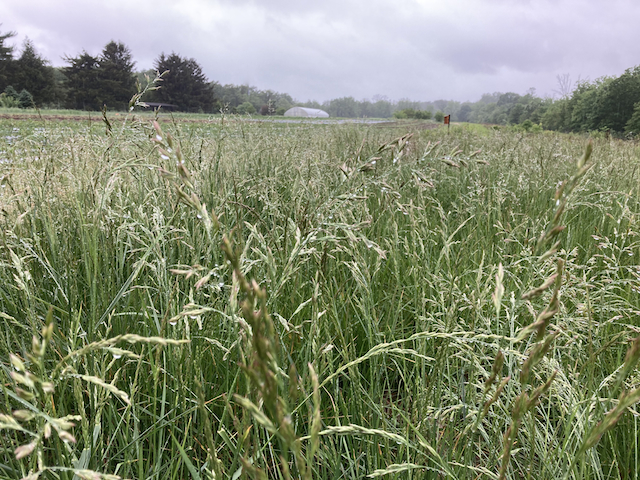
It's funny the way neglected areas end up looking naturally beautiful. By neglected I mean areas sometimes mowed but passed over long enough that they end up being able to enjoy more of their life cycle. Flowering grasses are less appreciated than their colorful brethren but still have a visually satisfying quality that is equally appealing (at least to me, a plant person).
Keeping my notes short and sweet this week.
Pick up proceeds like normal tomorrow, Monday, the holiday day. If you are busy and need to switch, please e-mail us.
U-pick crops are beginning to come in! Strawberries began earnestly ripening last week and snow peas arrive this week. The cooler weather should lengthen the time frame of both harvests.
Regarding U-pick, please consult the board for allowable quantities, which are per share per week (that means if you split a share, you divide what's listed). Thank you for your cooperation. If extra is taken, other members may miss out. Some tasting along the way is fine for sure!
Happy produce eating/sharing/strawberry picking/pea poppin'!

May 23, 2021
Too Hot and Dry for May
by Farmer Derek
Too Hot and Dry for May
by Farmer Derek
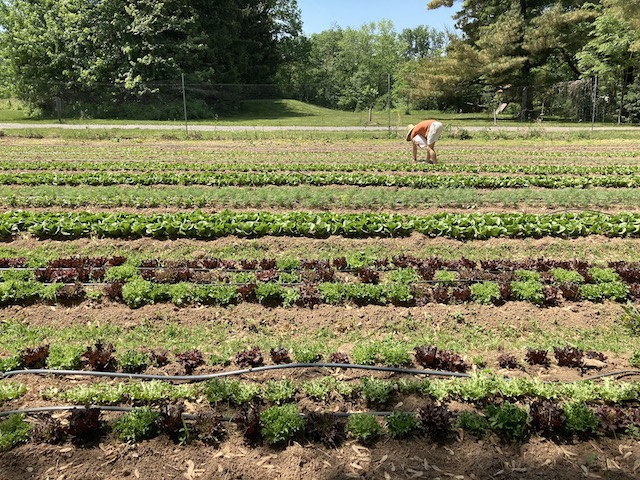
Thirsty lettuces and herbs with farmer applied drip tape which distributes water slowly and directly to the root zone of the plants.
Where did spring go? For the past week or so it's felt more like mid-summer. In addition to the high temperatures, it's been 2.5 weeks since we've had a good rain on the farm, no rain is forecast until maybe Friday, and with all these days in the 90s crops are very very thirsty. We've spent a lot of time setting up and connecting irrigation. As of now we're almost caught up and have been able to provide a drink to most of the crops. Certain crops, like potatoes which occupy way too much field space to add water to (unless we're really desperate and also have ample time), will probably have to wait until the rain for a drink. The top growth of the potatoes (which looks just like a tomato plant) only recently broke through the surface of the soil and the roots/tubers aren't bulking up just yet. Even during this 'drought' the tops have continued to actively grow. A new patch of rhubarb, also without water so far, grows like it doesn't have a care in the world. New blackberry transplants, u-pick flowers, and the herb garden also await a drink, biding their time. Crops transplanted two weeks ago that are still alive and actively growing are a testament to the wonders of the plant world and perhaps the health of our soils and north facing slopes.

May 16, 2021
Let's Eat!
by Farmer Derek
Let's Eat!
by Farmer Derek
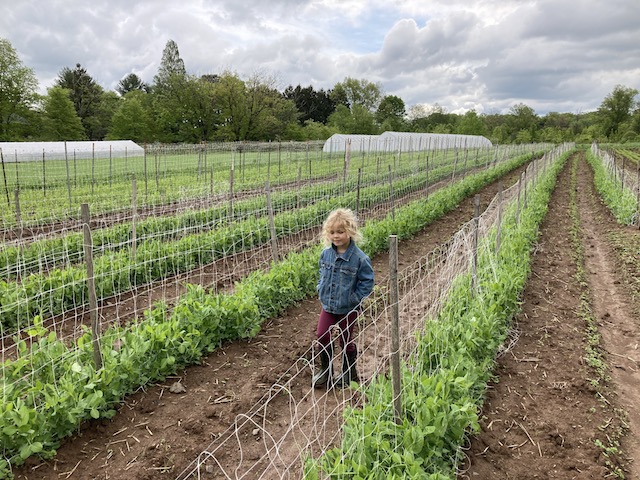
The snow and snap pea crops are looking healthy and happy so far. We're hopeful for a good harvest from the temperamental field they're growing in.
Welcome to the 2021 Main Season CSA! We're eager to begin harvesting crops we've been working so hard to raise for the past 2.5 months. We've got an awesome farm crew this year including multi-year veterans Pat and Craig, and Sarah who is full of positivity and excitement as a first time farmer. The veggies of our labor - and yours if you've been to a workshift already - are bursting and ready to pick and consume. We'll begin the season with spring stalwarts such as kale, chard, bok choy, lettuces, chicories, radishes, turnips, green garlic which will shortly be joined by u-pick favorites peas and strawberries. In June romaine, radicchio, scallions, kohlrabi, zucchini, cucumbers, beets, cabbage, fennel, beans, annual herbs will also grace our tables. Tomatoes, peppers, carrots, and eggplant should arrive in July. But let's enjoy fresh seasonal produce slowly and fully and not rush ahead.
The farm's been a busy place since late March, when outdoor production fully commences. Basically a switch gets flipped that first week of transplanting and a mad rush begins. We quickly shed our winter pace and dash around the farm. So much field space needs to be planted in spring that by June our managed footprint covers 75% of the farm even though there's still more than 3 months of planting left. All that space for the crops needs to be mowed, chisel plowed, bed shaped, and managed for weeds. By the end of June an internal/external shift begins and the heavy harvesting portion of the year starts. It is a nice feeling when we exit the planting stage, when so many of our crops are in the soil and growing. Management and maintenance still require a lot of time, work, and focus but we appreciate the change. Right now, though, we're intent on harvesting these tender spring crops and hope they don't mind the hot summer-like weather about to descend (ascend?) later this week.
Thank you for joining us for the 2021 Main Season! We are truly looking forward to seeing everyone on the farm again!

April 1, 2021
Welcome to the 2021 Growing Season!
by Farmer Derek
Welcome to the 2021 Growing Season!
by Farmer Derek
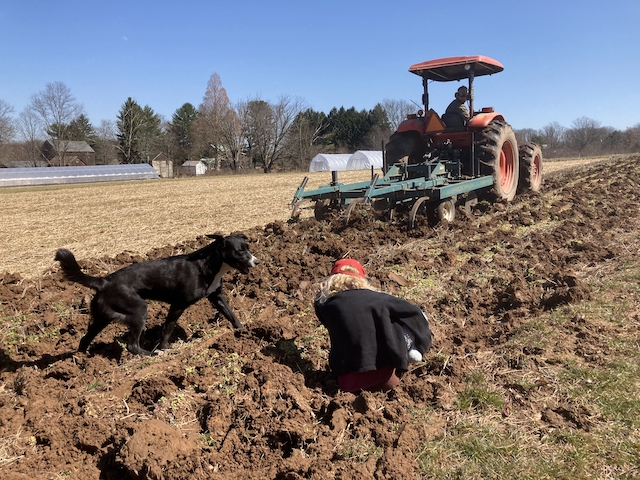
Chisel plowing right on schedule, thanks to a dry first half of March (with the exception of some snowmelt). Chisel plowing opens and aerates the soil, lightly mixes cover crop residue, and enables it to dry out and warm up faster.
Happy spring everybody! This is a wondrous and auspicious time of year as dormancy and hibernation ends and energies are sent bursting forth for this too brief 8-month photosynthesizing segment of our tour around the sun. We've been galvanized by the lengthening daylight, the return of the green sheen, and the positive prospects of new beginnings and the blank canvas that is the farm every spring. Growing mostly annual crops, we get to start over and begin anew each March. It's been a very busy month on the farm preparing for the 2021 growing season.
Seeding in the greenhouse began almost five weeks ago and will continue weekly through September. Preparing fields to accept those seedlings begins as soon as the ground is sufficiently dry and workable, typically mid-to-late March. We had been blessed by a dry first half of the month so we're mostly proceeding right on schedule with ground work. The first crops of the year went into the outdoor soil this week. About 1500 bed feet of carrots were sown and 1000 feet of snow peas were transplanted. Next week begins the true mad rush of spring planting: 5000 feet of beds will be transplanted with kale, kohlrabi, cabbage, turnips, radishes, bok choy, chard, beets, lettuce, romaine, lettuce mix, escarole, endive, and radicchio. The following week 2000 feet of onions (about 20,000 plants) will go in, along with carrot family crops like fennel, parsley, cilantro, and dill.
Besides growing outdoors, we also have 4 tunnels that we'll be growing crops in during the spring and summer. Space in two of those had to be readied for transplants next week. That meant mowing and removing leftover crops from Late Fall CSA, forking/aerating, hoeing, and raking.
One of our antique outbuildings should be overhauled and salvaged this year so much time has been spent moving, organizing, removing, recycling, discarding, cleaning our major barn structures. The building slated to be fixed dates back to 1850 possibly and currently suffers from a subsiding foundation.
With the harvest season a month and a half away and workshift opportunities right around the corner, you will begin to hear from us more frequently. We hope you had a nice and restful winter and were able to enjoy all that snow. See you soon!
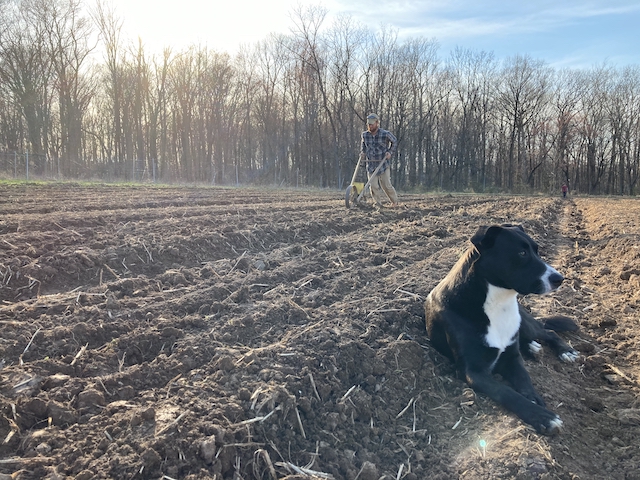
Farm dog Finch relaxing (briefly) while I push our ancient drill seeder up and down 8 beds.

December 21, 2020
This is the End, and Happy Winter Solstice!
by Farmer Derek
This is the End, and Happy Winter Solstice!
by Farmer Derek
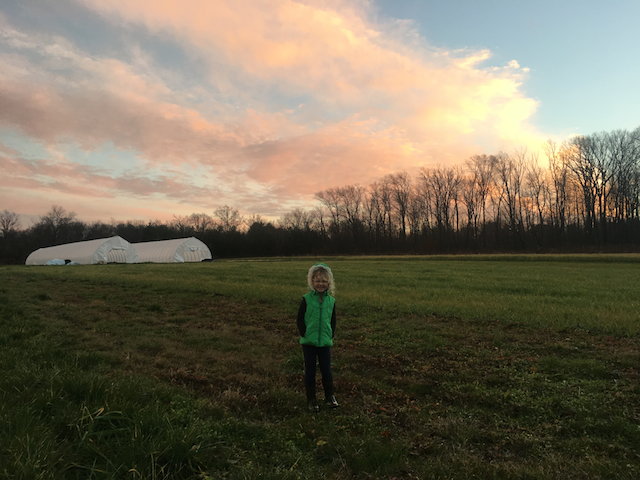
The sun sets on the 2020 growing season.
The final harvest week of Late Fall and 2020 is here! Thirty-two weeks since it all began last May, we are mostly satisfied and content with how everything has unfolded. During this weird year of upheaval and routine breaking and shaking, farm work stayed pretty normal and constant. The only major changes that were made here was with the distribution of produce but we quickly accepted fate and acclimated to this system. It did require a lot more work but it also allowed us to greet and interact with more CSA members. Plus, it was always a fun game to try to identify members in their masks. Though COVID has disrupted most of our lives, the weather this year was mostly moderate, and that was comforting, at least for me, the farmer.
Late Fall CSA has flown by, and I think overall harvests have been bountiful and tasty, with full shares receiving more than the pledged maximum goal of 12lbs each week (week #5 was 13.75lbs). Some items we missed this year, like sweet potatoes and garlic, but cabbage, beets, carrots, and others picked up the slack. We strive to mostly distribute all the greens and storage crops by the end of Late Fall (without overwhelming members too much) and it looks like we'll meet that goal. There'll be some miscellaneous storage crops left and tunnel greens should regrow later this winter, so we may hold a flash sale later on. We'll announce via e-mail if we do so. Now, however, we'll hopefully finish the majority of our winter administrative work then take a short break from working. In February we'll begin preparing for greenhouse seeding and put the finishing touches on the 2021 Farm Plan. In March we hit the ground running and by April outside growing will be in full swing. But let's please not rush it!
From all of us here at the farm we wish you a wonderful winter and holiday season, good health, many smiles, and satisfied feelings. Peace be with you!
Love,
Your Anchor Run CSA Farmers
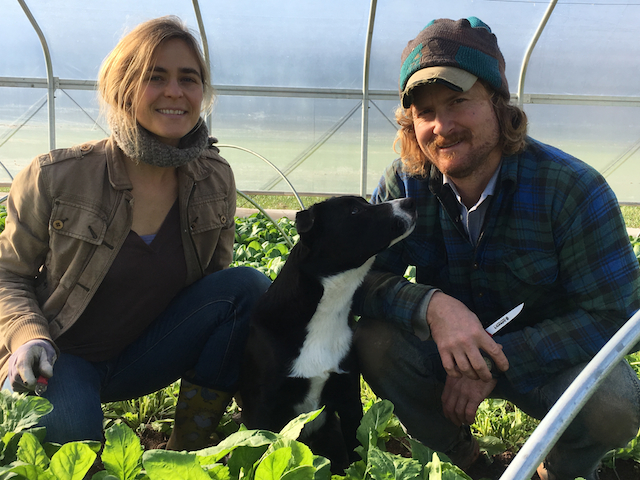
Just a close up of your farmers and their dog.

December 14, 2020
A Snow and Cold Test
by Farmer Derek
A Snow and Cold Test
by Farmer Derek
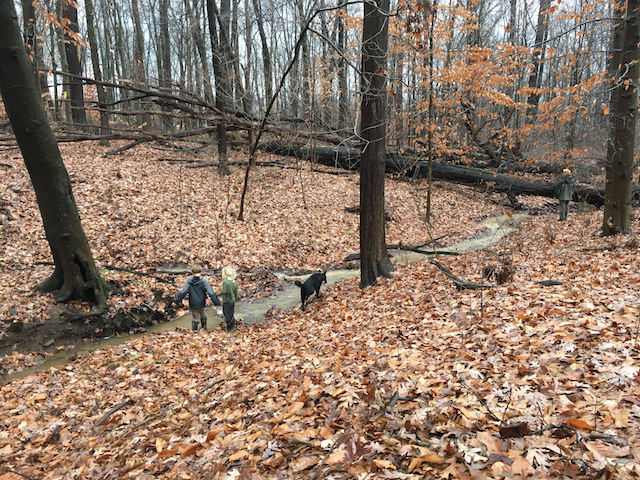
Anchor Run Farm woods adventure.
Looks like we're in for a nice midweek wallop of blustery snow followed by some serious cold. By then our crop footprint will have shrunk to two tunnels so it will be a bit easier to provide extra protection where needed. We'll probably throw on an extra sheet of our thickest row cover then wait with our fingers crossed until moderate temperatures return next week. Cold nights that follow cloudy days are the most challenging. We have the heat turned on in our greenhouse to keep temperatures just about the freezing mark so that space should be all good as long as we don't lose power. Even with the extra work/stress, I am pretty excited to see some snow once again. It is unfortunate that it coincides with a scheduled pick up (which has been rescheduled for Tuesday) and during the same week our tractor is due for its annual tune up (which has also been rescheduled).
We're blazin' through the 2021 Crop Plan and soon we'll embark on the always fun space and time puzzle that is the Crop Rotation. Our goal is to keep crops in the same family off a piece of ground for 3-5 years to break any pest and disease cycles as well as manage nutrient uptake. For some families, like nightshade/solanaceae/tomato/potato and brassica/cole/cabbage/kale/arugula it's a bit more difficult because we grow a lot of those crops, and they may only have a 3 year gap. For others, like the apiaceae/carrot/fennel or amaranth/chenopod/chard/beet, it's a bit easier because their footprint is smaller. Besides organizing our farm space with these parameters we also try to plant fields temporally so that field work and irrigation infrastructure is more efficient.
In anticipation of a major snowstorm and cold weather, yesterday Pat and I harvested all the greens needed for this week, a total of 530lbs harvested over 4 hours. That's a lot of greens. Late Fall stalwarts kale and lettuce mix plus a newcomer to this time of year for us, bok choy, were cut. Bok choy seems to be about 99% water, which makes it much heavier. We're excited to share them with you!

December 7, 2020
Open/Close
by Farmer Derek
Open/Close
by Farmer Derek
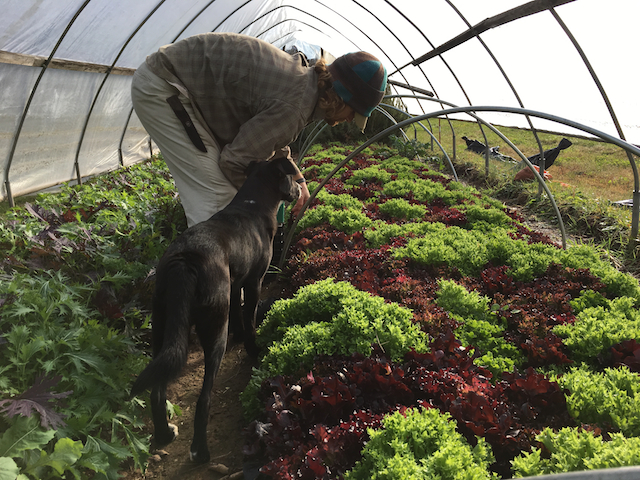
Harvesting lettuce mix in the Hoop House.
Some authentic December weather has arrived. I think I'll enjoy these brisk sunny days and cold clear nights. Thunderstorms and excessive rainfall at the end of November definitely had me yearning for this. With nights descending into the low and mid 20s it means I need to recover the crops in the tunnels with the interior covers to give them an added air pocket buffer. I'll leave the covers on during the day but will at least open the endwall doors of the tunnels for air flow and ventilation and to keep the daytime temperatures from climbing too high. Once lows stay 30 and above I'll remove the covers until the next cold spell.
With the conclusion of November I can now officially tally the rainfall received during the outdoor growing season (March-November). We've been measuring rainfall during that timeframe since 2009. Overall 2020 was our 4th wettest season. It rained 41", 3.5" inches above the 12-year average. The wettest months were July (6.1") and August (6.5"). There were only two months (May, June) with less than 4". Compared to other seasons, it's apparent that we didn't endure any extreme rainfall events or months. There were no 3"+ deluges and only a few times did we receive more than 2". I think this year we were lucky because the trend had been more frequent extreme rainfall events. I'm definitely thankful for the moisture pattern this year. Because of the consistent adequate moisture I didn't have to irrigate any bare ground crops. This season our extreme weather was more temperature related.
The crop plan is well underway. All seeds and plants have been ordered. A few things we're excited about: a new patch of blackberries in a new field will be established; we're going to try to grow rhubarb again; new tomato varieties bred for tunnel production with great heirloom flavors and disease resistance; a production increase in sweet peppers, shishito peppers, butternut squash, and other favorites; a new celery variety that's hopefully more tolerant to leaf curl; utilizing tunnels for early and robust crops in the spring; and much more!

November 30, 2020
Digest
by Farmer Derek
Digest
by Farmer Derek
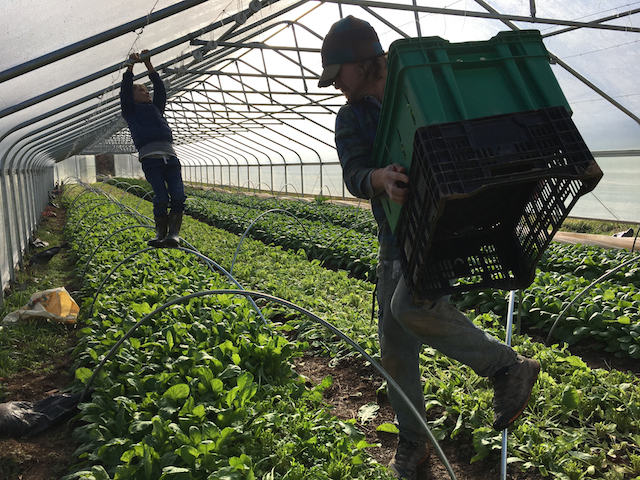
Harvesting greens in the Hoop Tunnel while the boy practices gymnastics. Homeschool phys-ed.
Good morning! I hope you had an enjoyable Thanksgiving and were able to incorporate some of your share into your celebratory meals. Perhaps you introduced the interesting radish varieties to some novice eaters at the appetizer table or made a cabbage dish that could feed your family for a week. So many Thanksgiving dishes seem to be 1/3 cheese, 1/3 butter, and 1/3 vegetable. I'm ready for uncomplicated meals and salads. Fortunately lettuce and greens will not be in short supply for the final month of this growing season!
We were able to give farm work a nice break so not much has changed since we last wrote. This week we'll probably wrap up our seed and plant orders and make some serious progress with the 2021 Crop Plan and Rotation. Supplies need to be ordered soon to qualify for preseason discounts. I would love to finish the bulk of winter's administrative work during December and I may work towards that goal. The next round of holidays will be here before we know it so there's really not much time. Maybe if the ground dries out we'll spread some compost. We're seriously considering the rehabilitation of one of our outbuildings which will require a good amount of pre-construction clean up. When my mind tires and my body needs some physical exertion there's plenty of fenceline and woodland edge clean up to stay in farming shape. Otherwise I feel I can embrace the work this time of year that requires me to stay inside a bit more. Regardless there are about two full days each week devoted to harvest and distribution so there won't be too much downtime just yet. That's for January (hopefully). Happy December!

November 23, 2020
Indoor Activities
by Farmer Derek
Indoor Activities
by Farmer Derek
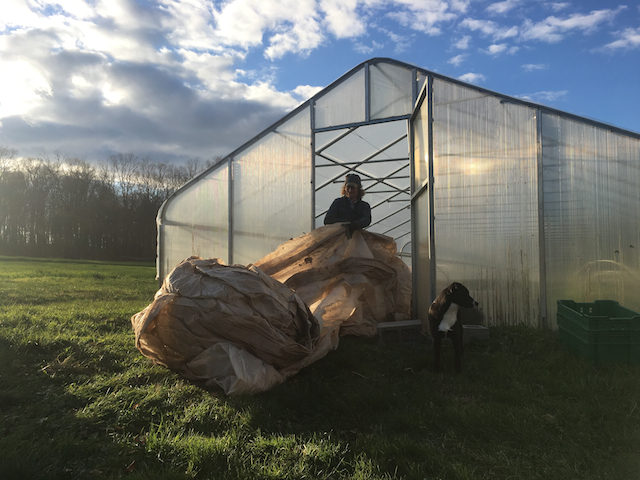
Wrangling row cover for added insulation in the Hoop Tunnel.
Since I wrote a week ago we endured our first seriously cold night this fall. Compared to past seasons it really wasn't that extreme, probably only bottoming out at 23 degrees, though temperatures did stay below freezing for most of that night. Prior to the cold we set up hoops in most of the tunnels and blanketed the crops with our thickest row cover. Everything appears to have made it through just fine.
Inside at the farm we just about wrapped up the 2021 seed and plant order. We'll double check the hundreds of varieties and quantities requested before we submit it as well as add blackberries, potatoes, and another flower variety or two. Next up is ordering the organic potting soil as well as greenhouse and general farm supplies. One tractor was serviced last week and the other will see the doctor sometime this winter. Fertilizers were ordered and soil samples taken and mailed. Depending on those results additional amendments may be needed but we anticipate optimum soil health results.
Normally I wait until February to update and finalize our crop plan (seeding, transplanting, rotation) but December seems wide open so I may try to tackle that now while my body still recovers from this growing season. By February we'll have departed the Persephone Period - daylight will be greater than 10hrs/day and increasing rapidly - and I'll probably be ready to resume outside physical farm activities on a more consistent basis. Crops won't be growing quite yet but there'll be plenty of barn clean up and organizing as well as fence-line and woodland maintenance. January is set aside as an off month, hopefully off the farm.
Happy Thanksgiving!

November 16, 2020
A New Adventure Begins
by Farmer Derek
A New Adventure Begins
by Farmer Derek
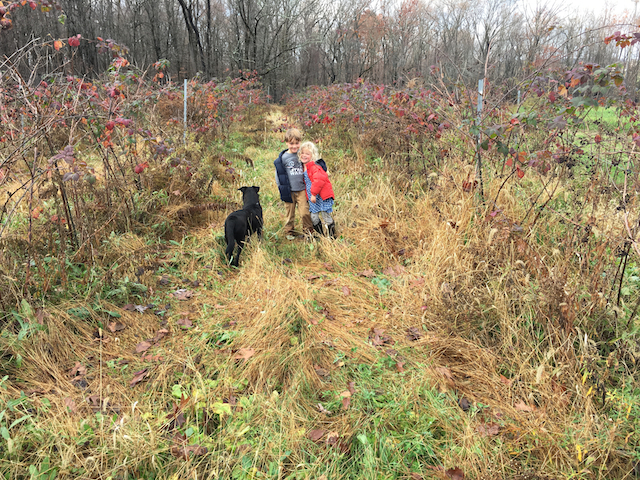
Blackberry patch fall scene. Solving the problem of what caused their demise is top on our offseason to-do list.
The 2020 Late Fall CSA commences this week. Thank you for joining us! I believe this is our 9th time embarking on this Late Fall adventure.
We're excited to share with you the continued bounty from the fields and tunnels. There's still some great looking cold hardy kale outside but most of our fresh greens will be harvested from our plethora of tunnels. These relatively simple passively temperature controlled structures provide almost enough protection to get us through even the coldest nights (we've made it through single digits several times over the years). When temperatures are forecast for mid-20s or lower we erect hoops within the tunnels and add a layer or two of row cover to provide extra protection by further trapping in earths radiant heat closer to the plants, heat that was absorbed during daytime, thank you sunshine.
Some of my focus is beginning to shift towards preparations for the 2021 growing season. Assembling the annual seed and plant order while consulting our crop plans can take up to a week. Each and every crop and variety needs to be assessed and reflected upon and any planned changes noted and the corresponding close to exact number of seeds needs to be ordered. I don't like to keep any seeds for more than one season if I can help it, mostly because I want to ensure the best germination success of those seeds the following season. I assume the seed companies have optimum storage facilities and maintain the freshest stocks. This time of year I also try to order any supplies and materials we'll need for the following year like potting soil, soil amendments, fertilizer, etc. Our inputs are minimal so this doesn't take very long but it is nice to check it off the list. I also need to reach out to experts regarding specific crop issues we had in 2020 that we can't identify, such as why the blackberries declined quickly and precipitously (could have been something simple like cold injury or something worse like a disease). Over the winter we'll update our schedules for seeding and transplanting as well as the crop rotation. Our four seasons, the winter cold break, provides a fresh blank canvas to work on the following year. It's easy to feel positively excited while working near the wood stove on cold winter days.

November 8, 2020
Thank You!
by Farmer Derek
Thank You!
by Farmer Derek

Planting garlic this past Friday during the most beautiful stretch of November weather I can recall.
This was one challenging season and we thank you so much for your support! We hope it provided tasty nourishment and was also a beacon of positivity during what could be interpreted as a bleak time. We always welcome feedback so if you have anything you'd like to share please do so. If we don't see you during the Late Fall, please have a good and healthy winter and we'll look forward to seeing you in the springtime (but don't rush it).
On the farm and in the fields many areas have been 'put to bed' for the wintertime. Cover crops have been established where available and very soon most of our harvests will come from the tunnels (if it ever actually turns cold). Though we love farming - the good, the bad, the frenetic, the frantic, the infinite work - we do relish the down time to reset and rejuvenate. Additionally we also have to plan for the following season by updating crop plans and schedules and the rotation, order seeds and supplies, make repairs, hire staff, and if we're lucky, take some time away. With the successful completion of the garlic planting and mulching last week, large outdoor tasks are now finished.
To prepare for Main Season 2021 we'll assess all aspects of this season, the successes and failures. We seem to remember the failures more and perhaps this will help us fix them for next season. Underperformers from this year that we'll be more careful with next year include sweet potatoes, garlic, summer celery, tomatoes, broccoli, caulifower, blackberries, and slow growing spring crops. Successes this year that resulted from growing modifications include fall arugula, turnips, and radishes that were transplanted instead of direct seeded. Successful crops from optimum soil health and weather include most fall crops like kale, chard, beets, lettuces, radicchio, carrots, kohlrabi, etc. Fall tunnel greens look stellar for the most part and we look forward to share these with you.
Happy Fall, Thanksgiving, Holidays, New Year, Solstice!

November 1, 2020
End is Near! Penultimate Harvest Week!
by Farmer Derek
End is Near! Penultimate Harvest Week!
by Farmer Derek

Arugula and lettuce mix (and a boy and a rooster) under hoop house protection.
It's hard to believe we're already at this point of this most interesting season. Thank you for joining us on this hopefully satisfying, nourishing, and comforting ride. Overall I think it's been a good season. Everything wasn't perfect but most of the crops performed well and the weather pretty much behaved. It seems like our seasonal rainfall will be near our 12-season average. This year the extreme weather was more associated with the temperature: radically cold late temperatures in the spring, some serious mid-season heat, and our first summertime frost right before the fall equinox. After that, temperatures have been moderate with our first decently heavy frost, first sorta freeze, happening at the very end of October, which is consistent with my memory. Two weeks of moist weather with perhaps one day of sunshine now leaves us mossy but this week looks stellar once we pass Monday. Come December I'll probably begin seriously looking at all the notes and records from this year and begin planning for next season. I really enjoy that time. We kind of wipe the slate clean and begin fresh with a new season. Twelve years here and I think there's always room to modify and improve. Experimentation is fun.
Covid drastically altered much of the CSA experience but didn't impact the essence of growing organic produce. Distribution was a challenge and a definite workload increase but I think we identified a functional system that worked well for everyone. It's too early to speculate on next season's methods, but we'll definitely revert to the old system if possible. There were pros and cons with this method and the main thing that was lacking was member choice in the pick up room. We did try our best to incorporate some choice as much as possible this year but it wasn't very easy. Perhaps you were forced to get creative with a new veggie or two and found a new recipe you love as a result. Perhaps your neighbor was given more of your share this year.
Two more weeks of Main Season then six weeks of Late Fall. The winter is wide open. This season has been like no other. Every season is different with unique and memorable characteristics. I look forward to down time. I hope to travel and get off the farm for a bit. We may be stuck here during another lockdown but who knows. Thankful for peace, shelter, food, and health.

October 25, 2020
October's Final Week
by Farmer Derek
October's Final Week
by Farmer Derek
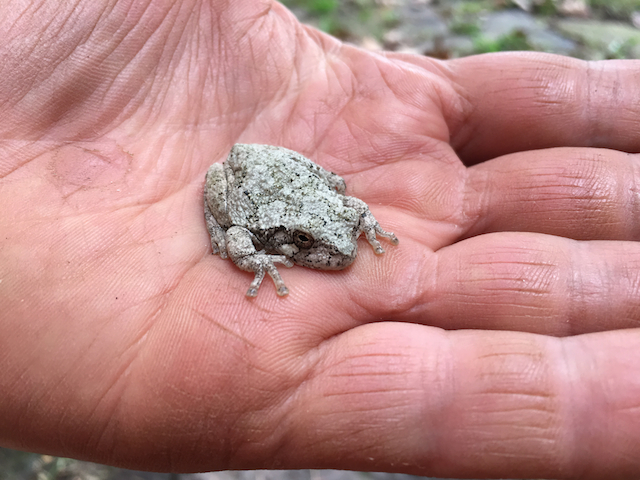
Found this little Eastern Gray Treefrog warming up outside on our clothes rack. They're such beautiful creatures.
A relatively warm and moist week has ended and transitioned to a chilly and moist Sunday. The forecast for this week looks more seasonal (and moist) and may be followed by the coldest night yet as temperatures are predicted to dip near freezing. A return of dry and sunny weather may be the frosty sparkle silver lining. We've had a couple light frosts so far but those upcoming low temperatures may result in a widespread heavy frost and could force us to harvest or cover any susceptible crops beforehand. A low of 30-32 shouldn't cause too much damage but could burn the tips of some of the tender lettuces. Covering mature field greens is one of my least favorite farming activities and we mostly try to avoid it. For crop cover to be effective it needs to rest on hoops so that there is a buffer of air between the cold frozen fabric and the crops underneath. Normally when temperatures drop in the fall, wind accompanies the event turning crop cover into large billowing kites. Sandbags are used to anchor it and work well most of the time. Either way we'll try our best to avoid covering anything with some prior strategic harvesting as well as put our trust in the cold tolerance of the remaining plants. It will be very satisfying when most of our harvesting will be in the protected tunnels but that won't be until mid-November.
Last week we transplanted the final crop of the 2020 harvest season - lettuce mix into the greenhouse. Watering trays of plants has been an almost daily activity of mine since late February, something that can take between 15 and 60 minutes, depending on the time of season and the number of trays. Now, and for the next month or so, I'll turn the irrigation on in our six tunnels with a turn of a few ball valves about once a week and run it for 2-3 hours. Once temperatures really drop and water in pipes could freeze (mid-20s or so) I'll probably drain the system and hopefully be able to leave it off until next year.
Now that we're about to exit October our farming footprint has really shrunk. The crops we're harvesting are confined to portions of two of our fields. We only have a few more storage crops to retrieve (last of the carrots, green and red and napa cabbage, radicchio). If we had more time, more help, more space, and more containers these items would probably be in storage but we have to be strategic as we harvest storage crops. Most of what is left should tolerate field conditions a bit longer but we'd really like to harvest the rest of the carrots this week. Join us for a workshift if you can!

October 18, 2020
Ample Rain, Sunshine
by Farmer Derek
Ample Rain, Sunshine
by Farmer Derek
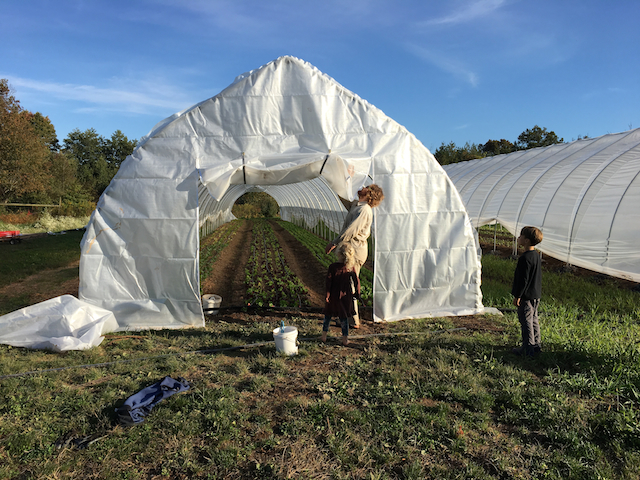
Installing the 'zipper-door' endwalls on the new caterpillar tunnels.
Two rain events bookended last week. Did that keep us inside, warm and cozy by the fire? Not quite yet, though after required work was finished, warmth was absorbed from the wood stove. Remnants of Delta during Monday's harvest and distribution gave us a nice soaking inch. Friday's incoming cold front also dropped about an inch of rain. The ground feels fairly saturated now and we look forward to drying out a bit this week as we hope to harvest root crops like carrots and rutabaga as well as make some final preparations for the upcoming garlic planting. We'll also finalize and plant the beds in the greenhouse with lettuce mix for a December harvest.
Last week we finished planting the hoop tunnel with arugula and greens mix and set up all the drip irrigation in the 5 tunnels. After we plant the lettuce mix in the greenhouse we'll install drip tape there too. I seem to always underestimate the amount of time it takes in setting up all the irrigation but it feels good once it's installed. We try to reuse everything so there's inevitably more repair needed but it's worth the extra effort as long as it's not too much of a headache. Also wrapped up last week/this weekend were the finishing touches to the caterpillar tunnels. Zipper endwalls were put up and anchored and the 2nd securing rope was tossed over each hoop and fastened to ground stakes. This was a big project and I'm glad it is finished.
Temperatures will be trending upwards again and with some nice autumn sunshine working outside will be sublimely pleasant. If you still need to contribute work for a share discount, this is a great time!

October 11, 2020
Almost There
by Farmer Derek
Almost There
by Farmer Derek
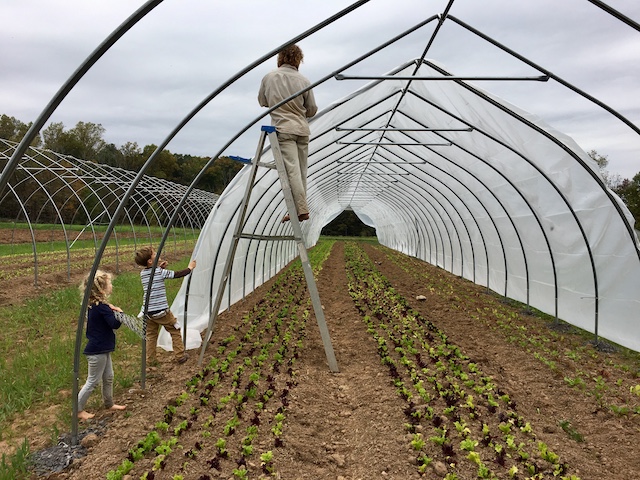
Affixing the caterpillar tunnel plastic covering on Sunday prior to Delta's leftover deluge.
It feels pretty good to mostly wrap up a big job that has been forcing me to work seven days a week for the past month. I still need to install the endwalls, run another anchoring rope, and set up wire for trellising but the two new caterpillar tunnels are just about done. We're excited to have even more covered space on the farm since crops really love being in there. I'm also looking forward to observing how the new waterways handle the extra water over the next couple of days. Inside all of our tunnels I still need to install driptape but pretty soon we'll be able to just sit back and watch the crops grow. We have one more bed to plant in the hoop tunnel this week then we'll plant the five short greenhouse beds the following week. Besides some miscellaneous mowing, tractor work is almost wrapped up for the season too. Garlic will be planted in early November, hopefully while we're celebrating the election results. Two more passes with the bed shaper then they'll be ready.
Most of our fall crops are doing well. We basically lost the 2nd planting of broccoli to disease, but other than that all fall crops look stellar. Cabbages are the biggest I've ever seen them. Chard and kale are performing fantastically. Fall celery is 90% harvestable (we lost 90% of our summer celery to disease). Escarole, endive, and radicchio look great. Lettuce, romaine, and lettuce mix are happy. Radishes and turnips were more productive than ever. We transplanted them this season and I think that helped along with perfect rainfall and magic soil.
Magic soil? Well we soil test and add fertilizer and compost and cover crops, but I don't think that explains exactly why the fall crops probably look the best they ever have. Because of the interconnectedness of everything in the soil biome/foodweb, ratios matter as much as amounts and it's hard to quantify everything that happens underground. And since we try to rely on rainfall for all of our bare ground crops' water needs this variable has a large influence on everything. Soil moisture conditions when plowing and shaping can also really impact the health of the crops. If the soil gets compacted at all, roots have a harder time penetretating and accessing nutrients, which can also get locked up. I'm not going to try to completely understand and explain why the crops are super happy and healthy right now but instead just really appreciate them at this time and know that a little bit of everything we do gets mixed around together with nature to achieve success.

October 4, 2020
Awesome Autumn!
by Farmer Derek
Awesome Autumn!
by Farmer Derek
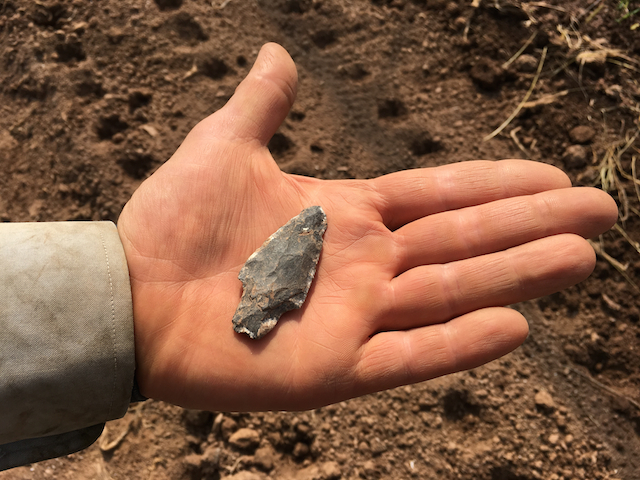
First find of its kind in 38 years. Pretty stoked to unexpectedly happen upon it in while getting ready to transplant in the hoop house.
We're very appreciative of last week's dose of rain. With plenty of days of dry weather before and forecast for after, the 2.5" of precipitation was just enough to ward off any need of adding water to the fall crops. In fact most crops look to be in a blessed state of balance at the moment. These weather conditions are pretty much just perfect for our fall crops, on our farm, with our soil types. We really don't need much rain here, especially for the bare ground crops, and definitely this time of year with reduced temperatures and length of daylight. Even at the end of that two-week dry spell with low humidity and a few high wind days crops were still luscious, green, and perky.
Even with wonderful outside weather our attention is shifting towards indoor production. We're quickly filling tunnels with crops that will be harvested in November, December, and beyond. Last week we transplanted lettuce mix and arugula into the hoop house; kale and bok choy into the hoop tunnel; and spinach into one of the caterpillar tunnels. The week prior head lettuce, lettuce mix, and chard filled up another of the new caterpillar tunnels. Three quarters of the hoop tunnel and the green house are all that is left. These will be planted over the next two to three weeks.
Before last week's big day of rain on Tuesday we sowed the final round of cover crops on areas that were home to winter squash, u-pick tomatoes, eggplant, okra, and sweet potatoes. I used a mix of oats and rye. Oats should die off during the winter if it gets cold enough. Rye should over winter, aggressively and tenaciously growing through springtime. In the past we've had stands of rye reaching 5-6' in height on fallow fields. That's a tremendous amount of organic matter subsequently incorporated into the soil biome. We'll only let it get that big if we're certain we won't need that space for a 2021 crop and can rest it until 2022. Rye is said to be allelopathic and could negatively affect following crops, but it could also be from the plants having soaked up much of the available nutrients which aren't released until the plants sufficiently break down. This is one reason we've embraced 'winter-killed' cover crops. They leave the soil in a more user-friendly state for spring and early summer planting. Rye is advantageous if we fallow a field or if we won't use it until mid-summer or later.
Hope you're able to enjoy this great weather!

September 26, 2020
Cold Open, Exit
by Farmer Derek
Cold Open, Exit
by Farmer Derek

Pilgrimage to Ringing Rocks County Park, also home to tallest waterfall in Bucks. Creek was dry but a hike up and down the exposed confluence of two disparate geologic formations where the water normally flows was pretty awesome.
Well that was a first for us. Harvesting on a frosty morning in September, in Summer. Was that a harbinger of a cold fall, winter, or just a strange, random aberration, an early polar vortex-like delivery? A plunge in temperatures this early in the almost-fall was a strange but welcome respite from summer's heat and humidity though I'm not ready to turn on interior heat (though we did fire up the kitchen wood stove a few of those chilly mornings I withheld from burning the aged and compressed organic matter taken from deep underground aka oil). Are we now in what is colloquially known as an "Indian Summer" or is frost and cold in summer irrelevant? From what I can tell no harm was done to any of the fall crops except for slowing down growth (this minor dry spell doesn't help). The summer crops we were still picking (peppers, eggplant, okra, tunnel tomatoes, basil) were at their annual departure date anyway. We'll probably see peppers and green/less ripe tomatoes for another week or so as we harvest all edible fruit. Speaking of basil, I hope you noticed it's longevity this year! Organic seed companies and universities finally bred a few varieties that are truly resistant to basil downy mildew which for the past five years or more has been the scourge that ended the basil season mid-summer (see picture below).
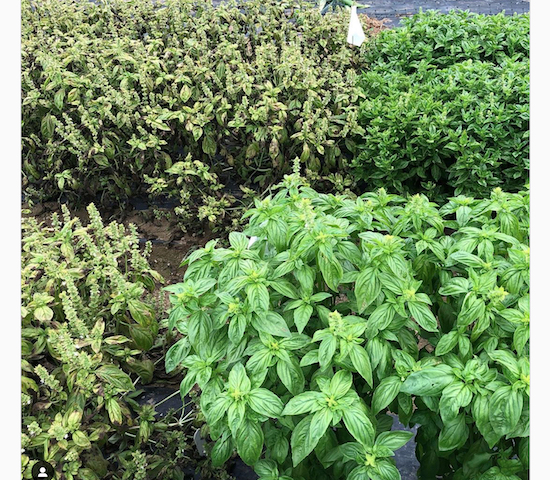
Johnny's Selected Seeds posted this picture comparing mildew resistant basil varieties to non-resistant ones. For many years all basil would look like the varieties on the left by August. The varieties on the right - Prospera and Rutgers Obsession - were the ones we trialed this year.
Last week we seeded the final crops for 2020. That's about 30 weeks since we sowed the first seeds this year. We also transplanted kale, lettuce mix, head lettuce, and swiss chard and filled up the space in the movable high tunnel plot as well as one of the two new caterpillar tunnels. Preparation began in the hoop house for next week's transplanting of lettuce, arugula, and greens mix. Since that space was used to harden off plants prior to planting outside, landscape fabric had to be removed and manually forked (aerate). It's possible we did the final cultivation of outside crops last week, too. We'll probably need to cultivate or weed at least one or two of the tunnel plots but maybe we'll be lucky. The new caterpillar tunnels will reside where 2020 garlic and straw briefly called home and the straw probably deposited more than one weed seed. Speaking of the two new tunnels, we should have the frame of one finished this weekend.
This coming week we plan to continue indoor preparations for fall growing. Tomatoes need to be removed to make way for fall crops. Soil needs to be forked, hoed, amended, raked. We'll probably continue to retrieve miscellaneous storage roots (watermelon radishes, purple daikons, beets, kohlrabi). By the way, last week we finished the modest sweet potato harvest. Thanks to the farm crew and members for that!
Happy Autumn!

September 20, 2020
Happy Fall Equinox!
by Farmer Derek
Happy Fall Equinox!
by Farmer Derek
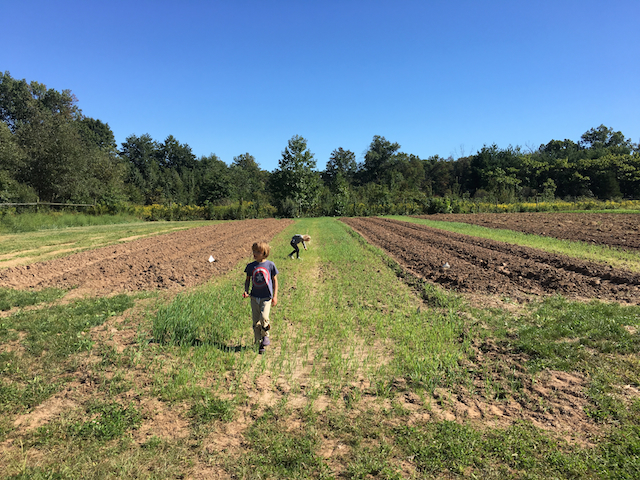
Caterpillar tunnel plots about ready for construction to begin when materials arrive this week. I just need to figure out how to keep the baby deer out of the field and away from those crops until they're covered.
Ahhhh autumn! Mid-fall temperatures precede your true arrival. Did we receive an extra early frost as many of our neighbors did? I don't think so, but it wouldn't matter much for our crops anyway at this point except that we could proclaim more topsy-turvy weather conundrums and extremes. As another farmer exclaimed earlier today, we endured late cold in May, record hot July, and now almost record lows in September. Every season seems to bring a new event, experience. I'm glad this cold snap came now instead of two weeks later because then it could have possibly produced lows bottoming out closer to thirty degrees. We normally don't see our first light frost until around October 10th, our first hard freeze at the tail end of October or later. Some years we've had teens in November then mild weather until January. It will be interesting to see what happens this year. Either way this cool dry weather can at least slow the growth of some of our first fall plantings that have grown exponentially during the consistent weekly rains and heat of August and early September. My only concern now since they're in perfect condition is the lack of rain which hopefully won't become an issue. We haven't had to irrigate any bare ground crops this season and I don't want to start now.
Upcoming this week we have our annual certified organic inspection. This is a thorough process to make sure organic standards are upheld. We'll need to show them official documentation of everything that goes on here, including seeds, plants, fertilizers, compost, amendments, supplies, potting soil, and records for seeding, planting, harvesting, sales, crop rotation. I'm glad there are some standards and rules in place to guarantee a clean and healthy food source. The Certified Organic label is a good as it gets currently.
This week we also look forward to harvesting all of the sweet potatoes. Unfortunately yields are way down, literally a small fraction of the great yields we've had the past 3-4 years. I attribute it mostly to weed pressure from the get-go. The laws of farming also state that a crop cannot not fail at least once every 5-7 years. In other words, this is the year when our beloved sweets have underperformed. Worry not, though, for many other fall crops will be exceptional. We'll learn from our mistakes and will make improvements next year. I'm glad fall is here and look forward to the change in produce.

September 13, 2020
Fields Filled
by Farmer Derek
Fields Filled
by Farmer Derek
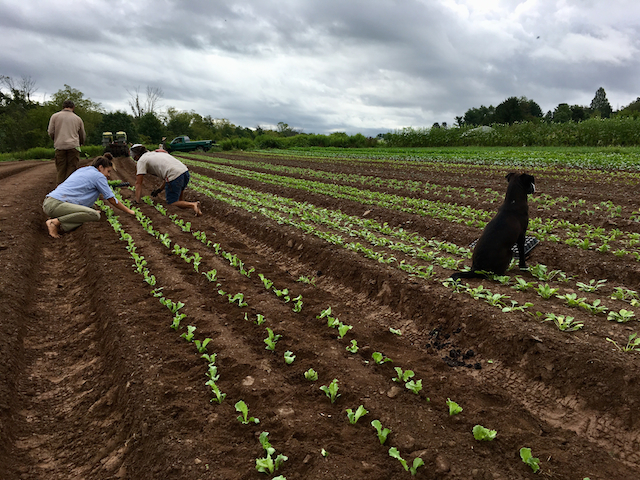
Transplanting one of the last rounds of lettuce a couple of weeks ago, I believe #24 of 25, which have gone into the ground weekly since the first week of April.
The 2020 outdoor seeding and transplanting season is finished. The last of the available/planned for field space was filled with the final round of external transplants and a last gasp direct seeding event to fill in the extra available bed space still vacant after transplanting. With the subsequent inch of rain received early Thursday morning the outdoor planting season was successfully concluded. This isn't the end of 2020 planting, though. We still have 2,300 feet of beds under cover, in the tunnels, to fill with crops to be harvested in November, December, and perhaps into winter 2021. There'll be a 2-3 week gap before we begin planting inside so at least we'll have a brief departure from one task we've been doing for almost six months.
Prior to establishing these indoor populations each tunnel space will require different methods of attention to achieve ideal conditions for planting into. Some tunnels house our seedling flats and need to have tables and landscape fabric removed followed by forking, hoeing, and raking. The movable high tunnel beds are able to be prepped with the tractor's bed shapers. This space was experimentally covered with large pieces of fabric for two weeks to passively kill grass and weeds and reduce the need for tractor tillage. After the bed shaping is finished we'll move the 30'x96' high tunnel over top. The hoop tunnel currently protects the 2nd and final round of tomatoes which will soon need to be pulled and composted and the beds will be forked, hoed, and raked. We should receive our new tunnels this week which will be erected to cover an additional 900' of bed space.
During this upcoming week we hope to harvest the rest of the potatoes. Spent summer crops like cherry tomatoes, husk cherries, and tomatillos will be cleaned up. New transplants will probably require cultivation. Some fields beckon the flail mower. Certain crops request hand weeding. More seeds will be sown for Late Fall harvest. A lot of time will be spent harvesting and distributing.
Please join us at a workshift if you can!

September 6, 2020
Assess, Observe, Reflect, Plan, Cope
by Farmer Derek (and Dana, ed.)
Assess, Observe, Reflect, Plan, Cope
by Farmer Derek (and Dana, ed.)
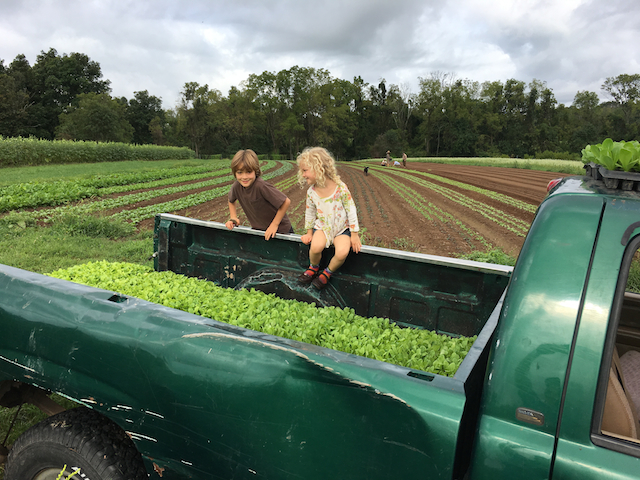
A big day of transplanting last week with some child and dog distractions. We transplanted about 7,500 plugs into 2,000 feet of raised beds. Crops included head lettuce, lettuce mix, bok choy, arugula, endive, and hakurei turnips.
Each weekend I walk or bike around the farm, visit each field, look at most of the crops, perhaps take some pictures, document the growing season, and make a to-do list for the upcoming week as well as take any pertinent notes to add to our digital ongoing farm production please-remember-in-the-future document. The last couple of months have been a challenge, a grind, but with a new month, cooler temperatures, and lower humidity (and maybe the light is seen at the end of the proverbial growing season tunnel) we can feel a bit more relaxed and less overwhelmed.
Overall it has been a good season of production and the rains haven't been terrible. But there is an added undercurrent of anxiety I'm assuming is due to the current pandemic, political turmoil, and the ongoing climate crisis. It's a mental challenge to steer past or through all the negativity we're bombarded with while considering what seems like the grim position the world is in. It's pretty hard to find anything to read that puts a positive spin on the future health of us and this planet. In the midst of these troubles the farm is a consolation. Immersing ourselves in the work is many things at once: a physical and mental outlet; an opportunity to affect the environment around us positively; a space and nourishment to be comforted by. We hope that the farm is a bright spot in your lives too, at least that is what we strive to provide. But I digress...
Crops look great. Late summer kale is the best of the season. Summer crops are still trickling in. Fields are being cleaned up and sown with cover crops. Storage crops are being retrieved and have decent yields. Outdoor transplanting is just about finished for the year while very soon we'll embark on tunnel transplanting. There's two more weeks of seeding for tunnel production then that's all finished until late February. My brain is beginning to think about winter travels, downtime, registration for 2021 Main Season CSA as well as staff needs, big farm projects, longterm goals, and retirement (joking). This weather is a welcome relief and joy and I hope you're relishing it as much as we are!

August 30, 2020
Ready for this Change
by Farmer Derek
Ready for this Change
by Farmer Derek
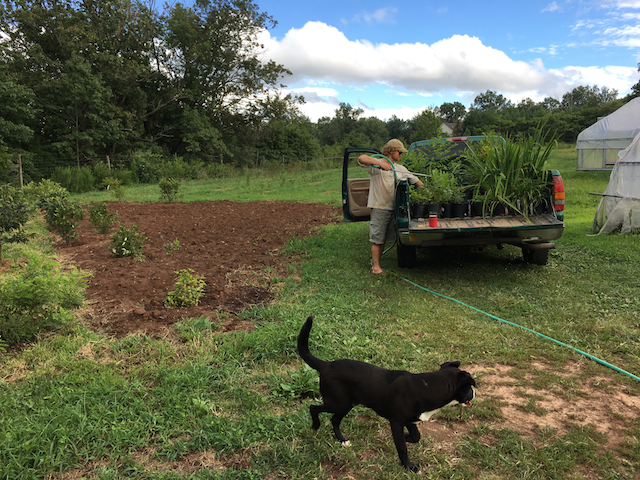
Playing with plants during a Saturday evening break from farm work. Ever tire of lawn and its high maintenance requirements and minimal environmental benefits? Convert it into something else that gives back to nature by using native plants.
Last week was a productive and busy one. We finally managed to finish weeding the fall carrots, which were also cultivated for the 3rd time. Additional potatoes were dug. Finished fields were sown with a cover crop mix of buckwheat, oats, and winter wheat. Field space was readied for our two new caterpillar tunnels. Because we're locating these at the bottom of a field with our heaviest soil and poorest drainage and at the bottom of the hill, we had to grade and create waterways while elevating the plots for the tunnels. (Interestingly, this soil type does extremely well in protected environments where moisture is controlled.) I had to prepare a similar site in the same field for our longer, bigger hoop tunnel in 2017 so this time was a bit easier and went a lot quicker. Before Friday's rain event we sowed fescue, perennial rye, and white clover in the waterways. Last week we also transplanted a lot of crops including arugula, head lettuce, romaine lettuce, endive, escarole, salad radishes, hakurei turnips, kale, beets, chard, and napa cabbage. We seeded the first crops for indoor fall and winter production including kale, head lettuce, lettuce mix, and chard. We also converted a grass area into a plot for a variety of native plants. And of course we also spent a lot of time harvesting, washing, and distributing shares. During this coming week we have more to seed, transplant, harvest, weed, clean up, maintain, and dismantle. Enjoy this weather!

August 23, 2020
Future Plans
by Farmer Derek
Future Plans
by Farmer Derek
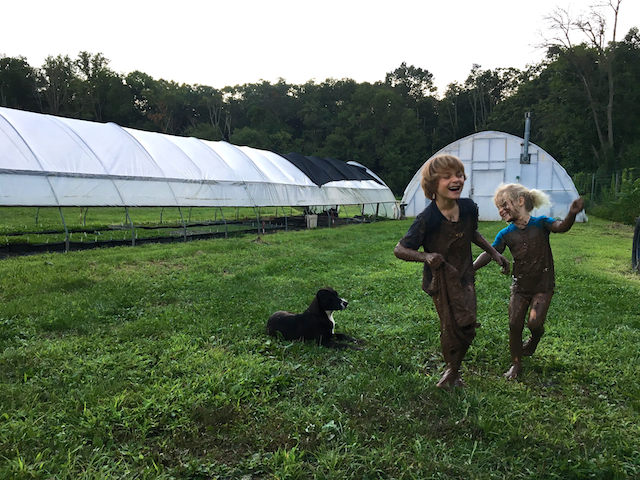
While parents considered site details for two new tunnels, mud was found and put to good use.
It may be that we're still stuck in summer, occasionally enveloped in thick humidity and blasted by hot sunshine. Nevertheless we're pushing our minds forward up the number line towards cooler weather and shorter days. The time for sowing seeds for outdoor crops has passed; we're now seeding for indoor, protected space growing in our numerous tunnels for fall and winter production. Even though it feels like we're still in the midst of summer - and we are - diminishing daylight over the next few months really slows down plant growth and we need to prepare for November, December, January harvests now. Crops sown now, transplanted late September will be harvested in November. Crops sown in September and transplanted in early October will be harvested in December or early January. Crops sown and transplanted any later will barely grow and won't be harvestable until mid/late February, too late for our growing seasons. From mid-November through end-January daylight drops below an important 10-hour/day mark and plant growth slows remarkably. Well established plants will continue to grow at a diminished rate, but young plants will mostly just sit in a dormant state. It takes a bit of a mind overhaul to switch mental gears from summer to winter growing plans, especially when one makes those plans in the opposite season. But with practice and good record keeping it gets easier.
On that note we decided to invest in two additional tunnels for the farm, albeit slightly less permanent ones that are theoretically movable. They will provide an additional 4800 square feet of protected space, increasing those farm environments by more than 50%. A big part of our motivation for this investment was to better control growing crops on the shoulders of the Main Season, especially for May and November harvests. This past April and early May was way too cold and drastically slowed down outdoor crop growth. October and November can vary significantly year to year and just a slight change in temperatures in the colder direction can impair crop production and harvestability. For example, a 35-degree medium frost compared to a 30-degree heavy frost can render crops unharvestable. 'Simply' putting crops in a tunnel gives them a 10-degree or so buffer. Adding another layer of fabric on the inside can basically pull them through the worst of winter all without supplemental Earth-sourced heat - thanks to the Sun for fusing hydrogen into helium 94,000,000 miles away!
In the here and now we're thankful for a return of the big leafy greens kale and chard. With decent weather these crops should be around for most of the rest of the season. We're also thankful for some dry weather. It's been pretty wet the past 1.5 months. We're also appreciative of member help harvesting potatoes and weeding the fall carrots. Depending on one's disposition, either or both of those tasks could be hard to enjoy, but we've made some great progress on both tasks. The carrots will probably be all cleaned up this week while the potatoes will slowly be chipped away at. We plant 5 varieties with different maturities so that we don't have to harvest all of them at the same time.

August 16, 2020
Harvest Update, A Reckoning
by Farmer Derek
Harvest Update, A Reckoning
by Farmer Derek
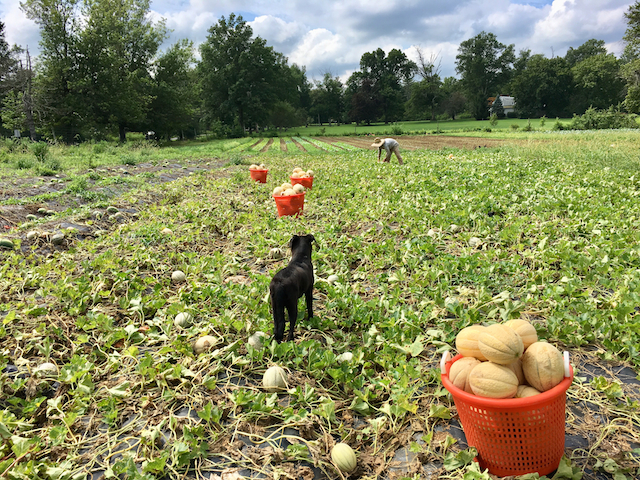
It's been a good melon year. Both plantings of watermelon survived and yielded well enough to distribute for 4 weeks, I believe for the first time in 12 years. We're picking cantaloupe from the 2nd planting right now and these should take us through at least this week and into next. Timing, for us, is crucial for these crops. There's only a small window to achieve crop maturity before migrating-from-the-south disease arrives in northern areas. Our goal is to plant the 1st batch of watermelon around the frost-safe date in early May then plant every 1-2 weeks after for a total of 4 successions of watermelon plus cantaloupe. Since we choose not to rely on sprays to control pests and diseases we proactively use preventative measures like row cover, rotation, timeliness, fertility, raised beds, weed control fabric, and drip irrigation. Seen in the background are rows of fall crops: beets, chard, kale, and napa cabbage.
We're in the midst of a transition, a departure, a lessening (with a lesson) of certain crops. Some crops have met their potential and leave us feeling satisfied with their yield. Others have us scratching our heads as we try to understand what undermined their success. Let's not over- or understate the challenge of growing hundreds of varieties of crops over a 9-month growing season. The plethora of variables beyond our control, those we choose not to control because we farm organically, is a daunting list but one which must be assessed when goals aren't met. Crops whose seasons are ending but overall met their yield expectation include watermelon, cucumbers, and zucchini. It's been nice being able to rely on them for the past 1 and 2 months. What I'm most disappointed by is the nosedive drop in tomatoes. From a peak haul of 1,500lbs two and a half weeks ago to barely enough to cover Thursday and Saturday pick up last week is maddening. A quick consultation of past seasons shows me that tomatoes peak somewhere betweend 7-10lbs/member for a week or week and a half then for the next 2-3 weeks provide 4-6lbs then end with 2-3 pounds for a few weeks. So, why such a quick decline this year?
I believe it's a disease issue which could be one or more of the following: anthracnose, alternaria, septoria leaf spot, verticillium wilt. It feels like it's recurring, unfortunately. Last year the field tomatoes had the healthiest foliage on the biggest plants we've had, yielded well very briefly, and also declined rapidly. We practice a minimal 3+ year crop rotation, use covered raised beds, keep plants elevated/trellised to minimize any soil contact and splashing. But, I think, our weakness lies in our unsterilized trellising method. We use 7-foot t-posts and aluminum wire to support the plants and it's possible a disease organism is overwintering on one of those materials. Pruning and clipping means we're in amongst the plants regularly so if a plant is sick the illness can easily spread. Plant stress also can exacerbate susceptibility to illness but the tomatoes this year enjoyed pretty good conditions (except for more recently). July was very hot, humid, and wet, so that could provided too much stress. I'll be thinking this over and will hopefully come up with a solution for next year. Fortunately our 2nd planting of tomatoes, in the hoop tunnel, is starting to ripen and will hopefully yield well enough to satisfy everyone (that is if we can keep the armyworm larva population under control).
Eggplant is another crop that has me perplexed. Big, healthy plants, a good yield for a couple of weeks in the beginning, then just a trickle for the past few weeks. Bookending tomatoes and eggplant in the same field are okra and sweet peppers, crops that are performing as well as expected and look healthy overall.
Thus, we apologize for crops that aren't abundant like they should be.

August 9, 2020
Time to Dry Out
by Farmer Derek
Time to Dry Out
by Farmer Derek
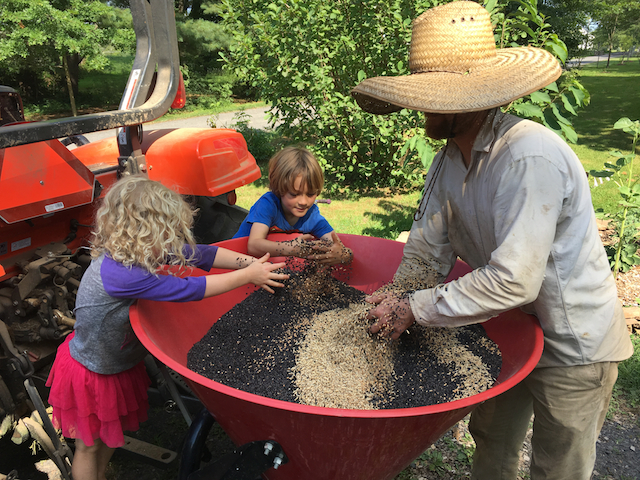
The highly technical and precise science of blending cover crop seeds.
Last week was punctuated by Isaias. I hope you fared well. We were relatively lucky here, only receiving 2.8" of rain, some gusty wind blasts, and a few fallen trees and branches. Not far from us 7" of rain fell and many folks lost power, so overall we made it through relatively unscathed. The worst event from last week was probably the malfunctioning of our cooler system where all of our 2,500 pounds of onions were being stored. Of course it also broke down on Monday morning when there is no time available to devote to the problem until late in the day. Fortunately replacement parts arrived by week's end and function was restored. I did move all those onions into the walk-in cooler temporarily, and now they'll have to be moved back. Soon they'll be joined by potatoes in that less humid storage room.
Last week's wet weather kept us from accomplishing some of our normal weekly tasks like transplanting and cultivating but there were plenty of other jobs to keep us busy. Tuesday we mostly stayed out of the hazardous weather while the other days were spent harvesting, weeding, pruning and trellising, mowing, weed wacking, touring, and seeding.
Carrot seeds have begun germinating and popping up to meet the sun, as well as the acres of cover crops sown last weekend.
This week we'll hopefully have enough time to dry out before the next rain event so that we can cultivate where needed as well as transplant many thousands of fall seedlings including beets, chard, lettuce, kale, kohlrabi, napa/chinese cabbage, dill, and cilantro.
Might as well give a shout out to our new waterways, Jim the 'dozer operator, and the surveying and designing NRCS of the USDA provided. Where there used to be erosion and water woe was nothing but safe soil bliss. Permanent conservation, sustainability improvements meeting expectations are a wonderful thing.

August 2, 2020
August Shares
by Farmer Derek
August Shares
by Farmer Derek
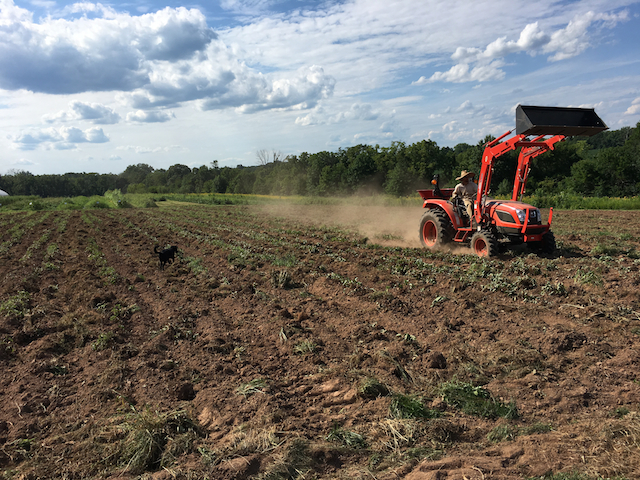
Remember those spring peas and strawberries? That area was transformed into space for fall cover crops (unharvested grain/legume species that protect and nurture the soil).
What a week. I'm tired but pulling energy from deep within, from somewhere, from the future because there is eventual rest there. Borrowing. Monday is normally the most difficult day of the week. Not just because the weekend is over, which is basically just a time for different work, and the official work week begins, but because harvests are huge and heavy right now and it's the day cucumber and zucchini harvest coincides with an actual pick up day so harvest morning becomes harvest afternoon. Binning shares the way we are this year also means that two of our staff need to break for lunch and be ready to pack by 12:30pm. Added to Monday last week was an epic tomato yield. Seven hundred pounds of heirlooms came out of the high tunnel and 800 pounds of red slicers were harvested in the field. The prior harvest day, Thursday, yielded about a third of that weight, and this peak caught us by surpise. Hey, but rejoice, fresh tomatoes are a summertime treat, a thrill! In my mind I associate early August with peak tomatoes, but perhaps I need to adjust that brainwave to the end of July since that's when it's occurred this year and last. Oh, and it was super hot, like borderline unsafely hot. But we persevered and will.
This is a great time of year. Early August marks the halfway point between the summer solstice and the fall equinox and daylight hours will quickly reduce and hopefully the worst heat is behind us. Large contiguous areas of spring and early summer crops are now available for cover crops, which is what I spent all day Saturday preparing for. Timing matters and when a perfect opportunity presents itself I try to take advantage. Perhaps I even get excited by the prospect of putting those fields to sleep for the winter which largely removes them from management and active thinking for the next half year. That's if the sown seeds take and we get a good stand of desired plants. I flail mow, chisel plow, broadcast the seeds (in this case it was oats, wheat, and buckwheat), then disc harrow them in. The chisel penetrates the soil a good 8" deep every 12" across the 7-foot implement, loosening and fracturing but without too much negative disturbance, and the disc penetrates 2-3" every 6" across, chops up residue, and mixes the seeds into the soil. It's the best and quickest method for us to convert spent 'cash' crop fields into cover cropped fields. Dry conditions followed by ample rain are ideal. On Saturday I was also able to sunrise sow another mile of carrots, destined for a mid-fall harvest. I also upgraded/improved a waterway at the top of the u-pick field below the ranch house where excess water has been bothering crops and me.
Upcoming this week is a hurricane, harvesting, a farm tour, weeding, transplanting, seeding, cultivating, and mowing.

July 26, 2020
Hot Humid Dry to Wet
by Farmer Derek
Hot Humid Dry to Wet
by Farmer Derek
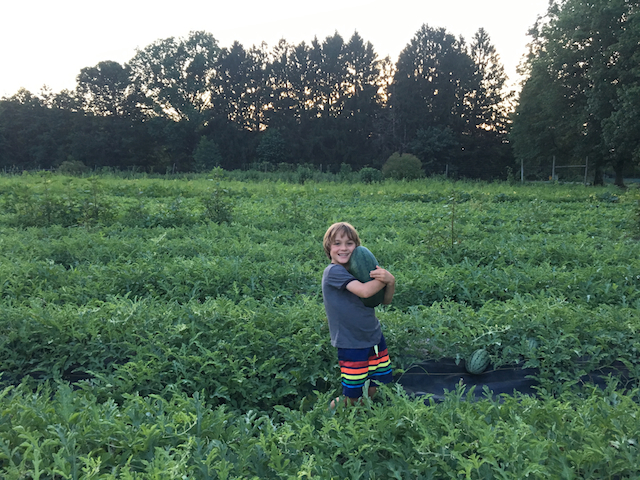
Loving the first melons of the season.
The sweltering heat continues. Numerous rainstorms and Friday's brief cool down provided some nice relief. A few more days of super-heat this week then it looks like we'll descend back into more tolerable working conditions. It is July which traditionally seems to be our hottest and wettest month. I'm not sure how many days have been above 90 this month but I would guess 90%. Precipitation has eclipsed the 6" mark with about a week to go but doesn't feel like too much just yet. After the 1.2" Thursday night/Friday morning the ponds were filled to capacity once again. I haven't scoped out all the fields since that deluge but am hopeful there wasn't much soil disturbance, though the lower pond was pretty turbid. Due to increased impervious surfaces on neighbors' properties upstream there's been an increase in stream scouring of tributaries feeding our ponds, which is likely the source of suspended soil particles.
Big harvests are continuing. Forty percent of the onions (approximately 1,250lbs) have been safely stowed and today the next round will be pulled and left in the sun to hopefully dry and cure for a few days before being put in cold dry storage. After the onions we'll begin harvesting the early variety of potatoes - Dark Red Norland - after the tops die back and they cure and heal in the soil, probably early to mid August.
Desperate un-irrigated crops received some much needed rain last week. I'm perennially amazed by our crops' ability to tolerate hot and dry conditions. Little transplants went into raised beds a week before last Wednesday evening's light soaking rain and survived healthily for a whole week of blazing sunshine and very high temperatures. This is when I'm most thankful and appreciative of our relatively heavy north-facing soils. Those transplants should now grow like mad but also wanting to sprout and thrive are the weeds. With the numerous soakings last week the thousands of bed feet of transplants will need some timely cultivation of the germinating weeds while they're at the vulnerable thread stage. Since there is so much bare ground to work we'll probably utilize the tractor and our antique basket weeder for some of this work. We'll still need to manually hoe in between plants, but the tractor should save us hours of cultivating.
This coming week we'll also probably try to harvest the last of the onions so please join us for a workshift to help!

July 19, 2020
Challenging Heat
by Farmer Derek
Challenging Heat
by Farmer Derek
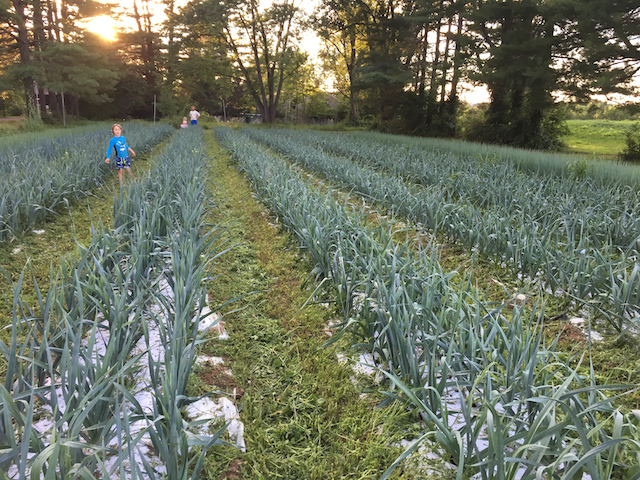
Feeling good about a robust patch of leeks following a difficult job of trimming and mowing aisle grass and weed growth in what could be our most fertile field.
The hottest spell of the season has descended upon the area. The worst of it looks to be short-lived, that is if you count upper 80s or low 90s as relief. All will be well and we'll persevere through it as long as rain is provided with the transition from super heat to regular heat. This kind of weather tests our resolve and patience. It's quite easy to worry about all the crops and be in a constant state of panic. It's probably the most difficult time of the year for us regardless of the heat. Harvests are getting heavier which basically means we're moving more weight around from the fields to the barn to the shares. Our minds and bodies feel a subtle fatigue from the constant daily work that began many months ago. We're concerned that newly transplanted crops might not survive until the next rainfall. Watermelons are starting to ripen but will there be enough for all members? Will wild critters find them before we do? What's the best way to harvest and cure onions for longterm storage? Are our coolers working properly? Will lettuces head up and hold up until the next harvest or will they bolt faster than we can keep up? Besides the crops we must pay attention to ourselves during this extreme weather. Even harvesting a few hundred pounds of tomatoes at 10am on Sunday morning with Farmer Dana to reduce Monday's harvest to-do list results in a thoroughly sweat drenched state that fails to evaporate and cool thanks to the humidity and lack of wind. After watering the flats in the hoop house and greenhouse a seat in front of a fan with shades drawn and doors shut cools me down just enough. Give me a bite of watermelon and I'm all good.
Either way, overall, it's an exciting time on the farm. Summer crops are thriving and long-season crops begin to beckon: watermelon now, cantaloupe soon, onions now, potatoes soon. We strive to keep up and ensure proper harvest and stowing. As we harvest our footprint slowly reduces and we have less farm space to actively manage. Very soon we'll begin sowing cover crops and putting fields to sleep for the winter. Each week that passes more plants go in the ground and less plants still need to be planted, less land needs to be prepared. For now, though, we'll focus on getting through Monday's harvest and distribution, on what could be the hottest day of the year. Stay cool!

July 12, 2020
Whirlwind of a Week
by Farmer Derek
Whirlwind of a Week
by Farmer Derek
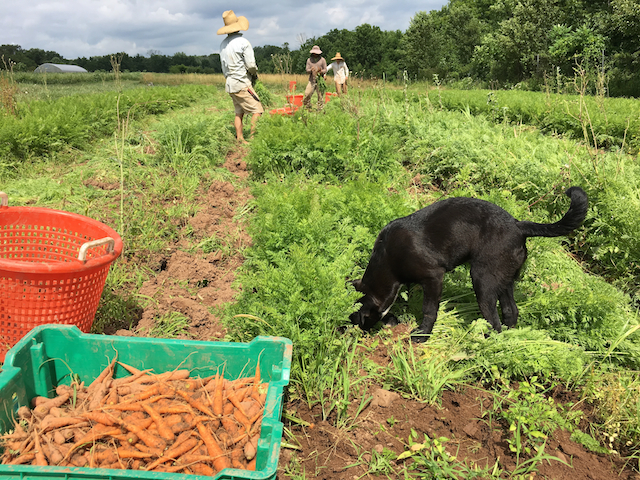
So far so good! We're pleased with the carrot haul this year - good germination, no rot, hardly any rodent damage, and pretty decent sweet flavor for a spring/summer carrot planting. We have 3 additional beds to harvest this coming week.
What a whirlwind of a week. Looming planting and harvesting tasks, out of control pest pressure, daily thunderstorms, high heat and humidity, more work to do than we have time for. A week filled with the good, the bad, and the ugly.
The good: Ample rain was received and the ponds have filled back up. The waterway improvements worked as planned. Thanks to some great help from CSA members, all of the 2020 garlic has been retrieved, tied, and hung to cure and seventy percent of the carrots were harvested (over 2,000 pounds). The rest of the 2021 strawberry plants arrived and were planted. The 2nd planting of tomatoes, which is inside the hoop tunnel, have been pruned and trellised (for now). The house vacuum seems to have saved our flats of fall broccoli, cabbage, cauliflower, and rutabaga from the dastardly flea beetle. Hours of sucking then putting the flats inside the greenhouse stemmed the tide. Lesson learned/remembered: don't give the flea beetles a mid-season snack after the spring brassicas have been mowed and don't leave the flats of fall brassicas in the hoop house unprotected after they've germinated under the shade cloth.
The bad: The heat, humidity, and daily rain showers have made cultivating and weeding a tough task to keep up with. We were faced with constantly too moist soil conditions to reshape and/or hill beds and kill weeds. A tropical storm dumped heavy rain which carried some soil downhill and out of the fields.
The ugly: We've lost the summer celery battle to a soil borne disease that causes the interior of the plant to rot and the leaves to curl rendering it unharvestable. We managed to only save approximately 40% of the crop. We'll either have to identify a variety that isn't susceptible to this issue or forego (spring/summer) celery in the future (we still have the fall planting to transplant and harvest). I was just thinking about how much I enjoyed it in my breakfast smoothie. Italian dandelion, which we used to perceive as immune from any kind of growing hardship, is now acquiring some kind of leaf tip blemish.
But more good: Tomatoes, eggplant, peppers, okra are starting up; cucumbers and zucchini continue their prolific ways; watermelons should be ready soon; flowers are looking spectacular; ample sunshine will hopefully dry things out a bit so we can plant all those beetle beaten brassicas. Onward!

July 5, 2020
That Summer Feeling For Sure
by Farmer Derek
That Summer Feeling For Sure
by Farmer Derek
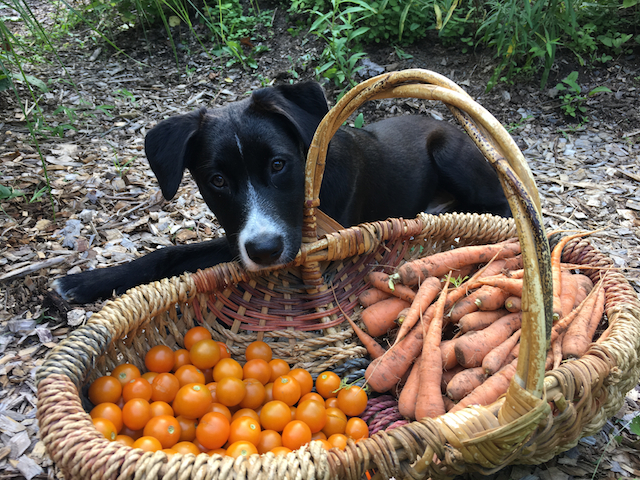
A test haul of some of our very favorite orange crops coming to shares soon! We asked Finch to show us his sad puppy face.
You know it's July when the 10-day forecast shows temperatures reaching 90 degrees daily. And it's early July when the spring-sown carrots and fall-planted garlic need to be harvested. And there's a chance of a thunderstorm every day. And when the sun wakes you up at 5:30am on a day when you don't need/don't want to set the alarm. But at least those afternoon moisture events bring clouds and cooling rainfall. Another 1/2-inch of nice rain was received this past Friday evening following the planting of 4,000 of the 7,000 strawberry plants (3,000 were damaged/destroyed/lost by FedEx but will be re-sent this week). We've been lucky so far this season with just about enough rain with no major deluges. We're much happier when things are on the dry side though our nerves do fray when it doesn't rain at all and temperatures soar. At least with this heat wave there's a chance of daily rain though that could mean you receive 3" and I receive .25". It'll be a challenge working in the heat but we must.
Besides planting 4/7ths of our 2021 strawberries last week we were of course busy doing many other things. Another round of cilantro, dill, and lettuces went in. Cherry tomatoes were pruned and trellised. Pea trellising was removed. Beet roots and cabbages were harvested. Crops were cultivated and weeded. Aisles were push mowed. Thousands of seeds were sown into trays (fall kale, chard, beets, fennel, lettuce, basil). Unused fields were flail mowed and chisel plowed. Raised beds were fertilized and reshaped for the 4,000 feet of fall broccoli, cauliflower, and cabbage. Each pass with the shaper takes place after a rain event and removes germinating weeds and lowers the weed seed bank. Rain also stimulates microbial action in the soil and helps break down organic matter making for some nicer planting conditions. In a perfect world I'll chisel plow once, primary shape twice, and finish shape twice, with a rain event between each action. I typically begin preparing ground a month in advance. We've now opened up ground for our entire 2020 planting footprint. Areas I just chisel plowed will be planted in August and September.
Upcoming this week will be planting the rest of the strawberries as well as lettuces. Aforementioned broccoli, cabbage, and cauliflower may also go in. Speaking of those, they were attacked by flea beetles in our hoop house. What was a few beetles became an onslaught of perhaps the entire spring colony. Today I went out with our vacuum and spent an hour sucking thousands of them off the plants and from the roof. I'm curious to see if it will be effective but I do believe I put a serious dent in their population. I'm pretty sure vacuuming is an organic approved pest control. I will save our fall brassicas!

June 28, 2020
Rain, Just In Time
by Farmer Derek
Rain, Just In Time
by Farmer Derek
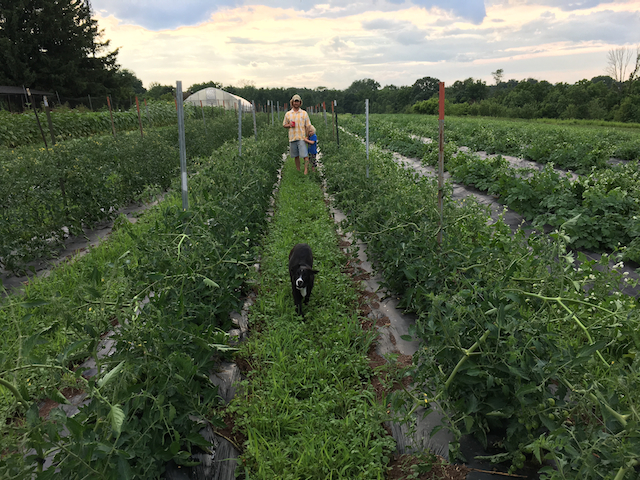
A post-rain evening cherry tomato patch check - ripe fruit coming soon!
We experienced two much needed rain events last week, conveniently spread out five days apart, after work for was done for the day, just enough to give the crops and soil a heathy dose to absorb without any soil erosion. I was thinking about the acre of potatoes slowing forming under the soil and the 3,000 newly planted sweet potato slips. Also the thousands of feet of lettuces, beets, chard, and the empty ponds, the frogs, toads, and turtles. But the rain came, and we're thankful. We're still going through the motions irrigating certain crops on a weekly basis regardless of the rain since overall it's been a relatively dry spring at the farm and there's not much moisture in the soil. The two rounds of tomatoes in the two tunnels need well water no matter what since they're out of the weather anyway. When I turn on their tubes I also irrigate the 3 plantings of zucchini and cucumbers because two of the plantings are fruiting and they enjoy consistent moisture. Onions are receiving a regular dose because they're starting to bulb up and are relatively shallow rooted and also because the area they're planted in drains very well. But there's less stress, less tension after an ample rain event.
The summer solstice came and went last weekend. It marks an interesting time on the farm. Whether or not there is some deeper celestial meaning, there is a slight shift in the farm's focus, attention, workload around this time (at least from my perspective). Up until the solstice we work like mad to transform the bulk of our acreage into raised beds, spend a lot of time on the tractor plowing and bed shaping, and sow seeds and plant crops on all this space. Around the solstice our weekly planting allotment lessens and our attention begins to turn more towards harvesting and maintenance. It feels like a more enjoyable time, especially when crops are bountiful and healthy. Last week we push mowed way too much row feet of raised bed aisles, but they needed attention and we had to do it. Instead of having bare soil in between beds that requires mechanical cultivation and would be susceptible to erosion we intentionally allow volunteer species (weeds) to grow, sequestering carbon, protecting the soil, increasing organic matter. We transplanted the final round of cucumbers and zucchini; the 4th basil; the 14th lettuce; and the 8th and 9th beans. Field slicer tomatoes were pruned and trellised. Eggplant, okra, leeks, scallions, lettuces, and herbs were weeded. Sweet and hot peppers were staked and supported with twine.
Very soon we'll embark on some big harvests - carrots, garlic, onions, and potatoes. Most of these tasks are accomplished with the beneficial help of workhifts so be on the lookout for an e-mail announcement. Most harvesting jobs are good for kids as well.
On our schedule for this week is the immense planting of 7,000 strawberry plants - our 2021 crop. Weekly tomato pruning and trellising continues, as well as whatever cultivating, weeding, transplanting, and harvesting that needs to be done.
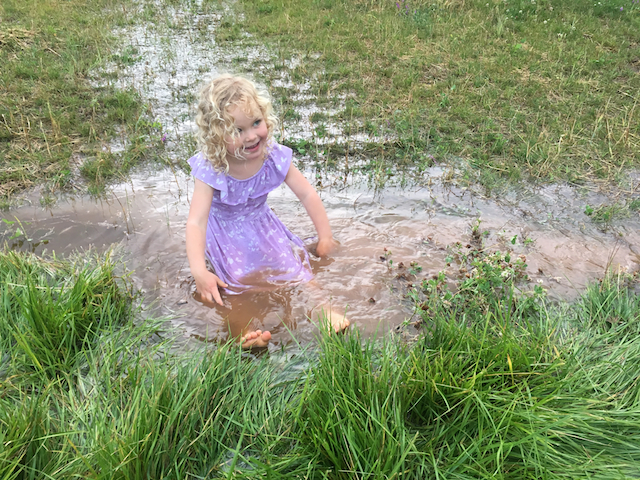
Rejoicing, celebrating the rain event, unable to withstand the severe gravitational pull of a puddle.

June 21, 2020
Into Summer
by Farmer Derek
Into Summer
by Farmer Derek
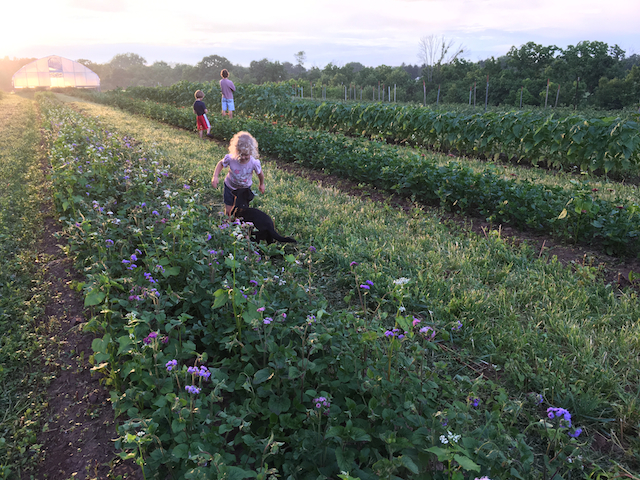
Flowers are now available to pick. Please consult the u-pick board for quantity. And bring your scissors.
There are times when we're extra appreciative of our fields' aspects, situations, soil types, organic matter, etc. It's mostly when we go through extended dry spells, like we're in at the farm right now, because our soils do not require a lot of precipitation to remain productive (face north, high clay content, decent amount of organic matter). Yesterday there were storms all around us and we watched the dark clouds and yellow and red radar spots go right on by. It appears there's a chance of rain daily for the foreseeable future but I figure the just-right rain event is waiting until I've spent significant time adding irrigation to new locations. Fortunately I already installed tubing for the high value long season fabric covered crops such as peppers, tomatoes, melons, squashes, cucumbers, onions, and leeks but all of the bare ground short season crops currently wait for Mother Nature to provide. We received 2/10 of an inch of rain 10 days ago and now we try to patiently wait for more. I did just read that parts of southern Jersey received 3-5" of rain within the past couple of days which is way more than we need here. Plus that's of the disastrous heavy type which we can always do without.
Ignoring the weather for a minute, the farm is in pretty good shape at the moment. The dry weather allows us to move swiftly through our to-do list. Last week we planted the last of the 4 melons; another succession of lettuce, edamame, beans, basil, cilantro, and dill; and the second round of tomatoes. These tomatoes went into the hoop tunnel where the first round of sugar snap peas resided. It was flipped and planted in record time. Inside the various tunnels are some of the places around the farm where we practice intensive cultivation (multiple plantings in the same piece of ground in the same year; we have enough outdoor field space that we can only grow one crop in each spot per year and let the soil rest a bit longer). Raised beds were prepared and finalized for the 7,000 dormant strawberry plants we'll be receiving next week that we'll harvest in 2021 (we treat strawberries as annuals, planting a new patch each season as a way to stay ahead of pests and diseases). Tomatoes were pruned and clipped to the trellis system. Landscape fabric was installed in the aisles of the final planting of zucchini and cucumbers. Seeds were sown and fall celery was potted-up. Onions were weeded a second and final time (now that we're past the solstice most of their time and energy will be spent forming bulbs, or so I've heard). The entire farm was flail mowed. Four thousand feet of preliminary beds were formed for fall cabbage, broccoli, cauliflower, and rutabaga. Three thousand feet of sweet potato and eight thousand feet of potato beds were hilled and cultivated.
This coming week we'll embark on more crop maintenance and a lot of aisle mowing. More time will be devoted to harvesting now that zucchini and cucumbers are starting. These need to be picked every two days (and as of now the plants are the biggest I've ever seen and hopefully this translates into an exceptional harvest). Weeds will be pulled and crops will be stirrup-hoed. More lettuce and beans will go in. And just maybe we'll spend a lot of time irrigating.

June 14, 2020
Benevolent Weather
by Farmer Derek
Benevolent Weather
by Farmer Derek
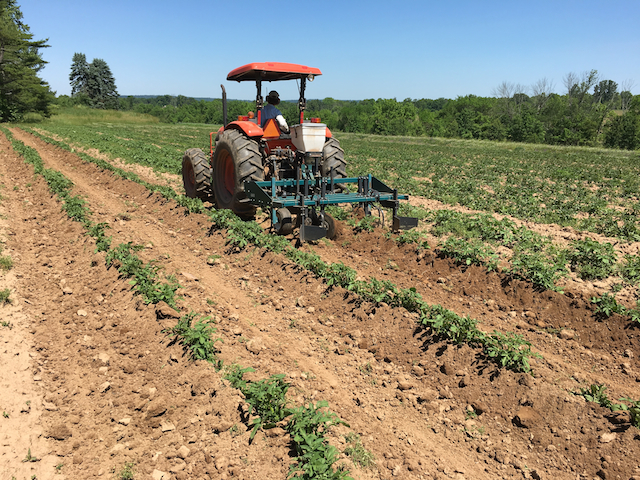
'Hilling' potatoes.
This stretch of awesome weather is both invigorating and calming. We can work a bit longer, a bit harder, without worrying about succumbing to some kind of heat-related malady. Mid-week was a real challenge as temperatures soared into the 90s with high humidity but the crew persevered and accomplished much. Perhaps the only downside to this weather is the need to hook up and run irrigation but with everything looking so beautiful and peaceful it's hard to feel negative about the extra weekend hours required to set these systems up. When the weather is this nice all I want to do is be outside anyway.
Last week began the many-man-hour-continuous-job of tomato trellising. Seven foot t-posts are pounded 2 feet deep every 12 feet or so, 5 wires are installed every foot up the post, hybrid plants are pruned to 1 leader/heirlooms to two, then each plant is clipped to the wire as they grow up. We will be working on this system every week or two until late July. Pruning and clipping are good jobs for hot days, but carrying and pounding stakes not so much. Growing our tomatoes in this manner is a lot of work, but makes the fruit easier for find and harvest and has the benefit of increased airflow to hopefully ward off illness.
The potatoes were finally ready for their first round of hilling, which is basically mounding soil up around the plants using heavy-duty disks on a tractor pulled toolbar. If the plants don't grow too fast I'll probably try to get another round in this week. Since I hilled them last Tuesday it appears they've already shot up another foot. Hilling them gives the tubers more room to grow and increases yields. From the potato 'seed' (aka last season's potato) all new growth is above, so we plant the seed deep, then hill.
This is also the time of year when we can drastically reduce the amount of crops perpetually covered by the floating bug barrier fabric. Susceptible crops such as watermelon, zucchini, cucumbers, cantaloupe, winter squash, and eggplant have all been in the ground long enough so they're beyond the sensitive stage and are even beginning to flower. Removing the cover will allow us to view all of these crops for the first time since they were planted a month or so ago. We perceive and glimpse them through the fabric but once they're uncovered we can finally do a full check-up. It's also nice to clean up the field and put this infrastructure back in the barn. Some of the aisles also need mowing maintenance.
I hope you're enjoying this weather as much as we are. It's a perfect time to pick strawberries and peas and to come to the farm to work with us during a workshift.

June 7, 2020
Drying Out
by Farmer Derek
Drying Out
by Farmer Derek
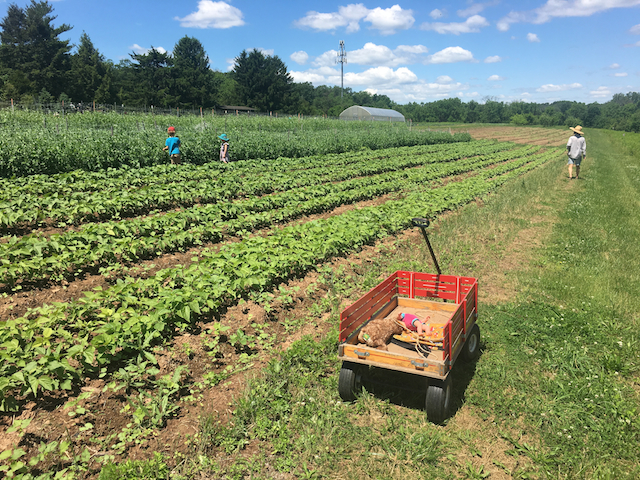
Observing (and taste-testing) the outdoor sugar snap and snow peas during our Sunday field walk. Outdoor snap and snow peas should be ready/mature later this week (#4) and definitely by week #5. A few successions of green snap beans are in the foreground.
Ample rain, high temperatures, a good amount of sunshine. It's the season for growth and the time to maturity of crops to speed up (lettuce can mature twice as fast in June-August as March-May). Somehow we're already into the 2nd week of June and harvest week #4. Time has sped up as well; at least it feels that way, since there's hardly a restful or reflective minute during this part of the growing season to slow it down. That said, I believe we're about to embark on a transitional phase as the bulk of our spring and summer crop planting is behind us. We're entering a few weeks of summer succession plantings of crops like beans, edamame, herbs, and lettuces before we descend into the fall crop planting timeframe. During this time there aren't any huge plantings of long-season crops. Roughly 2/3 of the farm is already under crop production so we're also firmly in crop maintenance mode. There's less open field space to chisel plow, make raised beds in, and plant into. We don't begin incorporating crop residue, spreading compost, or the sowing of cover crops until mid-July. I still need to finalize the last few pieces of our annual crop rotation puzzle to determine which fields will be the home to which late summer and fall crops, based on a 3-5 year plant family cycle that also factors in time of planting. Probably some portion of the still unused land will be fallow this year.
We filled a lot of field space with crops this past week. Three thousand sweet potato slips were planted in wet/muddy/slippery conditions this past Friday. Earlier in the week we planted 5,500 leeks, 800 lettuces, 450 cantaloupe, a few thousand beans as well as edamame, and hundreds of basil plants. New on our agenda for this coming week will be tomato pruning and trellising.
We were lucky during the multiple rounds of crazy weather this past week and we hope you were too. This coming week looks to be a bit more mild with lower humidity; perfect for strawberry picking. See you at the farm!

May 31, 2020
Blue Sky Beauty
by Farmer Derek
Blue Sky Beauty
by Farmer Derek
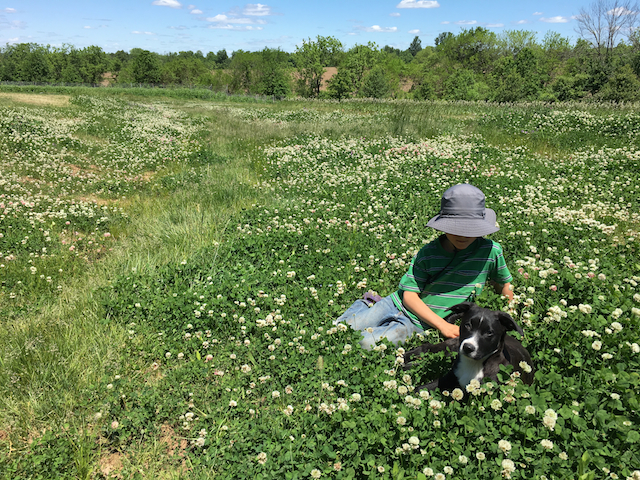
This is a scene we're particularly proud of right now. The kid and the dog we're proud of too, but I mean the waterway teeming with flowering clover(s). It's a beauty for us to gaze upon, but any time we can provide an abundance of nectar for our foraging insect friends, especially now with rampant declines of many insect species, we're happy to do so. I remember as a kid it was always dangerous to walk around barefoot when white clover was in bloom because there seemed to be bees everywhere. It's not the case anymore but we provide what we can for them.
Following another satisfyingly ample Friday rain event we rejoice in some quintessential late spring weather. To beckon Friday's circumspect rain cloud performance I turned the irrigation system on for a few hours. After water communicated with water, we were doused by a nice trailing storm cloud that dumped just what the farmer ordered. It doesn't happen often, but when it does we're appreciative and thankful for the exact right amount of rain, especially at the end of the normal Mon-Fri work week. And by right amount I mean enough to give plants a good drink but not enough to keep us out of the fields (in this case .7").
Last week was full of farming (planting, seeding, weeding, cultivating, harvesting, mowing, plowing, bed-shaping). Into the ground went the 4th and 1st plantings of beans and edamame, respectively. The 2nd zucchini and cucumber succession went in and was covered to keep the pesty/pesky striped cucumber beetle at vine's length. The 10th planting of lettuce, the 5th scallion, and the one and only eggplant and okra patch was planted. The eggplant was hooped and covered just like the zucchini and cucumbers to keep the nightshade flea beetle away while the plants are young and getting established. The acre of potatoes and the new raspberries were fertilized and tractor cultivated. Three successions of beets are almost finished being weeded while the onions were wrapped up. Beans, flowers, lettuces, and herbs were manually cultivated. Fields were mowed in preparation for upcoming fall crops like broccoli, cauliflower, and cabbage that we will transplant in early July. Seeds of beans, edamame, lettuce, dill, and cilantro were sown. Crops were harvested, binned, and distributed.
Upcoming this week we have leeks, sweet potatoes, cantaloupe, lettuce, basil, dill, cilantro, beans, and edamame to plant; more crops to seed and harvest; prepare soil for summer planted crops including the 2021 strawberry patch that goes in at the end of June; and begin setting up the trellising systems for field, heirloom, and cherry tomatoes. See you around!
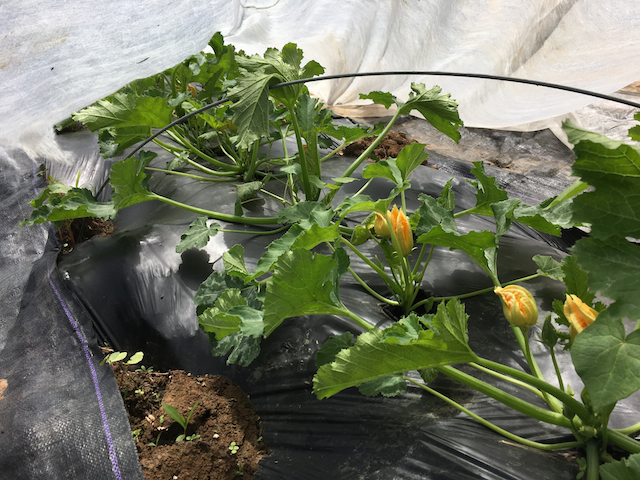
Zucchini blossoms on protected plants that were transplanted May 14th (we were hoping to get them in a week earlier but the late cold weather delayed planting). There are enough creatures flying around under here that pollination seems to be occurring just fine even though they're hooped and covered.

May 24, 2020
Always a Challenge
by Farmer Derek
Always a Challenge
by Farmer Derek
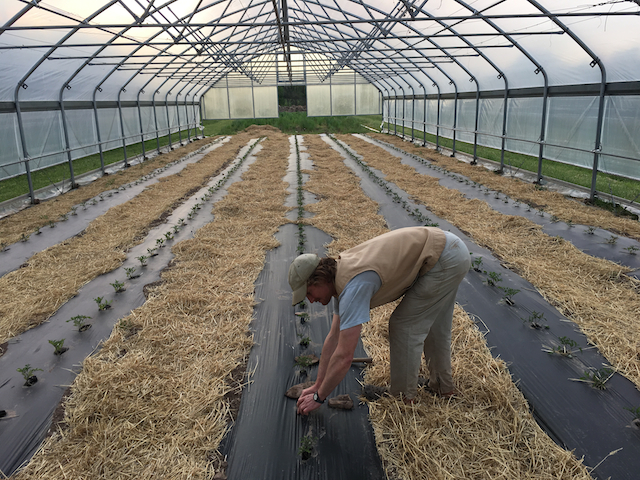
Sustained strong wind wreaks havoc on some of our farming systems, loosening black plastic mulch which can cover and smother plants. Here, we're applying a quick fix using rocks as weights to secure the fabric around the plants.
Now that we're into the harvest season (I don't think we can hit a pause button) my spirit(s) were saved by some much needed rain Friday afternoon and evening. Because if it didn't rain in order to coax crops along to eke out some more early season springtime shares I was going to have to spend much of this weekend setting up irrigation (and grumbling in my head). It had been a full two weeks since we enjoyed a meaningful rainfall and within that span we had plenty of windy days. I'll never complain about dry soil, except when we need rain perhaps once a week (and maybe just a half inch or so). Every season brings its own unique set of challenges and this year has fully succeeded in providing us a with a new experience to endure. Most seasons there's a fairly reliable transition from our tunnel crops, which enjoy a protected and warmer environment, to our outdoor crops, most of which are protected with and covered by sheets of floating fabric row cover. Because April and early May temperatures were mostly 10-15 degrees below average and there were quite a few frosts and even a few freezes late this spring many of the outdoor crops just sort of sat in stasis for a while. Normally the 5/1 date sparks an exponential burst of growth and the fields begin teeming with a green sheen. This year the tender new growth that attempted to snatch the suns rays amidst the lengthening days was then checked by a low in the upper 20s with some serious solid ice accompanied by warmth-stealing winds on a day that didn't pass the upper 30s. This was May not March. I think we're safely past those conditions and I believe crops will now show their true colors and eat up those sunrays with reckless abandon. But without rain and water, plants aren't able to grow because they need that hydrogen molecule from H2O to combine with carbon dioxide to produce the sugars to fuel growth. Thus we rejoiced, whispered a silent thank you and appreciation for our luck, and danced a jig with Friday's gentle life restoring rainfall. Once in a while we feel a confidence and a contentment with the progression of the season and growth of crops, but we do not want to think too hard nor dwell on it nor even fully acknowledge for fear of dispersing any luck we were given. Plus the long list of tasks and work beckons our attention. But Friday night, boy was I happy.
We did enjoy a good and productive and super busy week besides. There's quite a transition to the harvest portion of the season and especially this year with the new COVID precautions. Most of the fear and anxiety with this new system is dispelled now that we've been through Week 1 and there's no longer an unknown. Outside in the fields we accomplished many feats of farming. Winter squash was planted and mulched with a thick blanket of straw. The second watermelon planting went into sheets of landscape fabric. Irrigation was set up and used on sweet and hot peppers, field/slicing/u-pick/cherry/heirloom/tunnel tomatoes, strawberries, husk cherries, tomatillos, snow and snap peas, watermelon, zucchini, and cucumbers. Speaking of peas and strawberries, these will be the first of the u-pick crops available and they're looking great and will hopefully be ready in a week or two. Spring/summer carrots have been weeded (for now) and very soon the onion patch will be finished. Weed pressure hasn't been too great this spring, probably due to the cool and recently dry weather. If it wasn't for last season's buckwheat cover crop that we let drop seed there wouldn't be much to pull out. Another positive within some of the negative weather conditions we've had this spring is that 2-3 buckwheat weed seed germination successions were killed from the late cold. However, with ample rain and surely rising temperatures, summer annuals will need to be cultivated and/or plucked from their homes on a regular basis. So sign up for a workshift if you can!
One perk that has come with these new COVID distributions is that it has connected us to you, our members, a bit more. It has been so gratifying to see and talk with so many farm members, thank you for everyone's patience and good humor as we make our way through this new pick up routine. Here's to another week of harvests!

Introducing our newest farm family member, Finch.

May 17, 2020
Let the Season Begin!
By Farmer Dana
Let the Season Begin!
By Farmer Dana
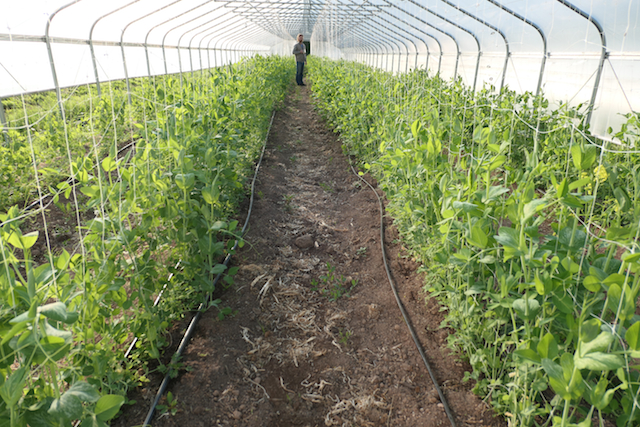
Sugar snap peas growing tall in the hoop tunnel.
What a spring this has been! We had snow and mid-80 temperatures just last week, an apparent switching of places by March and April, and, oh yeah!, a global pandemic. But fear not, this is our 12th season and pandemic or no, we got this. The first harvest is here! We are excited for salads and greens and hope you are too. The first shares of the season tend to be smaller and are typically greens heavy, giving us ample opportunity to get creative with salad dressing recipes. Given the severity of the cold this late in the year, please expect to see some frost damage on some of the kale and radish leaves. The lettuce and salad mix, however, appear to be the picture of perfection since they rode out the extreme late cold in the comfort of one of our tunnels.
All things considered, we are in good shape on the farm, albeit a little behind in the herb garden. The first carrot seeding has been fully weeded as of this afternoon. Sugar snap peas in the hoop tunnel and strawberries are both flowering. Heirloom tomatoes settled into their high tunnel home last week. Many frost sensitive crops which were itching to leave the greenhouse finally got their chance as we rounded zone 7's frost date of May 15th. Thus last week was a marathon of transplanting watermelon, tomatoes, peppers, cucumbers, zucchini, husk cherries, tomatillos, basil, beans, and u-pick flowers.
It finally feels like the growing season is upon us and we are eager to see our returning and new members come to the farm and collect their veggies! We've missed you, welcome and welcome back!

May 9, 2020
Soon
by Farmer Derek
Soon
by Farmer Derek
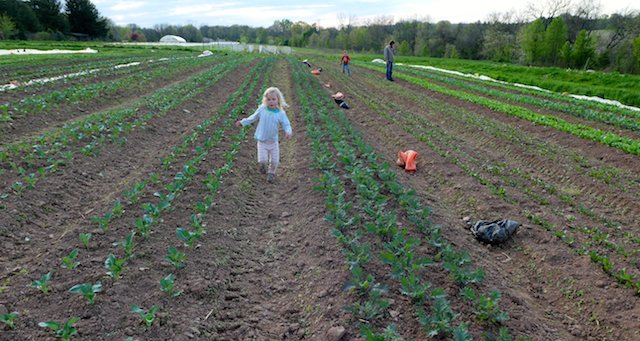
A field of spring treats freshly cultivated.
We're eager for CSA harvests to begin. We're hungry for fresh produce. We can't wait for the first spring salad. But Mother Nature tempers our yearning by reminding us that sometimes spring can take a while to fully arrive. Winter was mild, March was spring-like, April started well, then for the past month we've endured temperatures suspended 10-15 degrees below average with plenty of cloudy and rainy days. A month ago I would have forecast an early harvest; now it appears it'll 'hopefully' be a normal start date, but it could be a week later than that. It's hard to know for sure too far in advance. With days lengthening and the crops really itchin' to grow, once we get a stretch of warmer weather they'll probably grow exponentially. It's not a risk free assessment. If we start too late, some of the spring crops could decide to focus on reproduction before we even get through a full harvest week. Start too early and the crops are too small, perhaps not filling out all shares equally. But don't worry, most of the time we get these decisions correct, mostly by waiting until only a few days prior to the first pick up to announce the commencement of share distribution. That said, harvests will not begin this Monday, May 11th, but may begin next Monday, May 18th. We'll reassess after we get past this weird arctic blast vortex shenanigans. Ice, flurries in May; go figure.
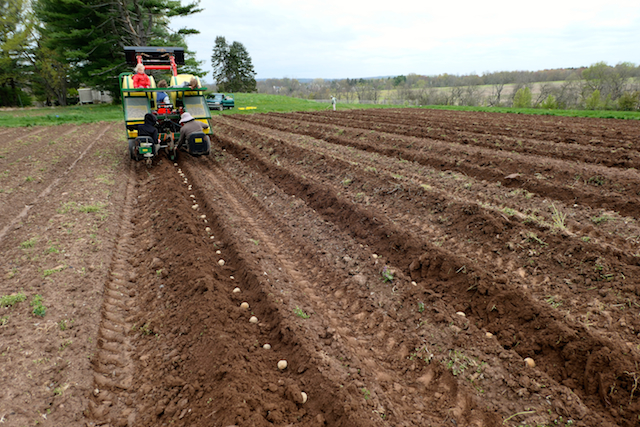
1500lbs of potatoes going in the ground!
Even though spring is having a difficult time establishing itself in our region, we're flying through our to-do list. Mostly soil and field conditions have been almost if not totally ideal, as long as we've been patient and wait for those conditions to present themselves. And they do. Warm temperatures in March sparked emergence of blossoms and blooms and initially warmed the soil, sparking dandelion flowers one or two weeks before we normally see them, which is when we try to plant our potatoes. However right after the blooms temperatures plummeted, moisture was omnipresent, and we had to wait to plant the potatoes instead of risking their deterioration in cool wet soil since they're planted around 4" deep. We wrapped up all spring crop planting with the 3rd and 4th installment, respectively, of beets and chard and are now on the cusp of planting a mountain of summer produce once we emerge on the other side of frost risk. Lined up to be planted this upcoming week (hopefully) are zucchini, cucumbers, watermelon, cherry/grape/slicing/heirloom tomatoes, sweet/hot peppers, snap beans, husk cherries, tomatillos, and flowers. Since we were unable to plant these crops last week we were able to spend more time getting ready for future crops by getting their future homes ready. Fields had to be mown, chisel plowed, primary shaped, final bed shaped. Some crops go into ground covered in fabric to suppress weeds and warm the soil so we did that where able to. It's a good feeling to be caught up and/or ahead with field work.
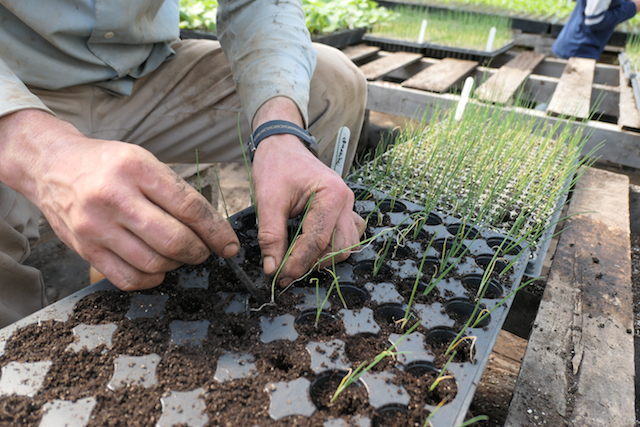
Potting up 6,000 leeks in the greenhouse.
It's interesting to acknowledge that the bulk of seeding, planting, and prepping work is done prior to the harvest portion of the season, which perhaps it intuitive, even though while utilizing season extension techniques harvests stretch 32 weeks for us. Once harvests commence approximately two full days each week will be devoted to harvesting and distributing crops. So maybe one silver lining to a later start date is more time to devote to all the other necessary farm tasks. When harvests commence our pace kicks up a notch and hours worked each week increase maybe 25%. That said, we love harvesting and sharing the produce with you. It is very satisfying to harvest, distribute, eat food whose seeds were sown months ago and carefully nurtured since. We're grateful for to our food community for sharing in this endeavor.
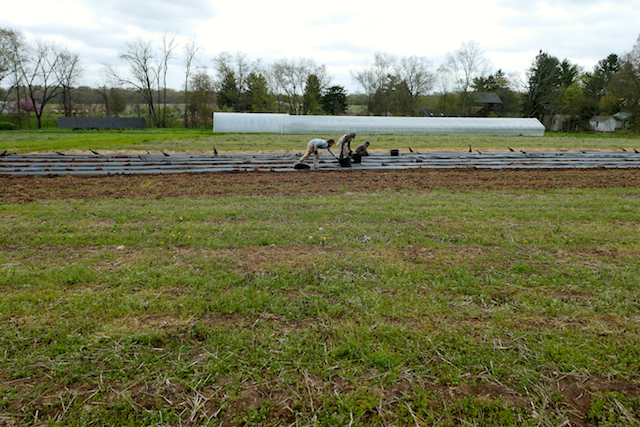
Applying landscape fabric to suppress weeds in the future zucchini and cucumber patch.

April 15, 2020
Into the Fields We Grow!
by Farmer Derek
Into the Fields We Grow!
by Farmer Derek
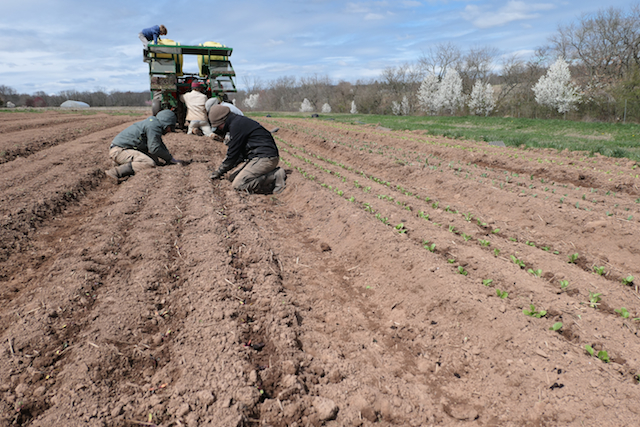
Transplanting beets into a raised bed on a chilly windy day.
The planting of outdoor crops has begun! Even though it's been slightly wetter than ideal during the past two weeks there have been just enough dry weather windows to finalize raised-beds and transplant seedlings into them. Two Fridays ago was our first big day of transplanting. Into 4000 feet of pretty nice soil went about 16,000 hakurei turnips, kohlrabi, beets, chard, broccoli, broccolini, bok choy, cabbage, and peas, planted over the course of 8 solid hours. The day prior, into our movable high tunnel, went the first week of 25 successions of lettuce family crops including head lettuce, romaine, endive, escarole, and radicchio. The outdoor crops went into areas that housed winter squash or eggplant last season, which were followed by a cover crop mix of buckwheat and oats. As these cover crops break down in the soil by microbial action they release essential nutrients that were taken up while the cover crop that was growing last fall, thus providing food for the crops.
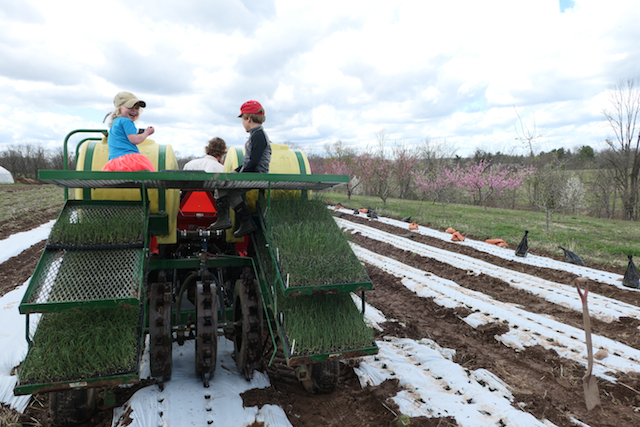
Driving the transplanter down the future onion beds to puncture the plastic and deposit water into the divots.
Two full days were spent transplanting last week. On Tuesday we transplanted salad radishes, bok choy, arugula, greens mix, kale, parsley, cilantro, radicchio, head lettuce, romaine, fennel, endive, and escarole. The following day we accomplished the immense planting of 25,000 onion seedlings, shown above. It feels like all crops are tricky to grow certified organically but onions feel especially so. They're very slow growing, don't compete against weeds well, and have serious pest and disease pressures. We plant them into raised beds covered in white plastic to deter certain pests, keep the beds cooler, and suppress weeds. Hoops are erected every 6-8 feet down each bed and 30' wide sheets of row cover go over these, anchored by many, many sandbags. Throw in the multiple high wind events we've endured recently and it makes for an anxious time. We've learned from past mistakes when we didn't anchor the sheet well enough and had large kites of cover billowing around the fields. Now, we use enough sand bags to successfully hold it in place even during extreme wind (we hope).
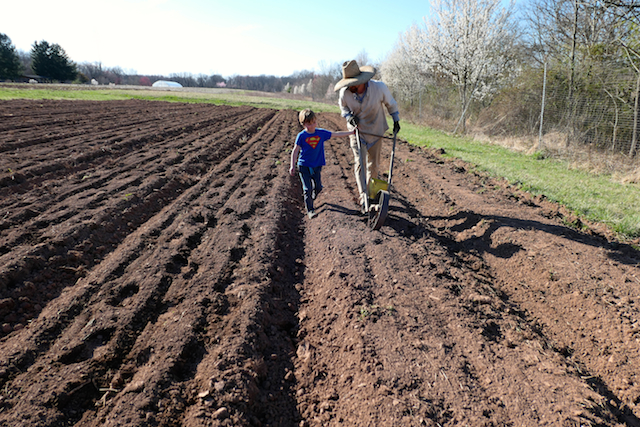
Pushing the antique drill seeder, sowing carrots.
A few weeks ago, before the weather turned wetter in any regard, we enjoyed what was probably the nicest conditions for early spring outdoor carrot sowing we've ever had. A literal mile of row feet of carrots was sown. Carrots can take a few weeks to germinate in the spring and require consistent moisture so we cover them with floating row cover to warm up the soil and trap moisture.
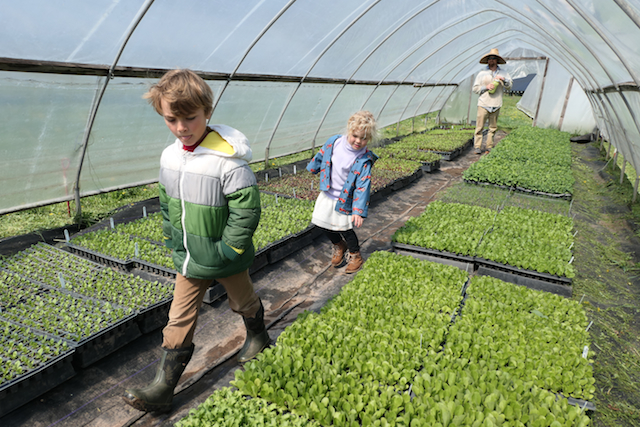
A plethora of plants in the Hoop House waiting to be transplanted.
All in all, we planted about 1.5 acres of crops over the past few weeks, which is about 12% of our annual 12 acres of production. Throw in the acre of potatoes we'll be planting whenever the soil dries out enough and that's 20% of our total yearly footprint, planted during the first month of the growing season. It's a very busy time of planting and prepping soil to accommodate and accept those plants. Dry weather is ideal. Wet weather is not. On our upcoming agenda will be potting up summer crops such as peppers, tomatoes, tomatillos, husk cherries, flowers, and celery; seeding; transplanting peas, beets, chard, arugula, greens mix, potatoes, and lettuces; cultivating; and weeding. The frost-safe date is quickly approaching and very soon we'll be planting summer crops like watermelon, zucchini, cucumbers, tomatoes (heirloom, slicers, cherry, grape), peppers (hot and sweet), flowers (20+ varieties), and basil.
It's an exciting time on the farm. We will be monitoring the fields as the crops grow over the next few week assessing a potential harvest start date and will be in touch!

March 23, 2020
This Moment
by Farmer Derek
This Moment
by Farmer Derek
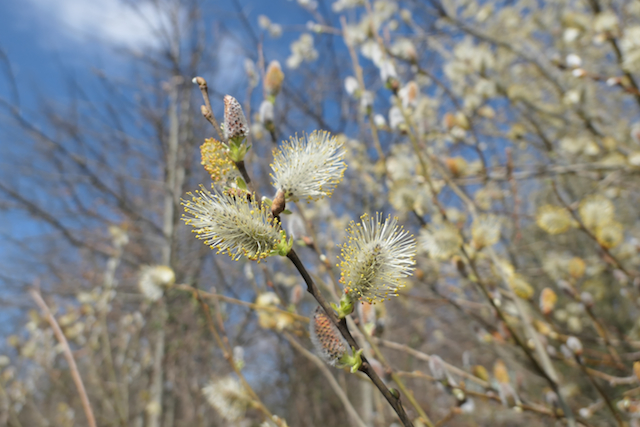
A harbinger of spring, the furry catkins of the Pussy Willow. There are only a few of these plants found on the farm.
Dear CSA Members,
We hope this note finds you well during this challenging and most interesting time. We're sending you some pictures of the farm to brighten your day and some updates to keep you informed as well as maybe provide something to read about other than that which I don't feel like naming. Spring has brought renewed life to the farm and with it some love and hope. If nothing else, wandering amidst the woods and agricultural fields teeming with other species rejoicing in this time of year, one can find solace, distraction. On the farm, besides having the kids permanently at home with us, not much else is different than it otherwise would be during this time of year, and thus we feel fortunate to work towards the annual robust goal of growing healthy nutritious organic produce for our CSA members. Perhaps we are spending more time than usual outside, trying to really maximize the comfort that a sunny spring day can bring. Swelling buds, blossoming flowers, singing frogs, slithering snakes, we're reminded we're not alone and that we're all part of this ecosystem on the farm. Caring for this land by interacting with other species is part of a bigger picture. Maybe this societal downtime will enable a reflexive reflective renewed connection to our total community.
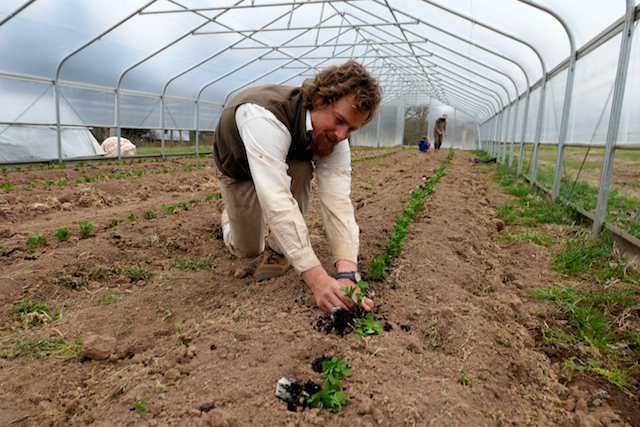
Transplanting authentic sugar snap peas into the Hoop Tunnel last week for what we hope is an early u-pick crop.
But that is bigger than me. I still need to focus on the daily tasks needed to grow high quality produce. We're also about to enter the month of April, and with that will commence the growing of plants outdoors. If the weather allows, next week we will transplant into raised beds beets, chard, kale, broccoli, cabbage, kohlrabi, lettuce, endive, escarole, radicchio, peas, turnips, and romaine. In the meantime we take care of those plants from seed to five-week old seedlings. Some need to be thinned, like the beets pictured below, because each seed is actually a dried fruit with up to five seeds and to reduce competition amongst themselves we try to give one of them more space to grow. Every tray of seedlings is removed from the comforts of the heated greenhouse and taken to the unheated hoop house where they'll 'harden off' by experiencing life with slightly more exposure, conditions more like what they might deal with in the field. We still adjust ventilation in there by raising and lowering the roll-up sides, and on nights threatening freezing temperatures we add an interior layer of row cover to make sure they're not damaged and because we don't want the pace of growth to slow down too much.
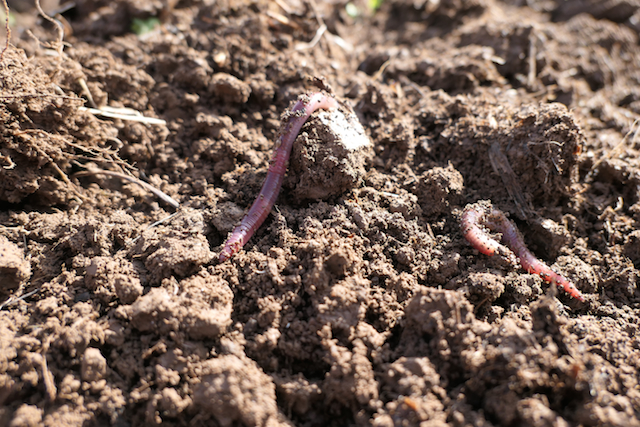
When chisel plowing a couple of weeks ago we were particularly impressed by the number of healthy fat worms found in the organic-matter-rich, friable, beautiful soil.

December 30, 2019
Thank You, Members!
by Farmer Derek
Thank You, Members!
by Farmer Derek
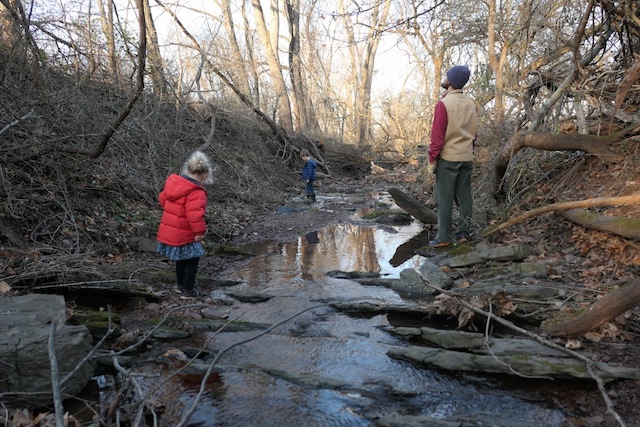
Exploring Anchor Run Farm's nooks and crannies.
Welcome to the final week of the 2019 Late Fall CSA! This week we'll get to enjoy an abundance of lettuce mix and spinach, as well as all those other veggie staples we've been sharing for most of this season. We hope you are currently immersed in a pleasurable holiday experience and are excited to flip the calendar this week. Calendar year 2020 will hopefully be a good revolution around our star, the sun. Let's plan for continued friendships and community development, a further connection to our home planet and local environment and neighborhood, acknowledgement of and constructive discussions regarding current and upcoming issues, and a movement towards an enlightened future. Small steps in the right direction is what I perceive.
On the farm we're well underway towards planning for a great 2020 growing season. Most of our wintertime work is spent organizing and planning for crop success and hopefully member satisfaction. Every season brings a few updates and changes based on the experiences of past seasons. Some varieties of crops get nixed, new varieties get trialed, some crops we give up on completely, new longterm crops are established, new methods of growing are tried. We hope for a season with reasonable weather and no extreme events, though we continue to take steps planning for and dealing with the outliers.
Happy New Year, Happy Increasing Daylight, Happy Respite, Happy Vacation, Happy Holidays!
Thank you Members, we love you!

December 23, 2019
Merry/Happy Everything!
by Farmer Derek
Merry/Happy Everything!
by Farmer Derek
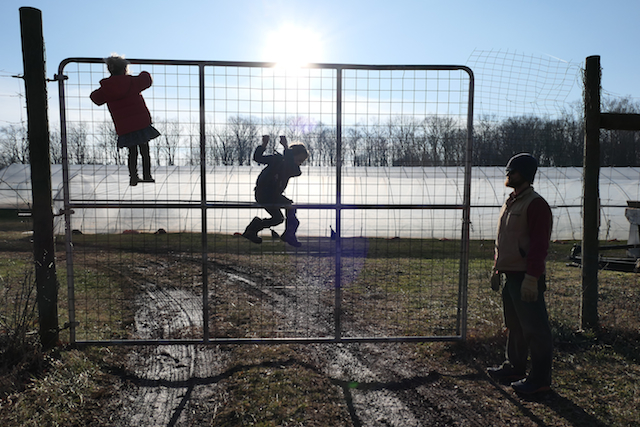
An on farm adventure must include climbing the gate to field 1.
This is the final week of pick up for Week A Half Shares. Next week will be the final week for Full, Medium, and Week B Half Shares. Thank you for joining us on this little Late Fall CSA ride! I think it's been a pretty good mini-season, and I hope you're satisfied with the bounty, flavors, freshness, and variety. Every year is a little bit different mostly due to the outside weather conditions during autumn, and this year was a pleasant dry contrast to last year's excessive moisture. By the time it turned wet again in late October we had already retrieved from the fields all of the sensitive crops. For the most part the tunnel crops can tolerate the extreme weather just fine.
One of our initial goals when offering the Late Fall CSA was to have a diverse array of crops to offer in the pick up room, especially fresh tender greens, and not solely rely on the hardy outdoor kales and storage root crops. I find cabbages to be a great middle ground, and love eating them all winter, but they fall victim to continually saturated soils and succumbed in 2018. It was great to have a cabbage/napa cabbage choice for the 8 weeks. Now that we have 4 tunnels to use for extended harvests of greens, and because we're not running a legit January/February winter CSA, we wanted to carefully distribute everything from the tunnels by the end of the Late Fall season. It seems that the 2.5 pounds of greens per week has just about kept up with production. We're now using about two times more indoor growing space then our first few years which gives us the ability to have these fresh greens through the entire season. Fall carrots were also something we didn't do in the beginning, mostly because we were just getting our feet under us during the first few years at Anchor Run and carrots are a difficult crop to grow in our soils. Timing of seeding for fall harvest is crucial because germination and early growth is much slower than their competitor, the weeds. Sow too early and weed and heat pressure is too great, so too late and they won't mature in time. We have since found the right time to sow and as long as moisture isn't too excessive a good crop is now reliable. I think this was the best harvest of fall carrots.
Overall I'm very pleased with how this Late Fall season has shaped up and I hope you've enjoyed the food. Please let us know if you have any ideas for future years.

December 16, 2019
2020 Vision
by Farmer Derek
2020 Vision
by Farmer Derek
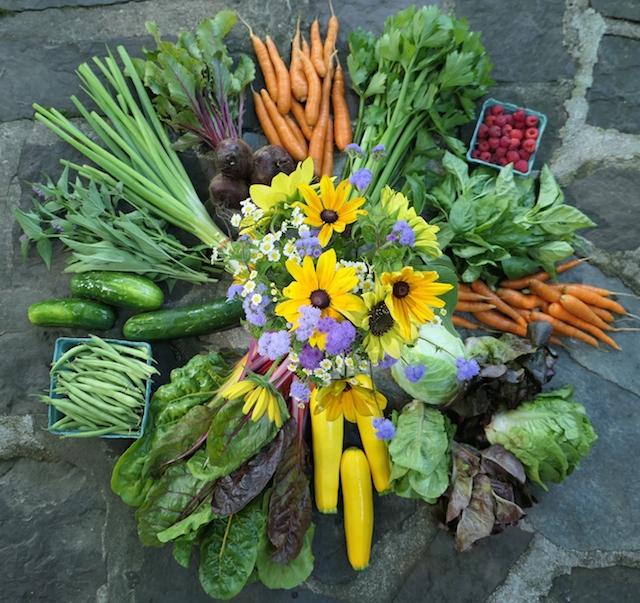
Visions of future shares dancing in my head.
Seeds and plants have now all been ordered for the 2020 growing season. I seem to forget and/or underestimate the amount of time it takes me to assess, reflect, analyze, and decide what varieties of what crops in what quantities to grow. Because we're such a diverse farm and grow 100s of varieties of crops over a 10-month growing season on 25 acres with several different soil types there are many factors, variables, elements, and conditions to consider and goals and ideals to entertain. Every line item in our crop plan deserves attention. This is pretty much the best and only time of year to fully adjust or modify then codify plans for next season. Once the tractor gets rolling and seeds get sown there's not enough time to plan, though occasionally adjustments do get made depending on weather and other variables. Since we've now farmed here for 11 seasons there's a pretty firm farming foundation but we hope there's always room for improvement and a tweak to enable greater crop growing success. I occasionally envision that by the time we're ready to retire perfection may be established and no further modifications will be needed but that's probably not realistic. Plus it's fun to revisit and redesign some of the systems we have for growing. There's also a lot of other qualified small scale growers out there also trialing systems and finding their own successes and some of those are worth incorporating here. Not to mention new pest and disease pressures and ongoing challenges from adverse weather and climate change. As farmers we enjoy a close relationship to nature and the cause/effect domino that exists in the world, leaving us hopefully feeling slightly more positive that adequate planning and implementation can result in increased tenacity, tolerance, and resilience. A legit cold winter offseason provides us with a clean slate each spring.
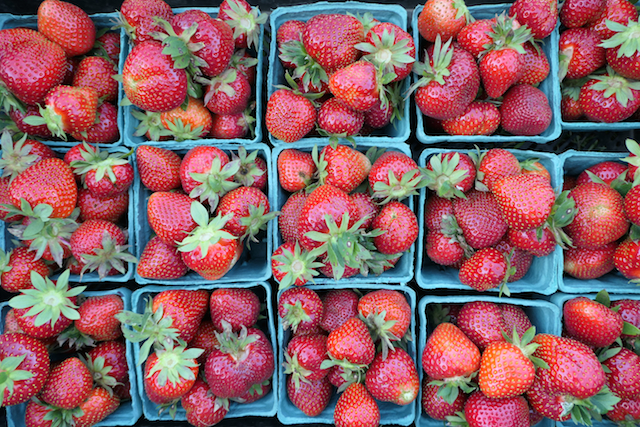
Seems like a nice time to remember the flavor of a fresh ripe strawberry.

December 9, 2019
At the Middle
by Farmer Derek
At the Middle
by Farmer Derek
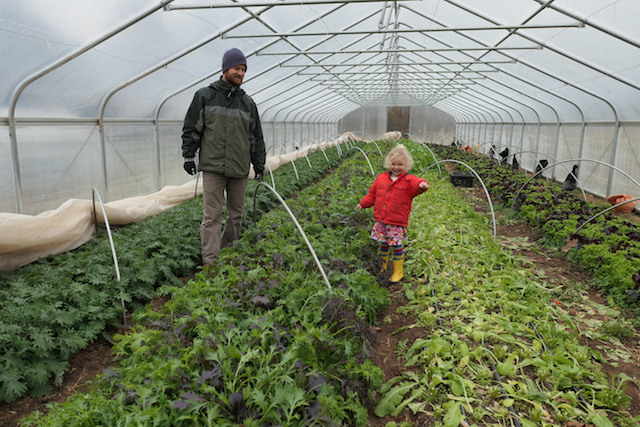
Snacking on some freshly uncovered greens in the hoop tunnel.
Welcome to Late Fall's midpoint. There are four more weeks of pick up. We're closely monitoring fresh and storage crops to ensure perfect eating conditions while trying to create a well-rounded farm share and attempt to deplete our fields, tunnels, and coolers in order of cold tolerance and storability. Since we're not planting anymore and fresh crops aren't really growing much during this persephone period (less than 10hrs/day of daylight) and all storage crops are in from the fields, we have a finite amount of produce to harvest and distribute. Thus, care must be taken to ensure adequate and reasonable amounts of delectable food are provided to you each week. It's mostly simple arithmetic but there are variables to control to keep crops in peak condition, and then there are also unforeseen occasional crop losses, too. For example, maybe something didn't store as well as we would have hoped, or too much tunnel moisture contributed to plant disease, or a polar vortex dropped temperatures down to -10 unexpectedly. So, we have to leave some margin for error and play it somewhat safe. That said, harvests should remain fairly reliable and consistent through the end of this growing season, albeit a few changes during these final weeks as some crops are depleted and others are cut. For example, we're now harvesting entirely from under cover as curly field grown kale has exited and makes room for delicious 'baby' red russian kale straight from the hoop tunnel. Rutabaga takes the place of onions in the share since we lost more onions than we planned for due to excessive moisture during storage. I guess farming is a game of give-and-take.

December 2, 2019
Let's Eat a Salad
by Farmer Derek
Let's Eat a Salad
by Farmer Derek
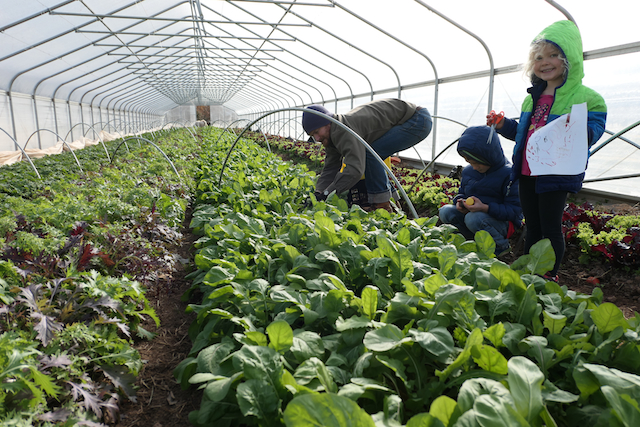
Cutting arugula in the hoop tunnel.
I hope you had an enjoyable holiday and are as excited as I am to eat a green salad as a meal for every meal for the next week. Eating fresh lettuce last night while the outside world was bleak and dreary was heartwarming and reminded me once again to appreciate the wonders of clean healthy food in all its relative simplicity. I love lettuce most of the year, but its scarcity, as well as its flavor, during the winter months really makes me cherish it when it is around and even abundant, especially after heavy holiday meals.
Thanks to three unheated tunnels and one minimally heated tunnel we'll all be able to enjoy fresh greens through the winter (arugula, baby kale, spinach, greens mix, lettuce mix). The contrast of inside and outside the tunnels this time of year is significant, even though they're only separated by a 4mm thick film of transparent plastic. It is plastic, but at least its use is going towards growing organic produce and has an eight-year life, before it's used for something else around the farm, before it unfortunately ends up composted in the bowels of the earth over millennia, or the sun burns it up during its swelling preceding white dwarf phase many years from now.
And now it is winter, depending on which seasonal schedule you follow. It's snowing, which I currently prefer to rain. It also means we can now tally our total rainfall for the March-November growing season: 42.8 inches of rain fell on the farm during that time frame, our 3rd wettest season in 11 years, 5.5 inches above the average. Overall, I think, it was a pretty good season to grow vegetables outside. We endured wet periods but also enjoyed some dry ones (enjoyed once the irrigation infrastructure was in place). My bones tell me next season will be a mix of wet and dry again with a couple extravagant cloud bursts of precipitation. For now, let's immerse ourselves in the pleasures of wintertime!

November 25, 2019
Think Thanks
by Farmer Derek
Think Thanks
by Farmer Derek
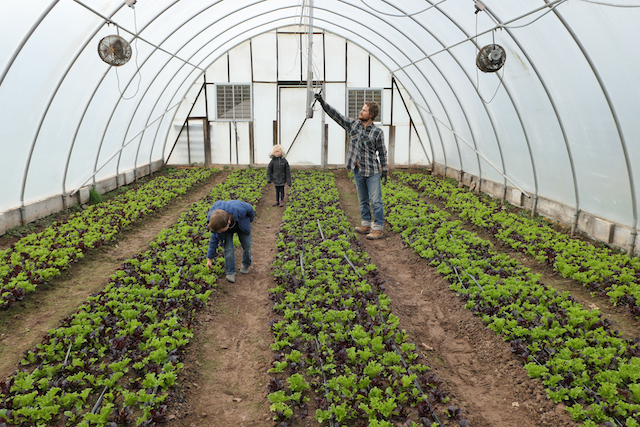
Setting the heat and ventilation thermostats in the greenhouse amid a sea of late season lettuce mix.
It's the end of November. It's the week of Thanksgiving. It's time for me to turn 37. My knees ache as I transition from the busy outdoor season to a winter exercise routine to balance out my time spent indoors meticulously reviewing this growing season while preparing for the next one. Neglected house and infrastructure repairs beckon. Both tractors require major reconstructive surgery (not covered by insurance). But the sun shines. The farm rests. Harvests are bountiful. It has been a good growing season. I feel ambitious as I begin to chart a course for next year. Seven thousand strawberry plants are ordered. We focus and place hope in a variety to actually extend the harvest. An additional 500 raspberry plants are purchased. Perhaps a new home and location for brambles will be found that is less prone to saturation. Hundreds of thousands of vegetable seeds are being ordered which will turn into 100,000 pounds of produce in 2020. Orders are being placed for organic amendments to help facilitate those seeds turning into edibles. Soil samples are collected for analysis. The crop rotation map will receive its annual update. We feel auspicious as we move from one season to the next. We're thankful for everything. Happy Thanksgiving.

November 18, 2019
Cold Season Challenges
by Farmer Derek
Cold Season Challenges
by Farmer Derek
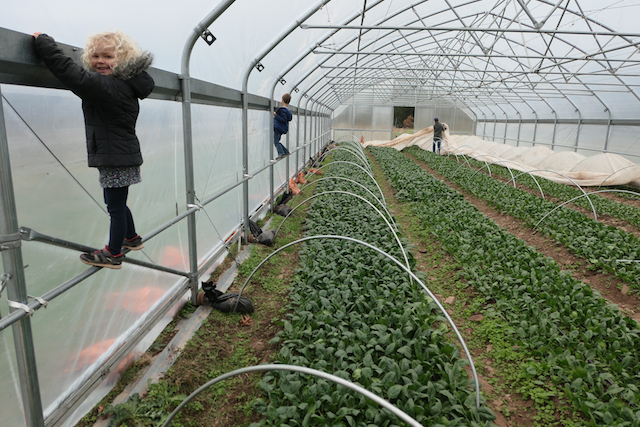
Most of our interaction with crops these days takes place in our four tunnels. Frequent covering and uncovering and ventilation adjustment is common with fluctuating outdoor temperatures. Unfortunately when crops stay covered for a little while we're unable to properly monitor their growth and harvest potential so sometimes there's a bit of an unpredictable nature to harvest forecasting this time of year. Though we know for sure we'll be harvesting a decent bundle of greens to distribute each week, we're never 100% sure what variety and how much will be cut until all covers are off. Seen above are three successions of spinach in our movable high tunnel. Do to a slower growth rate and greater tolerance to cold, we'll probably wait to harvest spinach until the latter half of the Late Fall season.
It was an enjoyable challenge to begin this Late Fall adventure with some serious sub-freezing temperatures during the middle of last week. It seems we're now able to avoid much of the excitement and apprehension that we used to feel during these events when we first started pushing harvests into the colder season; we now know more of what to expect, how to plan, what to do, and how to properly ride out a freeze. Cold-hardy, cold-tolerant crops are amazingly resilient and if we give them just enough protection they can basically be grown all winter in unheated tunnels. Pretty remarkable I'd say. Not that they do so without meticulous care and plant-sitting, but even when it dips to zero outside, with a layer or two of fabric thrown over interior hoops, trapping earth's and the daytime sun's heat closer to the crops, that insulating layer is enough to pull crops through and keep temperatures above the damage threshold. During serious prolonged cold spells when temperatures might not rise out of the twenties during the day and drop to singles at night, crops may seriously freeze and take a few days to recover, but it's fairly amazing when they do recover. I've seen them frozen solid, wilting and bent to the ground, only to be perky and sun-thirsty a week later. There is a bit of initial infrastructure investment that goes into protecting them initially (the high tunnels) but once they're up, they can be used for many many years as well as during all the other growing seasons.
Besides managing the temperatures in the tunnels with layers and ventilation, we also have to monitor soil moisture and humidity levels. There's not much evaporation and transpiration this time of year so as of now I'm only irrigating about once every two weeks, down from every week just a month ago. With the off-and-on again cold I have to drain all the pipes when temperatures dip into the mid-twenties at night. At this time it looks like we're expecting warmer (average?) temperatures for the next 10 days, so now when I refill the pipes I at least won't have to drain the whole system right away.
While we know pretty well how to protect crops during cold, we're still working out how best to keep humans happy in an unheated barn. So far I'm a fan of (very) temporary relatively quick solutions using old tunnel covers and space heaters (function over form?). Though not exactly aesthetically pleasing it at least does the job of keeping the pick up room a balmy upper 30s or low 40s when outside temperatures sit below the freezing mark. In a perfect world we would install a wood stove and may do so eventually if we end up battling serious cold more frequently during the Late Fall season.

November 11, 2019
Late Fall is Underway!
by Farmer Derek
Late Fall is Underway!
by Farmer Derek
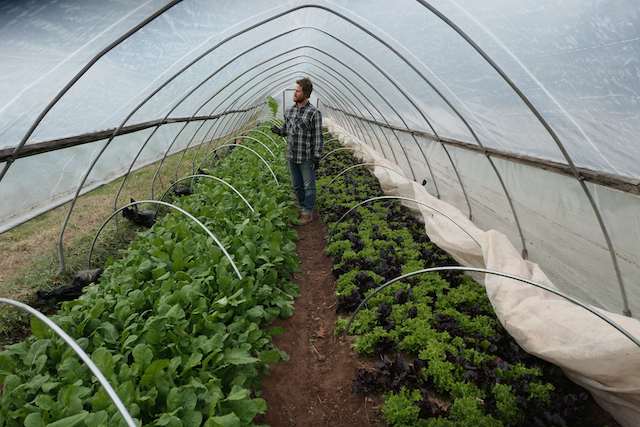
Marveled at the leaf size of the tender arugula growing in the Hoop House.
Welcome to the 8th annual Late Fall CSA! We're excited to embark on this new season and share the farm's produce with you. Overall Mother Nature treated us much better this year than last so we're looking forward to a good and varied bounty during the next couple of months. Outside grown crops yielded just about perfectly this late summer and fall. Inside our various tunnels where we'll be harvesting salad and tender greens through the New Year we're pleased to report the rather predictable success and health of those crops (thanks to variable control). Barring too many successive days/nights below freezing we should have some wonderful cooking greens throughout the Late Fall as well, including kale, collards, cabbage, and napa cabbage. A plethora of roots and tubers will round out shares giving you ample opportunity for some wonderful soups and roasts. Thank you for joining us!

November 3, 2019
Main Season Completion
by Farmer Derek
Main Season Completion
by Farmer Derek

Beautiful falls at Ringing Rocks County Park.
The final week of the 2019 Main Season CSA is upon us! Thank you for joining us on this half-year-long adventure. Twenty-six weeks is a lengthy commitment and we appreciate you partaking in this long ride. Every growing season seems to contain its own unique trials and tribulations, successes and failures, highs and lows, etc. I'm not yet sure yet 2019 will be characterized by. Whereas 2018 is remembered as the wettest season on record, 2019 wasn't quite so extreme. We did endure some wet times and some dry times, but overall this season feels like a good one. Most crops performed well. There were some major disappointments (peas) but many successes. Through it all we hope you enjoyed the produce we provided to you. We hope that by being part of Community Supported Agriculture you find a deeper connection to the food you eat and therefore a deeper connection to a community, an ecology, and a kitchen. We might not be farmers if it wasn't for CSA; good community vibes were a big contributor to our desire to take this path 13 years ago. Pure healthy food and a clean environment pulled us fully in this direction and we are glad we embarked on this trajectory. We look forward to sharing this future with you.
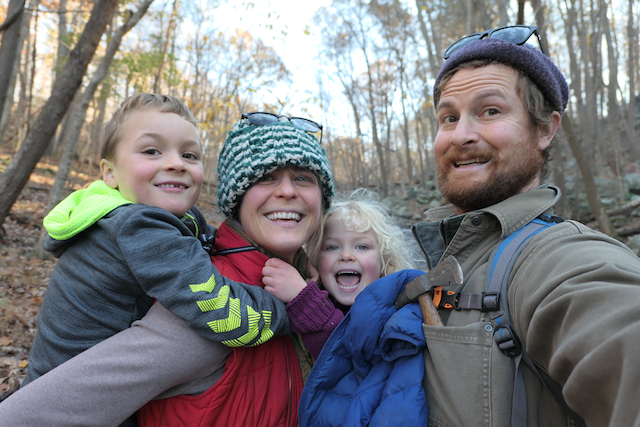
So long, farewell, happy winter, and see you in the spring (if not before)!

October 27, 2019
And In The End, Eat Well, Be Thankful
by Farmer Derek
And In The End, Eat Well, Be Thankful
by Farmer Derek
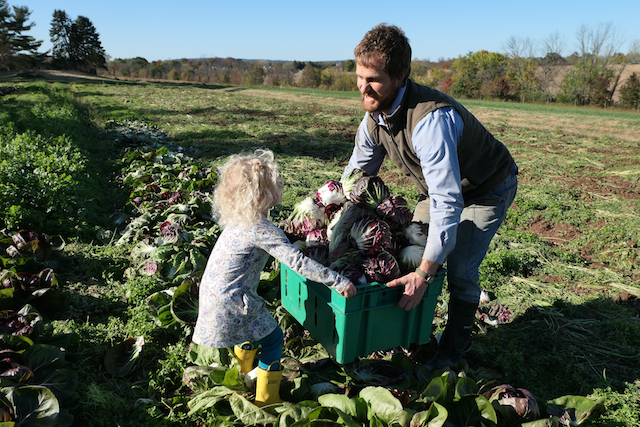
With a little help from the little one, bountiful radicchio is inbound.
We're down to the final two weeks of the 2019 Main Season. This will be the last week of pick up for Week A Half Shares. To all members, we hope you've enjoyed the farm share this long 1/2-year of what will be twenty-six weeks of continual harvesting and eating. It's a commitment on your part, and we truly do appreciate your support of us and this farm. This 100-acre open space preserve is made whole and wholesome by the coming together of our community for a healthy and hopefully sustainable reason. We give thanks to be able to live and work here and strive to give back to the soil, the ecosystem, the earth, and you. We do our best to grow and provide to you produce that is truly worth your time to pick up, process, and consume. We hope that when you come to the farm you can breathe a little deeper, unwind a bit, and find temporary departure from some of the stresses and pressures of the world outside of this little Bucks County oasis. With your help Anchor Run CSA is successfully concluding its 16th season of harvests. Thank you one and all.

October 20, 2019
Almost Assessment & Reflection Time
by Farmer Derek
Almost Assessment & Reflection Time
by Farmer Derek
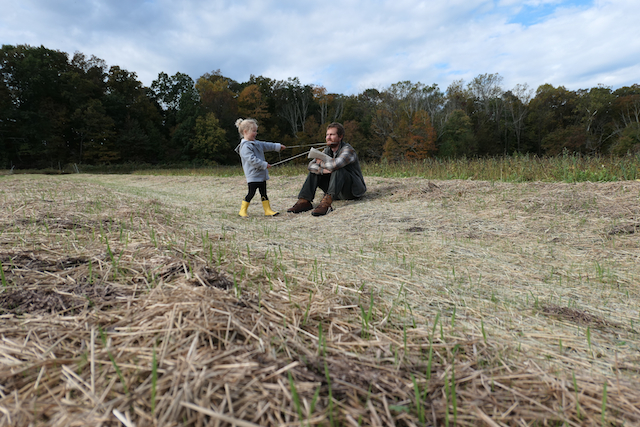
Fast germinating wheat poking through the mat of straw in new Field 1 waterway.
Time moves quickly during the Main Season, perhaps due to the fact that there's hardly a minute to pause, reflect, and consider the passage of time. I do make an effort to take a second and make a note whenever something occurs with crop production that is worth having record of in the future. While my memory is probably okay, if I don't write it down (more accurately type it digitally) there's a chance we could make the same mistakes all over again. Farming, like many tasks and jobs and life, is a series of trials, experiments, experiences that one learns from and builds upon. Because some crops might only be grown once per year and because we have to wait a full year until we go about it all over again, it is helpful to have a good record of production. A lot of our 'off season' is spent reflecting, scrutinizing production and yield, finding ways to improve, deciding what may be superfluous, trying to identify what keeps members' tummies happy. Thus, we're about to depart the time of the season of serious hustle and bustle as we embark on the season of reflection and planning. That said, please let us know if you have any specific helpful tidbits of information to improve your/our CSA!
Last week we endured/enjoyed the first real rain event in a few months. It was definitely good to receive an ample soaker before temperatures and day length drop. It's worth noting that even though it rained outside and the ground is now saturated, we need to manually add water to our indoor tunnel environments where we exert control of most variables. The penultimate round of 2019 transplants was deposited in the soil last week and with each round the tunnel crops need at least two doses of watering with the wand followed by drip irrigation. When the plants are first transplanted their roots are confined to the surface of the soil; the goal here is to saturate the top of the soil profile to ward of transplant stress and encourage establishment of roots. After a few days they perk up and their roots begin to grow. We then water with drip tape about once per week, giving them a good drink, hoping their roots are now well established. Turning drip tape on is much quicker and easier than manually watering with a hose and wand which would take hours. Come December we probably won't have to water at all since evaporation will be minimal, roots should be well established, and soil moisture should be omnipresent.
The last few weeks of the Main Season are now upon us and we're feeling very thankful for what has been a pretty good year of farming. We're grateful for the support of our members and truly appreciate your support and trust. Since the light at the end of the Main Season tunnel can now be glimpsed with proper glasses we're confident the final few weeks will hold a bounty of good produce. Enjoy!

October 13, 2019
Winding Down, Up
by Farmer Derek
Winding Down, Up
by Farmer Derek
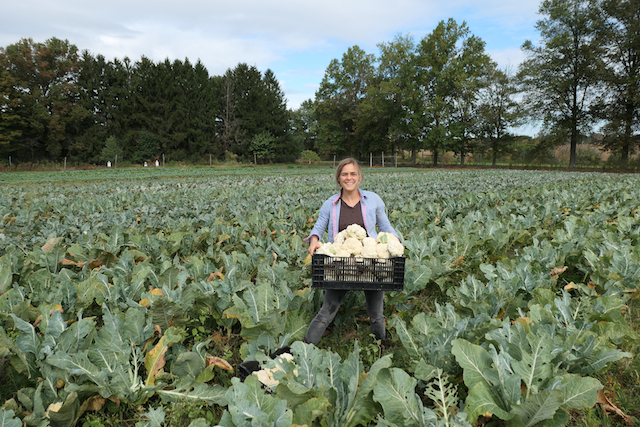
Farmer Dana holding a hefty bin of cauliflower.
Slowly our outdoor farming footprint contracts. Crops are being harvested; fields are being cleaned up, mowed, composted, cover cropped, put to bed for the winter. Because our crop rotation plan not only organizes crops spatially by family but also temporally we can temporarily remove entire finished fields from our to-do list as well as our consciousness (except for when we walk by an old cover crop mix of buckwheat and daikon and admire its beauty while snacking on buckwheat seeds). Our outdoor production is now basically confined to two fields adjacent to the driveway near the road, approximately 10% of our max summer footprint. After the frenetic pace of summer, peak sun, and total farm consciousness, this is a very welcome respite. We're also lucky that dry conditions allowed for a much easier time excavating and installing three more waterways (plus seeding, mulching, etc.) which were finished just in time for last week's almost-half-inch of light and perfect rain.
Much of our focus shifts indoors this time of year, to tunnel production as well as proper storage conditions for many long-term storage crops. We have three separate, insulated and temperature controlled rooms with differing humidity levels to satisfy varying storage needs for different crops. Last week we transplanted the second round of spinach in the high tunnel and the first round of arugula, kale, greens mix, and lettuce mix in the hoop tunnel. This coming week we'll plant the final rounds of those crops in those buildings. Next week we'll fill the greenhouse with the final planting of the year, lettuce mix. We may even endure our first legit frost later this week following what could be the first big rain event in quite a while.
Thank you for your support; hope to see you around the farm.

October 6, 2019
Ready for the Change
by Farmer Derek
Ready for the Change
by Farmer Derek
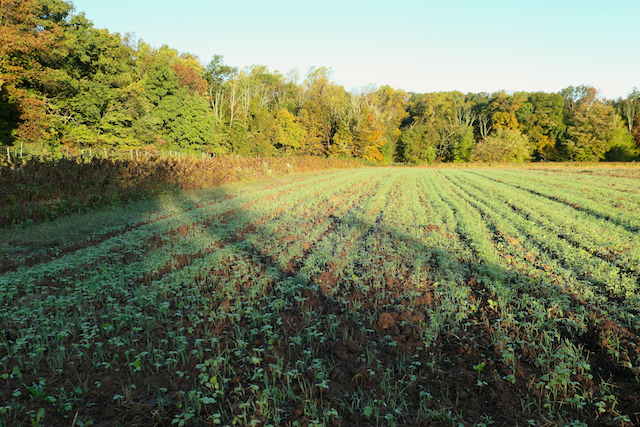
Fall in Field 1. Young cover crop mix of oats and buckwheat in foreground, prior home of husk cherries, tomatillos, and flowers.
Last week was a good and busy one, albeit one with too much midweek heat followed by lows 50 degrees colder. Laboring through summer's heat in October was a challenge, especially given the nature of the tasks that needed to be finished prior to the cool and moist weather. Record breaking everywhere in this region of the world, our previous latest in the calendar year 90 degree day was September 25th, back in '12 maybe. The heat, then the wind, definitely stressed out our young transplants that went in the ground on Tuesday, which needed to be hand watered 5-6 times over two days to get them settled into their new home. Soon I'll set up drip tape once they get some roots established then their management will be much easier. About 375' of beds were planted, 8-10 rows/bed. Another thousand bed feet will be planted in the next few weeks and will provide fresh greens throughout the Late Fall CSA.
Two out of three waterways have been finalized and seeded in Field 1, the last major component of a project that was first initiated in July 2016. In 2018 waterways were established in Fields 2 and 3 and had a huge impact this season when we were once again hit with flash flood rain events. The goal is to keep excess water from entering fields as well as collect and direct the water that falls on those fields to desired areas to prevent erosion and the loss of that precious resource, topsoil.
Ongoing around the farm is the continued collection of roots, storage crops, and the last of the summer fruits including beets, turnips, radishes, daikons, sweet peppers, and tomatoes. Tomato plants had to be removed from our Hoop Tunnel to make way for Late Fall greens. Green tomatoes and green peppers will be distributed for a couple of weeks. Eventually cold weather will nip some fresh crops and we'll dip into roots and storage crops a bit more.
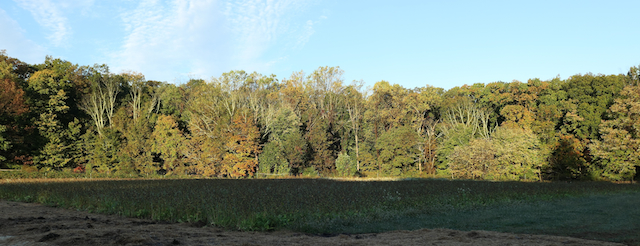

September 29, 2019
Growing with the Flow
by Farmer Derek
Growing with the Flow
by Farmer Derek
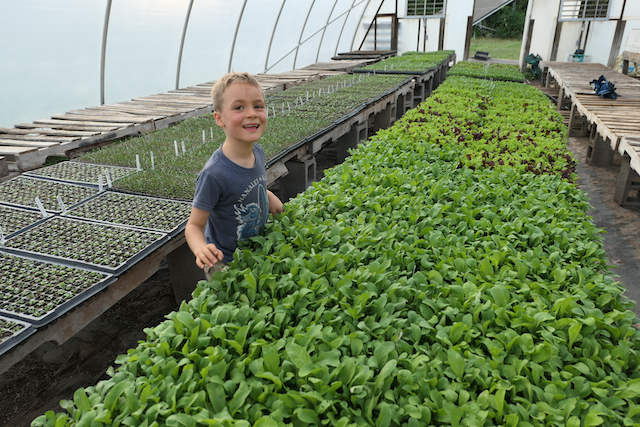
Late Fall transplants growing quickly in the greenhouse.
It's practically October but I'm pretty sure it doesn't seem or feel like it. Another potential 90 degree day is in store for us this coming week. Plenty of sunshine, warm temperatures, and added water are causing many of our late season crops to grow quicker than usual for this time of year. That's not a bad thing, as long as temperatures don't drop drastically and frost/freeze. Slow growth and slow acclimation to colder temperatures is essential for crops to best tolerate the cold of October and November. Eventually we'll switch to only harvesting tunnel grown greens, but that isn't until late November and December. Much of what we are growing outside now is tolerant of temperatures in the 20s, but a hard frost can burn the tips of lettuce leaves. Quicker unexpected growth also throws a kink in the crop plan if what we anticipate harvesting in week 24 is actually ready in week 22, but it typically all works out fine.
We're now also pretty used to the dry weather and don't even expect a rainfall anymore. We're irrigating on a regular basis, giving crops about a 3-hour drink every week or so through our drip/trickle irrigation system. That's probably more or less the equivalent of a half-inch of rain (based on the moisture content of the soil afterwards). I don't scientifically measure that; there could even be a formula to figure it out. I simply just observe the appearance of the crops and soil, notice the weather and temperature, amount of sunshine, the type of soil, type of crop, and the stage of growth. For example, the broccoli and cauliflower are heading up so they might be thirstier than, say, arugula, but because of the field they're in the irrigation might not need to run as long because the moisture sticks around longer due to the soil properties (more clay less sand; size of soil particles). Just add water and observe.
This coming week marks a smooth transition to the start of cold weather indoor growing. The first of four tunnel transplant successions goes in the ground and will be safe and protected in a controlled environment until a Late Fall harvest. Up this week is lettuce mix (1 of 4), arugula (1 of 3), and spinach (1 of 3). Eventually it will probably be colder.

September 22, 2019
Registration Open for 2019 Late Fall CSA
by Farmer Dana
Registration Open for 2019 Late Fall CSA
by Farmer Dana
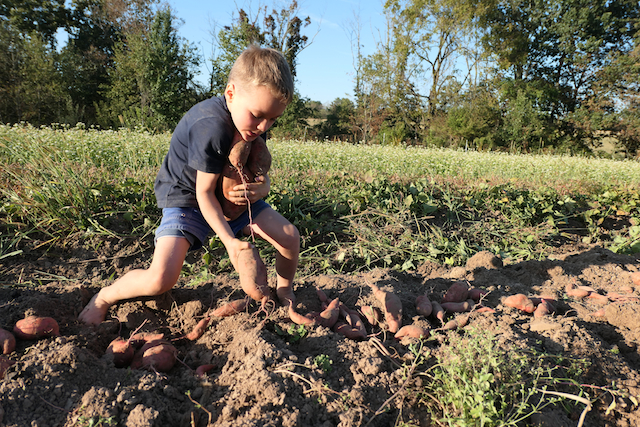
Sweet potatoes will be plentiful in shares during the final month of the Main Season as well as the Late Fall CSA.
Registration is now open for the 2019 Late Fall CSA!
2019 marks the 8th Late Fall CSA season!
- Offering a mix of fresh and storage crops like lettuce, spinach, radicchio, arugula, mizuna, bok choy, kale, collards, chard, cabbage, Napa cabbage, herbs, leeks, garlic, onions, beets, watermelon radishes, daikons, turnips, carrots, celeriac, kohlrabi, potatoes, rutabaga, and sweet potatoes. It's basically an extension of the Main Season share. We use season extension techniques and infrastructure such as the unheated high tunnel, hoop house, and hoop tunnel; the minimally heated greenhouse; low hoops; and row covers to provide fresh crops as well as storage crops.
- Eight week season begins the week of November 11th (immediately following the conclusion of the Main Season) and ends the week of December 30th.
- Full ($240), Medium ($175), and Half Shares ($130) available. Price/week remains the same as prior seasons. Half Shares will be assigned same A/B week as Main Season unless a different week is requested.
- Pick up day options include Wednesday 1-8pm and Saturday 11am-1pm (you choose a day but you can switch temporarily by notifying us in advance) however...
- (During the week of Thanksgiving, Late Fall Harvest Week #3, Wednesday's pick up will take place on Tuesday, November 26th to accommodate travelers and holiday schedules and...during the week of Christmas, Late Fall Harvest Week #7, Wednesday's pick up will take place on Thursday, December 26th.)
- No work requirement/discount.
- The total number of shares available is about half that of the Main Season, so sign up soon!

September 15, 2019
Perhaps the Best Time
by Farmer Derek
Perhaps the Best Time
by Farmer Derek

Start of a Sunday canoe trip down the Neshaminy Creek.
This time of year my well-being is directly related to the weather, state of the farm, health of the crops, and current list of jobs needing completion to keep this ship floating merrily along. Right now the weather is just about perfect (80/60, low humidity, clear skies), the farm is looking good and late summer and fall crops are mostly thriving (thanks to our good crew, members, weather, soil creatures), and the list of jobs gets slightly smaller each week as our planet's revolution around the sun slowly moves us back to winter.
We've been making great effort in cleaning up crop spaces as soon as their productive period is complete with mowing and any infrastructure removal followed by a generous compost application and the sowing of a cover crop. There aren't too many more areas that will receive a fall cover crop so pretty soon that will be another task taking a winter hiatus. I believe we're down to the field tomato and the u-pick crop patches (which cumulatively is a pretty big area). Hopefully starting this week will be the installation/excavation of water ways in that same field to better deal with heavy rain events. Earth will be moved and graded then seeded and mulched.
Our focus will soon turn to inside growing as we prepare our 4 tunnels for late Main Season and Late Fall harvests. Those areas will need manual spading, hoeing, and raking to make beds then we'll plant, irrigate, and watch the crops grow through the early winter.
We'll also begin retrieving additional roots, tubers, storage crops, and big haul items including sweet potatoes, watermelon radishes, daikons, celeriac, beets, kohlrabi, turnips, broccoli, cauliflower, cabbage, and napa/Chinese cabbage. Many of these tasks will be accomplished with the help of workshifts.

Perfect late summer weather for playing outside. Also seen playing outside: 6 turtles, 5 king fishers, 3 water snakes, some unknown species of fish, 2 blue herons, and many delightful insects.

September 8, 2019
To Beckon Rainfall, Irrigate
by Farmer Derek
To Beckon Rainfall, Irrigate
by Farmer Derek
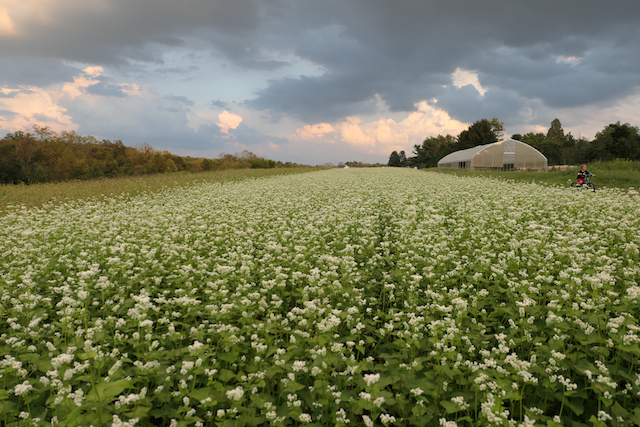
A major benefit to a lush stand of cover crop is its simple beauty. A decent sky always helps to enhance/enrich a photo.
The farm enjoyed its first legitimate rainfall in more than a month this past week. As predicted, and the reason I'm most reluctant to devote time and resources to its cause, immediately following the installation and use of the irrigation system, it rained. There's a good chance we'll resume a weather pattern that provides regular rainfall and the irrigation infrastructure will just provide mowing hazards. But if that is what it took for the weather deities to notice our need, I guess it was worth it. That is the past though and we must not dwell on it. There are new projects to devote one's time to.
In between Monday's big rain event and Friday's minor one we transplanted a few thousand little plants, perhaps the penultimate outdoor transplanting event for the season. We seeded the first of 4 indoor greens successions including spinach, arugula, and lettuce mix. The movable high tunnel by the parking lot is going through a bit of overhaul as we dismantle some ventilation systems and install new ones. It will also get a new sheet of plastic as the other one is pushing 8 years on a proclaimed 4-year life.
As crops leave the soil and those areas can now be put to sleep for the winter we've settled into a great habit of spreading compost before a cover crop so that most of the farm will receive a healthy dose at least once a year. This system fits well into our work schedule since we have more available time in late summer and fall to devote to adding compost and it also well avoids the 90 and 120 day rule for spreading compost/manure before a crop is harvested (we're spreading 180+ days before harvest). Continually adding organic matter through compost, cover crops, and crop residue makes a huge difference in the health and quality of our soils and helps plants through dry stretches. By now I would say that more than half the farm has received compost this calendar year and is now in a cover crop mix of buckwheat, oats, and daikon radish. By mid-October all of the available areas that aren't in late fall crops should composted and cover cropped.

September 1, 2019
Supplemental Water
by Farmer Derek
Supplemental Water
by Farmer Derek
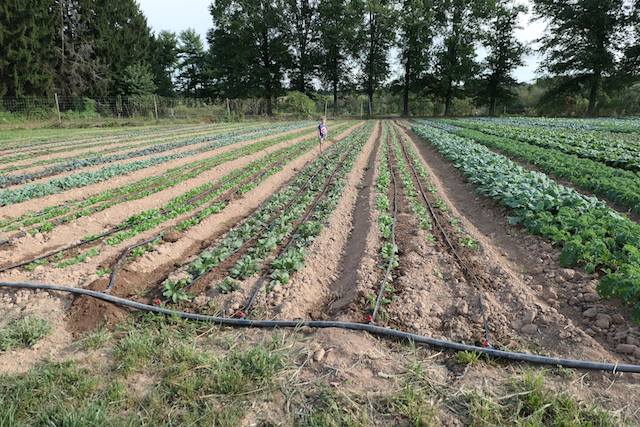
28,700 feet of drip tape was applied and/or hooked up to tubes that were connected to our 3000' of buried 3" mainline pipes over a 3 day period at the end of last week. All of the drip tape had been saved from prior years and was re-used.
Another round of precipitation came and went without depositing more than a few drops on the farm and as a result we had to resort to irrigation infrastructure investment inundation. Three days and 30 hours later 90% of thirsty crops that still have a harvest life left in them are under water management. Depending on what happens with tomorrow's forecast rain event the final 10% may receive a well water drink. As predicted, after we install the irrigation and run it once, we'll probably receive ample rainfall and we may not have to irrigate those crops again. Such is the nature of farming, and nature. With the completion of August yesterday we can now assess the rainfall total for the month and compare it to the past. With a total of 1.3" received (half of it in the first week of the month), it was our second driest August in 11 years. That follows 8" received in July. September can occasionally be dry so I'm hopeful I'll get to use the irrigation system again now that it is in place.
Besides irrigating, we also finished harvesting the 2019 potatoes. Five varieties and 1,500 pounds of seed yielded an approximate total of 7,500 pounds. Compared to other years, conditions were pretty perfect for harvesting the spuds due to the dry soil which allowed the potato digger to scoop and sift and convey as best it can. We also transplanted more lettuce, chicory, kale, and collards successions. Including this coming week we have 3 more weeks of outdoor transplanting then we switch our focus to tunnel growing for Late Fall CSA harvests. Anticipating a rain event this past Wednesday we also direct seeded another round of arugula and hakurei turnips as well as spread compost on finished crop areas and sowed a cover crop mix of oats, buckwheat, and daikon.

August 25, 2019
End of Summertime for Some
by Farmer Derek
End of Summertime for Some
by Farmer Derek
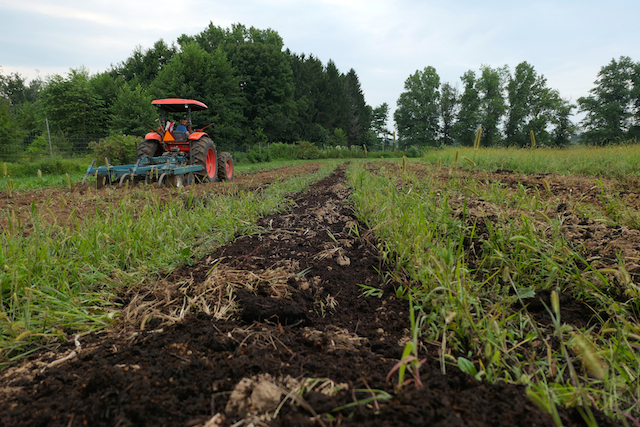
Chisel plowing after spreading compost on ground where early potatoes were grown in preparation for a cover crop.
It's the end of August. Summer ends for meteorologists and those going back to school. Summer on the farm is waning but won't end here until we decide it does, or the Fall Equinox rolls around, or tomatoes, peppers, and eggplant officially wrap up, whichever is first. We are moving away from summer staples and welcoming crops more associated with fall. A nice quality of eating seasonally is the continued change in meals as new produce ripens according to the local climate. Greens, potatoes, and winter squash and soon leeks, celeriac, sweet potatoes, broccoli, and cauliflower will grace our tables.
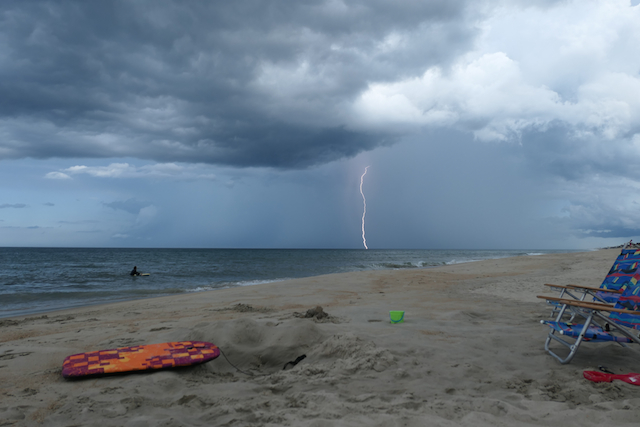
Lightning striking the ocean as a storm rolled off the coast south of us (at a safe distance).
Your CSA farmers took a break and skedaddled from the farm for a very long weekend at the North Carolina shore with extended family. It was our first legit break since perhaps February. I've been working 7 days a week since early May and needed something hopefully rejuvenating. Getting off the farm is a great way for me to spend quality time with the family. When we're at the farm I can't take a full mental and physical break during the main growing season due to the plethora of physical farm tasks to do and organize as well as maintaining membership administration. Abstaining from screen time during this outing also helped temporarily sever ties to work (I highly recommend disconnecting once in a while). But now we're back and are totally excited to finish out the season on a positive note, working our hardest to grow great organic produce for the next 11 weeks of the Main Season.
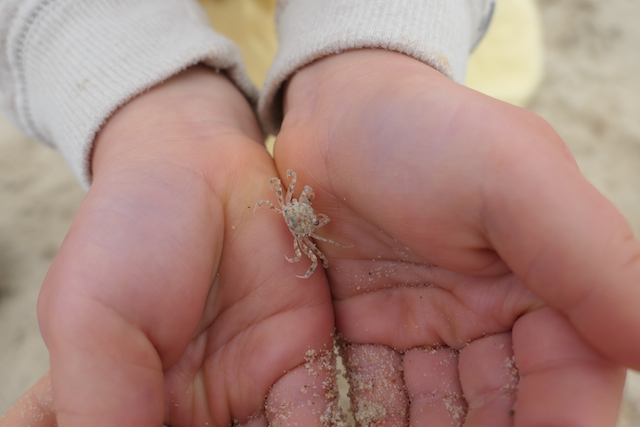
Atlantic Ghost Crab.

August 18, 2019
Where's The Wet Stuff?
by Farmer Derek
Where's The Wet Stuff?
by Farmer Derek
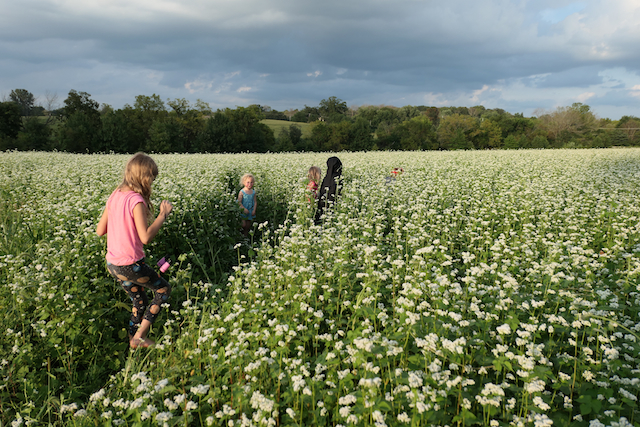
Buckwheat exploration.
An August of old is unfolding, a return of what feels and seems like a normal weather pattern for this time of year. Spotty showers, mostly missing us, more heat and plenty of humidity, perhaps a last gasp of peak summer. We continue to will ourselves away from resorting to irrigating, but once the crops appear to be thirsty and suffering slightly we'll probably give them a drink. If we do wind up irrigating this season, at least it's now when our total footprint is smaller than at peak, though there are probably more bare ground crops now and we would have to manually add drip tape to each bed rather than tractor applied drip tape when laying the plastic mulch that assists many of the summer species. Whereas most of this year and last a 20% chance of rain would result in a 100% inundation, now we're faced with the opposite. The rain does miss us, and we do miss it. Part of me wants to irrigate so I can at least forget about the weather momentarily and quit refreshing the forecast tab every 5 minutes when I'm near a computer, but on the other hand relying on Mother Nature imparts a perception of dependence on outside forces, which I guess is humbling and/or nurturing.
Either way, we march on. Last week we hauled in whatever winter squash was in good condition and hope to cure and store it temporarily in the greenhouse where it should heal and sweeten. We also continued to dig and retrieve potatoes. At this point we've harvested almost 50% of the crop and the yield looks better than our average, probably due to regular rainfall when the spuds were forming and bulking up, but hopefully also due to increased soil health and fertility.
Some summer crops have passed their peak and some are truly waning. Zucchini, cucumbers, eggplant, and basil have slowed down and may disappear in a week or two. Field and heirloom tomatoes peaked and then quickly dropped but very soon our hoop tunnel crop will be yielding aplenty. Tomatoes should be in shares for a while yet. Greens like chard and kale are about to return to the pick up room. Late summer kale is a treat and for some reason almost always looks and tastes great even though it grows during the heat of summer. As of now our fall brassicas look outstanding, growing in a field that left a 3-year fallow period before last season. As long as the weather doesn't return to a too-wet phase broccoli, cauliflower, cabbage, etc should be bountiful this fall.
The 2/10th of an inch of rain we did receive last week at least got some cover crops going as well as direct seeded arugula, hakurei turnips, watermelon radishes, and purple daikons. The fields where we sowed buckwheat and daikon a few weeks ago are in peak buckwheat bloom now. Pollinators and kids are thrilled.

August 11, 2019
Alignment
by Farmer Derek
Alignment
by Farmer Derek
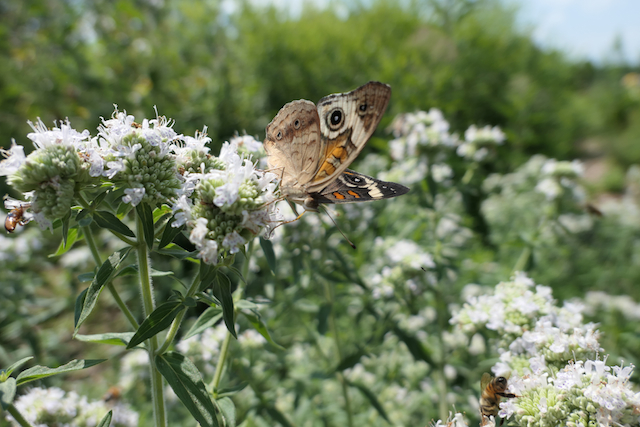
Common buckeye butterflies, honey bees, and other insects gathering nectar and pollen from the mountain mint patch in the herb garden.
We lucked out once again with some precipitation when the farm was ready and waiting, the sky providing almost an inch of light rain in a two-day period. Cover crop and carrot seeds needed another soaking to help stir that inner life force into waking and sprouting. Carrot seeds require a bit more TLC to get going compared to other crops we direct seed. Constant moisture supposedly helps them germinate but we're currently content with our dependency on rainfall which appears to be right on schedule this coming Tuesday. The carrots are just beginning to sprout and push through the soil to begin photosynthesizing the sun's rays into delectable carbohydrates while they pull in that satisfying carbon dioxide from the earth's atmosphere and in turn give us a bit more oxygen to breathe. In a couple of weeks we'll cull their competitors with stirrup hoes and hopefully it will be a successful fall carrot patch.
Speaking of success, the stars aligned this year and for whatever reason(s) we've produced more cantaloupe than we ever have. Which is definitely a good thing, but it also means we've got to make sure we harvest it right on time and store it perfectly until we can distribute it to you in the pick up room. This year we grew two new varieties, one round and one oblong. They're both potential varieties to grow next year.
Last week we underwent our annual Certified Organic inspection. It's a pretty straightforward affair for us since we've been managing the farm organically for 11 years, but we still need to provide documentation for all of our inputs/purchases to confirm they are organic approved, as well as records for crop yields, health, rotation, etc. The certification isn't cheap, but we still think it provides the only true proof across the food market landscape of non-toxic farming and processing practices. Because we're a CSA-only farm and all of our members pick up and harvest here there's probably more-than-enough proof in our members' observation. Having a third-party certifier and acquiring the USDA Organic seal does provide a universally recognized symbol, hopefully of integrity and good and clean food, giving you more reason to love your farm and trust our growing practices.

August 4, 2019
Abundance
by Farmer Derek
Abundance
by Farmer Derek
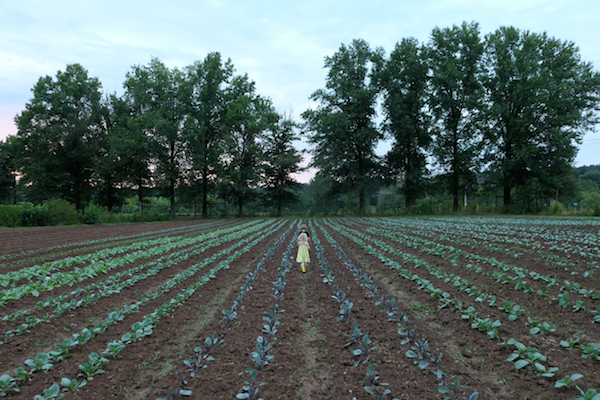
Fall brassicas looking good on a summer evening.
Harvests are particularly abundant right now, and I hope you are enjoying the bounty. Share weight is exceeding the 20 pound mark and you may need some serious muscle carrying the goodies away from the barn and fields. The high yield of some crops is the result of adequate rainfall, ideal soil fertility, and a slight increase in the number of plants grown, which typically follows a growing season with disastrous weather, like we enjoyed in 2018. We tend to overcompensate when yields are disappointing by growing more later, and when we grow more and have almost perfect growing conditions (like this year), crops are happy, thrive, and yield abundantly.
Not that everything has worked out perfectly this season. Peas drastically underperformed and unfortunately the heirloom tomatoes acquired some kind of blight earlier than normal. In contrast the field tomato plants were the healthiest and tallest I've ever seen and now that they're fruiting the yields seem to be following suit. Additionally the 2nd planting of tomatoes inside the hoop tunnel is also thriving and should keep tomatoes on our tables well into September. The first planting of watermelon was lost during excessive rainfall but the 2nd planting has done well and the two cantaloupe plantings appear to have succeeded. Zucchini/summer squash plantings 2 and 3 aren't yielding as expected but cucumbers are rolling in. Overall a balance is achieved.
We're continuing to maintain our no-irrigation-no-problem vigilance as we wait out this current semi-dry spell with faith that it will rain again very soon. We also think that it would be silly to add water to increase yields when we don't need an uptick in yield. That said, we won't risk losing crops to a lack of moisture, but we have confidence in our current weather patterns to bring us ample rainfall frequently enough. Sure seems that way at least, based on this year and last. We also have the added benefit during dry weather that our fields face north, don't drain particularly well to begin with, and have a high amount of organic matter which retains moisture.

July 28, 2019
A Beautiful Week
by Farmer Derek
A Beautiful Week
by Farmer Derek
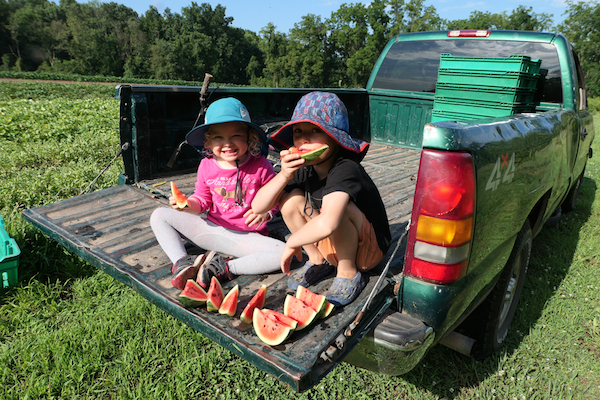
The first watermelons out of the field just had to be sampled.
Sometimes mother father weather deity treats us kindly and lovingly. A brutally hot heatwave that was sandwiched by just the right amount of precipitation was followed by wonderful sunshine, cool nights, and low humidity. July just might be our most difficult month on the farm, and it's so close to being over. We enjoyed a busy and productive work week. The march of weekly transplanting continued with the first rounds of fall beets, chard, and kale going in the soil along with the 18th succession planting of lettuce. The few thousand feet of fall broccoli, cauliflower, cabbage, and rutabaga were cultivated for the first time. Outdoor plantings of tomatoes were pruned and trellised again. Seeds were sown into thousands of cells. Compost was spread following the harvest completion of more spring and early summer crops such as peas, strawberries, and garlic. Cover crops will soon be sown there to protect and nurture the soil through the rest of this season and the winter. Yields of many summer crops are nearing peak production and weights of produce continue to provide ample upper and lower body exercise. Into August we're about to ascend and we look forward to another great month of organic farming.
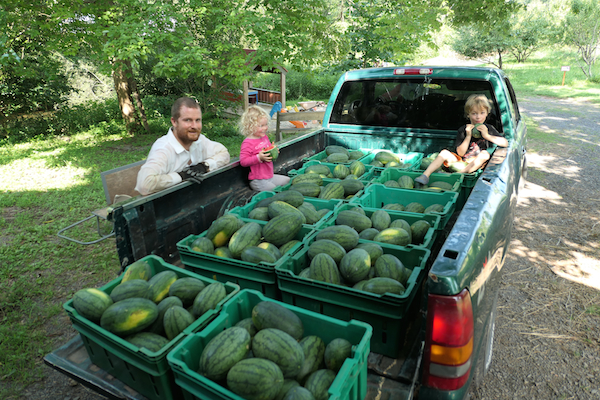
The first of hopefully four full truckloads from a productive watermelon patch.

July 21, 2019
Feeling the Heat
by Farmer Derek
Feeling the Heat
by Farmer Derek
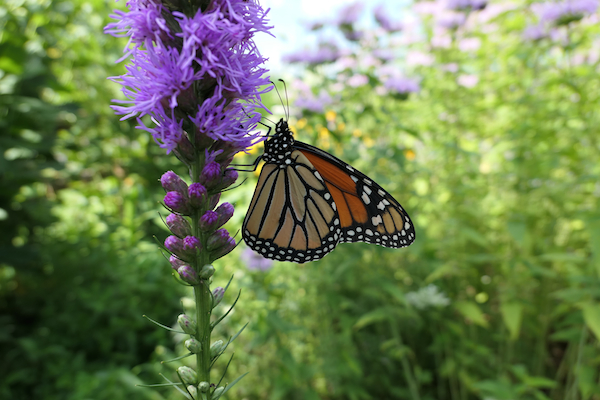
Hello beautiful monarch butterfly enjoying a blazing-star snack!
Whenever we have extreme weather I try to notice and acknowledge the wild species on the farm that seem to be thriving or at least seem to respond in a positive way or are able to ignore completely the unique weather circumstances. Observing these creatures provides a nice distraction from any worry associated with crop health because we can feel happy that they're happy. After flash floods I listen to a chorus of eastern gray tree frogs or aptly named green frogs and may watch our resident also-aptly-named big brown bats echo-locate around the trees and buildings while they snatch their insect prey from the moist air. During this brief but intense heat wave the calls of the midsummer nocturnal cricket-like katydid are ratcheting up and joining their daytime cicada cousins while june bug beetles seem to be intensely pursuing each other haphazardly. A romp through the woods yields spiderwebs galore filled with patiently waiting arachnids. The moist duff of the forest floor beckons the fruiting bodies of various species of fungi to cast their spores. Amidst this extreme heat, we slow down, cool down, and wait for it to break.
Before the heat's arrival we were fortunate to receive three-quarters of one-inch of rain, slowly and surely. We are very thankful and appreciative of this dose because without it we would be fretting the absence of moisture during these high temperatures. Anticipating the rain, we began putting some fields 'to sleep' for the off-season. That's a weird saying and I'm not sure what it means exactly, but what we did was mow and chisel plow and sow cover crops and disc-harrow to incorporate the seeds in fields where production is over for this growing season. If the seeds germinate well and the plants grow well we won't have to disturb the soil there until next spring. So, they're resting/sleeping but also photosynthesizing/nourishing/providing habitat/nectar/pollen/capturing carbon/beautifying. We sowed a mix of buckwheat, oats, and daikon radish. We'll use this mix for another month or so then we'll switch to oats and crimson clover and end with rye or wheat with hairy vetch in October. Cover crop nourishment of the soil is integral to crop health and something we emphasize here.
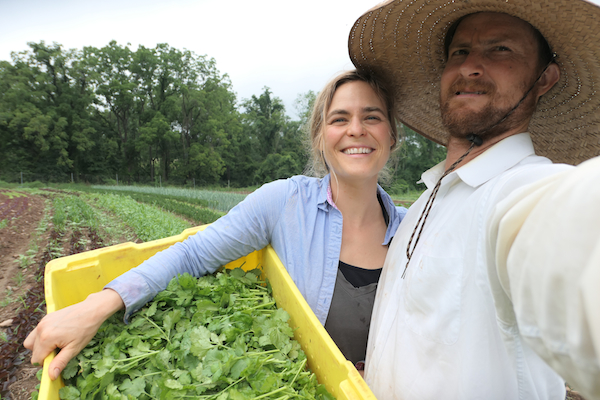
Farmer selfie with some fresh cilantro.

July 14, 2019
A Seriously Great Garlic Harvest
by Farmer Derek
A Seriously Great Garlic Harvest
by Farmer Derek
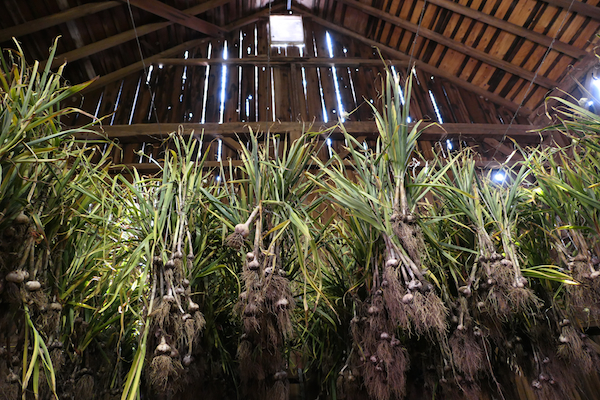
The final step of the garlic harvest: hanging from wire to dry and cure for 4-6 weeks.
And just like that, it is done. The Great Garlic Harvest of 2019 has been successfully completed by your farmers and 50 or so CSA members. We don't just say that it is one of the best workshift tasks to lure unsuspecting members out to help in this process. It is truly a wonderful team-oriented endeavor with our food community. Many hands do make lighter work. We start at 8am with 2,100 feet of garlic bulbs planted in 3 rows per bed, 6 inches apart in row. That's a total of 12,600 plants that need to be tugged out of the ground, bundled and tied together in groups of 5, then hung from wire and beams in the barn. It sounds and looks like a lot to accomplish, but with everyone working hard and together we were actually able to finish well before noon. Now, we simply let the garlic plants do what they want to do while they hang in suspension above our heads. Their outer skins dry out while the energy of the plant moves into the bulbs allowing for extended storage life. We'll replant 12,000 cloves in early November for a 2020 harvest. Our garlic has been saved and replanted every year for the past 16 years, so we can authentically call it Anchor Run Garlic.

July 7, 2019
A Little Rain is a Good Thing
by Farmer Derek
A Little Rain is a Good Thing
by Farmer Derek
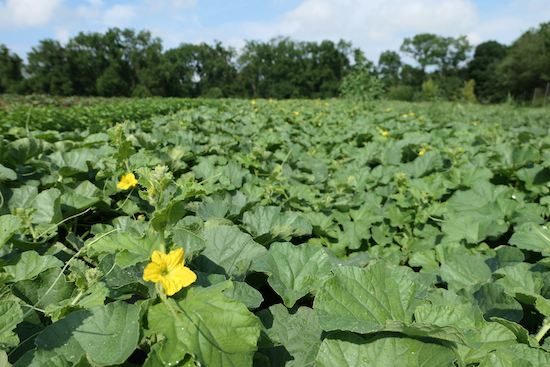
Cantaloupe and the 2nd planting of watermelon looking healthy. Our first planting of watermelon succumbed to excess moisture a few weeks ago when we received 4" of rain in a few days. Fingers crossed these melons reach maturity.
Last weekend I was looking forward to continued dry weather and by the end of last week I was feeling desperate for a bit of rain. And the weather gods did come through with practically 2" received over Friday and Saturday evenings. Following overly wet weather I'm very reluctant to invest time and energy into the set up of irrigation infrastructure. These days I would be very surprised if we don't receive ample rain every week or two. The hardest part is the mental game of deciding whether or not the crops need added well water or if they can wait for sky water. Two full weeks had gone by without a decent rainfall and our soil was probably at its driest in years. Two weeks is a test of tolerance, especially following the planting of 7,000 dormant strawberry plants on a 90 degree day. Physically and mentally, this task is one of the more challenging ones to participate in during the heat of the summer season. With the help of a couple of wonderful CSA members, farmer/mama Dana, and our great crew we managed to complete the job with nonstop planting over 5 hot and humid hours this past Thursday. Thankfully rainfall arrived Friday evening when it was absolutely needed. Another round came through on Saturday and now those dormant strawberry plants should be well on their way to waking up and converting sunshine to 2020 foodshine.
Mid-July marks a pretty big turning point of the growing season here. Spring crops are mostly harvested and now those areas will be cleaned up, mowed, composted, plowed, and sown into cover crops. The 'big harvest' time commences with the large and mostly one-time harvests of carrots, garlic (next weekend), onions (July/August), watermelon (July), cantaloupe (August), potatoes (August), winter squash (September), and sweet potatoes (October). End of June, all of July, and most of August is also the time for the twice or thrice weekly harvests of cucumbers, zucchini, eggplant, peppers, and tomatoes. Each time these crops are harvested the haul could range between 500-1000 pounds (or more occasionally). This is definitely our peak harvest season, and also peak sun and temperature. It's also the time when our farmer bodies begin to feel the labors of the past few months and our minds are challenged to push through this difficult time. I would say that by mid-August the reduced day length and proximity of autumn provide us with breath of relief. For now, we push through this bountiful season.
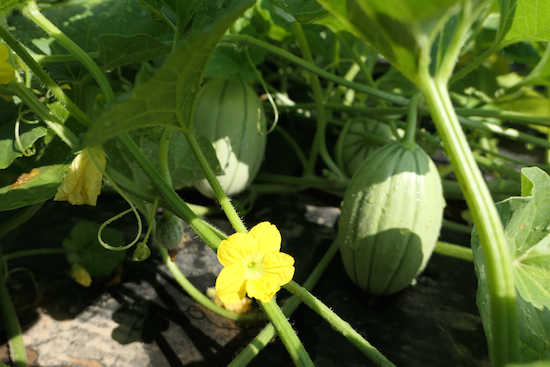
Little baby melons forming under vine canopy.

June 30, 2019
From Wet to Dry, Thankfully
by Farmer Derek
From Wet to Dry, Thankfully
by Farmer Derek
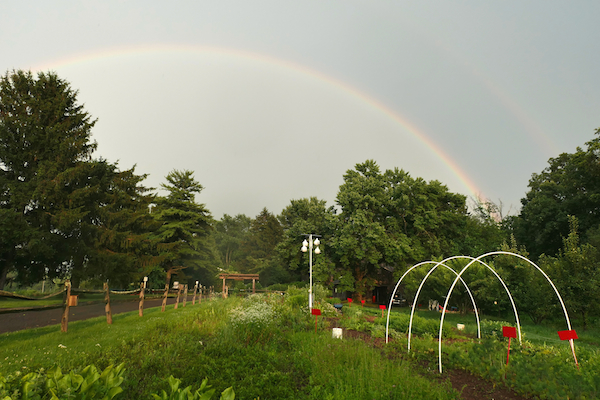
A brief passing shower gave us rainbow glory.
The rounds of thunderstorms that rolled through the area Friday and Saturday evenings spared the farm an inundation but did provide a nice double rainbow. Following a week with 4" of rain we desperately needed a period of dry weather. Any more rain probably would have doomed the carrots but it fortunately seems most of the patch is harvestable.
We were able to resume all of the required field work last week including cultivating leeks, celeriac, lettuces, herbs, beans, and edamame. Tomatoes were pruned and trellised again. Weekly beans and lettuces were transplanted. Spring crops were mowed, compost was spread, and then the ground was chisel-plowed to stimulate decomposition before we sow cover crops. Land for fall crops of beets, chard, carrots, lettuce, broccoli, cabbage, cauliflower, and kale was loosened with the chisel plow again but this time around with the added extra tillage of a row of s-tines on the back to rid the soil of germinating weeds and persistent grasses. Because the shanks on the chisel plow are spaced 12" apart weeds can sometimes survive a pass in the gaps between shanks. Adding the s-tines on the back, which are placed in the space between the chisel shanks, the top of the soil profile is disturbed more completely.
This time of year when preparing soil that had been in a winter cover crop such as wheat, vetch, and/or clover requires two passes with the flail mower, an initial chisel, another chisel with the s-tines, then we begin making our raised beds which requires a pass with the primary shaper then two passes with the final shaper (with each shaper pass we drop organic fertilizer). In between each pass with the tractor we ideally receive some rain to entice weeds to germinate which are then terminated by the next tractor pass. Preparing soil that has been fallowed for a longer period of time and is typically taken over by perennial grasses and clovers requires an extra pass or two with a chisel plow or disk harrow before we can begin making beds. The process takes place over a month or two.
We've modified our soil prep techniques over the years to retain proper soil structure as well as increase organic matter even though it takes a longer period of time to prepare soil for planting. Contrast these extra steps with spring planting after winter-killed cover crops (oats, buckwheat, radish) which normally requires only one pass with the chisel plow followed by bed shaping.
Why is this important you ask? Good question. For several reasons: Each pass with the tractor takes time and fuel. When soil is disturbed the biology, chemistry, and physical properties are interacted/interfered with. Thus our goal is to find that intersection where reduced time on the tractor meets improved soil health meets good planting conditions. We believe properly used tillage and farming techniques can greatly improve soil (and produce) over time.
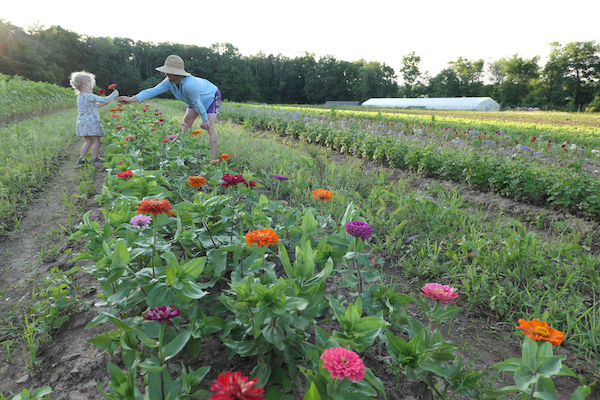
U-pick flowers opened up last week with not one but two locations available for picking. Rudbeckia aka black eyed susans volunteered in the strawberry patch in addition to the planned cut-flower patch.

June 23, 2019
Thus, The Wettest
by Farmer Derek
Thus, The Wettest
by Farmer Derek
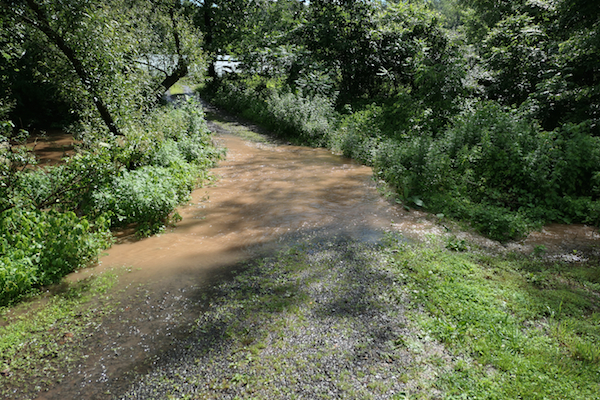
A flash flood caused by 1.1 inches of rain in a 20 minute burst on top of 3 inches already received over the prior two days. That's the path going out to the u-pick field.
And just like that this May/June combo is out wettest in 11 years. This "new norm" is beginning to render these extreme rain events less exciting and less panic-inducing. If I had to pick a week to receive 4" of rain and make most field work impossible, last week was a good choice. U-pick was in a strange pause, there was a lot less transplanting to do, and I didn't have any major tractor work that just couldn't wait. However, I did have to delay by one week our order of 7,000 year 2020 strawberry plants since the ground won't be dry enough for me to finalize bed-making in time for their midweek arrival (especially with the forecast rain Monday night). Even with the record-breaking rainfall the farm and its crops and its farmers still seem to be (mostly) happy and healthy. This sunny, dry, and windy weekend is much needed, especially for the farmers.
Assuming we have a nice and dry week we have a lot on our to-do list. Tomato plants are growing by leaps-and-bounds and need another round of pruning and clipping. There's much to cultivate and some to weed. We have the regular weekly successions of beans and lettuces to plant plus zucchini and cucumbers which seem to grow twice as fast now compared to April. Regular harvests will continue and very soon big harvests will commence with carrots and garlic. Soon we'll be transitioning spring production fields to cover-cropped resting fields as we clean up and prepare for the off-season recovery. For now we'll enjoy this ever-so-slight pause in the workload and gear up for another productive push when the weather allows. Happy summer!

June 16, 2019
Summer Solstice Upon Us
by Farmer Derek
Summer Solstice Upon Us
by Farmer Derek
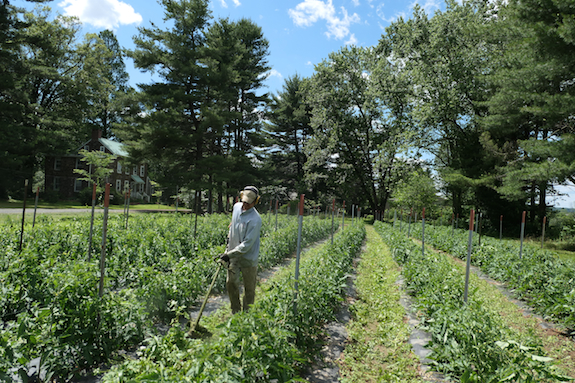
Putting the (temporary) finishing touches to a cleaned up field tomato patch.
As we approach this year's summer solstice the farm is in a good place, a good state, in this time as we make our revolution around our sun. As an organic produce farmer I'm out and about under the sun's gaze for much of the trip around the sun and I'm often transfixed by the beauty and grace that is present in the natural and agricultural 'scapes around the farm. Especially this time of year when multiple shades of green glisten and glow as most plants work hard to maximize photosynthesis and the creatures that share this space frolic and call as they raise their young or attempt to find a partner to do so. It's often easy to overlook this subtle beauty in the 'natural' world and I feel very lucky to be around it and see it while I work and walk around the farm. These plants and animals (and fungi, etcetera) that I share this space with remind me that we're a part of their world, or we're a part of the same world, or we're all part of these ecosystems where we call home. And we better do a decent job to take care of it for each other since we're dependent on each other while we both depend on the same space.
And to everything there is a balance, so back to production: We were quite busy last week. Celeriac, leeks, edamame, and lettuce were transplanted. Massive amounts of cucumbers and zucchini were harvested. All of the tomatoes were pruned and trellised. Peppers were staked. Watermelon and eggplant were uncovered. Walking aisles between beds were cleaned up for carrots, eggplant, peppers, and tomatoes. More seeds were sown into flats for future transplanting including broccoli, cabbage, and cauliflower. Sweet potatoes were cultivated and hilled. Ground was prepped for upcoming plantings of lettuce, beans, edamame, and hoop tunnel tomatoes. On the agenda for this week (if it stays dry) is finishing beds for the 2020 strawberries and the final planting of this season's zucchini and cucumbers, both of which are slated for planting the following week. We also need to transplant tomatoes, lettuce, beans, edamame, dill, and cilantro; seed; harvest; weed; cultivate; and mow.

June 9, 2019
Hustle and Bustle
by Farmer Derek
Hustle and Bustle
by Farmer Derek
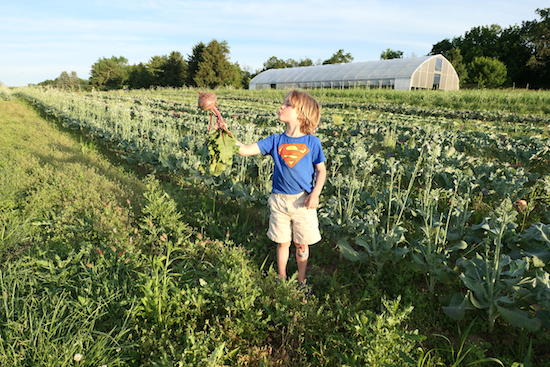
Super beet!
The marathon continues with intermittent sprints. We've had pretty amazing weather the past week and a half which has allowed us to stay on schedule and accomplish most of the tasks that make up our to-do list. Last week we began the perpetual tomato pruning and trellising which will occupy a lot of our time over the next month or so. Each plant gets pruned to 1 or 2 leaders and each leader gets clipped to a wire that is supported by 7' t-posts (we have around 2000 tomato plants on the farm). We also transplanted successions of lettuce, dill, cilantro, zucchini, cucumbers, cantaloupe, basil, edamame, beans, sunflowers, and scallions. The dry weather enabled us to hoe and weed where needed and with the help of workshifts we finished cleaning up the onion patch. This week we'll continue the steady march of spreading plants around the farm by transplanting more lettuce, beans, and edamame as well as leeks and celeriac for fall harvest. Strawberry plants for a 2020 harvest will arrive in a couple of weeks so I'll be busy getting beds ready for those 7,000 plants. We're already preparing for fall crops of broccoli, cauliflower, cabbage, etc etc by spreading compost and doing an initial chisel plow to incorporate the lush cover crops and compost into the soil. The robust organic matter needs some time to mellow and break down by the beneficial microbes and bacteria in the soil. After a rain event or two we'll mix the mixture around again to stimulate additional decomposition, wait for another rain event, then begin the process of making raised beds. All in all it's a 1-2 month long process to finalize beds for planting into.

June 2, 2019
At Least the Frogs are Happy
by Farmer Derek
At Least the Frogs are Happy
by Farmer Derek
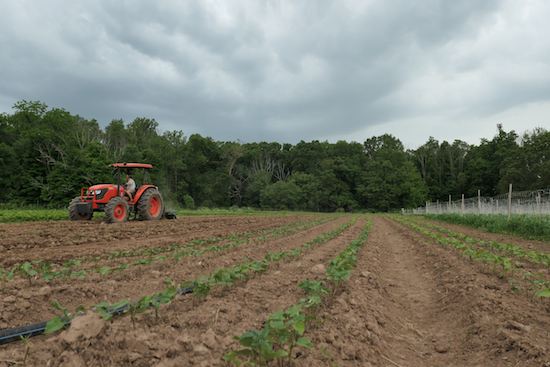
Quickly finalizing a few beds for needy bean and edamame transplants before the first of last week's rain events.
Whew. Here's hoping for some calm and dry weather. Last week's storms sure were crazy, exciting, and a bit scary. I hope you and your loved ones (and your property/possessions) made it through the storms okay. Damage to the farm could have been worse and I was expecting it to be so while watching the rain and wind pummel everything outside our windows. 'Only' 2.5 inches fell from the worst of the storms, providing the farm with enough rain to give the month of May the accolade of "second wettest May in 11 seasons". A total of 8.5" came down, 3/4" less than last May. So far I still feel lucky because that was our first deleterious rainstorm of this season. At this point last year we probably had a dozen or so. That storm was our first real test since the installation last fall of waterways and diversions to better direct the flow of water. We had some erosion but it would have been worse without those. We'll hopefully continue to make improvements to the farm's stormwater management as it appears these types of weather events are becoming more common. We must remain resilient, like Anchor Run's frog population, which was 'singing up a storm' during the storm.
Even though we battled the weather last week we were able to accomplish most of the tasks that were on our to-do list. Three thousand sweet potato 'slips' were planted as well as successions of lettuce, cantaloupe, basil, beans, and edamame. Ground was prepped for future plantings of strawberries, summer squash, cucumbers, beans, edamame, celeriac, leeks, and carrots. The onion patch was finally uncovered (ie row cover removed) after the spring threat of the pesky allium leafminer has passed. The onions have been covered since they were planted in mid-April. They've grown a lot, but so too have the weeds, and now those desperately need to be pulled out. So please join us for a workshift! We also finished harvesting the hakurei turnips and spent a lot of time harvesting strawberries for members. Additionally we moved the high tunnel off the lettuce mix to protect the heirloom tomatoes for the summer.
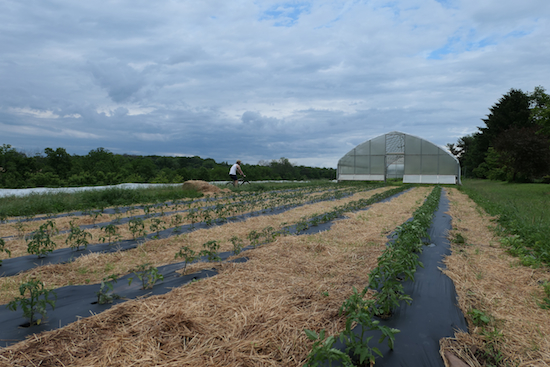
The movable high tunnel seen before it was moved to cover these heirloom tomato plants.

May 26, 2019
Satisfied
by Farmer Derek
Satisfied
by Farmer Derek
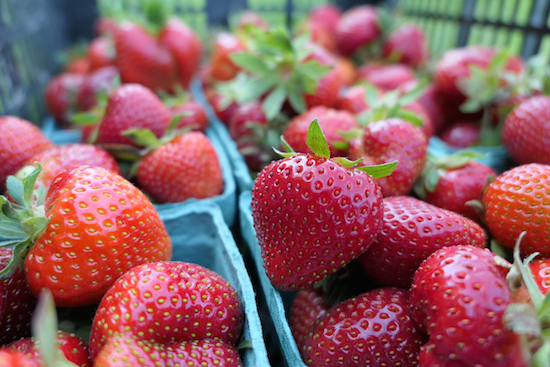
Hoping for a long harvest season of truly tasty red orbs of the strawberry kind.
And here we reside in that time of year when life as a farmer cannot be any busier. Constant work and worry, running, rushing, trying to accomplish a million tasks while working every day of the week just assuming one's energy level can be sustained to fulfill the goals. It's an interesting state of mind when we just arrive here and won't see the light at the end of the tunnel for another few months. Hey, we love it and live for it. And, fortunately for us and for you the one major variable we cannot control has been moderately cooperative thus far and in turn crops have been productive and harvests have been pleasing (weather, weather, weather).
Strawberry season is here and with it a frenetic pace to save all the harvestable fruits so we can all enjoy them. Seven varieties and seven thousand plants planted each and every summer, tended with loving care, watered to perfection, hopefully yielding abundant fruit and flavor. Peas arrive, too, but sadly acquired a soil born illness (pea root rot) so harvests will be more subdued. Soon we'll swing away from greens galore but for now we're fully enveloped in their glory. We love them. Enjoy your Memorial Day holiday!

May 19, 2019
We Love You Sunshine
by Farmer Derek
We Love You Sunshine
by Farmer Derek
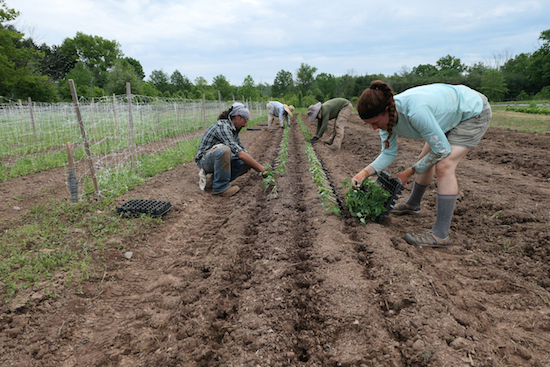
Transplanting the first of many rounds of snap beans this past Friday.
A snapshot of the farm in mid-May: Exceptional hustle amidst a wet, windy, and cold first harvest last Monday followed by the return of our off-and-on again friend the sun which allowed us to hustle again on Friday as we used the tractor and transplanted for the first time in over a week. Infinite weeding continues as we clean up what the cultivating hoes miss. Onions, carrots, cabbage, broccoli, kohlrabi, and kale have been merrily saved. Up next are beets. Last of the peas have been trellised. Next urgency is cultivating many crops that haven't been hoed due to the dominating wet weather pattern of the past couple of weeks. The commencement of harvesting means a significant amount of time each week is devoted to that so our window to tackle other tasks slightly narrows. However with successful harvests there's a feeling of optimism as the fruits of our labors can now be eaten. Spring crops, especially the lettuces and greens, have been thriving and should continue to do so. We do hope you love your greens as much as we do. Salads and smoothies for health!

May 12, 2019
2019 Member Handbook; Pick Up Information
by Farmer Dana
2019 Member Handbook; Pick Up Information
by Farmer Dana

Transplanting peas earlier this spring.
Please follow this link to access the 2019 Member Handbook. Especially for new members, read this over before you come to the farm for your first pick up. It should answer many of your questions and will hopefully help you get situated. Staff will also be available to help while you are here.
- Pick up begins the week of 5/13/19 for Full, Medium, and Week A Half Shares. Week B Half Shares begin the following week of 5/20/19. We're open Memorial Day weekend and during all summertime holidays. Log in to view your pick up day/week or look at the e-mail that was sent and included all of that information.
- Pick up days are Monday 1-8pm, Thursday 1-8pm, and Saturday 10am-12noon. When you signed up for a share you selected one of these days. Half Shares are also designated Week A or Week B. If you're a returning member you have the same week as last year. If you're a new member you've been assigned Week A or Week B. Log in to view your pick up day/week or look at the e-mail that was sent and included all of that information.
- It is very important that you come on your correct and assigned pick up day because we harvest specific amounts for the number of members coming on that day. Sign in sheets are provided by the pick up room when you arrive to collect your share. Log in to view your pick up day/week or look at the e-mail that was sent and included all of that information.
- You can temporarily switch your pick up day/week by e-mailing us by 5pm Sunday prior to your pick up week.
- Allotments for the farmer harvested share and u-pick portion will be specified on the blackboards in the pick up room. Staff will be available in the pick up room to assist new members.
- U-pick can be collected any day of your pick up week Monday-Sunday 8am-8pm. Weekly u-pick allotments are specified in the pick up room on the u-pick board.
- Bring your own bags and scissors and wear appropriate farm footwear. Please be courteous in the pick up room and in the u-pick fields.
- Parking is available in the large stone lot at the end of the driveway. Parking next to the barn is available for people with physical challenges and for cars with sleeping kids.
- Driveway speed limit is 10mph.
- If you still have a balance, please remit payment no later than June 1st, 2019. You can mail it or bring it to the farm.

April 13, 2019
So Thankful
by Farmer Derek
So Thankful
by Farmer Derek
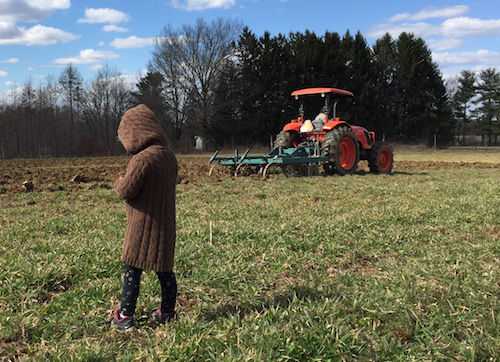
The first step towards planting crops: chisel plowing.
It's only mid-April but it feels like we've been playing out in the dirt for quite a while already. We're very happy to report that (so far) it's been one of the most enjoyable and productive springtimes we've had at the farm. There's been ample sun, plenty of dry weather, warm days, and not too many frosts. We're chugging along right on schedule. Crops that are already nestled in their raised beds include two rounds of peas, kale, broccoli, cabbage, head lettuces, lettuce mix, beets, chard, spinach, arugula, onions, carrots, fennel, dill, cilantro, and parsley. In fact, we're very close to having wrapped up all of our early to mid-spring planting. All that is left are the potatoes (1500 pounds to plant over 10,000 bed feet), the weekly lettuces, and another planting of spinach and lettuce mix in the tunnels. We even cultivated the first planting of brassicas. Practically every spring crop gets covered with floating row cover as a pest barrier but it also acts as a mini greenhouse, protecting crops from frost and heating the space underneath slightly. Thus, weeds germinate more easily and so need to be cultivated right on time with hopes that we can avoid most hand weeding.
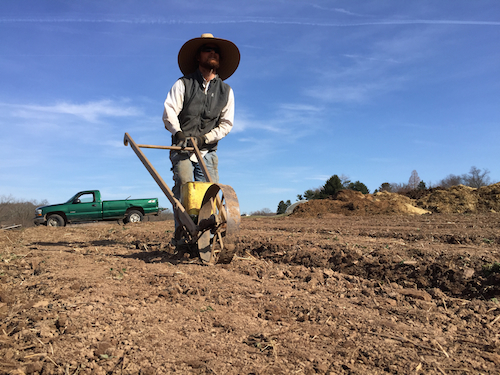
We transplant most of what we grow, but direct seed carrots, turnips, radishes, and greens like arugula, mix, and broccoli raab.
Before this weekend's needed rain event(s) I even began prepping for summer crops including tomatoes, peppers, squash, cucumbers, and watermelon. The soil was opened up in these areas for the first time since last summer. After a cover crop and compost application, the soil should be ready to host our crops and provide them with the nutrients they need.
It's exciting to have returned to this time of year once again. Bulbs and trees are in bloom, peepers and toads are singing, swallows and flycatchers are back, and the green sheen will grace us for another six months. With the plethora of beautiful days we've been fortunate to work outside in, it feels like the scale is balancing against the contrast of last season's weather and subsequent growing challenges.
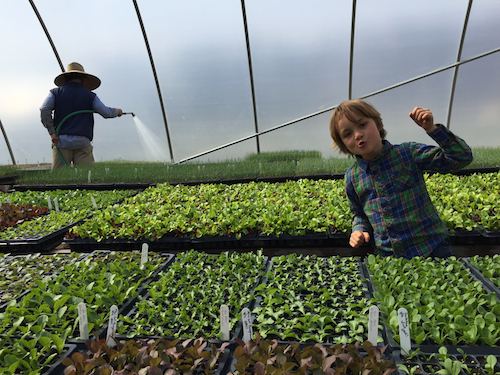
By necessity the most meticulously cared for and monitored space on the farm, the greenhouse is where we start most of what we grow.

March 4, 2019
Slowly Exiting Winter
by Farmer Derek
Slowly Exiting Winter
by Farmer Derek
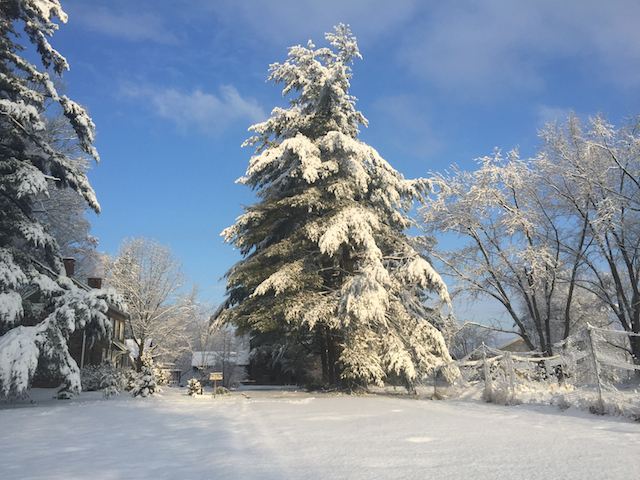
A beautiful and hopefully final snowfall.
Consistent with the past few years, we've welcomed one of the winter season's biggest snowfalls in March. This week we'll also endure another blast of cold winter temperatures but at least sunshine will return after a 3-4 day absence. Fortunately much of our time will be spent in the in-between indoor/outdoor world of greenhouses and high tunnels where it's a bit warmer and reasonably protected from whatever weather is going on outside.
Last week the 2019 growing season officially began in the greenhouse where we sowed approximately 63,636 seeds into 35,838 cells on 189 transplant trays, all lined up tidy and neat in our small heated greenhouse. We need some daytime sunshine to warm up the tunnel and invigorate the sleeping seeds to wake up and begin their programmed march towards the sun. So many future crops are crammed into such a small space that it could evoke a large feeling of worry and anxiety while we wonder if they'll successfully shed their slumber, but year in and year out we've learned that when properly taken care of and given the right conditions, we can expect a high percent of successful germination.
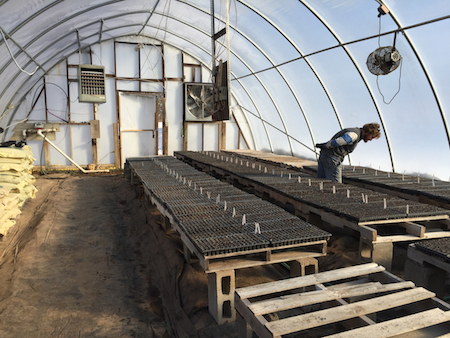
Nervously awaiting successful germination.
In the greenhouse there are several variables that we can control: high and low temperatures because we can add heat or open shutters and fans to whisk it away; moisture because we manually water; depth of those seeds in the soil medium because we hand sow; and whether or not the seeds see the light because some require sunshine to germinate (lettuces, chicories, some flowers and herbs). After farming at Anchor Run for ten years and tweaking and adjusting some variables we've almost perfectly figured out how to always successfully germinate our crops. We start practically all of our crops from seed so it is vitally important for us to do it exactly right. Later in the season when excess heat is an issue we put many flats under shade cloth and even put others in an air conditioned produce storage room (such as spinach).
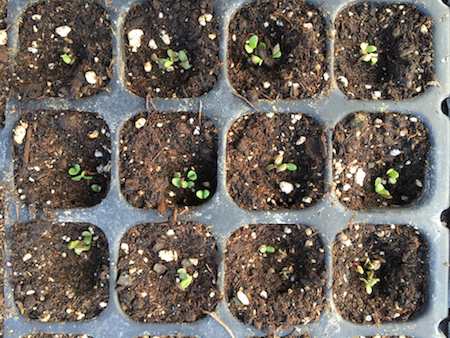
Lettuce mix seeds sprouted quickly.
Exactly what food items were sown last week (to name a few)? 25,000 onions; 3,100 spinach; 1,800 beets; 2,000 broccoli (new spring item!); 650 fennel; 3,000 kale; 2,000 kohlrabi; 1,000 heads of lettuce; 10,000 lettuces for mix; 1,000 celery; and 1,000 radicchio. This week we sowed 21,000 snow peas and another round of a few thousand lettuces and chicories.
Besides seeding in the greenhouse, we also put the finishing touches on our crop plan and crop rotation. Rotating crops according to their plant families helps us attempt to thwart pest and disease pressures while also assuming that each crop requires slightly different soil nutrient needs with a slightly different uptake of those nutrients. Thus, moving crops around should provide a balance. Our goal is a minimum of a 3-year rotation for the plant families that occupy a large portion of our growing space (brassica - kale, broccoli, arugula, cabbage, etc; nightshade - tomatoes, potatoes, peppers, eggplant, etc; aster - lettuce, chicory; amaranth - beets, spinach, chard, etc). For most other crops its fairly easy to see a 5+ year rotation because they occupy much less space. We also rotate U-Pick crops back and forth between Field 1 and Fields 4/5/6. It's kind of like putting pieces of a multidimensional puzzle together in time and space along with other variables to consider like soil moisture. It makes for a good wintertime activity.
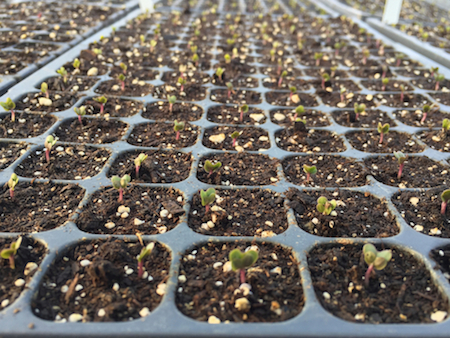
Kohlrabi also came up quickly, in about 5 days.

February 10, 2019
Happy Mid-Winter Everyone!
by Farmers Dana and Derek
Happy Mid-Winter Everyone!
by Farmers Dana and Derek
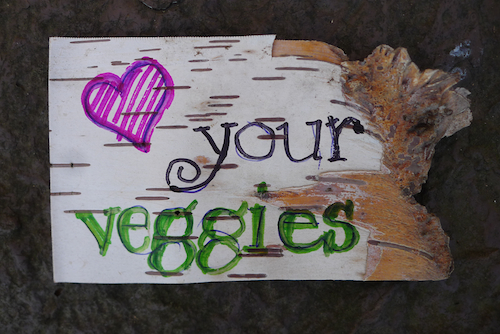
A beautiful paper birch note received upon our return - thanks Kati!
Happy Mid-Winter Everyone!
We hope this brief note finds you well and happily steeped in the solitude and solace of wintertime. The farm has been in full shutdown mode the past month or so after the conclusion of the Late Fall CSA and our mini Flash Greens Sale in early January. Your farmers need a rest and recovery period every winter in order to re-energize bodies and spirits. January is a perfect time to take a break from the farm and this year we made sure we took that opportunity (it's been many years since we had a true getaway). Being fortunate to have family and friends in good places to venture during our Bucks County winter we visited the Bay Area of California, Kauai Hawaii, and Washington State. It was exactly what we needed. We went on a lot of hikes and bike rides and played on the beach, in the ocean, and at many a playground. We saw friends and family we haven't seen in a long time and enjoyed many a good meal. We're thankful for the opportunity to have taken this trip.
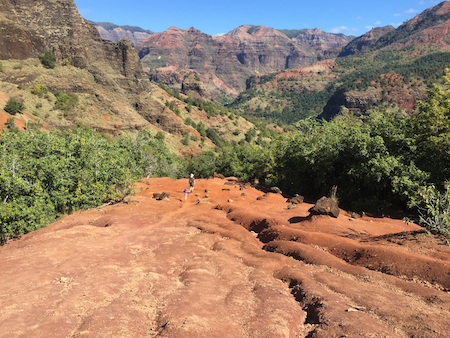
Hiking in Waimea Canyon State Park on Kauai.
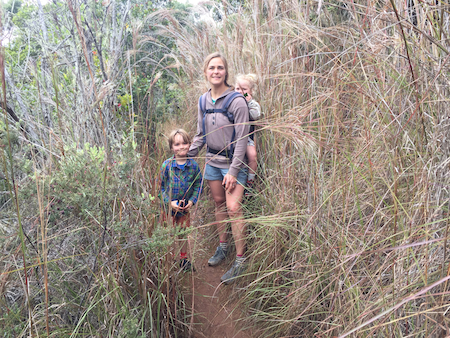
Hiking in Koke'e State Park.

Kekaha Beach Park surf trials.
And back to the farm: Now that daylight has surpassed the 10-hour mark and speeds towards the Equinox we'll follow suit and ramp up farm work and get fully ready to start the 2019 growing season in our greenhouse at the end of the month. Between now and the beginning of April it will be a slow and steady increase in the quantity and pace of outdoor work. Each week we'll sow thousands of seeds into flats in the greenhouse and embark on some general farm maintenance and clean up. Starting in early April we'll begin planting those thousands of plants outside and from then until mid-May our workload will increase exponentially until we suddenly begin harvesting and distributing your produce to you. In late April or early May workshifts should begin and you can start helping us on the farm in lovely spring weather.
For now, though, make sure you sign up soon for the 2019 Main Season! We are putting the finishing touches on our crop plan which is purely based around the total number of CSA members we have each year. Having members sign up and at least put in the $200 deposit helps us feel confident we'll once again reach our membership goal. Since we're still in the planning phase for the upcoming season please feel free to reach out with any hopes or suggestions. The 2018 growing season was a challenge for sure but we're feeling positively good that 2019 will be a great one!

December 22, 2018
Thanks Folks!
by Farmer Derek
Thanks Folks!
by Farmer Derek
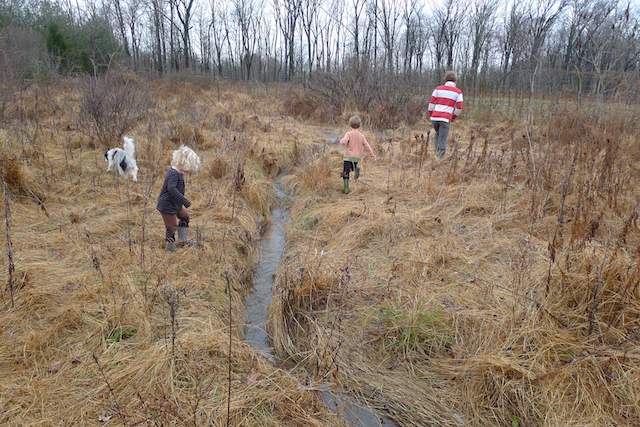
A winter solstice romp around the farm on a 60 degree day.
Hey, we made it! Harvest week six of the Late Fall CSA is upon us. Thank you for your support during our mini Main Season extension; we hope you've enjoyed the produce we've grown and harvested for you. Harvests didn't work out exactly as planned - thanks rain! - but we do hope you've been satisfied with the quantity, quality, and diversity of produce that did succeed during this Late Fall iteration. We'll reflect on this season and plan accordingly for next year. If you have any produce desires for next Late Fall please do let us know!
Crops that we want to see more of next year include onions, leeks, beets, hearty cooking greens like curly kale and/or collards, cabbage, carrots, and winter squash. As we develop our crop plan this winter we'll consider these goals and will modify growing practices to hopefully ensure harvest success. For example, increasing the amount of some crops should translate to an increase in harvest while some crops might need to be grown under protection to ensure their success. Other crops, like winter squash, will need to be properly cured and stored if we aspire to have them through December. Sometimes simply having better weather should greatly increase yield.
Again, thank you for joining us on this farming food organic healthy journey we're all on. Enjoy your holidays and winter. We'll be in touch soon with 2019 sign-up information!

December 16, 2018
So Long, Autumn
by Farmer Derek
So Long, Autumn
by Farmer Derek
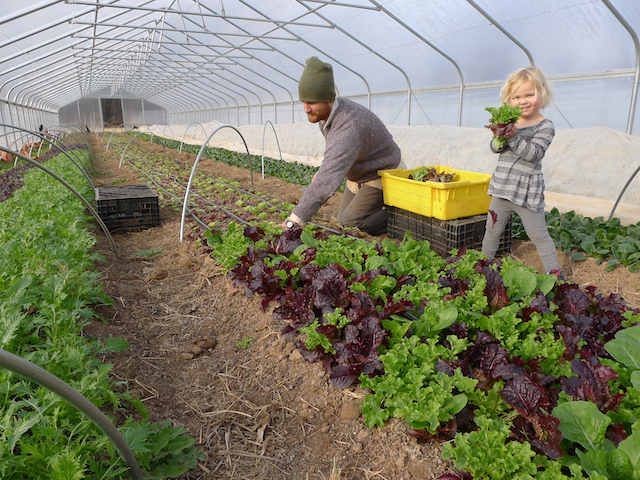
Harvesting some wonderful lettuce mix with a great little helper.
We welcome the Winter Solstice this week as seasons switch from autumn to winter. The darkest day of the year will come and go and then we'll appreciate lengthening days during the coldest time of the year. Fast forward to February when daylight eclipses the 10-hour mark and we'll be thinking spring, but for now we'll enjoy the holiday season and longer slumbers.
Besides spreading compost for a couple days this past week while the ground was dry and hard enough, I attended a Pennsylvania Association of Sustainable Agriculture (PASA) event that brought together advanced growers from the region to reflect on this past season. Much was mentioned of the calamitous nature of Mother Nature this year, it being one of the wettest or the wettest on record, and how the excessive moisture affected various crops and yield. Farmers are a relatively resilient group, with this season being perhaps the toughest test yet for this cohort of advanced growers who have anywhere from 10 to 30 years of growing experience. Most growers there were from small family owned produce farms or businesses that predominantly sell directly to consumers through a CSA or farmers market. Many also sell produce to restaurants and wholesale. Most farm organically and many are certified organic.
In addition to the beneficial feeling of camaraderie that surrounds this similar group that shared many of the same struggles during this season, I wanted to be able to leave the meeting with some valid insights into ways to improve our farm as we move forward into less predictable and more extreme weather. There are many factors that affect crop health but soil type probably has the greatest influence during a wet year. Soils that drain more quickly performed better than those that do not. Size of an operation also seemed to determine outcomes. Bigger producers and growers who require more time for field work and rely solely on mechanical/machine means for field preparation and cultivation struggled to stay on schedule. Crops couldn't be planted and those that got in were quickly outcompeted by weeds. Conversely, farmers who manage a smaller land area, focus on efficiencies, have diverse crops, and try to maintain output rather than continually expand seemed to weather the weather slightly better this year. Many growers mentioned the desire of scaling back to achieve a higher level of efficiency and control.
So what about our little CSA-only farm? Overall this year I think we held up okay. Our worst season for growing was the fall. It was an extremely wet time period but also unfortunately most of our plantings were concentrated in areas of the farm that have soil that doesn't drain that well (we have at least three soil types on the farm). Some crops grew well there including leeks, beets, later plantings of hakurei turnips, endive, dandelion, and lettuce mix. Crops that underperformed there included broccoli, cauliflower, cabbage, and Brussels sprouts. Spring and summer weather was almost as wet as the fall but the sun and heat helped crops through. Warm wet weather is much better than cold wet weather for our crops. Certain yields were down enough that warranted cancellation of the Winter CSA in order to make sure we had enough produce for the final month of the Main Season as well as the entirety of Late Fall. Good performers this season included strawberries, raspberries, blackberries, peas, heirloom and hybrid tomatoes, sweet peppers, summer carrots, cucumbers, zucchini, sweet potatoes, beets, onions, and garlic.
Because next year we won't be able to control the weather any better than this year we'll continue to do the little things that have allowed our operation to overall succeed during extreme weather events. We'll also consider investing in big capital and infrastructure improvements for longterm stability. We'll continue to embrace farming efficiently by maintaining our current membership size so that our land footprint remains consistent. Importantly, we'll prepare our fields for growing by taking advantage of dry weather windows to give us planting space for the next 3 or 4 weeks of planting (in case the soil remains unworkable for that long). We'll make raised beds so plants don't drown. We'll maintain or enhance crop diversity. We'll cultivate using manual means such as the omnipotent oscillating wheel hoe. We'll handweed when absolutely necessary with the help of our membership. We'll address drainage issues by slightly adjusting bed slope so water flows out of the field. We'll add contour buffer strips, waterways, and diversions to thwart a deluge. We'll sow cover crops whenever possible to minimize erosion. Additional longterm investments will be made with the construction of high tunnels.
This year was full of extreme rainfall events. It might be an anomaly, it might not be. We'll be ready for next season no matter what. Thank you for your support (and sorry this note is so long, I am guilty of overthinking)!

December 9, 2018
Relishing the Dark Time
by Farmer Derek
Relishing the Dark Time
by Farmer Derek
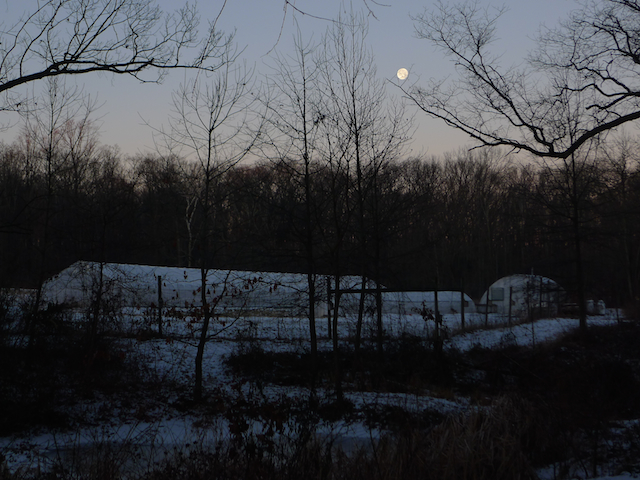
A winter moon scene.
The hustle and bustle of the outdoor growing season safely behind us, we can now allow our minds and bodies to recover, reflect, as we drift into winter's solace. Much of my work during December is done from the comfort of the couch, near the wood burning stove. Since everything and everyone is connected through the internet via some kind of computer device, most of our supplies can be ordered without me leaving the couch (except for the inventorying part). All of our crop planting plans, crop rotations, crop schedules are recorded digitally using one kind of spreadsheet or another. Eventually I will tire of this type of task, but for now it's a welcome change from the pressures of the outdoor growing season and the physical demands of farm work. If I need a break from sitting, there remains plenty of miscellaneous jobs to do outside this time of year including collecting more irrigation and season extension components from the field as well as spreading compost and mowing if the weather allows. Not to mention harvesting and distributing shares every Wednesday and Saturday through the end of this month. My lofty goal is to finish the majority of my winter administrative work this month while hoping that I can truly take some time off in January. Thinking about and planning for the next growing season is a pleasant task due to the glossy and glamorous pictures in the seed catalogues coupled with a fresh start on a clean field; it puts a positive spin on our aspirations for next year.

December 3, 2018
A Sunny Stretch
by Farmer Derek
A Sunny Stretch
by Farmer Derek
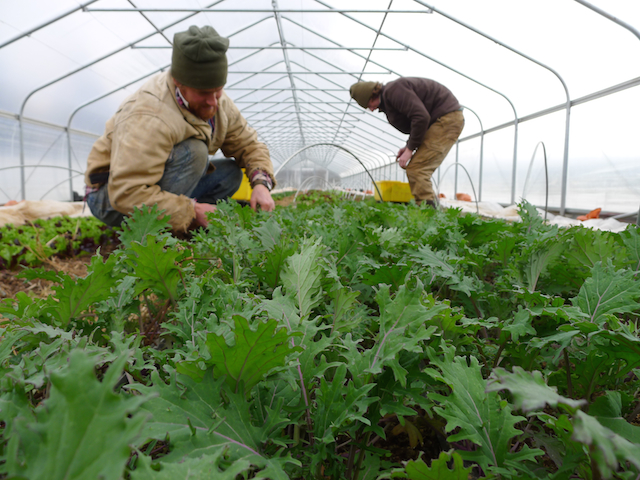
Harvesting tasty tender baby red russian kale last week.
Even this time of year I can get excited about a forecast showing 10 days of sunshine without rain (forecast will most likely change). Temperature highs will eventually be in the upper 30s but that seems permissible for early December. Another record breaking wet month is in the rear view mirror which also concludes my 9-month collection of precipitation data. From March through November 2018 we received 55" of rain, almost 2 feet more than the average of the prior 9 years. That's about an average of 1.5" per week, an insane amount here. Our soils would be happiest with at most a 1/2-inch of rain per week, even in the heat of mid-summer. But, hey, we made it to December, hooray! With four more weeks of CSA in 2018 we can actually perhaps see some light at the end of what was a very long tunnel. In a few weeks we'll celebrate the Winter Solstice and welcome increasing daylight which for us farmers marks the New Year, at least the way I internally process the growing seasons. Because it will basically coincide with the end the Late Fall season, and because we're foregoing a Winter CSA this year, it will truly feel like an end and a beginning.
We're already deep into the process of preparing for the 2019 growing season. Last week I spent days reviewing our collection of seeds and assembling our extensive seed and plant order. I ordered 7,000 strawberry plants (1,000 plants of 7 varieties) and 1,500 pounds of seed potatoes (5 of our best varieties, varying poundage and maturity length). This week I'll finalize and place our annual crop seed order and then probably move on to accessing farm supplies like irrigation infrastructure, row covers, trellising materials, and harvest containers. We also have our annual Certified Organic inspections which I'll prepare for by assembling all of our planting and harvest records as well as any receipts for farm inputs. And I will also spend time outside each day while the sun is shining for mental and physical balance, collecting remaining irrigation supplies from fields and doing some general farm clean up.

November 26, 2018
Farming Out of November
by Farmer Derek
Farming Out of November
by Farmer Derek
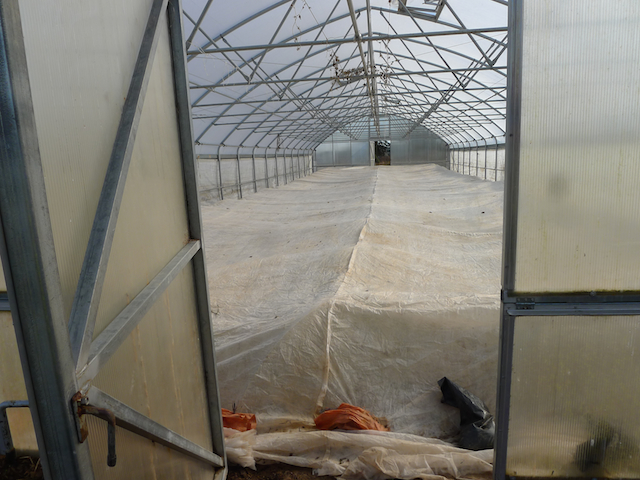
a view of the high tunnel with extra covers on the inside to protect crops as temperatures bottomed out near single digits
We hope you enjoyed your holiday last week and were surrounded by family, friends, and good food! We enjoyed our 3rd Thanksgiving celebration in the past 1.5 weeks due to a multitude of branches on our family tree.
For the farm it's been quite an eventful couple of weeks with the end of one CSA season and the start of another CSA season sandwiching a major holiday with the latest batches of extreme weather thrown in just for fun. A heavier-than-forecast snowfall as the Main Season concluded, the coldest Thanksgiving in years with lows near the single digits as we welcomed the start of the Late Fall, followed by 4 more inches of rain just to remind us what kind of year this has been. Officially, now, all our crops are coming from protected tunnels and storage so at least we have slightly more control over plant health and yield.
The rainfall can basically be ignored at this point since the crops are sheltered but we do have to add extra covers to the crops when temperatures drop below 25 or so. A forecast of 10 degrees forced us to add a double layer to be safe. We uncovered everything during Sunday's beautiful weather and all the crops survived unscathed. I'm definitely looking forward to eating all these greens!
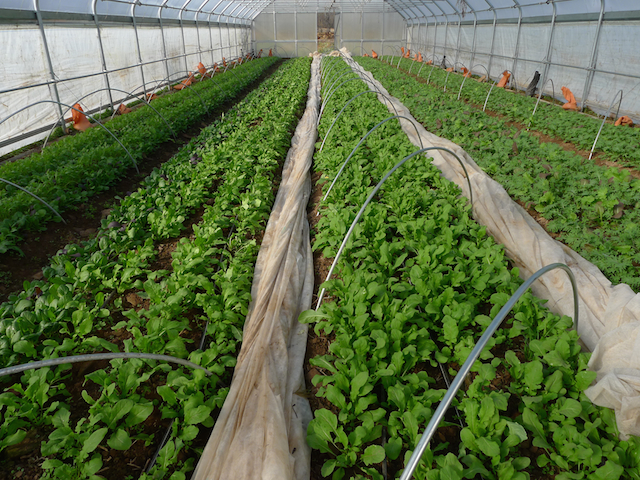
a view of the greens in the high tunnel after the interior covers were removed following the extreme cold

November 18, 2018
Welcome to the 7th Annual Late Fall CSA
By Derek McGeehan
Welcome to the 7th Annual Late Fall CSA
By Derek McGeehan
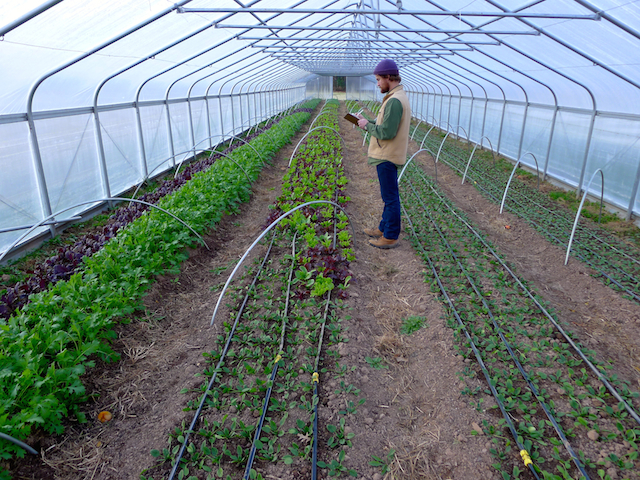
Greens in the hoop tunnel.
Thanks for joining us! Most of you were members of our Main Season CSA while some of you are new to our farm and perhaps new to CSA in general. This six week season should be a good one. Crops in our four tunnels are looking happy, healthy, robust, and right on schedule. After all of the extreme weather we endured during our 26-week Main Season it's nice to now be able to harvest from inside a more protected and almost weather-controlled environment. We still need to monitor and adjust accordingly the levels of moisture in the soil (irrigate or no), humidity levels (open doors during the daytime), and temperature (add extra covers inside the tunnels on low hoops). The cold weather suppresses diseases as well as pests so it almost feels 'easy' to farm inside during the cold months. A forecast high below freezing followed by night in the teens this coming week will have us perhaps feeling a tad uneasy but from experience we know that crops in the unheated-except-for-solar-radiation structures can endure much colder outside temperatures before they're damaged. One of our tunnels has a propane heater which we'll gladly set for 35 degrees.
We still have some crops outside under hoops and heavy duty row cover but we're not sure how they and the hoops plus cover fared with the 4-5 inches of snow. They're probably okay except for a few bent hoops and maybe flattened plants but we won't know until the snow is fully melted and we can remove the cover. (Monday update: hoops, cover, and crops stood up to the snow load so we'll retrieve what we can there before 15 degrees descends Thursday night).

November 11, 2018
The Final One
by Farmers Dana and Derek
The Final One
by Farmers Dana and Derek
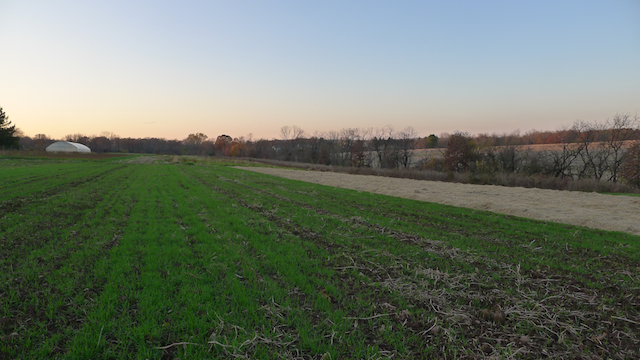
Sun setting on the 2018 Main Season.
Thank you, CSA members, for all of your support and continued collection of your harvest shares during this most difficult of growing seasons! While our growing and harvesting plans haven't always worked out exactly as planned this year somehow some way there will be knowledge and experiences gained that will hopefully prove practical and valuable in the future. It's easy for us to recall all of the crops that failed or under-performed, especially during late summer and through the fall, but we'll be able to do that later, when the ground is frozen or snow blankets the earth. What takes up most of our time right now is focusing on what has survived or thrived and trying our best to fulfill our commitment to you: filling your shares with enough quality produce to enrich your culinary endeavors at home.
At some point later this fall or early winter we'll have ample time to truly reflect on this season and build on these experiences to develop and implement what could make harvests more predictable and foolproof in the future. Ultimately this may require us to invest money and resources in more earth moving and infrastructure development to help temper weather extremes. These challenges are part of why we love our job and are thankful to spend our time doing it. And it goes without saying, that without you, our members, none of this would be possible.
We hope we've come close to satisfying your expectations during this growing season and would love to hear back from you if you have any thoughts, opinions, or comments to share with us. There probably won't be an official survey this year since (we're hoping) this year is an outlier, an anomaly, and not one we should let dictate all of our growing plans for the future. We'll have to mix it with the prior five seasons as we adjust the crop plan.
As the main growing season of 2018 comes to an end we remain truly grateful for our shared journey through it and for your support. We hope this winter proves to be restful, joyous, and healthful for you and your families. When Spring rolls around again we hope to see you back on the farm for another growing season adventure!

November 4, 2018
What A Long Strange Trip This Season Has Been
By Derek McGeehan
What A Long Strange Trip This Season Has Been
By Derek McGeehan
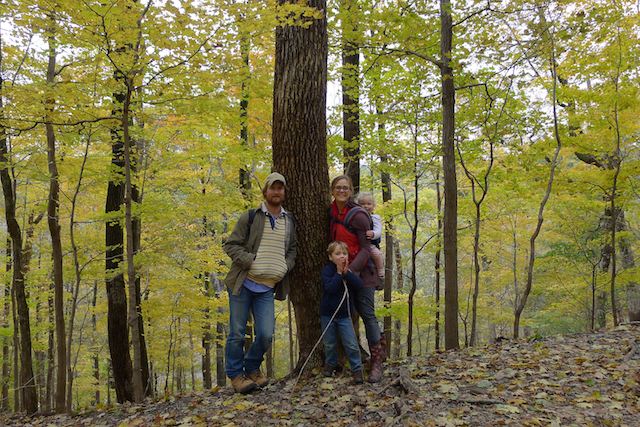
Fall hiking trip in Ralph Stover State Park.
Well, it's official: with the additional rainfall received Friday night, 2018 is now the wettest growing season during our ten-year tenure at Anchor Run Farm. Four feet of rain has fallen since March 1st, providing 13 inches above the ten-year average. We're thankful we've made it through the Main Season with farm shares that have hopefully been ample and satisfying to you, our CSA members. Years like this give me pause when I consider our tenuous relationship with and full dependence on our soils, the earth, and the climate to try to grow healthy organic produce. While we strive to control as many variables as possible within the realm of organic agriculture, there remains a most powerful independent one: the weather. Raised beds, waterways, water diversions, contour buffer strips, etc., help our crops deal with excess water, but our most foolproof tool is the plastic covered steel structure, i.e. the greenhouse, hoop house, hoop tunnel, high tunnel.
During this penultimate week of pick ups for Full and Medium shares and the final one for Week A Half shares our attention continues to shift to these almost weather proof structures for November through December harvests. Last week we finished planting the final succession of cold season crops and now we'll simply coax them along with weekly additions of well water through drip irrigation. Three of our four structures have no supplemental heat besides solar radiation so we'll monitor closely the forecast temperature lows so that we can erect low tunnels within the larger tunnels. The greenhouse has a built in propane heater which we'll set for 35 degrees to keep plants from freezing. This will enable them to grow/regrow faster than their unheated counterparts.

October 28, 2018
A Great Week, Appreciation of Good Weather
By Derek McGeehan
A Great Week, Appreciation of Good Weather
By Derek McGeehan
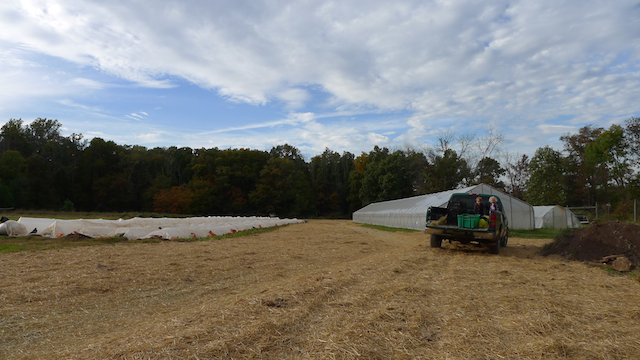
The water diversion in Field 1 was finished last week before the nor'easter.
It's a wonderful feeling to be satisfied after a very productive and enjoyable week of farm work. So much was accomplished last week including the planting of 12,000 garlic cloves and subsequent mulching of the entire patch with the help of two workshifts on Friday. We couldn't have finished that without the help from our amazing CSA members. We also wrapped up the water management project for this calendar year (more to come in 2019). Dry conditions during the construction of the waterway in Field 1 made the work much easier and faster to complete. After earth moving was finished and approved we seeded and mulched the 700'x40' area before Saturday's rain event. We also transplanted 3,000 lettuce mix and spinach seedlings into the hoop tunnel as well as cultivated the high tunnel greens. The dry ground also allowed me to spread compost for around 8 hours over multiple fields.
Perhaps the best part of last week was being able to look around and appreciate our farmscape once again. Most of this season we've spent wallowing in mud and feeling negative from the effects of sustained poor weather. The past two weeks were a real treat, a big change, as the ground was at its driest in months and our remaining crops seemed to respond well to the sun and wind. Leaves on trees are changing in color and much has been kissed by a few frosts rendering darkened hues as well as sweeter flavors. We lucked out with the frost; it wasn't too heavy here and even our peppers pulled through fine. With November arriving this week and the threat of frost and freeze temporarily suspended we're looking forward to enhanced growth of many of the greens we're coaxing along. Here's to sunshine and not too much rain.

October 21, 2018
Winds of Change
by Farmer Derek
Winds of Change
by Farmer Derek
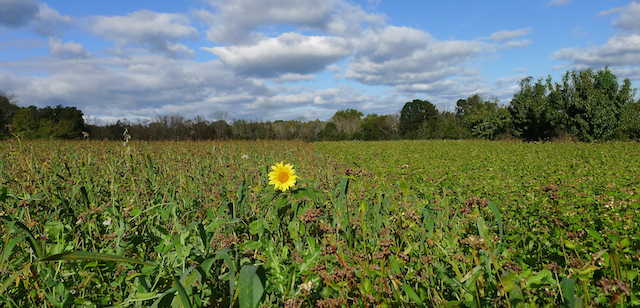
Solitary sunflower in a sea of buckwheat, oats, and daikon radish cover crop.
The monsoon season having departed, we're now entering the windy frosty season. So far we had two very light frosts and are hopeful for nothing too heavy too soon. Tomatoes are out of the field as well as the tunnels but we still have sweet and hot peppers rolling in from outside. These are the last of the summer crops that we're coaxing along, plants that may succumb to a hard frost. Traditional fall crops tolerate light frost but when temperatures begin to dip below freezing damage can occur on unprotected leaf tips of greens. We have low and high tunnels to carry us along so we're not overly concerned but don't want to have to contend just yet with frostbite on our fingertips as we harvest.
Sweet potato distribution commences this week and we're pleased that we had good yields of such a tasty and nutritious crop during this most difficult of growing seasons. We grow these in very high raised beds which probably allowed for their success due to increased drainage ability. After curing in a warm and humid room for a couple of weeks they're now ready to be eaten, so sweet and delicious are they.
We're slowly filling up our four tunnels with fall and winter greens. Within the next 2-3 weeks they'll be filled to capacity with spinach, lettuce mix, kale, arugula, mizuna, cilantro, and greens mix. We make four succession plantings to spread out the harvest. Additionally, we erected low tunnels in the field to cover more than 1000 feet of beds of greens we're hoping to speed along for a harvest in 2-3 weeks. Do crops grow faster with sun and lower temperatures or heavy clouds, mist, and warmer temperatures?

October 14, 2018
Produce, Start to Finish, Almost
by Farmer Derek
Produce, Start to Finish, Almost
by Farmer Derek
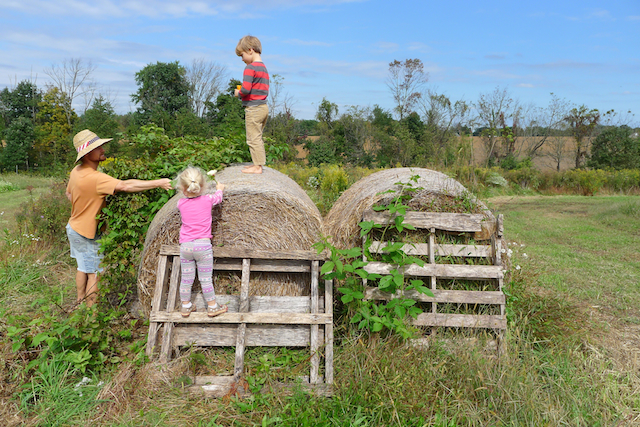
Just an unusually sunny day.
We enjoyed a productive past week on the farm. Prior to yet another rain event that begat the new fall-like feel temperature immersion we busied ourselves harvesting a few tons of sweet potatoes and half a ton or so of carrots with the help of CSA members. Considering the year we've had the sweets remained optimistic in their growth and output, satisfying our hopeful expectations. Carrots, less fortunately, endured more moisture than they can tolerate in our soils plus raised-bed situation; we had to return quite a few back to the earth where they'll enrich the next crop in the spring. Overall we still managed to salvage the same approximate weight as our total harvest last fall because we ambitiously sowed more seed this season.
Besides the retrieval of storage roots we also put the final touches on the Field 3 waterway and three water diversions therein. The dozer work complete, we had to sow tall fescue, rye grass, and oats then mulch 10,000 square feet of soil prior to Thursday's rain.
We also removed from the field all of the materials needed to grow eggplant, husk cherries, and tomatillos, plowed the soil, sowed a new (for us) cover crop mix of wheat, hairy vetch, and crimson clover, and incorporated the seeds into the soil with our disc harrow. That was probably our final opportunity to establish a cover crop prior to the winter.
On Friday commenced the indoor plantings for late fall and winter harvests. Crops going into our four tunnels will be harvested in December and January. Directly into the earth went the final sowing of greens which will be covered by our movable high tunnel after we finish dismantling the heirloom tomatoes. In addition to that, also on the agenda for this week is collecting additional storage roots including beets, purple and white daikons, and kohlrabi; erecting low hoops and covering crops prior to frost (!); cleaning up the hoop tunnel and preparing those beds to accept more late fall and winter greens; and constructing a waterway in Field 1.
Bon Voyage!

October 6, 2018
Into The Mistic
by Farmer Derek
Into The Mistic
by Farmer Derek
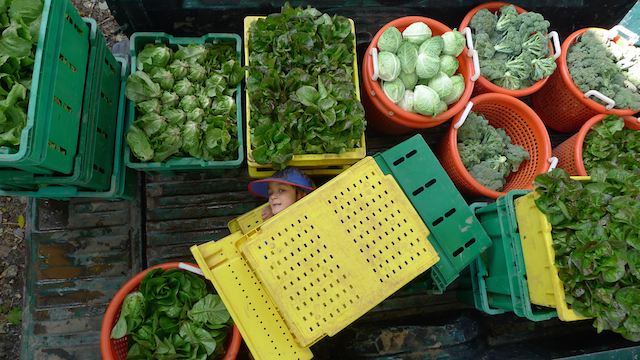
A portion of Thursday's harvest.
The final 6 weeks of the Main Season CSA are here. Twenty harvest weeks, about four-and-a-half months, have gone by. We've persevered through all types of weather but mostly a lot of rain (record breaking). We've had a few heat waves and some weeks of dry soil when we actually had to irrigate (what?). We've endured days and weeks of gray misty weather. Harvests have been good and fairly consistent but nothing has been epic. Some crops didn't perform as well as we would have liked but that can mostly be blamed on the excessive rainfall. Tomatoes produced well and over a long period and onions and leeks have performed well. The summer carrot harvest was big and we probably distributed them for longer than we ever have. Fall carrots should arrive later this month.
We're now focused on harvesting the remainder of fall storage crops like sweet potatoes, carrots, watermelon radishes, daikons, rutabaga, kohlrabi, and beets. We also turn our sights indoors as we prepare for and transplant and direct seed crops into our 4 tunnels for fall and winter growing. We have one more window of opportunity to sow cover crops before the next rain event; after that they won't grow enough to protect the soil over the winter. Last week with the help of multiple workshifts we put a serious dent in weed pressure but of course that will stay on our radar.
Broccoli has slowly started to mature and we're hopeful that it will increase in volume so that everyone gets a taste. Cauliflower should mature soon and with luck will be bountiful. Regular cabbages appear to be slightly stunted from the moisture but napa cabbage seems to be thriving and sizing up nicely. Chicories like endive, escarole, and dandelion as well as fall lettuces have tolerated the fall weather miraculously. We're anticipating an increase in greens for the last six weeks of harvest as well as a continuous assemblage of miscellaneous fun fall roots. Potatoes and sweet potatoes should round out shares (sweet potatoes need to cure for two more weeks and will be distributed starting with week 23).
We hope you enjoy your CSA shares!

September 30, 2018
The Return of the Sun King
By Derek McGeehan
The Return of the Sun King
By Derek McGeehan
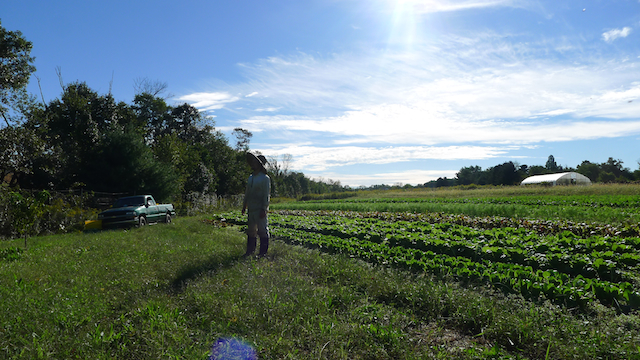
The first sunny harvest morning in weeks was a welcome relief but also a reminder of the hustle needed when harvesting lettuces, herbs, and greens.
We're welcoming October with open arms and smiling faces (and sunglasses) as a forecast of crisp cool sunshine beautiful weather descends and hopefully stays in place for weeks and weeks. September was a rough month for sure and we're happy to turn this page of the calendar. With the new month we're anticipating the harvest of some traditional early fall crops like broccoli, cabbage, and hakurei turnips. We're thankful to harvest any broccoli and cabbage at all and overall I'm sure the quantity and quality won't match the past few seasons but at least there should be some to whet our brassica appetite. In their footsteps over the next month should be cauliflower, watermelon radishes, and daikons.
Now that the ground is drying out and the sun is shining once again we can resume our normal weed control schedule and pull out all those freeloaders out there that thought they could grow unchallenged while they attempt to out-compete their more sensitive brethren, the crops we want to eat. We're thinking this week will be a turning point in the season when we can begin to feel a positive connection with the fields once again. We're looking forward to harvesting sweet potatoes and being pleasantly surprised by a good yield. We're predicting a renaissance of greens in the coming weeks as they soak up the sun and are able to consume the soil's nutrients without drowning. Spinach will grace us in two weeks time with an abundance of healthy dark green leaves. The first frost won't occur until November and the first freeze not until December. The first deep freeze won't happen until January. In the meantime we'll have an awesome fall season with bountiful harvests. Cheers!

September 30, 2018
Late Fall, Winter, and 2019 Main Season
by Farmer Dana
Late Fall, Winter, and 2019 Main Season
by Farmer Dana
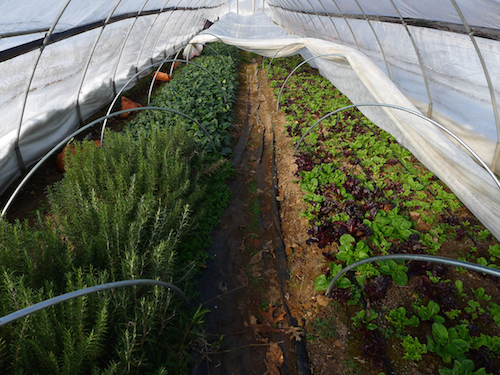
Rosemary, spinach, and lettuce mix, January 11th, 2018 in the hoop house. That's snow piled up outside along the sides. Inside, crops are thriving.
Announcing open registration for Anchor Run's 2018 Late Fall CSA, 2018-2019 Winter CSA, and 2019 Main Season CSA!
Members can now sign up for three separate seasons through the members page on our website.
Scroll down for additional information for each season. E-mail us (anchorruncsa@gmail.com) if you have any questions.
2018 Late Fall CSA
- Full, Medium, and Half Shares are available for the 7th annual 6-week season.
- Prices remain the same as last season: $180 for Full; $130 for Medium; $100 for Half.
- A deposit of $50 or full payment secures your share; full payment is due by November 15th.
- A cold hardy fall themed continuation of the Main Season share with tasty staples like lettuce, spinach, radicchio, arugula, mizuna, tatsoi, bok choy, kale, collards, chard, cabbage, Napa cabbage, cilantro, dill, parsley, leeks, garlic, onions, beets, radishes, turnips, carrots, celeriac, kohlrabi, rutabaga, potatoes, and sweet potatoes. No u-pick crops.
- A Full Share receives approximately 8-12 pounds of produce weekly, a Half Share every other week, and a Medium Share receives 2/3 of a Full Share weekly.
- To join, log in to the website here; the 'join' button will be on the left hand side of your members page.
- Total membership is approximately 50% of the Main Season and is filled on a first come first served basis so don't delay!
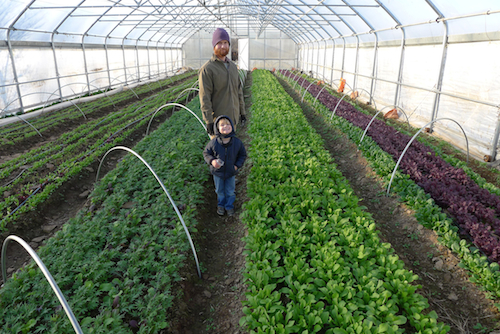
Farmer Derek and farm intern Gabe inside the movable high tunnel in mid-December 2017. Fall and winter greens are looking good!
- Pick up days are: Wednesday 1-8pm or Saturday 11am-12noon (you choose a day but you can switch temporarily by notifying us in advance).
- Begins immediately following conclusion of 2018 Main Season CSA Harvest Week #26.
- Late Fall Harvest #1 (Week A) is scheduled for week of November 19th*.
- *During the week of Thanksgiving, Late Fall Harvest Week #1 (Week A), Wednesday's pick up is on Tuesday, November 20th to accommodate the many travelers and holiday schedules.
- Concludes week of December 24th**.
- **During the week of Christmas, Late Fall Harvest Week #6 (Week B), Wednesday's pick up is on Thursday, December 27th, due to holiday traveling.
- No workshift discount/commitment.
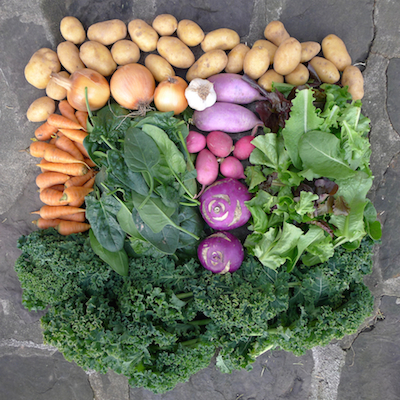
Late Fall CSA share #6, December 18th, 2017.
2018-2019 Winter CSA
- Full, Medium, and Half Shares are available for the 4th annual 6-week season (shorter season than last year due to farmers needing a break before 2019 Main Season work commences at the end of February. Also a need for an off-farm vacation.).
- Prices are the same as Late Fall: $180 for Full; $130 for Medium; $100 for Half.
- A deposit of $50 or full payment secures your share; full payment is due by December 31st.
- A cold hardy winter themed continuation of the Late Fall share with tasty staples like lettuce, spinach, radicchio, arugula, mizuna, tatsoi, bok choy, kale, collards, chard, cabbage, Napa cabbage, cilantro, dill, parsley, leeks, garlic, onions, beets, radishes, turnips, carrots, celeriac, kohlrabi, rutabaga, potatoes, and sweet potatoes. No u-pick crops.
- A Full Share receives approximately 8-12 pounds of produce weekly, a Half Share every other week, and a Medium Share receives 2/3 of a Full Share weekly.
- To join, log in to the website here; the 'join' button will be on the left hand side of your members page.
- Total membership is approximately 30% of the Main Season and is filled on a first come first served basis so don't delay!
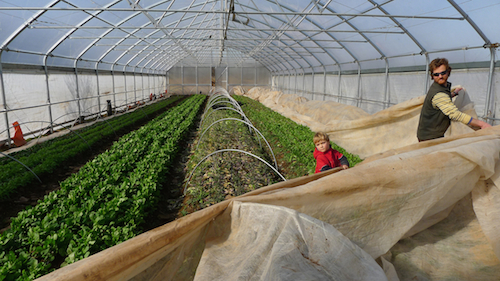
Uncovering movable high tunnel greens in late January during a winter warm spell. Uncovering and recovering happens quite frequently during the cold months.
- Pick up days are: Wednesday 1-8pm or Saturday 11am-12noon (you choose a day but you can switch temporarily by notifying us in advance).
- Begins immediately following conclusion of Late Fall CSA Harvest Week #6.
- Winter Harvest #1 (Week A) is scheduled for week of December 31st.
- Concludes week of February 4th.
- No workshift discount/commitment.
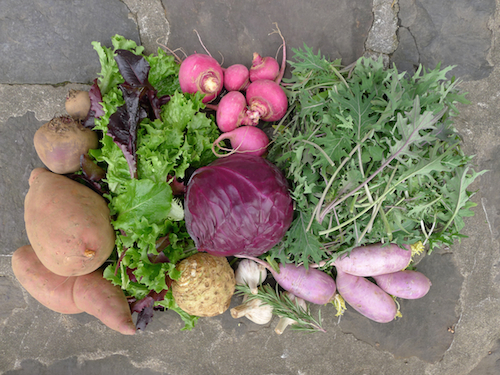
Winter CSA share #5 in late January 2018.
2019 Main Season CSA
- Full, Medium, and Half Shares are available for the 16th annual 26-week season.
- Prices remain the same as last season: $920/$800 for Full; $675/$585 for Medium; $490/430 for Half.
- A deposit of $200 or full payment secures your share; full payment is due by May 1st.
- Pick up days are the same as always: Monday 1-8pm, Thursday 1-8pm, or Saturday 10am-12noon (you choose a day but you can switch temporarily by notifying us in advance).
- Typically begins in mid-May and ends in mid-November.
- Work discount options are available for each share size. 8 hours for Full, 6 for Medium, and 4 for Half.

September 23, 2018
Just Another Challenge
by Farmer Derek
Just Another Challenge
by Farmer Derek
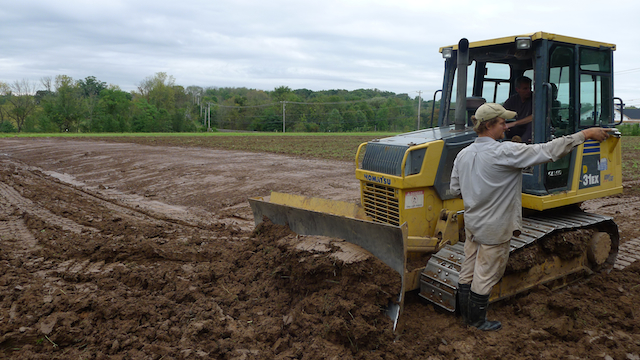
Conferring with our excavator who's putting some finishing touches on a diversion after installing a thousand feet of waterway in a troublesome field on a misty, soggy Sunday afternoon.
A new astronomical season, a new week, another flash flood, incoming additional rainfall and a lack of sunshine. So comes it, so goes it. One of these days, weeks, seasons the weather I'm sure will be more agreeable to growing organic crops. For now all we can do is our best work physically while mentally working through these challenges and occasionally accepting defeat and understanding factors that are currently beyond our control. The only way I can think of to temper the floods is by increasing the number of tunnels we have on the farm so we can grow more crops inside. Other than that, we're already underway working on water management by creating swales and berms to funnel the water away from susceptible areas to where we want it to go. Nothing solves the entire problem but all options for weathering the weather need to be addressed. The only thing worse that overly wet weather is cold wet weather and cold wet soil. And into autumn we go.
There is still much to appreciate and be thankful for and I'm trying my best to focus on whatever those things might be. This isn't the first exceptionally difficult and wet year we've endured and I'm sure it won't be our last. The best we can do is learn from it and adapt. Is it a changing climate and a harbinger of future conditions? Is it a cyclical anomaly? All the above, none of the above, whatever, we'll try to figure it out. Like I said some other time before, in 30 years we'll be perfect farmers and this will be a perfect farm. Just in time for someone else to take the reins (or the rains).
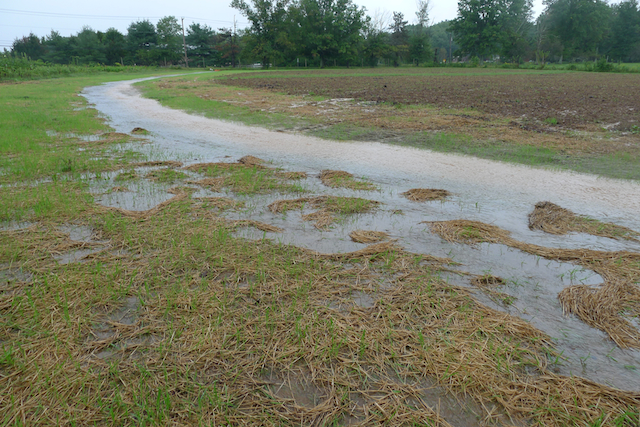
Completed waterway in Field 2 was up to the challenge of 3" of rain and another flash flood.

September 16, 2018
Spinach as a Benchmark
by Farmer Derek
Spinach as a Benchmark
by Farmer Derek
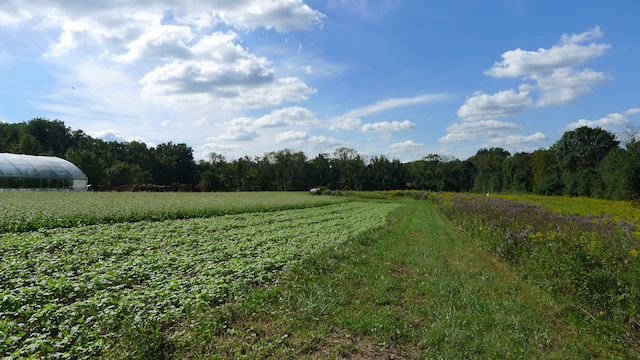
A welcomed Sunday sun scene. Two batches of a summer sown cover crop mix of buckwheat, oats, crimson clover, and daikon radish on the left and our perennial pollinator habitat on the right.
Some very good sunshine today thankfully exceptionally give us more please! Exuberant joy!
And a week ago we were on the heels of a heat wave, tired of the sun, and needing a bit of rain. A tale of two contrasts is the story of the season, or a tale of extreme weather, or just a tale of having to think too much about the weather and plan the workload each week in minute detail to get dry-ground-required jobs finished just prior to the next wet weather event. Okay so it could have definitely have been worse. Overall harvests have remained ample but because the whole season has been on the wet side our standard has probably changed. Just the other day I had a brief glimpse into a forgotten mindset from past seasons when moderate and adequate and evenly spaced rainfall allowed every single crop to reach its full potential graciously, gloriously. Now I realize that that is probably not an accurate memory but perhaps a wish.
Realistically there are conditions that crops on our farm thrive the most in. Probably excess rainfall has the most deleterious effect on crops. Most of our bare ground fields would be happiest with a 1/4" of rain a week. It was such a wonderful experience a few weeks ago when the ground began to dry out; the crops seemed to shine (I was probably projecting). Of course after the 2.5 weeks of dry weather with two heat waves intermingled they did get thirsty and asked for irrigation (we complied). But there really were times other seasons where the tops of the beds would dry out, surfaces of plants would dry out to help minimize disease, and in the organic matter rich healthy soil below there would be enough moisture to keep plants thriving on our ubiquitous north facing slopes. Those were the days.
Spinach, the most sensitive crop we grow and a benchmark of the weather, has had a tough time of it this season. Ten years ago we tried direct seeding spinach on the farm. It's not as fast and reliable as a brassica green like arugula so we switched to transplanting it a couple of years later in the spring. We harvested a good amount for a week or so that spring way back in 2013 I think. Two or three of the plantings then got upset about moisture and were unharvestable. We thought "why waste time, space, resources on a crop that is so difficult to grow?" So we took a break for a couple of years while enjoying some good weather seasons and then decided to give it a go again. For the past 3 years have been transplanting it and mostly have had more harvest success. This spring was the first time in a long while where 2 of the 3 plantings got sick and weren't harvestable. For our fall sowings we germinate in our artificially cooled crop storage room (55-60 degrees) then transplant out after 4-5 weeks of growing on in our hoop house. The last seven days of rain/mist/moist weather spinach does not like. Perhaps it will pull through for an October/November harvest. Today's sunshine has me hopeful. We have one more planting to make outside, then 3-4 plantings inside our tunnels where plants seem to do much better because of the climate and moisture control.

September 9, 2018
Can We Ignore The Weather?
by Farmer Derek
Can We Ignore The Weather?
by Farmer Derek
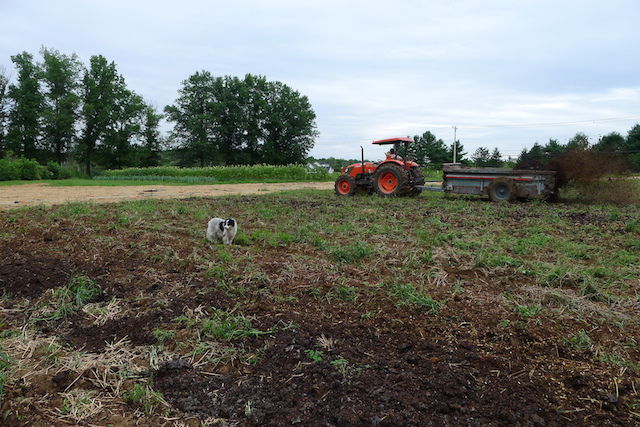
Spreading compost on a fallow field.
Last week on the farm...
The stifling heat and super dry conditions forced us to set up and irrigate all of the crops except for sweet potatoes which seem to be unbothered by anything. All the crops received two doses of water to give us the satisfaction that at least we used the drip tape enough to make the extra work worthwhile. The crops definitely needed a serious drink amid soaring temperatures after missed rainfall last weekend and perked right up after 6-8 total hours of trickle irrigation. That was the driest the farm has been all season.
The NRCS/USDA water management project commenced last week as well. A project 3 years in the making, it's great that it is finally beginning. Grassed waterways will be created in the most problematic areas to collect runoff, minimize erosion, and send the water hopefully where we want it to go. Significant quantities of soil need to be moved around. The waterways are 20-30' wide, 6-12" deep, and over a 1000' long. After the bulldozer does its job we sow appropriate seeds, roll out erosion control blankets, and add straw to hold moisture and protect the seeds. Two out of 4 areas have been completed.
Additional crops were transplanted and direct seeded including arugula, greens mix, hakurei turnips, scarlet queen turnips, broccoli raab, lettuce mix, mini lettuce, spinach, chard, curly kale, collards, and russian kale. Beds were reshaped to kill any germinating weeds prior to planting.
Compost was spread over a 1.5 acre fallow field. Half a day was spent trying to fix the ancient compost spreader that broke 3 or 4 times and prevented me from having time to sow an oat and clover cover crop prior to Friday night's rain and forced me to finish the task by working all day Saturday.
Crop maintenance was a big part of the workload last week including weeding in row and mowing walking aisles.
Half days were given to the crew on the hottest days.
Since we can't ignore the weather on the farm we'll endure what we're given this week and adapt to the conditions. Will this week be bookended by moisture from two tropical storms? Yippee.
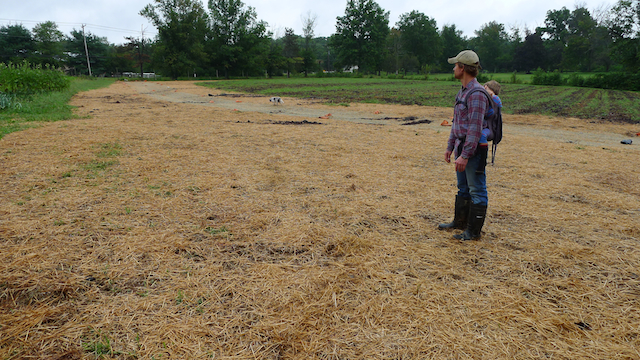
Field 2 waterway completed.

September 2, 2018
Sometimes It's Hard
by Farmer Derek
Sometimes It's Hard
by Farmer Derek
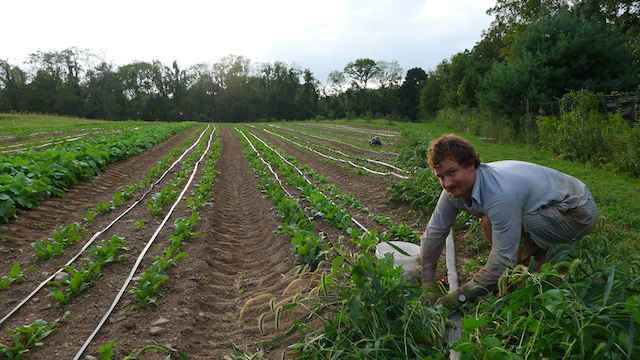
Somewhat reluctantly spent a good portion of Sunday installing irrigation infrastructure after all of the forecast rain missed us.
Well, I was definitely counting on and anticipating a healthy dose of rainfall this past Friday. Ninety percent chance of up to an inch had me convinced it was coming. Alas, it amounted to nothing and now I must contemplate setting up irrigation systems across the farm or await the next incoming round of wet weather. Perhaps we'll get lucky Sunday when there's another slight chance of rain; otherwise it looks like we'll have to wait until next weekend. It does feel strange to be discussing water and rain this way, wanting it, when for much of this season it's been the opposite. That probably adds some frustration (obviously). Sometimes it's nice to give oneself over to the controls of the weather. When it rains we're cared for and it removes some need for decision making because obviously in our climate we receive fairly regular rainfall as opposed to parts of the dry west where they simply know it won't rain so why not just always have irrigation at hand and set up. Thus we either wait for and depend on rainfall or we adjust and run the drip tape and set up the headers and/or set up the sprinklers. Please give us the appropriate amount of rain for once this season.
Last week we endured quite a heat wave for this time of year, especially on the heals of very cool and mild weather last weekend. The fields dried out so we were able to cultivate where needed, including with hand tools and with the tractor, as well as harvest the last of the potatoes and all of the butternut squash. We transplanted more fall crops including napa/chinese cabbage, kohlrabi, lettuce, radicchio, endive, escarole, dill, cilantro, and parsley. We cleaned up fields and sowed additional cover crops and also spread some compost on resting fields. It was a productive week.

August 26, 2018
Driest Since...
by Farmer Derek
Driest Since...
by Farmer Derek

Camping and hiking at Rickett's Glen State Park this past weekend.
It's a strange feeling to not have to rush around completing certain parts of our to-do list prior to an impending rain event. Having a few days or even a week to complete jobs, get ahead, get caught up, and mildly enjoy the pace of production has been a rare luxury during this very wet season. Even sneaky thoughts of intentionally adding water to the fields now try to enter my brain. Phrases like "wow that soil looks dry" or "those crops look thirsty" pass between my ears and mock my prior too-much-water frustrations. Attempts to dissolve and dissipate these thoughts using farmworkmindfulness are invoked. Steady, I instead encourage the crops to be patient: you must send those roots down to find your own moisture. It will rain again, probably too much. Also, if we hadn't already received 2 months worth of rain in the first half of August maybe I would listen to your requests and/or complaints. You can do it I promise.
All seems to remain well. Shares of the harvest stay ample. Potatoes are now 66% harvested thanks to the 20 or so members who came out to help today. Butternut will hopefully be retrieved and stowed this week. Progress is even starting to be made towards our NRCS funded water management upgrades. Cover crops are thriving and taking care of the soil. Additional fall roots and greens like watermelon radishes, white and purple daikons, arugula, mustard mix, and baby kale have been direct seeded and are up and growing. Many man hours last week were spent weeding and cultivating fall carrots and rutabaga and they look great. Fall brassicas like cabbage, brussels sprouts, broccoli, and cauliflower were cleaned up again and probably appreciate this dry weather. Now we need to look closely at them to see if they require an additional dose of food (i.e. organic fertilizer) after all the drenching rain we received during their outdoor life which may have washed away nutrients as well as stunted their root growth. Veggie life goes on.

August 19, 2018
Weather Respite
by Farmer Derek
Weather Respite
by Farmer Derek
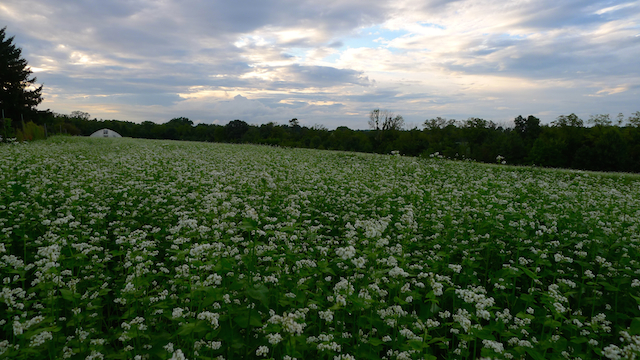
Flowering buckwheat is seen all over the farm right now providing nectar to pollinators.
Amidst what will probably be our second wettest season in 10 years we're remaining afloat and overall are satisfied with and thankful for this year's harvest so far. Undoubtedly there have been a few crops that were negatively impacted by the wet weather. Most noticeably the cherry and grape tomatoes never fully reach production potential and were stunted and challenged from the beginning while they endured our wettest May in 10 years. We also lost the spinach in the spring due to the weather but other than those two crops we've been lucky with the harvest.
We've also been extremely fortunate that the ground has continually dried out just enough between rain events that we've been able to do the minimally required work to keep plants alive (cultivate and weed) and to build homes for future crops (raised beds). For cultivating to be effective the ground has to be dry otherwise the weeds can easily re-root, especially when we can't cultivate in a timely manner because of the perpetually wet soil and the weeds grow sets of true-leaves beyond the initial cotyledon stage. Our fall brassica patch has been particularly troublesome and unfortunately is located in what is probably the wettest part of the farm. During dry seasons crops thrive in these soils; during wet years they struggle. So far the cabbage, broccoli, cauliflower, and brussels sprouts are surviving and growing but would definitely appreciate some drier weather with only minimal weekly rainfall (quarter-inch please).
Besides simply being a huge crop planting, the brassicas are plagued by grass, a terribly persistent weed that's hard to defeat especially when it's been allowed to grow for a week beyond the ideal cultivation period. We were desperately close to losing the battle at first cultivation. It wasn't an ideal time because the ground remained slightly wetter than suitable for cultivating, but with forecast rain the following day, we only had a small window of opportunity to try to kill the weeds. Our employees muscled through the manual cultivation and saved the brassicas. A week or so later, with the smallest of dry weather opportunities also followed by forecast rain, we cultivated them again (this time a whole day's worth of work). We also added in some tractor cultivation for the tops of the beds between the rows of plants. Between and immediately around the plants cultivating still had to be done manually with stirrup hoes, though. The forecasted rain didn't materialize immediately after cultivation so the couple more days of dry weather allowed further desiccation of the weeds and grasses. After this second round of cultivation the crops' canopy seems to be tall and wide enough to out-compete the weeds. We may have to hand weed in row eventually, but for now our focus shifts to saving the fall and winter carrots and rutabaga. Also, for the brassicas at least, we must hope that perpetually wet feet won't undermine our efforts. The forecast does look like it's changing for the better. Here we are.

August 12, 2018
Middle of Main
By Derek McGeehan
Middle of Main
By Derek McGeehan
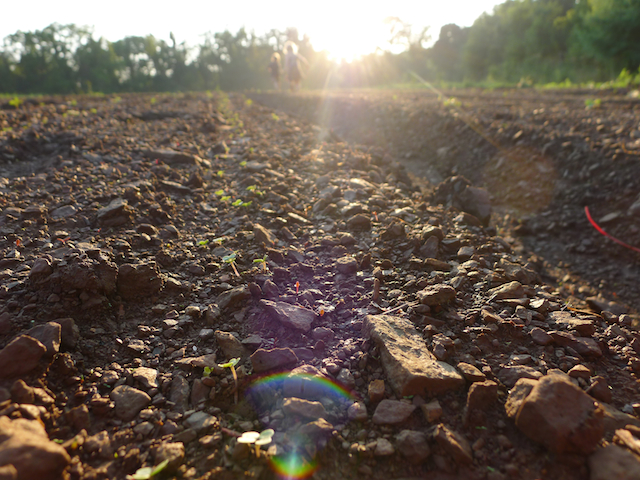
Sun setting over freshly germinated rutabaga.
Harvest weeks 13 and 14 represent the mid-point of our 26-week Main Season CSA and also come at a time of subtle changes in the season, daylight, weed growth, plant health, crop harvests, farm workload, and farmer mental and physical stamina. Seasonally summer is on the downward trend and with it daylight noticeably slowly decreases. Weed pressure begins to slacken as most weed species will germinate less as that magical combination of soil temperature and daylight combine into an unknown sum that is less appealing all of a sudden. Perhaps they know that they probably won't have time to procreate and pass along genes and will simply wait until next year. Traditional summer crops like basil, zucchini, cucumbers, watermelon, cantaloupe, and field tomatoes begin showing serious symptoms of disease and decline. We have multiple plantings of most of these but even later younger plantings get sick quickly. Tomatoes will be safe in our tunnels through September probably. Harvests will begin to transition away from some of the summer staples as we welcome winter squash, potatoes, and greens again later this month. The pendulum of the farm workload is in full swing in the other direction as we clean up fields and sow them into cover crops to add organic matter, increase soil fertility, consume leftover nutrients, and protect the earth over the fall and winter months. Look for fields of a flowering buckwheat overstory and radish and clover understory. Our farmer brains and bodies get a little more sluggish in August as the past 5 months catch up to us. As September approaches and temperatures moderate we'll be rejuvenated as we push through to the end of the growing season, prepare for fall and winter harvests, and reflect and plan for the next growing season. For now, we accept the highs and lows of this growing season and are thankful that even though we've had extreme weather the harvests have been ample and we've been able to share it all with our food community.

August 5, 2018
Holy Moly, a Ton of Tomatoes
By Derek McGeehan
Holy Moly, a Ton of Tomatoes
By Derek McGeehan
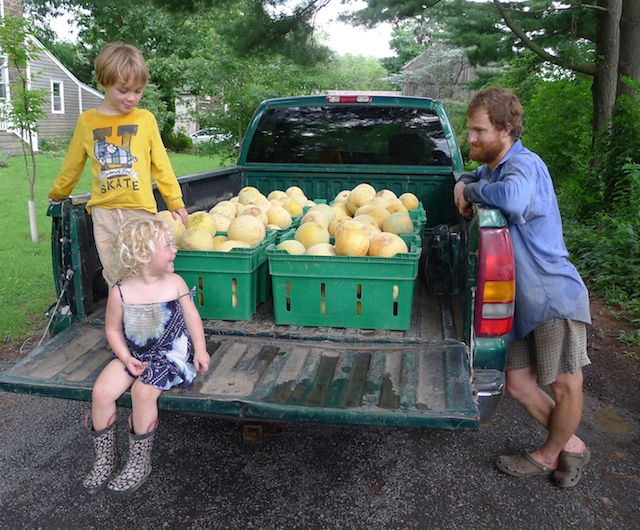
The 2018 cantaloupe harvest commenced on Friday.
The fields are giving us so much produce right now we're running out of storage containers and storage space! But that is a good problem to have, right? I think so. It does add a bit of stress to our days until we can safely stow all of the goodies, but we're slowly doing so. The big event this weekend was the unexpected cantaloupe haul. They seemed to ripen all at once. Friday we went out mid-day to gather what was ripe, initially thinking we're retrieve a bin or two. Ten full bins later we were satisfied we should wait two more days for more to ripen. Two more days later and 80% of the total harvestable fruit is out of the field after 3 hours of hot Sunday work (another 15 bins or so). Two more days from now we'll check again and the patch will be clear and we can check that off the to-do list.
All of the onions are out of the field - thanks to everyone who helped with that task - and will be distributed starting this week. The second planting of watermelon beckons us now and we'll focus on that tomorrow and/or Tuesday. Our "watermelon room" is half full with onions and cantaloupe but we'll make sure we get them in there as well. Potatoes will be started whenever we have sufficient bin and storage space so either later this week or next week. It's still early for them so we're not (too) worried. Hopefully there will be some dry weather to enable an easier time harvesting.
Tomatoes seem to be peaking right now. Last Thursday alone we harvest about 500 pounds of heirlooms from the high tunnel and 500 pounds from the field. Add that to Monday's haul and it's a ton of tomatoes. Fortunately our 2nd planting hasn't kicked in yet; hopefully that'll get going when the 1st one starts to wind down. We hope you are enjoying this mid-summer bounty!
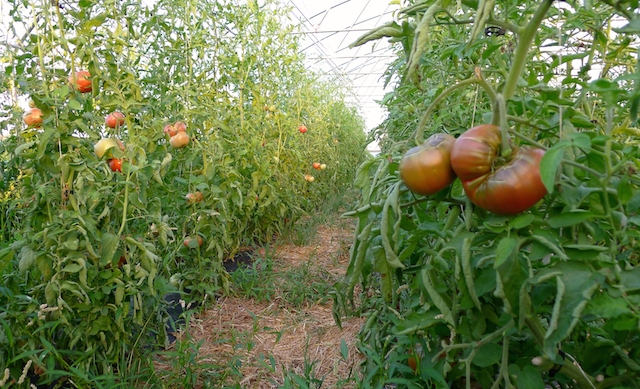
Heirloom tomatoes growing in the movable high tunnel.

July 29, 2018
Off and On Monsoon
By Derek McGeehan
Off and On Monsoon
By Derek McGeehan
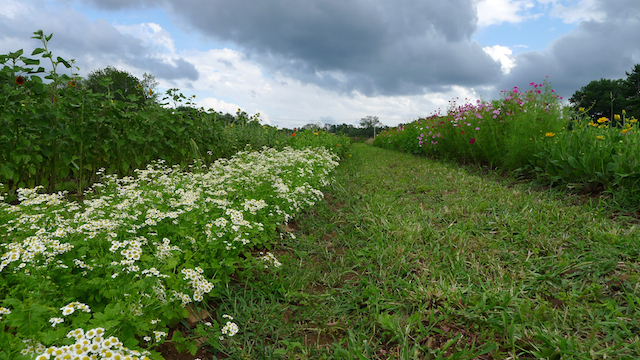
U-Pick flower patch on a stormy day.
It's safe to say it's been a difficult week on the farm though it could have been worse. We only received 4-5" of rain whereas locations in Central PA received 12-16". We're definitely super thankful for the sunshine the past couple of days as well as for Friday's rainfall missing us. We are lucky that the soil has dried out just enough for weed-killing tillage and bed-shaping which will allow us to transplant beets, chard, kale, lettuce, dill, and cilantro and direct seed carrots and rutabaga this week and thus stay on our planting schedule. Tomorrow, Monday, with hopefully enough time to for subsequent drying, we'll manually cultivate the thousands of feet of broccoli and cauliflower (and wherever else we have time for after a morning of harvesting for pick up). Tuesday, hopefully before another inundation of moisture, we'll do all the planting and seeding we have to do for the week. After that it will be whatever crop maintenance and harvesting the weather will allow for.
So far we've harvested 40% of the onion patch and will plan to harvest the remainder over the next couple of weeks. We let them semi-cure in the field before we transfer them to cold storage. They'll be in shares very soon. Round 1 of watermelon has been safely stowed and is currently being distributed in shares; we're monitoring round 2 closely and will hopefully be able to harvest it before it succumbs to excess moisture and disease pressure. Same goes for the cantaloupe. The earliest variety of potatoes could be harvested whenever the ground dries out enough for us to use our tractor-pulled potato digger. Winter squashes are slowly beginning to mature but also are battling disease pressure. Beginning in mid-August we'll think about retrieving the early varieties.
Thank you for your support and understanding during this difficult and challenging weather season - it could end up being our wettest or 2nd wettest season in 10 years! So far it feels like shares haven't been negatively affected by the extreme weather and we'll hope for continued quality and quantity.

July 22, 2018
Dry to Wet
by Farmer Derek
Dry to Wet
by Farmer Derek
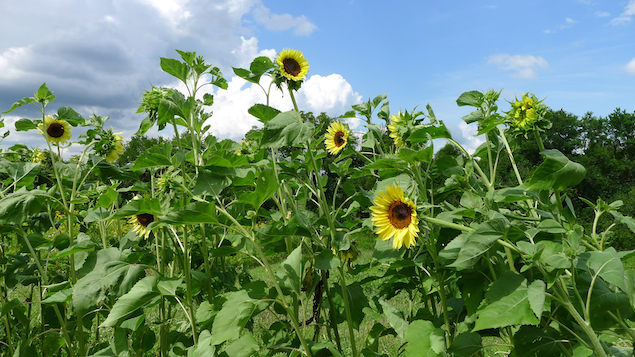
A little sun, a little flower.
Based on the forecast it appears we're in for a wet stretch of weather. Of course nothing is in moderation these days so we may receive rain each and everyday this week. Fortunately there's not much pressing field work that requires the tractor this week. However there is a lot of transplanting and direct seeding the following week so we'll hope for dry weather later this week and into next weekend.
This week we'll march on with lots of human power, hand-weeding many crops like leeks, new strawberries, celeriac, and scallions. We'll embark on the first round of harvesting watermelons and fresh onions. Watermelons will fill up an entire storage room and will be distributed, along with the 2nd planting, hopefully for the next 5-6 weeks. We grow 5 varieties of onions, 2 for eating fresh, 3 for curing and storing. Look for the fresh onions starting in a week or two.
This week we'll also continue crop maintenance by mowing, weed-whacking, pruning, and trellising. Spent crops will be cleaned up and prepared for sowing cover crops. We'll continue seeding in the greenhouse for future harvests. Weed-growth is at its collective seasonal peak so much of our focus right now is keeping them under control. Here we go.
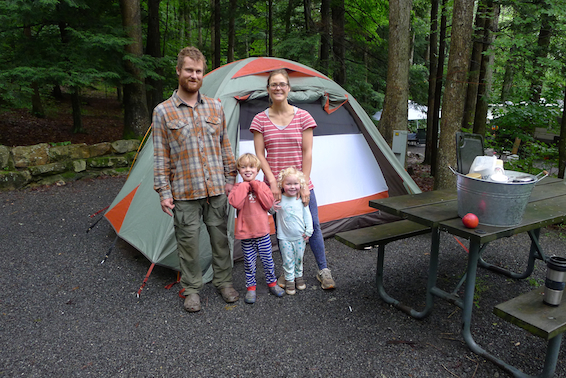
Long-weekend family camping trip to Greenwood Furnace State Park. To truly get a day off we must exit the farm. Bonus: no internet or cell phone reception.

July 15, 2018
Whew
by Farmer Derek
Whew
by Farmer Derek
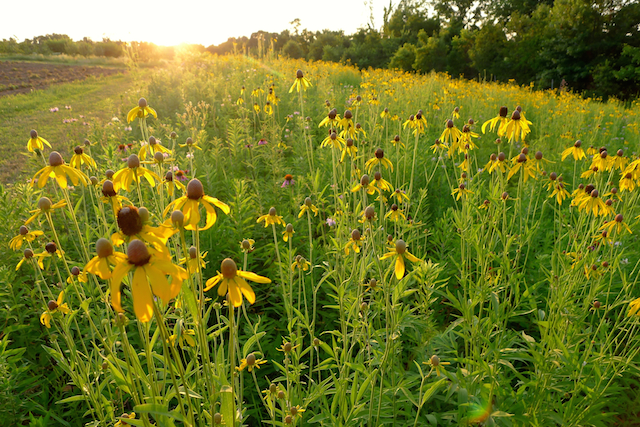
Gray-headed prairie coneflower pollinator habitat sunset.
Tired, relieved, thankful. Carrots and garlic are out of the soil and resting in the safety of the barn. Both will be in shares starting this week. Carrots look and taste great (in our humble acceptance of a variety of sizes and strange shapes). For a mid-summer carrot the ones I've sampled are definitely sweeter than I remember. Our farm crew probably spent about 40 cumulative hours retrieving these from the soil with the help of 4-5 workshifts; they're out and we're very happy about that. There was even enough time Friday afternoon and Saturday morning to chisel plow, sow a cover crop, and disc it in there plus where the peas, strawberries, spring greens, spring brassicas, and spring lettuces were.
Today's epic garlic harvest was also a major success. Around 45-50 CSA members came out over the course of 4 hours to help pull, clean, pile, retrieve, tie, prune, and hang around 12,000 garlic plants. Added to the already frantic nature of this immense task was imminent incoming rain which conveniently, thankfully, beneficially held off until the final truck load was driven back to the barn (amidst rumbles of thunder). We did end up having to move everything inside the barn into any and all available space to continue tying for hanging. Amazingly it all went smoothly and successfully and we even finished up 15 minutes early. I was truly exhausted after the 4 hours of hustling, very thirsty after forgoing water for 5 hours, thinking about breakfast at 12:30pm, and running low on the 1 mug of coffee I enjoyed around 7am. Completing this kind of job done with so many great members of our food community is one of the main reasons I love Community Supported Agriculture. Thank you folks!
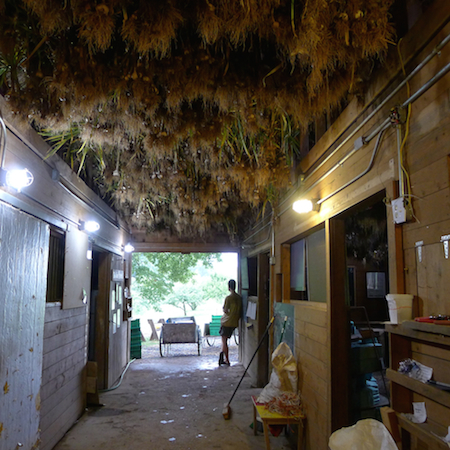
Job complete.

July 8, 2018
Big Harvest Time
by Farmer Derek
Big Harvest Time
by Farmer Derek
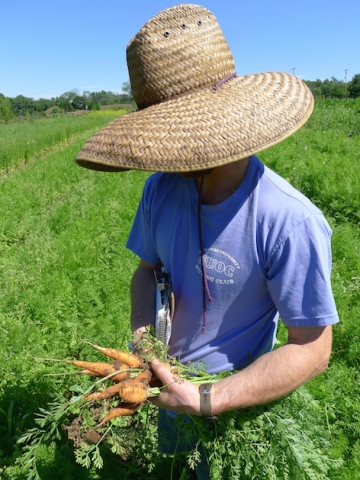
Carrot check
It's upon us, the time to harvest carrots and garlic. Carrots were direct seeded into cold and chickweed-threatened raised beds back in early April, went through multiple rounds of cultivating and weeding, and appear to have made it through our wettest-ever month of May. Raised beds and a slightly pitched field hopefully kept all of the carrots in perfect condition by draining most of the excess water away. We won't know the truth of this until we undercut the beds to loosen the soil and extract all of the roots, but our test tugs have revealed tasty orange carrots. Our goal this week will be to harvest the approximate 5000' row feet and begin distributing them next week. Dry soil allows for tractor-loosening the beds which makes this task 10-100 times easier and faster.
Garlic, garlic, garlic. Garlic is an amazing crop. Planted in November as a clove, it spends the winter under an inch of soil and several inches of straw, growing rapidly above and below ground April through June after the soil sufficiently warms to its liking. Anchor Run has saved and used its own garlic cloves as seed since 2004 and we now have our own unique varieties. This may or may not be fully true, though, since we basically are planting clove clones each year. They're not really mixing genes since they don't flower and there is no cross pollination followed by seeds. This is because we pull out and eat the scape, which would eventually turn into the flower. By removing the scape we're forcing the plant to redirect its energy into its bulb instead of for reproduction (so cruel). So, by saving cloves based on flavor, size, performance, etc, we are basically narrowing down to a variety that suits us best. At this point, though, we'd rather have a nice mix of varieties with a variety of flavor and size of bulbs, cloves, and let what we save and plant be random, up to chance.
We all enjoyed the green garlic in the early spring, then the scapes were a treat. Next we'll enjoy the fresh garlic from uncured bulbs straight out of the soil, followed by cured and shelf-stable bulbs through the remainder of the season. Around 300 pounds of the cured garlic will then be planted as seed this coming fall and the cycle will continue.
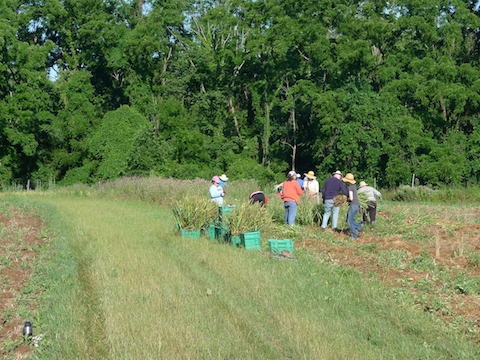
Pulling garlic in 2016.

July 1, 2018
Amidst A Heat Wave
By Derek McGeehan
Amidst A Heat Wave
By Derek McGeehan
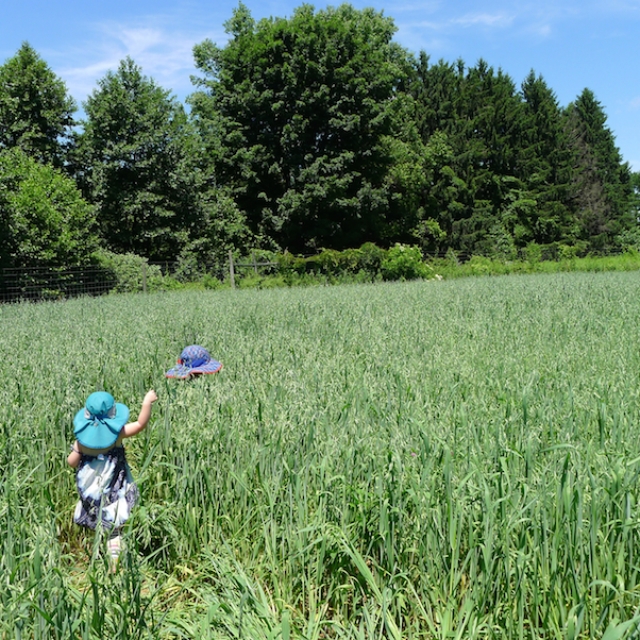
It's very hot but that's okay. It would be less okay if we hadn't received a generous dose of rain last Thursday. We'll still be irrigating this week, though, since the 3" that came down came fast and furious and probably mostly ran off, ran downhill. With the heat we're saying goodbye to peas and strawberries until next season but will be welcoming the start of cherry and grape tomatoes and will be opening raspberries for u-pick.
Last week we enjoyed wonderful weather for working outside. Next year's 7,000 strawberry plants were planted as well as more lettuces. Winter squash, cantaloupe, and the 2nd planting of watermelon was uncovered to give pollinators access to their flowers. High tunnel and field tomatoes were pruned and clipped to their trellis twine and wire, respectively. Sweet and hot peppers were buttressed with twine to prevent them from flopping. Cover crops of oats, peas, and sunflowers were mowed on fallow fields (see above photo).
We're now safely into the time of season when we can begin spring crop clean up. Crop residue will be mowed and turned into the soil to feed the succeeding cover crop as well as next year's harvestable crop. Irrigation, trellising, and weed suppression fabric will be removed. We were once at our maximum footprint, now we begin to reign it in, sort of mimicking reducing daylight after the summer solstice. We still have a few more months of planting fall and winter crops, though, and have much, much, much harvesting to do, but at least the bulk of the planting is behind us for this season.
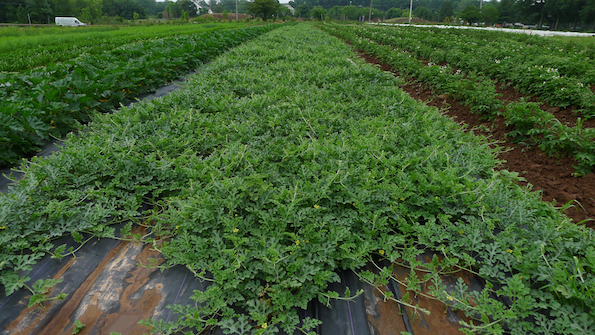
Uncovered zucchini and watermelon and hilled potatoes.

June 24, 2018
Summertime
by Farmer Derek
Summertime
by Farmer Derek
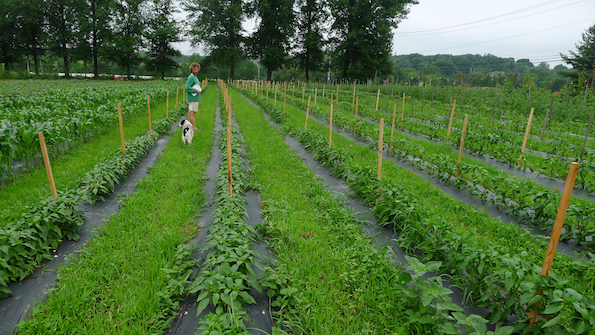
Pepper plants freshly staked and mowed thanks to farm staff.
Seasons changed this past week and along with the planet's relative location to the sun along its orbit our farm work begins to transition to more harvesting and crop maintenance and slightly less ground preparation for planting. This translates to a hopefully reduced amount of time I have to spend on the tractor. Harvests transition now as well, with the early summer crops of zucchini and cucumbers beginning to increase exponentially. Strawberries are unfortunately waning but in their place raspberries are coming in. Peas will end soon but beans are ripening and will be in shares for a couple of months if all goes as planned. Turnips, kohlrabi, radishes, endive, escarole, and romaine will exit shares until the fall. Chard, kale, and dandelion should be in shares to satisfy the need for cooking greens. Lettuces will be abundant for a while (our plan is for them to be available the entire season).
Last week was a busy time. With the continued lack of rain irrigation had to be set up and used. Around 5,000 leeks and 2,000 celeriac were planted, along with the 3rd installment of zucchini and cumbers, the 12th planting of lettuces, the 6th of scallions, dill, cilantro, and the 4th of basil and beans. Thousands of bed feet had to be finalized for all of those plants and another few thousand made ready for the 7,000 strawberry plants that are arriving this coming week.
Since we're now in summer it's worth briefly reflecting on spring's treatment of the farm. Overall I think harvests have been good and I'm thankful for that. Some crops suffered from our wettest May ever, such as spinach, which we lost 70% of, and radishes, which split and cracked. Early spring greens like arugula bolted prematurely, I'm assuming from the hot days we endured while the crops were covered to keep insects out. The 1st planting of beets was great, which came out of our movable high tunnel, but numbers 2 and 3 are a bit delayed and smaller than we would like. Peas and strawberries have been as good as we could ask for. We were very lucky the extremely wet weather didn't coincide with the strawberry season. Pea shoots didn't work out as well as I remembered them from years past; they weren't as tender as we would have liked. The turnips coming out of our hoop tunnel were more damaged than is ideal however the kohlrabi was great. Head lettuce, romaine lettuce, endive, escarole, and radicchio have been great. Kale met its potential but Swiss chard did not. We lost the 1st planting to leaf miner and plantings 2-4 were slow growing, perhaps also due to the excess moisture. They're now happier and will be harvested into the foreseeable future. Italian dandelion has been a reliable producer like always.
Ultimately we hope you've enjoyed the harvests thus far and are excited to eat the next phase of food coming out of our organically managed soils and farm with the help of our farm crew and members and support from our community.

June 17, 2018
Brief Heat Wave
By Derek McGeehan
Brief Heat Wave
By Derek McGeehan
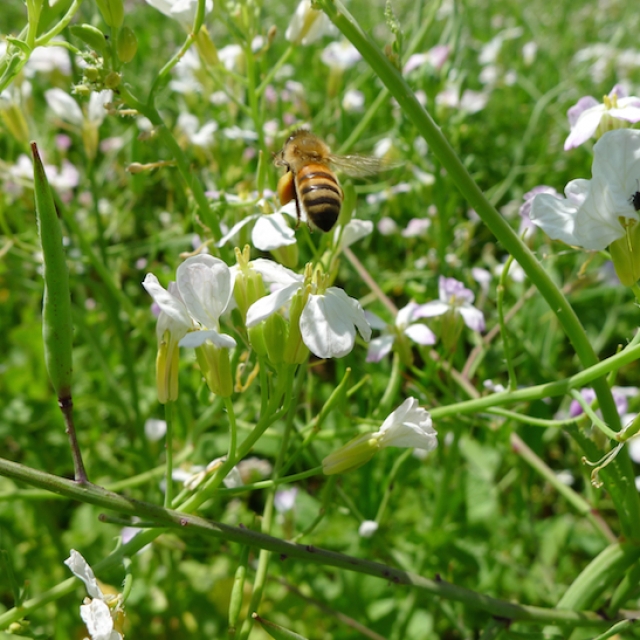
Honeybee on flowering greens (arugula, mustard, raab) that decided to flower before we were able to harvest all of them.
Predictably the pendulum swings the other way: sun, wind, heat, and dry conditions are here. Irrigation has been turned back on and needs to be double checked and fixed since it hasn't been used for more than a month. Summer officially commences this week according to some folks and daylight breaks around 5am now, waking me up on Father's Day, a Sunday, an 'off day'. I get out the door by 6am, hop on the tractor, and resume where I left off yesterday afternoon around 4pm chiseling (primary tillage) various fields that have been resting this season until now. Before chiseling, compost was spread for about 6 hours yesterday, invigorating fields that will accept our fall crops like broccoli, cauliflower, leeks, and celeriac. Prior to adding compost cover crops were mowed.
The ground hasn't been this dry since...October? So, we are already thinking/always thinking months ahead because ground can't just be made ready overnight, unless maybe one uses a rototiller, but we don't because we like to make things harder for ourselves. Or, perhaps, we like to think that by not using one we're preserving the integrity of the soil and allowing our farm to be more 'sustainable' by improving soil chemistry, biology, and physical properties by using 'reduced tillage' techniques. We also like to prepare soil for planting into in stages to allow weeds to germinate then be killed by subsequent passes with the tractor. A typical ready bed is a month in the making.
Back to food: additional spring crops will be on their way out of shares after this week and early summer crops will trickle into the pick up room. Romaine, kale, escarole, radicchio, and endive will be absent until the fall. Celery, fennel, zucchini (green and yellow), and cucumbers should arrive this week. Cabbage, scallions, and outdoor beets should be ready next week. A few weeks later we'll welcome fresh garlic, tomatoes, peppers, and eggplant.
Thanks for growing with us.

June 10, 2018
At Least Last Week Was Beautiful
By Derek McGeehan
At Least Last Week Was Beautiful
By Derek McGeehan
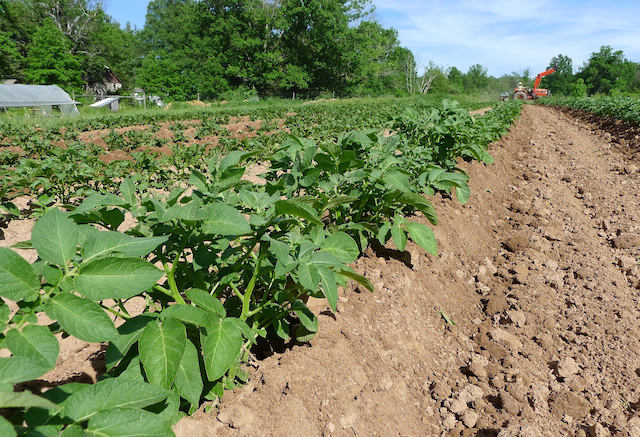
Dry soil and hilled potatoes.
The fourth week of the Main Season CSA is here. We're right in the middle of the strawberry and pea harvest, one of the best times of the eating year. Strawberries had perfect growing conditions last week and their taste today (before the rain) was simply incredible. With good weather the berries should last another couple of weeks. Peas should continue for another 2-4 weeks. We're harvesting the first planting, snow peas, with two more plantings of snap peas each spaced two weeks apart to hopefully spread out the harvest as much as possible. As peas taper off snap beans will come in so there'll be a smooth legume transition. Following strawberries will be: raspberries, blackberries, watermelon, and cantaloupe.
The fortunately gorgeous weather last week was perfect for crops and farmers. Crops grew quickly under seven days of sun. Tomato plants added a literal inch of growth daily. Farmers spent more than the average amount of weekly work hours getting caught up on tasks as well as proceeding with the typical weekly and seasonal jobs. We progressed through the first round of tomato trellising, pruning all plants to one or two leading vines, clipping each one either to a wire supported by 7' t-posts or twine suspended from wires. Two thousand out of three thousand sweet potato slips were planted (one thousand were lost by UPS but will be planted this coming week). Ten-thousand feet of potatoes were hilled twice which will provide more room for the potatoes to grow. Many crops were transplanted including lettuce, dill, cilantro, watermelon, sunflowers, yellow wax beans, and scallions. The entire onion patch was weeded with help from multiple workshifts. We're already thinking about fall even though summer isn't here: we seeded cabbage and Brussels sprouts. Next week we seed broccoli and cauliflower.
Thank you mama nature for giving us a good week for good work.
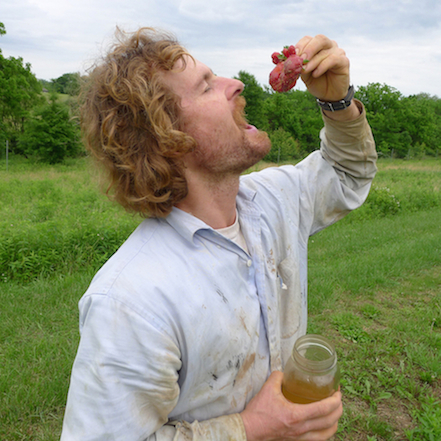
One of the largest strawberries I've ever seen had to be devoured immediately.

June 3, 2018
Onward
By Derek McGeehan
Onward
By Derek McGeehan
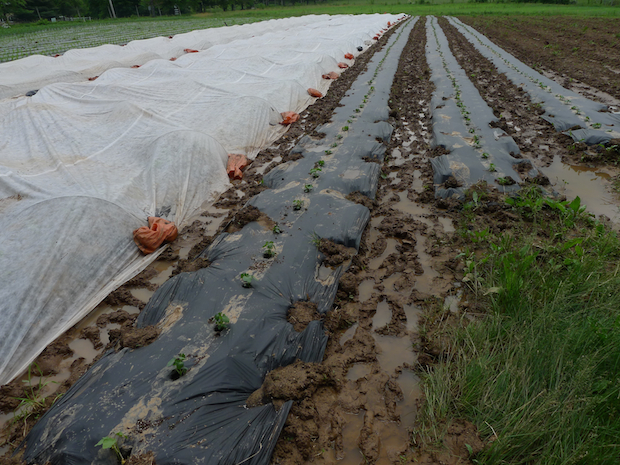
Soggy Field Two.
by Farmer Derek
A typical wet farm scene from the past few weeks is shown above. This is the summer nightshade patch including tomatoes, peppers, eggplant, okra, and sweet corn. We're righteously assuming the perpetually soggy ground will eventually dry out leaving happy plants in its wake. This field had been left fallow for almost 4 full seasons so we're anticipating robust growth and healthy crops. This field does seem to be subjected to a high water table so we'll see what does happen. Tomato plants that have been in the ground for almost 4 weeks are thriving fortunately.
We did manage to transplant a lot of crops this past week, pushing and pulling the transplanting wheels up and down thousands of feet of raised beds. We're so used to wet ground that we don't even think about using the tractor for this task anymore. Most of the time during the growing season we pull the water wheel transplanter with the tractor. It deposits water in holes made in the soil with 3 spiked-wheels that are fully adjustable based on row space needed for specific crops. In wet weather we pull it with human power, and skip the water addition part. It is a really good system and a really good work out.
Upcoming this week: trellis and prune tomatoes, transplant 3000 sweet potato slips plus other crops, cultivate, seed, weed, harvest, bed prep. Onward.
A typical wet farm scene from the past few weeks is shown above. This is the summer nightshade patch including tomatoes, peppers, eggplant, okra, and sweet corn. We're righteously assuming the perpetually soggy ground will eventually dry out leaving happy plants in its wake. This field had been left fallow for almost 4 full seasons so we're anticipating robust growth and healthy crops. This field does seem to be subjected to a high water table so we'll see what does happen. Tomato plants that have been in the ground for almost 4 weeks are thriving fortunately.
We did manage to transplant a lot of crops this past week, pushing and pulling the transplanting wheels up and down thousands of feet of raised beds. We're so used to wet ground that we don't even think about using the tractor for this task anymore. Most of the time during the growing season we pull the water wheel transplanter with the tractor. It deposits water in holes made in the soil with 3 spiked-wheels that are fully adjustable based on row space needed for specific crops. In wet weather we pull it with human power, and skip the water addition part. It is a really good system and a really good work out.
Upcoming this week: trellis and prune tomatoes, transplant 3000 sweet potato slips plus other crops, cultivate, seed, weed, harvest, bed prep. Onward.
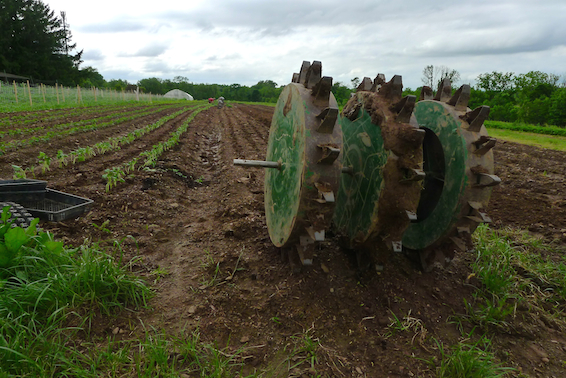
Transplanter spiked-wheels.

May 27, 2018
The Good, The Bad, and The (ugly) Rain
By Derek McGeehan
The Good, The Bad, and The (ugly) Rain
By Derek McGeehan
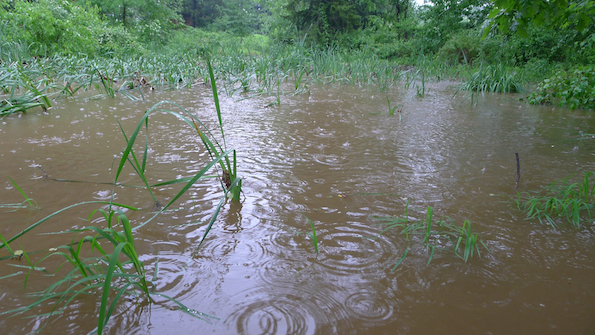
An overflowing pond unfortunately cloudy with sediment.
Another 3.75 inches of rain fell at the farm this morning bringing the total for the month up to almost 10 inches. In my memory this was the worst flash flooding event we've had on the farm since the summer of 2009, the last time I remember receiving 3+" in such a short timeframe. It's very much a good thing that I waited until after our field walk to work on the newsletter because I was rendered mentally exhausted, frustrated, sad, confused, forlorn, desperate, scared, and empty of spirit after battling the torrent spilling down the driveway with a rake, a hoe, and eventually the tractor amid the driving relentless rain.
The field walk revealed our worst fears weren't realized and erosion was luckily "minimal". No major new erosion channels were formed in any of the fields and no crops were washed away (that was taken care of in April when we had 2.5" of rain in a couple of hours). The field walk also nicely revealed healthy crops ready for harvest such as beets and kohlrabi, dill and cilantro which should be offered this week or next.
Most fortunately prior to this weather event the ground had dried out just enough to allow us to work the soil and make beds for many of the crops that desperately need to find an outside home. These crops include eggplant, okra, winter squash, lettuce, basil, summer squash, cucumbers, beans, and edamame, about 5,000 feet in total. The dry soil also gave us the chance to get caught up on cultivating. Considering the wet weather of the past two weeks we could be in a worse position. Hope you all made it through this most recent bad weather event!
The field walk revealed our worst fears weren't realized and erosion was luckily "minimal". No major new erosion channels were formed in any of the fields and no crops were washed away (that was taken care of in April when we had 2.5" of rain in a couple of hours). The field walk also nicely revealed healthy crops ready for harvest such as beets and kohlrabi, dill and cilantro which should be offered this week or next.
Most fortunately prior to this weather event the ground had dried out just enough to allow us to work the soil and make beds for many of the crops that desperately need to find an outside home. These crops include eggplant, okra, winter squash, lettuce, basil, summer squash, cucumbers, beans, and edamame, about 5,000 feet in total. The dry soil also gave us the chance to get caught up on cultivating. Considering the wet weather of the past two weeks we could be in a worse position. Hope you all made it through this most recent bad weather event!

May 20, 2018
Out of the Rain and Into the Harvest
By Derek McGeehan
Out of the Rain and Into the Harvest
By Derek McGeehan
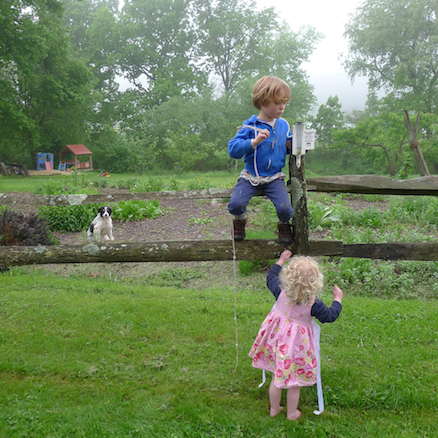
A lot of time was spent at the rain gauge this past week.
Hooray! Maybe the rain is finally over! Five inches were received last week, more than a typical month's worth. The crops - and farmers - will be happy to dry out a bit, hopefully with some sun and wind this week. Amazingly most of the crops seem to have tolerated the cool and moist weather and perpetually wet feet. Raised beds are a must these days. Amidst this auspicious time of harvest commencements we're not immune to extreme weather events though and there will most likely be some adverse effects that will reveal themselves. Certain crops are more sensitive to excess moisture than others, such as spinach.
Okay, enough with the weather - how about a 'hooray' for the start of the harvest season? This week officially begins the 2018 harvest season, the 15th season of Anchor Run CSA, our 10th here. We're excited to finally begin retrieving lots and lots of tasty spring crops from the fields. Specialties like green garlic, pea shoots, chives, radicchio compliment staples like kale, spinach, lettuce, radishes, and turnips. Some items are really bursting with growth and water and hopefully flavor.
Once the ground dries out just enough we have a busy week of cultivating, weeding, and transplanting crops such as basil, dill, cilantro, scallions, winter squash, sweet corn, eggplant, edamame, and lettuce. Last week we spent a lot of time push mowing, weed wacking, potting up, and weeding carrots. We worked outside when we could and inside when we had to. The farm's in good shape overall. See you soon!
Once the ground dries out just enough we have a busy week of cultivating, weeding, and transplanting crops such as basil, dill, cilantro, scallions, winter squash, sweet corn, eggplant, edamame, and lettuce. Last week we spent a lot of time push mowing, weed wacking, potting up, and weeding carrots. We worked outside when we could and inside when we had to. The farm's in good shape overall. See you soon!

May 13, 2018
Harvest Season Begins Week of 5/21/18
By Derek McGeehan
Harvest Season Begins Week of 5/21/18
By Derek McGeehan
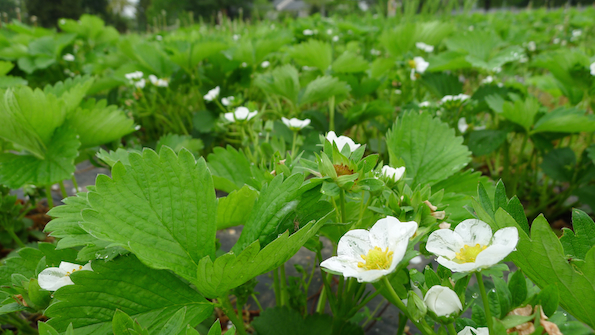
Strawberry plants are flowering!
Wow, we've been busy and time has flown by! It's now the middle of May, the harvest season is about to commence, tomatoes are in the ground, swallows have returned, eastern gray tree frogs are singing, forests and fields are green, and strawberries are flowering. It's been a month since our last official newsletter went out. It's difficult to spend enough time in front of a computer with all of the outside work we've had to do and a lack of rainy days hasn't forced us inside (until now). We've turned the corner away from frost and are now focused on planting traditional summer crops like squash, cucumbers, basil, melons, tomatillos, husk cherries, flowers, and tomatoes. Things are rolling along and we're right on schedule.
Most crops on the farm are looking healthy without any major surprises. Fortunately leaf miner damage seems to be minimal, almost absent. The ever-present springtime flea beetle, however, seems to have outsmarted our floating row cover in one field and is completely absent in another. The cool and previously dry weather hasn't stimulated too much weed growth though we've spent a lot of time cultivating to keep them from gaining any footholds.
We muscled through 3 or 4 days in the 90s, set up irrigation on the entire farm, and now of course are enjoying days and days of moisture and cool weather. It comes at a good time anyway. We're looking forward to seeing returning members and new faces on the farm, see you soon!
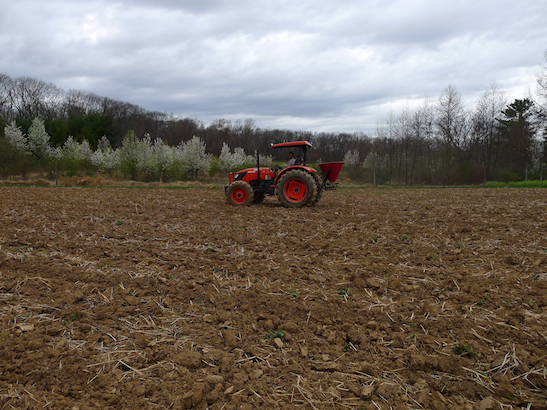
Sowing a cover crop mix of oats, peas, and sunflowers on a fallow field.

April 16, 2018
Early Spring Planting
By Derek McGeehan
Early Spring Planting
By Derek McGeehan
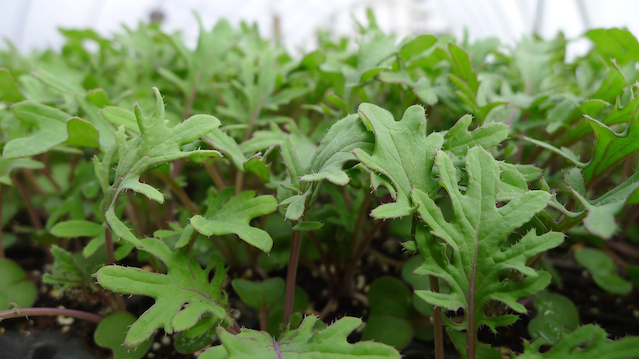
Kale transplants ready for life outside the greenhouse.
Since our last newsletter went out we've truly hit the ground running! Plowing, bed shaping, planting, direct seeding, cover cropping, and row covering have been in full swing and we're right on the crop schedule, thankfully. It wasn't long ago that we all thought we would be delayed by the cold wet weather but the first half of April was fortunately dry and allowed us to work accordingly. Today's rain event was perfect for giving the transplants a much needed drink and for germinating the seeds in the two miles of rows that were direct seeded with carrots and spring greens (as long as nothing washed away...). Around 75% of our crops are currently covered by fabric to deter pests but to also protect the seeds and plants during extreme weather such as this. As long as we use enough sand bags to anchor the 30-foot-wide sheets to prevent them from kiting we'll be okay. I think we've learned that lesson.
After this deluge awakens weed seeds the cultivating season will begin and will last into September. Timing is everything when combating weed pressure and we do all of it manually for the most part. The tops of the beds where the crops reside will dry out much quicker than the driving/walking aisles which will allow us to get to the germinated weeds on time.
For now through September our weekly routine will include field prep, transplanting, seeding, and cultivating (and more). Soon harvesting will be added to that list. Historically our harvests begin in mid-May and we will be in touch via e-mail letting you know precise harvest start dates early in May. April showers bring May lettuces.
After this deluge awakens weed seeds the cultivating season will begin and will last into September. Timing is everything when combating weed pressure and we do all of it manually for the most part. The tops of the beds where the crops reside will dry out much quicker than the driving/walking aisles which will allow us to get to the germinated weeds on time.
For now through September our weekly routine will include field prep, transplanting, seeding, and cultivating (and more). Soon harvesting will be added to that list. Historically our harvests begin in mid-May and we will be in touch via e-mail letting you know precise harvest start dates early in May. April showers bring May lettuces.

Transplanting snow peas on a windy cold but dry spring day.

March 31, 2018
Breaking Ground
By Derek McGeehan
Breaking Ground
By Derek McGeehan
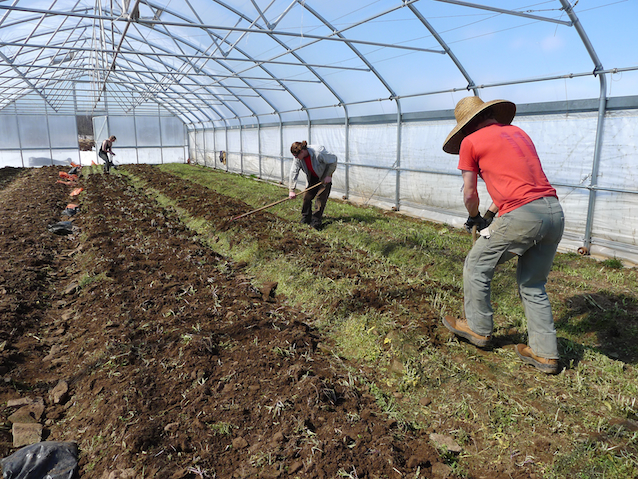
breaking ground and making raised beds in the high tunnel
Crops are growing and spring is in the air (at least some of the time). The cacophony of spring peepers is now pleasantly deafening during the evening hours at our upper pond and the ground is just about dry enough outside to begin earnestly thinking about working it and preparing it for planting. Inside our structures we're just about ready to transplant beets and lettuces and direct seed sweet hakurei turnips and mildly spicy salad radishes. Peas are on the march towards needing to be transplanted no matter what the weather or ground conditions. The rest of the first round of crops including romaine and head lettuces, endive, escarole, radicchio, kale, cabbage, chard, spinach, and kohlrabi will be transplanted this week, the following week, or if the weather really takes a turn for the worse the 3rd week of April (let's hope not).
Spring clean up is fully under way now that we can spend more time outside. Fencelines are being repaired and spared of vegetative weight. A big job this past week was moving 800 feet of fence to the other side of our 2.5-acre pollinator habitat so we could better interact with it during the growing season. We're thinking a mowed path through it will allow members to appreciate its natural native beauty throughout the growing season while its profusion of flowers are present. This space is a big benefit to the farm for many reasons including natural pest control, as a home for native pollinators, and nesting area for birds.
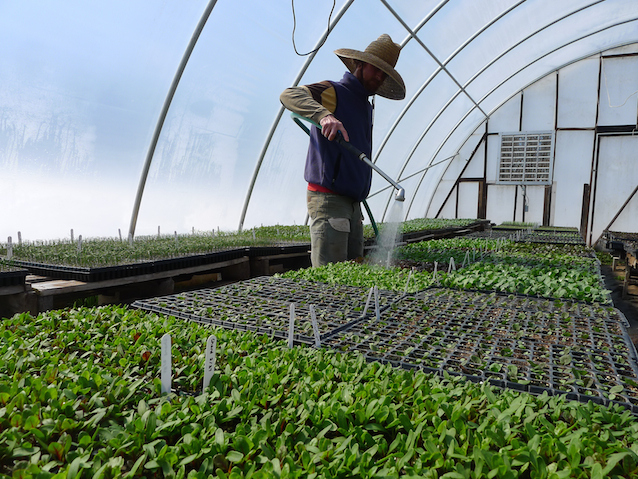
watering transplants in the greenhouse

March 21, 2018
It's Spring After All
By Derek McGeehan
It's Spring After All
By Derek McGeehan
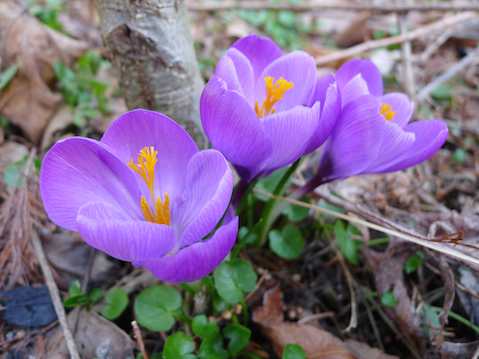
2018 crocus on the final day of February
Just like last year we enjoyed a late February spring tease followed by a month of March winter weather and are about to endure another Nor'easter one day after the official astronomical start of spring. Endure feels like the perfect word to describe life on the farm during a wintry March when cabin fever can ail us all. We're itchin' to begin our work outside, plowing and planting into dry ground on nicely made raised beds during a chorus of spring peepers and catcalls of the eastern American toad. Last year we weren't able to plant outside until April 11th, a week later than planned, and this spring is looking similar. But do not worry - harvests should begin on time thanks to the benefits of minimal season extension technologies such as floating row cover!
We began sowing the seeds for future food in our heated Greenhouse during the final week of February. It is now home to around 50,000 plants nestled in their warm trays. Plants from the first week of seeding will soon be one step closer to outside exposure; we'll move them to our unheated Hoop House to harden off. This will allow them to get used to spring weather in Bucks County before they go to their final locations in the soil in the field.
Starting next week we'll loosen and prepare the soil in our Hoop Tunnel and High Tunnel for early season beets, salad radishes, and tender hakurei turnips which will accompany the first few rounds of CSA shares. Hopefully the week after we'll begin preparing soil outside in the fields for the multiple acres that will need to be planted in April. It's almost time to truly hit the ground running, but right now we must endure another round of winter weather!
Starting next week we'll loosen and prepare the soil in our Hoop Tunnel and High Tunnel for early season beets, salad radishes, and tender hakurei turnips which will accompany the first few rounds of CSA shares. Hopefully the week after we'll begin preparing soil outside in the fields for the multiple acres that will need to be planted in April. It's almost time to truly hit the ground running, but right now we must endure another round of winter weather!
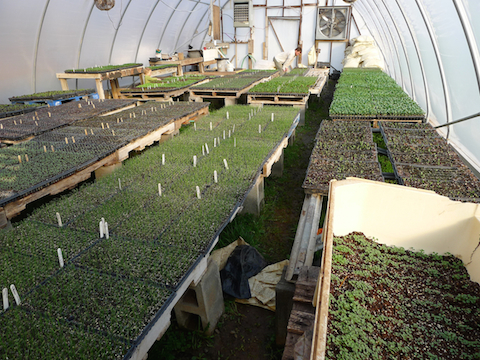
Green in the Greenhouse! Onions, leeks, scallions, bok choy, cabbage, kale, kohlrabi, romaine and bibb lettuce, endive, escarole, radicchio, dandelion, spinach, chard, beets, peas, celery, fennel, parsley, cilantro, dill, tomatoes, peppers, flowers

February 25, 2018
Thanks Folks!
By Derek McGeehan
Thanks Folks!
By Derek McGeehan
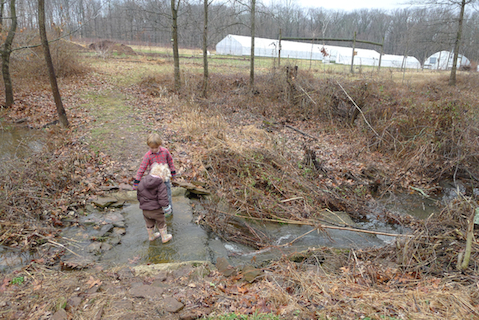
Will February showers bring March flowers?
We made it! The final harvest week of the Winter CSA is upon us and spring is in the air. Ten weeks ago we were deep in the throes of winter and concerned that some of the crops wouldn't survive the prolonged freeze. Most of them did, highlighting their resiliency while reminding us of our dependence on the warming sunshine to heat the tunnels during daytime and on row covers and greenhouse film to trap that heat to keep the tunnels above the low temperature damage threshold during the night. After those two weeks of extreme cold it's been fairly moderate with inside covers unused probably half the time.
Besides our extra focus in improved and increased quantities of fresh crops in the tunnels, we also knew we had to give more attention to maintaining the quality of the storage crops (based on our experience from the previous two winter seasons). We have three different rodent proof, insulated, and temperature controlled storage rooms in the barn where we also monitor and modify humidity levels with buckets of water, spraying roots with water, and adding water-soaked towels to keep crops from drying out. Different crops require different temperatures and humidity/moisture levels. Over time we've learned which crops do well in specific rooms and at what temperature and moisture level. Some of this information is published elsewhere and has been helpful but learning from experience about our micro-climates and site specific characteristics just takes time.
Forty-two weeks ago we embarked on the 2017 Main Season CSA and have hosted pick ups every week since then. Ten weeks from now the 2018 Main Season CSA will begin and we hope you will join us. We recognize that you have many options available when deciding where to procure your veggies and we are truly grateful for your patronage of Anchor Run CSA. Thank you for your support and trust in bringing you organic, local, and seasonal food!

February 19, 2018
Southbound
By Derek McGeehan
Southbound
By Derek McGeehan
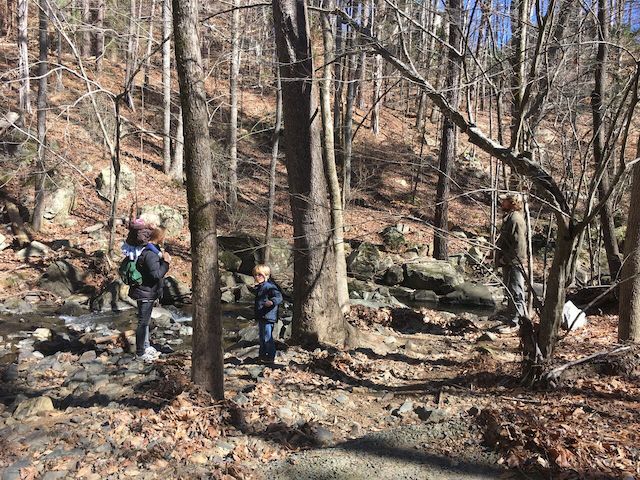
Hiking in North Carolina (who can spy Derek?)
Apologies for the late newsletter! We left the farm for a long-weekend excursion to North Carolina to visit family so the newsletter is going out a bit late this week. And spending nearly 8 hours in the car after setting out at 6:15 this morning has left me mentally under performing. I will do my best to keep this coherent and concise!
Last week we coordinated our annual potting soil order with 7 other local farmers to get a full tractor-trailer load of organic mix from upstate NY. We also built some workbenches for our modest workshop and ordered the critical repair component (hopefully) for our greenhouse exhaust fan. Another long meeting with NRCS/USDA for water management and erosion control was held, which will - also hopefully - eventually turn into application and implementation.
On the agenda for this week is an all-day class on "Food Saftety Modernization Act Produce Safety Training". Attendance of this class is a requirement under the new Food Safety Modernization Act. Because we will begin seeding in the greenhouse next week we'll probably begin getting the space ready by cleaning up the winter crops, laying landscape fabric, and erecting tables.
This is the final week of pick up for Week A Half Shares, way to go seasonal eaters! Thank you for joining us this winter and hopefully we'll see you this spring for our Main Season CSA!
This is the final week of pick up for Week A Half Shares, way to go seasonal eaters! Thank you for joining us this winter and hopefully we'll see you this spring for our Main Season CSA!

February 11, 2018
Misty Moisture Majestic
By Derek McGeehan
Misty Moisture Majestic
By Derek McGeehan
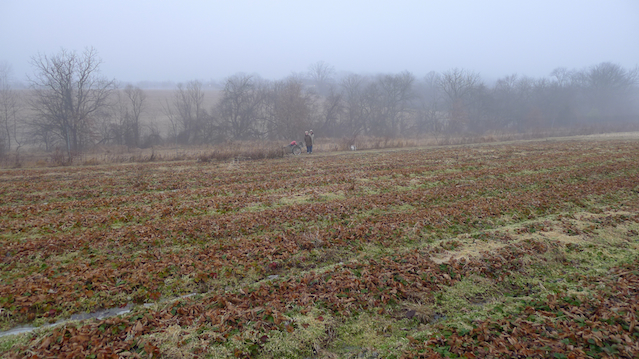
Pre-deluge stroll around an already soggy farm.
It might have been a slow and sleepy time on the farm last week, or at least according to these current reflections on a sleepy Sunday misty morning it feels that way. We did submit our annual update for organic certification as well as put the finishing touches on our greenhouse seeding, direct seeding, and transplanting schedules. We also finalized the plans for the crop rotation and mapped out where all the crops will call home this season. Conversations continued with Natural Resources Conservation Service to improve water flow and erosion control around the farm. Concrete was removed, a hole was dug, and pipes were connected to install a 2nd sump pump in our basement. Fortunately I was able to hook it up just prior to Happy Hour on Saturday, or more importantly just before the heavy rain arrived. Now it goes off every 5 minutes or so. On the agenda for this week is organizing and building a workshop in our garage as well as harvesting and hosting the weekly pick ups. Hope you're snug and dry!
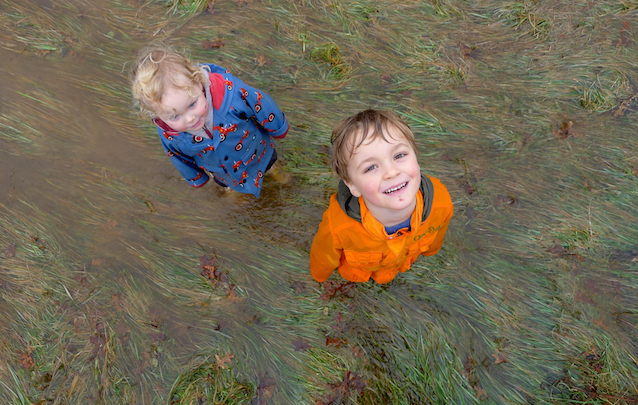
Big water flow in meadow.

February 4, 2018
Vegetable Family
By Derek McGeehan
Vegetable Family
By Derek McGeehan
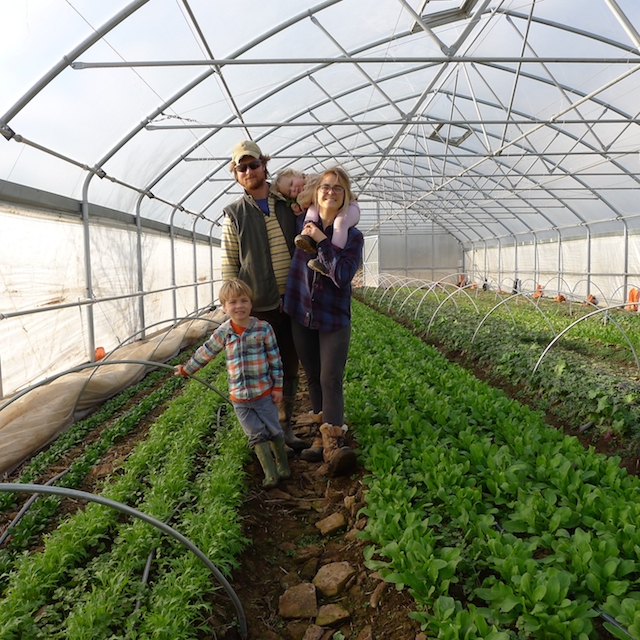
A new farm family photo.
It's February, we're already past the halfway point of the Winter CSA, are embarking on harvest week #39 since last May, and are ever-so-close to beginning the physical preparations for the next growing season. According to our 2018 Crop Plan we begin seeding into flats in the greenhouse the week of February 25th, just 3 weeks away. That same week we may begin preparing beds in the tunnels for very early carrot and beet sowing. Outside soil prep probably won't begin until mid/late March, or whenever the soil is sufficiently dry/unfrozen, and planting into the ground won't begin until early April.
The Winter CSA essentially bridges the gap between two warm-and-official growing seasons in different calendar years and really makes apparent the continuity of (plant) life while we circle the sun. This is mostly due to the protective qualities of our multiple tunnels, allowing crops and plants to survive/thrive during the coldest time of year. Whereas we previously quasi-hibernated during the winter months, focusing primarily on indoor and administrative preparations for the warmer time of year, now we do that plus maintain live plants as well as a plethora of storage crops with differing temperature and moisture needs. (A long long time ago there also used to be some very nice pre-child vacations).
Winter growing was an original challenge we had in the backs of our minds in the very beginning nine years ago. Of course at that time we were primarily getting our feet under us as we took over farm operations from the previous growers, focused solely on the 25-week Main Season CSA. It's been sort of like building-blocks since then, one layer at a time, steady, a few topples and rebuild. Now that we're here we can think about the next layer, be it increased fruit production, year-round CSA harvests, grain growing, all of the above or none of the above. We'll see.
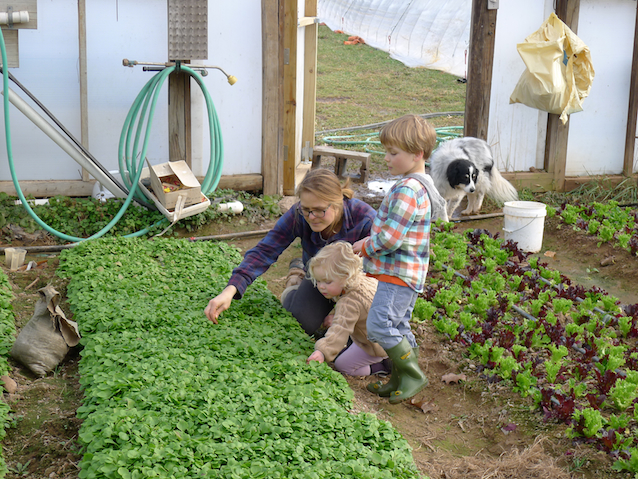
Fresh claytonia and lettuce mix in the greenhouse in January.

January 28, 2018
Winter Days
By Derek McGeehan
Winter Days
By Derek McGeehan
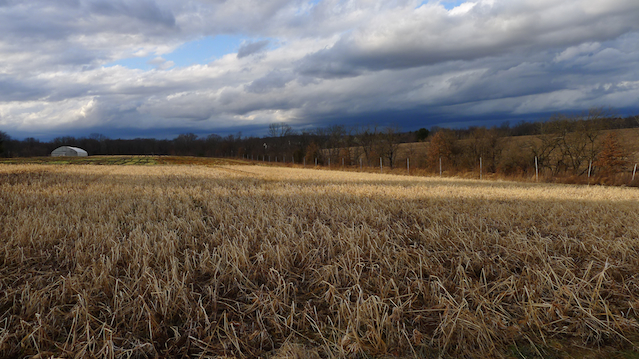
Winter farm scene at Anchor Run.
We're still enjoying fairly mild weather for the middle of winter. February arrives this week as we eclipse the 10-hours-of-daylight mark. We're also halfway through the Winter CSA and now daylight is going to increase rapidly as we move towards the spring equinox. During these mild winter days we walk around the farm while brainstorming ways to improve the farm for the upcoming growing season as well as farther into the future. Annual produce crops will give us immediate enjoyment this year but perennial crops like asparagus, raspberries, fruit trees, and blueberries will take a few years until they bear fruit. As we fine-tune our crop plan and rotation we realize that due to better yields and improved decision making our growing footprint is actually shrinking, allowing us to use new available land for long-term crops like the ones previously mentioned, or a sustained cover crop fallow period for soil improvement.
Thus, new challenges beckon. Sweet fruits are definite crowd pleasers and we're striving to figure out ways to bring these additional crops to you. As a Certified Organic farm there's probably a bit of a challenge in growing chemical free and healthy fruit which is why you don't see any organic fruit and berries around. We're excited to try. We're hopeful that in the same way we're able to successfully grow high quality organic produce we can slowly add more berries and tree fruits to the mix. There will be some trial by error for sure, and unfortunately the longer term investment might not reveal the errors quickly, but that's what it will take to get it right. We still have a lot to learn, but over the past 3 years we've planted 65 fruit trees, 200 blackberries, and 500 raspberries. This upcoming season we're planting 500 more raspberries and 150 blueberries as well as expanding our strawberry patch. We think diversification is key to a healthy and successful farm. Thank you for your support.
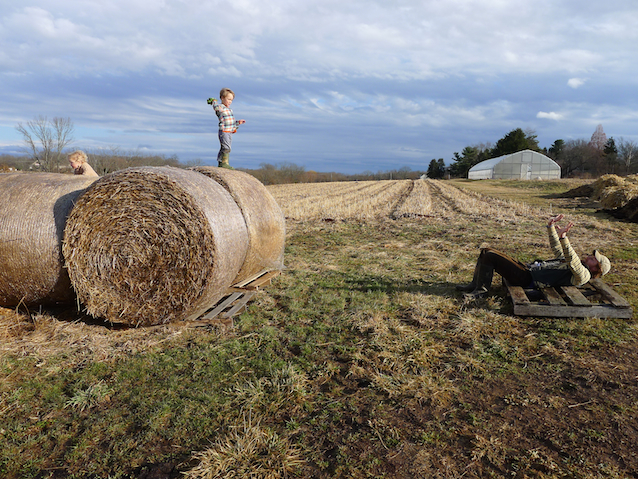
Claytonia (aka miner's lettuce or winter purslane) toss on a warm winter day. Abigail doesn't eat much raw produce just yet, but she does enjoy munching on heads of claytonia, which should arrive in shares in week #7. The heads in the shares won't be munched on.

January 21, 2018
Another Thaw as Solar Winter Nears End
By Derek McGeehan
Another Thaw as Solar Winter Nears End
By Derek McGeehan
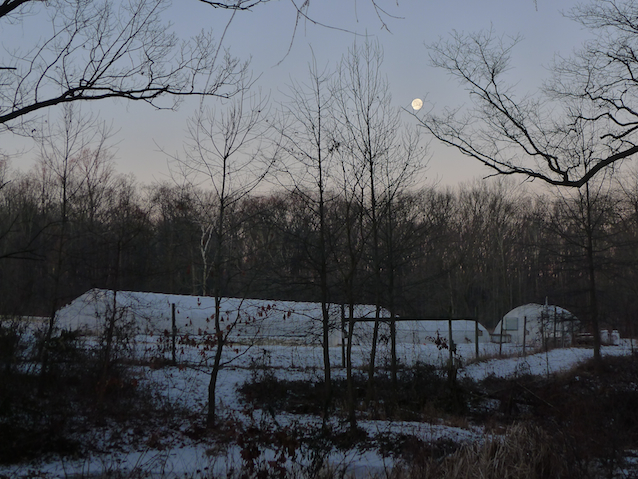
Cold winter morning with a descending super moon from a month ago.
I guess I'm still reeling from the 2+ weeks of extremely frigid weather because now when I look at the 10-day forecast and 5 of those days are supposed to be 50 degrees or above a part of me feels incredulous, a sense of disbelief. We're not even quite halfway through astronomical winter but that kind of forecast is more like March than January. That said, we're pretty close to rapidly increasing daylight and are 10 days away from 10 hours of daylight. We're also about out of our hemisphere's solar winter, the quarter of the year with the least amount of daylight. Because of the heat lag though we still have cold weather ahead (probably). I did read that by mid-February temperatures are supposed to be average or slightly below, which still sounds warm to me after the cold we've already experienced.
While it's warm for the next few days we'll remove the inner covers from our tunnels and open doors so air can circulate better. On warm days this time of year air exchange in the tunnels is important to quell the spread of any disease. This will also give us a chance to assess all of the greens and plan for the next few weeks of harvest, as well as get an idea of any sustained damage from the previous cold spell.
We've made great progress on our 2018 Crop Plan and are beginning to put the pieces of the crop rotation puzzle together for this season. Bed feet was calculated for each crop/family, 2015-2017 use is taken into account, cover crop species sown in summer/fall 2017 are considered, soil test results are analyzed, drainage is appreciated, and thus plans are made, 2018 farmscape takes form.
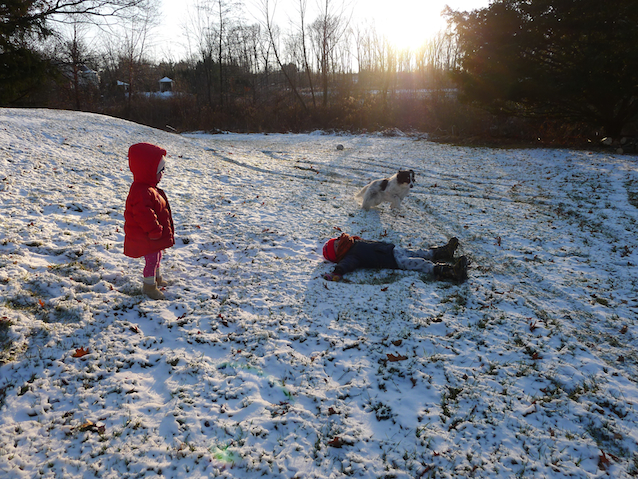
At least it's not too cold to play outside.

January 14, 2018
Waterlogged and Productive Thaw
By Derek McGeehan
Waterlogged and Productive Thaw
By Derek McGeehan
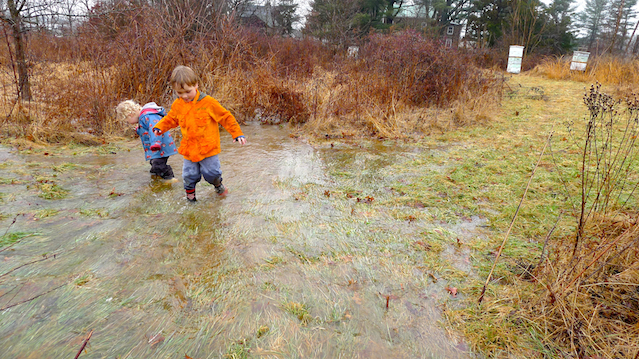
We welcomed above freezing temperatures and mud back to the farm this past week. The warmer temperatures allowed us to spend more time outside, continuing farm/barn clean up, tree trimming, ditch clearing, water stomping. For farmers' sanity, even during winter months when indoor time is needed for administrative purposes, some time each day must be spent outside, and it's much more pleasant (obviously) when it's 40, 45, 50, 65 degrees. And some good news: most of the crops survived the extensive deep freeze intact. Some of them, like the baby kale, required approximately 5 days of warmer weather before they fully perked up.
The torrent of water on Friday reminded us of areas of the farm that have water issues and need some improvement. Water management is an ongoing project, one that we're hoping Natural Resources Conservation Service (part of USDA) will provide some help with. In the past they've assisted with the establishment of a 2.5-acre pollinator habitat and a grant for some of the cost of the movable high tunnel.
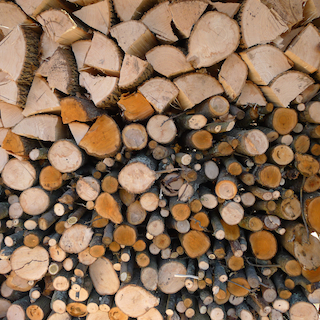
Some administrative tasks we've been working on the past few weeks, and continue to work on, include: updating the crop plan and evaluating every crop we grow which involves adjusting quantities of plants, dates for seeding and transplanting, and altering growing methods. For example, basil will be divided into 5 smaller plantings; winter squash, husk cherries, and tomatillos will be grown in 12-foot wide fabric ground cover to suppress weeds, disease, and make harvesting easier; the 2nd planting of tomatoes will be grown under protection in the new hoop tunnel; the heirloom tomatoes will be grafted on rootstock; the cantaloupe crop is doubling is size; brussels sprouts and sweet corn are being added; fall kohlrabi is being reduced. Subsequently, linear bed feet will need to be calculated for each crop so we can update our crop rotation and have a planned location for each one. It's a vision for the future and a fun puzzle to put together.
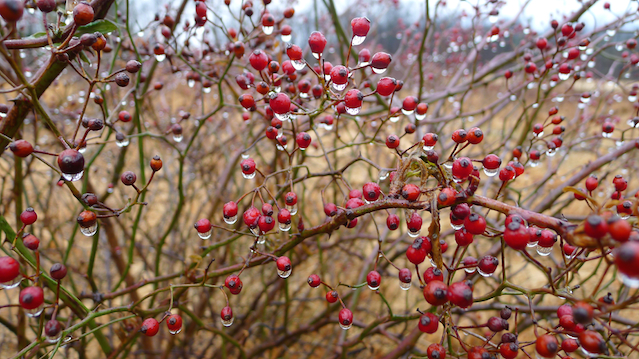
Multiflora rose is an invasive species, but its seeds/berries are winter food for birds.

January 7, 2018
All is Not Lost
By Derek McGeehan
All is Not Lost
By Derek McGeehan
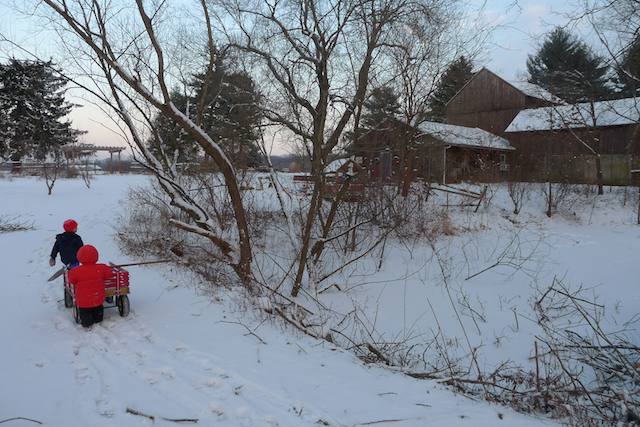
Heading home after some serious snow play.
Our fingers and toes are still crossed (maybe frostbitten) as we continue to positively hope for successfully getting through this unforeseen deep freeze. Now, at least, 5 degrees without wind doesn't feel all that cold; when it's sunny and 15 degrees it feels warm. At least we have some snow to play in, too.
We are looking forward to trying to wash in the barn this week when it will be 40 degrees instead of 15-20 like last week. The washing experiment taught us that when it is that chilly, water freezes quickly to the conveyor chain on our root washer rendering it unusable. Hannah then bravely sprayed off the roots as much as possible while laying them out on bread trays. It had to be done very quickly before any of them froze.
It appears that a January thaw is in store for us this week and quite unbelievably it may be in the 50s next weekend. Crazy?
One important issue that we somehow (?) overlooked while we were more focused on successfully growing and storing winter crops is how to appropriately heat the barn in the future, warranting some serious consideration for a system that can heat the entire lower floor. We've managed to make the pick up room somewhat comfortable/tolerable using greenhouse plastic, tarps, old row cover, and space heaters, but this doesn't feel like a permanent solution to us, even though it is contemporary-rustic-farm-chic.
Thanks for growing with us!
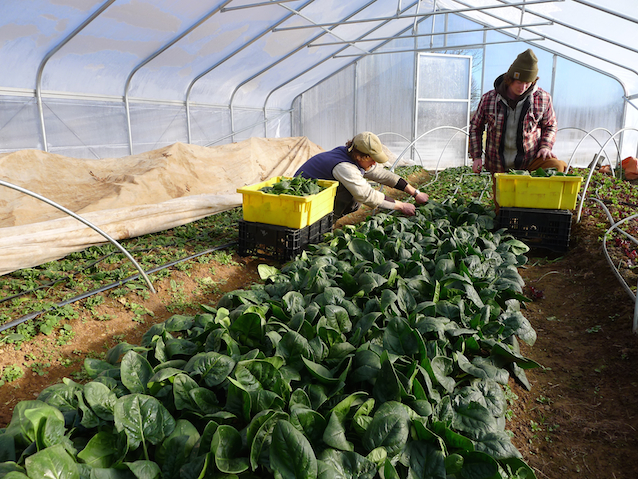
Harvesting cold tolerant spinach with Pat from the new hoop tunnel last week for share #2.

December 31, 2017
Baby It's Cold Outside
By Derek McGeehan
Baby It's Cold Outside
By Derek McGeehan
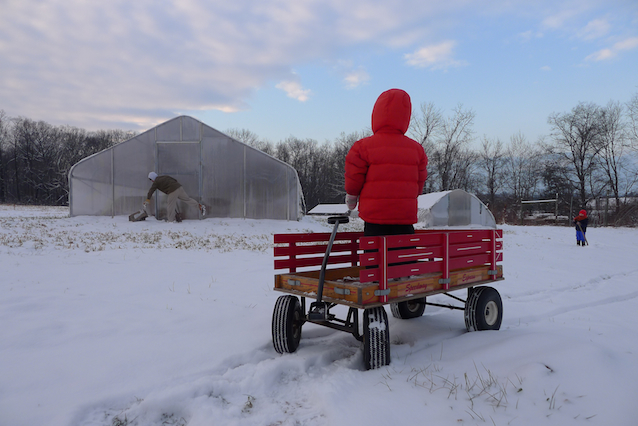
Chiseling away frozen and expanded soil to get into the Hoop Tunnel.
About 12 degrees and cloudy at 4pm Sunday...
Due to the extreme cold we're experiencing we'll try our best to distribute what's on the Expected Harvest list but we might have to make some last minute adjustments. Because spinach is known to be exceptionally cold hardy we postponed picking it last week in favor of cutting slightly less tolerant arugula and greens mix in case the extreme cold damaged them. As of now all the fresh greens look to have survived 7 consecutive days and nights below freezing. Before the worst of it began last Wednesday night, we added our thickest floating row cover (i.e. blanket) over top of the interior hoops and row cover that was already in place. This system should trap enough daytime solar radiation and soil/earth warmth to keep the greens between 25-35 degrees at night. Because the length and severity of this cold spell is unprecedented during our tenure at Anchor Run Farm, we're not 100% certain of the outcome after these two weeks. However, midway through the event, protected crops continue their healthy lives unscathed.
Also, the water line from our irrigation well to the barn and washroom freezes when single digits freeze the ground so now we'll have to run hoses from our basement to the washroom. Last week we were unable to prepare this in time for pick up which resulted in dirty beets. This week we'll have that system up and running so we can clean the roots. However, we don't wash sweet potatoes because this damages them and then they deteriorate quickly afterwards.
Additionally, we're doing our best to keep the pick up room temperature pleasantly above freezing. Now that we're fully embracing a January-February Winter CSA we need to think about the most appropriate longterm solution for heating an uninsulated, lofty, drafty barn. We've been so focused on how to grow fresh crops through the winter months that we overlooked the cold/heat situation in the barn. Our sincere apologies! However, with our current set up, you can expect to enjoy a 35 degree sauna in the pick up room when it's 10-15 degrees outside, thanks to tarps, greenhouse plastic, floating row cover, and space heaters.
As of now, Monday, January 8 is predicted to crest the freezing mark, so get your bathing suits and shorts ready!
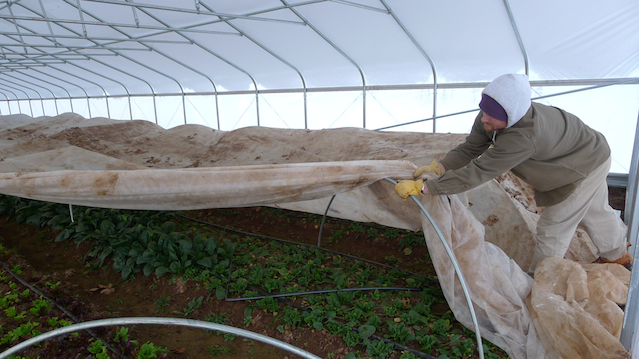
Hello in there!

December 24, 2017
Officially Winter With Cold but Increasing Daylight
By Derek McGeehan
Officially Winter With Cold but Increasing Daylight
By Derek McGeehan
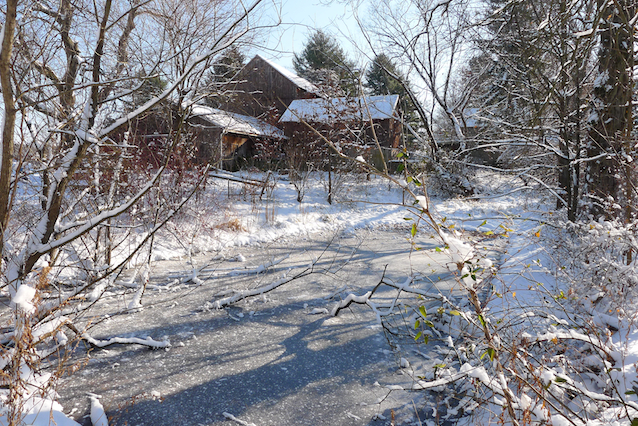
Farm pond barn snow scene.
It's official. With the Winter Solstice the Winter Season has descended based on our planet's movement around the sun. We're also pointing more away from the sun this time of year and any captured warmth is fleeting. Fortunately the start of winter and cold coincides with increasing daylight hours, thus giving a positive spin to the coldest season, as we circle the sun. Approaching the New Year we'll endure some extreme cold and temperatures will remain below freezing, 10-15 degrees below average, for the next 10 days apparently. As long as the sun shines during the day our unheated tunnels will remain warm enough through the night, retaining some of the earlier captured sunshine/solar radiation. With this expected deep cold, we'll have to wait for a late-morning, sun-inspired thaw inside the tunnels in order to harvest the spinach, arugula, and other greens.
We're also now in the middle of our 'Persephone Period', when daylight is less than the important 10-hour mark, when plants' growth slows down considerably, but not completely. Five weeks from now, at the end of January, daylight will eclipse the 10-hour mark and we'll be into February and halfway to spring. Inside our structures that house our winter greens, growth is now going to slowly speed up and by the end of February spring will be in the air. For now we enjoy/tolerate this cold and remain thankful for plants' ability to grow at this latitude, in this climate, in this season, with 'minimal' protection. Thank you for your support.
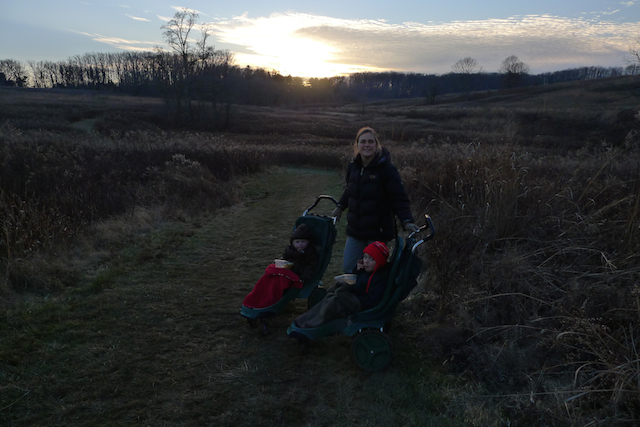
Winter Solstice celebrated in the large meadow at Longwood Gardens.

December 17, 2017
Winter Solstice Greens
By Derek McGeehan
Winter Solstice Greens
By Derek McGeehan
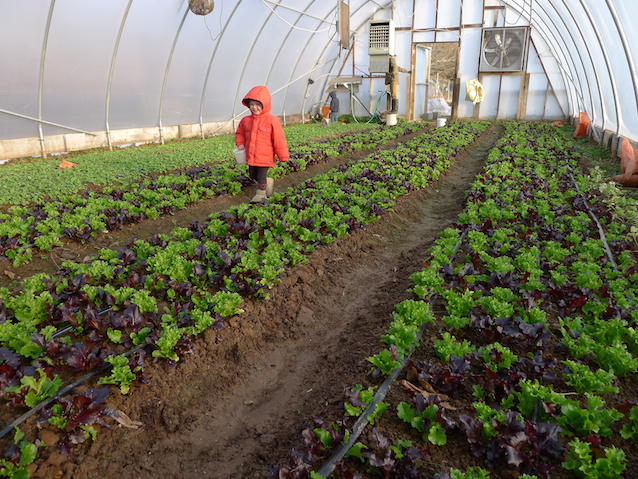
Above, this is our "heated" greenhouse, temperature set in the low 30s. You can see me in the background attempting to light the pilot flame after half a year off (process takes about 30 minutes). It's probably unnecessary to add heat, but we're using this structure as a way to compare minimally heated indoor winter growth to other tunnels that aren't supplementally heated at night. This is the structure where we start our seedlings in late winter for spring transplanting and we already have the heating unit in place, so it makes some sense to observe growth where lows only bottom out around 32-34 versus 24-26 in the unheated buildings.
In the unheated tunnels we add big hoops and floating row cover on the inside to trap warmth closer to plants (sometimes we also trap kids like below, or they sneak under). Another cold test came and went last week. After a few more nights in the teens and a couple of days where temperatures stayed below freezing, including one that was cloudy, uncovering the plants Sunday revealed healthy and robust greens. It's always a little unnerving to deal with below average winter cold, but after additional experience I'm really feeling confident in appropriate plants' ability to tolerate winter weather and provide us with healthy greens all winter. Thank you plants, seriously!
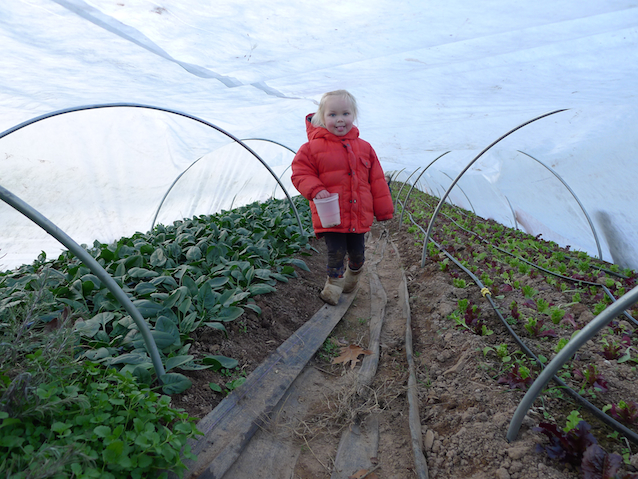

December 10, 2017
A Beautiful Week in December
By Derek McGeehan
A Beautiful Week in December
By Derek McGeehan
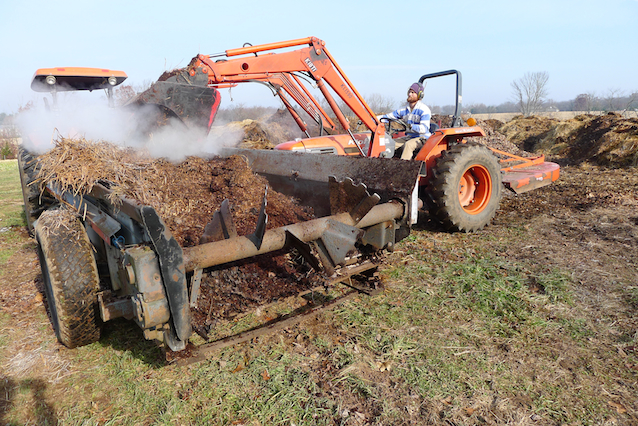
Dry ground in December, or during any month in the winter, is a rare treat on the farm. So, what do we do with that special time? We tackle tasks that we don't have time for during the busy growing season that require tractor use, such as spreading compost and mowing buffers and pollinator habitats. We basically stockpile compost ingredients for a year or two, turning it every once in a while to help introduce oxygen and speed up decomposition, then spread it during the fall or on fallow areas during the active growing season. We don't attempt to spread it on the entire farm every year. Rather we try to spread it on portions that we observe to need it and also rotate its application so that every field will receive it once every four years or so.
There are many benefits to compost application including the addition of organic matter, nutrients, and minerals plus it slightly acidifies the soil, which we need to do now after spreading aragonite for years. Introducing compost also feels like a successful completion of the food production circle/cycle.
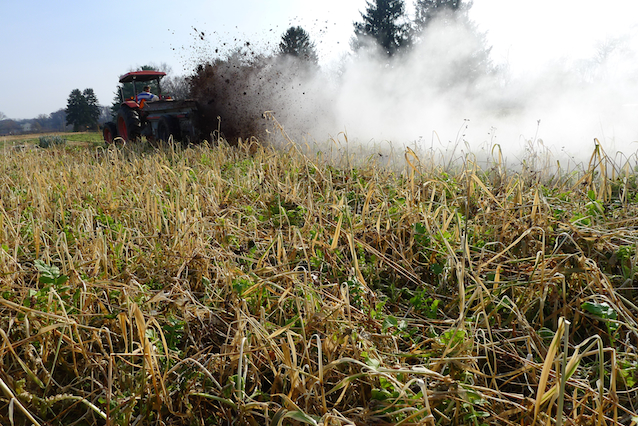

December 3, 2017
Here's December
By Derek McGeehan
Here's December
By Derek McGeehan
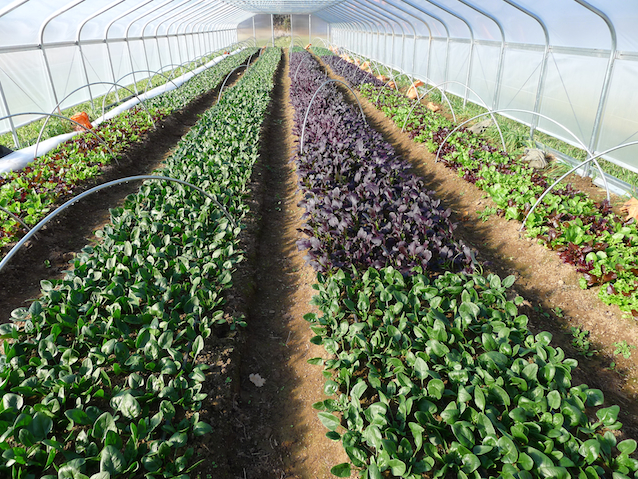
Early December in the new Hoop Tunnel, 144 feet of tender green goodness.
The fresh salad greens inside the structures are now mature enough to continuously cut, adding a delicate treat to shares for the foreseeable future. The lettuce mix salads our family enjoyed over the past week were truly delicious. Flavor seems to be enhanced this time of year, a combination of the cooler weather, our ability to control water content, and probably also from the absence of salads in our diet for a few weeks prior.
This coming week we also plan to begin harvesting two dark red varieties of mizuna that are simply pleasing to look at but also taste mild and sweet. Young and winter hardy tatsoi will also be added to the greens mix. Spinach, shown in the foreground above, will probably be harvested during weeks #5 and #6.
The balance we try to achieve with these greens is: harvest them when they're big enough and roots are well established but small enough that they'll regrow in a month or so and we won't remove too much of their available nutrients and ability to regrow. If they get too big they'll compete with each other for light, some leaves will deteriorate, and they'll be more susceptible to deep cold.
We also need to be mindful of spreading out the harvest, an attempt to have fresh salad greens every week for another 13 weeks (including the Winter CSA). Now that we're growing in 4 structures (high tunnel, hoop house, hoop tunnel, and green house; total of 8,300 square feet) we're more confident in our ability to provide fresh greens throughout the fall and winter months. Thank you for your support!

November 27, 2017
Two and a Half Months of the 'Dark Time'
By Derek McGeehan
Two and a Half Months of the 'Dark Time'
By Derek McGeehan
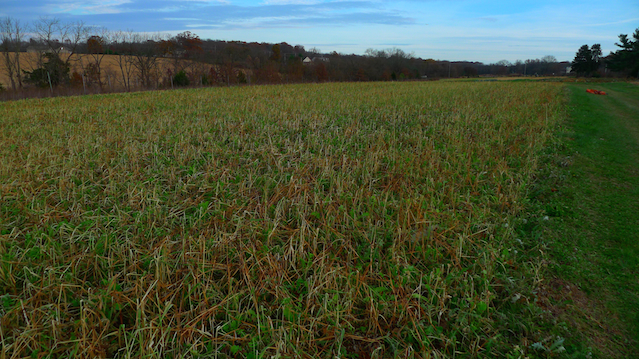
Now that many farmers and gardeners are pushing the boundaries of successful winter growing, dialogue and information are passed around and shared via literature and online/social media regarding successes, failures, experiments, conditions, variables, tools, data, terms, etc. Many growers refer to this time of year that we're currently in as the Persephone Period (from Greek mythology), when day-light/day-length drops under 10 hours. This period corresponds with reduced plant growth, a factor of light but also temperature. Our Persephone Period runs from approximately November 15th until January 30th, which ultimately has everything to do with our latitude, earth's tilt on its axis, and our revolution around the sun. Different latitudes endure varying lengths of daylight and darkness so the farther north you are the longer your Persephone Period.
Some examples of the influence of this period that farmers have identified: days to maturity triples in unheated cold houses like our high tunnel and doubles in minimally heated cool houses such as our green house. Due to minimal growth during this period it is critical to establish plants at appropriate times so that they grow just enough before November 15th. Sow the seeds too close to this time and plants will germinate and grow very, very slowly, almost hibernating until February. Even though February is colder than December (normally) plant growth resumes relatively quickly when day-length surpasses the 10-hour mark.
For many of our winter crops that are in our protective structures we hope to harvest 2-3 times over a 3 month period. In order to do so they must be well established prior to mid-November. The crops that go in too close to the start of Persephone will probably only be harvested once during February. So, by early February, halfway through astronomical winter, plants are already thinking about spring, especially (maybe only) inside our protective buildings where conditions create an environment more like North Carolina than southeastern Pennsylvania.
Question: When plants slow down and go quasi-dormant, do farmers respond in kind?
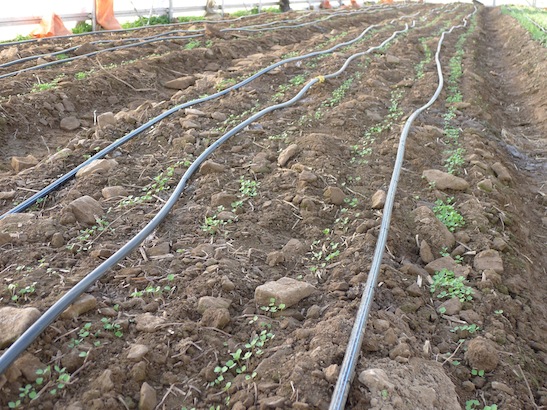
This arugula was direct seeded on November 4th, 11 days prior to Persephone, which may have been too close. During the warmer months arugula is ready for harvest approximately a month after sowing. This time of year it's more like 3 months, so we can look forward to eating this in early February. One way we study and compare plant growth during the winter is by taking weekly photographs of all of the crops in our 4 buildings. The goal is to have precise dates for winter sowing, though variables outside of our control include low and high outside temperatures as well as sunny/cloudy days which influence plant growth. Successive sowings help manage the unpredictable nature of nature.

November 27, 2017
Holiday Wreaths For Sale
by Dana Hunting
Holiday Wreaths For Sale
by Dana Hunting
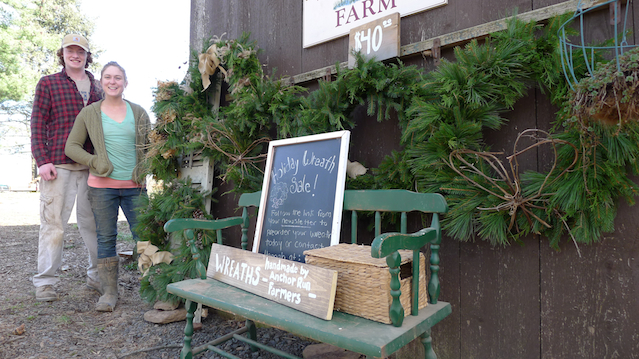
Holiday Wreaths Made by Farmers Hannah and Pat
- Hannah and Pat are hand-making wreaths using materials from the Anchor Run Farm and surrounding woodlands. Orders are now being taken. They'll also have a few to sell during pick ups but preordering is recommended because supplies are limited.
- Please follow the link for more information and to order.
- If you have any questions contact Hannah at hannah.r.conner@gmail.com.

November 19, 2017
A Balancing Act
By Derek McGeehan
A Balancing Act
By Derek McGeehan
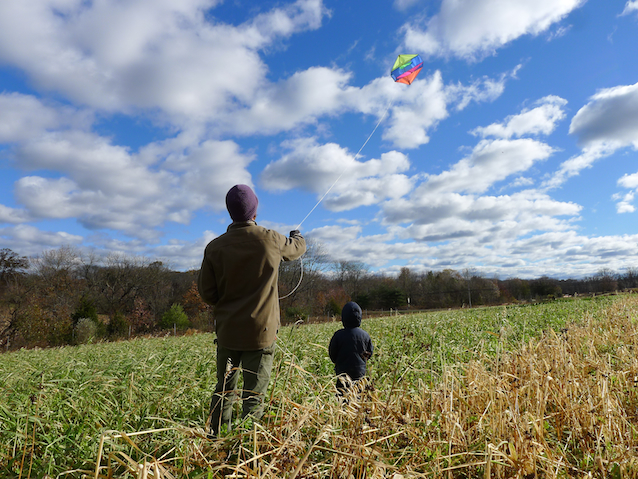
Almost too windy to fly a kite but a beautiful fall day overall!
Because we had the extreme cold of a winter night in early November our focus of late has turned towards our crops growing inside our four protective structures. Outside, many of our field crops received enough damage to render them unharvestable. Outside crops that are still worthy of our attention include cabbage, radicchio, kale, collards, hakurei turnips, scarlett queen turnips, and a few others. Besides these we may eventually be able to choosily pick some spinach and arugula, but for now we'll rely on some of the hardier greens.
Inside and protected crops include arugula, kale, spinach, mizuna, red mizuna, tatsoi, lettuce mix, claytonia (salad green), and a few special others. There are several successions of many of these crops but unfortunately the earliest our first planting will be ready is Late Fall week #3/early December. Based on our experience from past seasons we typically don't need to rely on the indoor crops until December and plan for such. Planting dates are coordinated based on when we want to harvest.
It's a tough balancing act this time of year, maintaining appropriate day and night temperatures inside, trying to train the crops to become accustomed to low temperatures while also encouraging them to grow fast enough for harvest. Warmth and light speeds growth, but too much warmth and growth will make them more susceptible to extreme cold (which happened to the outside crops). With outer layers of plastic plus inner layers of row cover our indoor crops are not frequently subjected to extreme cold, but we do expect to have a few nights in the single digits outside this winter and we do want them to tolerate lows in the 20s inside their nests. So, with fluctuating temperatures means opening and closing (venting) the buildings, mostly manually. Our greenhouse is the only structure with automated temperature controlled settings, but with an exhaust fan that currently doesn't open its own shutter properly, it means we need to manually open the door on sunny days. All of the other structures have doors, too, plus roll-up or drop-down sides for ventilation along the entire length on both sides.
Also in consideration are moisture and humidity inside these buildings. Both can contribute to mildews which can be detrimental to crop health. Venting for this reason occasionally is required. But, we don't want the crops to dry out too much either since that also makes them more susceptible to the cold. And, to grow, they need water, which we have to add through drip tape, since they're protected from the outside elements.
Thus, we strive to find the appropriate balance between factors we can control and we are thankful we have the ability to control the factors just enough to ensure decent yields of greens through the winter. At least that is our goal. Thank you for your support.
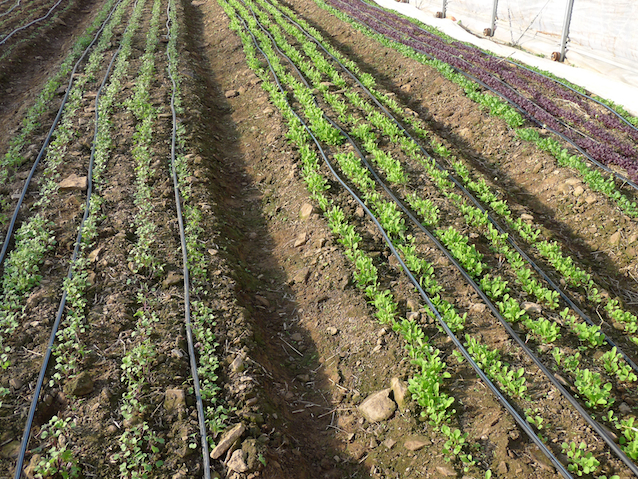
Drip tape on the first round of greens in the high tunnel: red russian kale, arugula, red mizuna, and tatsoi.

November 13, 2017
Brief Arrival of Winter with Late Fall CSA
By Derek McGeehan
Brief Arrival of Winter with Late Fall CSA
By Derek McGeehan
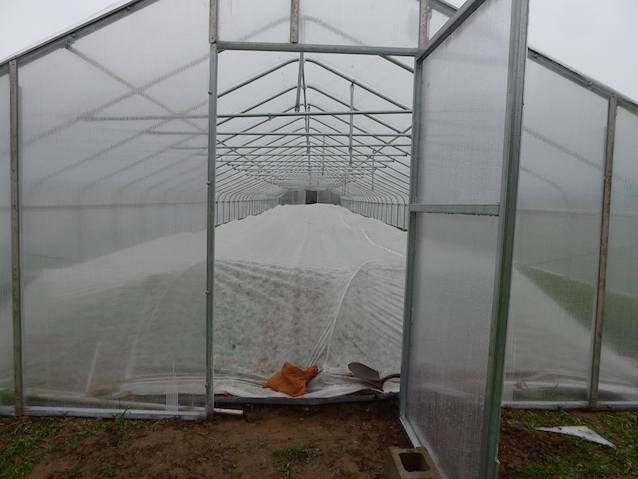
A view from the west end of our new hoop tunnel with inner layer of hoops and cover. Plants are kept warm and safe inside.
Mild, warm, hot, balmy, above-average, light frost, hard freeze, extreme weather = very thankful for our 4 winter growing structures: hoop house, green house, high tunnel, and hoop tunnel!
First the good news: as of Monday morning all of the fresh greens in our structures survived unscathed and field crops of kale (several hardy varieties) plus collards seem fine. It takes several days for plants to show damage or health after a freeze like the one we had so by midweek we'll probably be able to identify fully what we lost and what survived. Either way, we have hundreds of bed feet of kale to eat for the next year and a half. And, we have enough greens in the structures to keep all of us happy through the fall and winter months! We also harvested a lot of red cabbage, napa cabbage, lettuce, and escarole prior to the potential damage. Storage crops are obviously safe and okay.
A tough reality: we had our first taste of January weather but unfortunately in arrived in the first half of November instead. Record breaking cold following weeks/months of uncharacteristically warm weather surprises plants as well as us humans. The best case scenario for our field crops to tolerate a deep freeze is a slow cool down with a few minor frosts (36 degrees), hard frosts (30-32 degrees), and minor freezes (26-28 degrees) of immature and still growing plants, giving them a 'taste' of what's eventually coming. Last weekend's scenario was basically the opposite: most of our outside crops were fully mature after growing extremely quickly during the warmth of September and October and during October and early November we hardly had any light frosts, let alone a freeze of some kind (on average we receive our first light frost during the 1st half of October; our first heavy frost/light freeze the 2nd half of October). So, a low of 19 degrees is an extreme shock to a stationary plant that is used to lows above 40 degrees. Even with a gradual cool-down of some kind, temperatures in the teens will severely damage most unprotected crops. Heavy layers of floating row cover over top of low hoops can protect a certain amount (2-6 degrees) but wind greatly diminishes the efficacy.
Enter the super/mega/ultra importance of our bigger structures! The outer plastic layer protects 5-10 degrees and an inner layer of hoops and cover adds another 5-10 degrees of comfort. So, when it's 10 degrees outside, under the inner layer of a structure it might only be 30 degrees, all without the aide of supplemental heat. Additionally, our green house has the option of supplemental heat as added insurance, so we should be eating fresh greens all winter long no matter the weather!
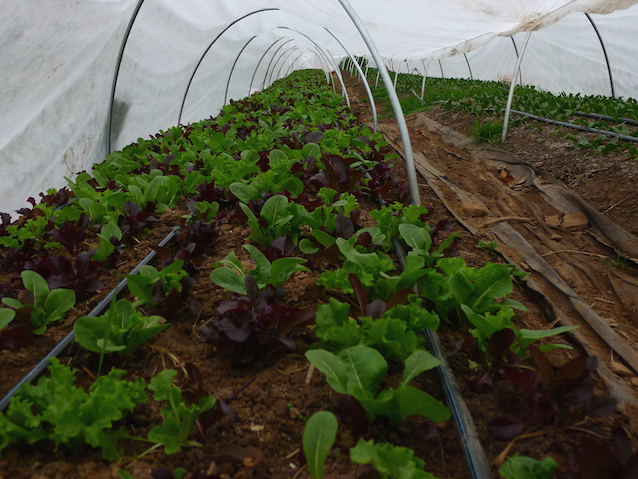
A view under the inner cover inside our hoop house. The lettuce mix is almost ready to be harvested.

November 5, 2017
We Bid Thee Thanks and Farewell
By Derek McGeehan
We Bid Thee Thanks and Farewell
By Derek McGeehan
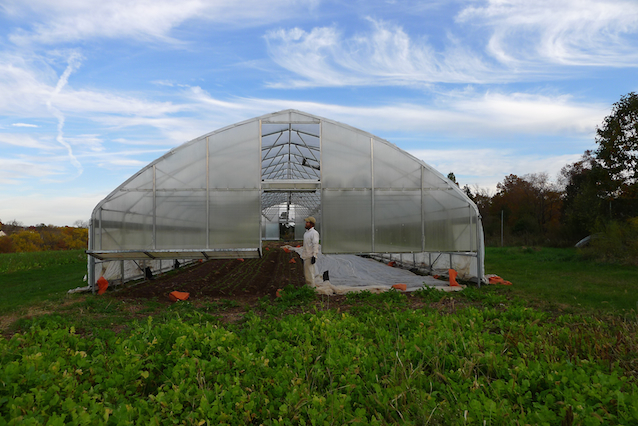
At this conclusion to the Main Season CSA we say, think, write, and feel thankful to you, our CSA members, for your support, help, interest, trust, commitment, and sense of eating adventure. We recognize that a half year of local produce consumption can be quite a daunting task and that we're fortunate that you've asked us to be your produce farmers.
Without you and your support our CSA wouldn't be as successful as it has been for 14 years. We're grateful that every season we meet our membership goal, a number that is capped at 250 weekly member pick ups so that we can focus on growing the best produce for you that is potentially possible on our central Bucks County farm. We're not expanding our business or farm but are instead acquiring the experience and skills to properly serve our committed CSA members.
With your trust and support over the years we have the confidence to adjust our practices and shares to try to give you what you want in a CSA share. For obvious reasons it's impossible to please 100% of you 100% of the time, but we do try, trust me! We care about your opinions and want you to be able to eat our nutrient dense food to stay healthy and live an enriched life. Good soil = good food = good mind and body = good community. Thank you for allowing us to serve you!

October 29, 2017
November Already?
By Derek McGeehan
November Already?
By Derek McGeehan
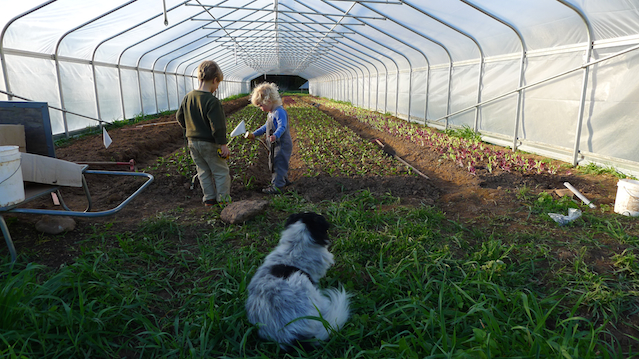
Time flies during our long (marathon) growing season. Three weekly pick ups for half a year for approximately 250 families each week and all of the preparations that go into growing high quality organic produce basically means there's no rest for the weary. But, hey, we like it! Of course, now that we're pushing harvests through the winter months means we're ever embarking on new challenges, such as how best to grow fresh produce in hoop houses and high tunnels throughout the cold months. Maybe eventually we'll have produce shares fully year round?
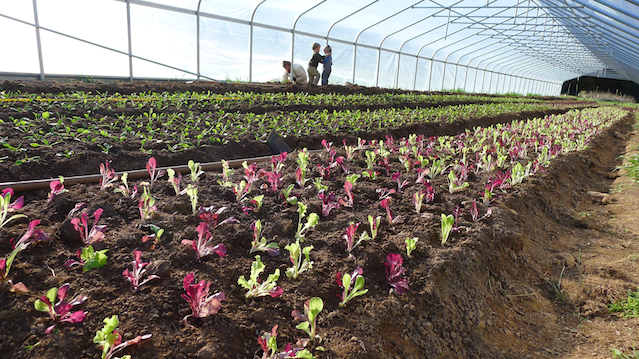
It's a labor of love that is possible and more meaningful because of the farm and business model we've been holding fast to thus far: Community Supported Agriculture. To be a fully functioning and successful farm for almost 15 years means that something is going well and right here and we hope that means we're providing you with the best possible produce we can grow with variety that pleases you.
We're ever grateful to you, our members, for your support. Your decision to be a part of Anchor Run means you are actively and directly fostering a healthy environment, local economy, and community. Thank you!

October 22, 2017
First Frost then Continued Warmth
By Derek McGeehan
First Frost then Continued Warmth
By Derek McGeehan
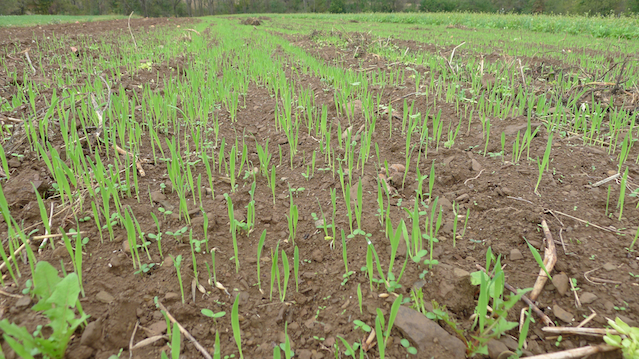
The lovely days of this autumn continue. This past week felt like the best weather of the season. The needed rain of the prior week helped what is probably the last round of cover crops to germinate (shown above are oats and crimson clover). Though we're finished cover cropping we still have edible crops to direct seed in the next location for our movable high tunnel (2,880-sq-ft). Into there will go winter greens like arugula, baby kale, mizuna, tatsoi, and mustard greens. After seeding we'll let Tuesday's rain assist in germination then will slide the structure over top of the beds to protect them for the next 4 months. Since there are 5 raised beds in there we'll probably plant 3 now and 2 in two weeks to spread out maturity in December and January. Over the next 3 weeks we'll also transplant seedlings into the hoop house (1,170-sq-ft), hoop tunnel (3,024-sq-ft), and green house (1,152-sq-ft) for Late Fall CSA and Winter CSA harvests.
This past week we had our annual Organic Inspection and of course passed with flying colors! The Friday prior we also hosted a representative from Pennsylvania Association for Sustainable Agriculture (PASA) to collect soil samples for a Cornell soil study. It feels good to see almost 10 years of our continued soil improvements impress folks in this business! We conduct soil tests every 3 years or so and of course they tell us about calcium, magnesium, phosphorous, potassium, sulfur, zinc, boron, etc., but simple observation of crops, cover crops, and soil structure is just as important, if not more so. You can feel and see the soil health here, now. That translates to healthy food for you and me.
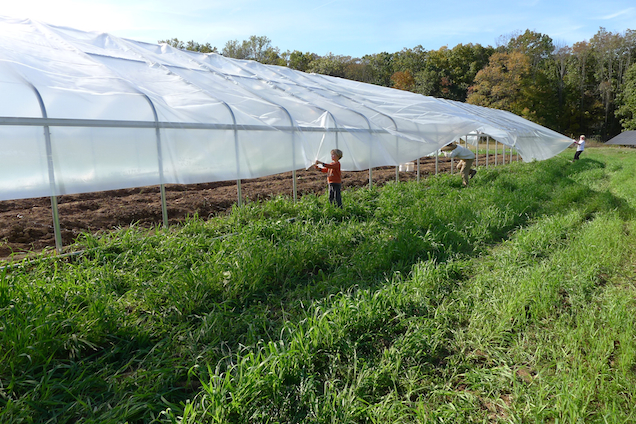
Covering the replacement hoop tunnel, a family affair.

October 15, 2017
Rain and Cauliflower Events
By Derek McGeehan
Rain and Cauliflower Events
By Derek McGeehan
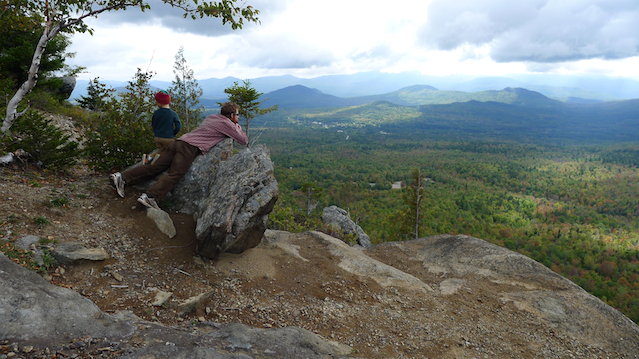
View from Field 5 facing south...or maybe the Adirondack Mountains.
We received the rain that we needed after 5 weeks of dry weather. Now, after days of cloudy misty weather we're again looking forward to some sun and drying out. These moist days interfere with the bleached white quality of the cauliflower which are huge and very prolific right now. Somehow we had overlooked the patch, thinking it wasn't quite ready for sustained picking, then were slightly overwhelmed by the 500 pounds that came out of the field on Tuesday, followed by another 250 pounds on Wednesday, and I expect to harvest another couple hundred pounds today. Harvesting this weight solo proves adequate daily exercise. Broccoli is waning but cauliflower should be around all week.
On the farm right now we're trying to deal with soooooo many crops that are ready for harvest, plus great roots that are already in storage. With the sustained heat of late September and early October, many of our crops raced to maturity instead of growing slowly as they typically do this time of year. Even with the dry weather all of our greens grew explosively (the price we pay I guess for improved soil conditions and fertility). Many of the greens are cut-and-come-again, but benefit the most when they're cut before they get too big. Since we currently have so many crops at our disposal to distribute, we're trying our best to craft shares that are hopefully most appealing to you, plus offer choices.
Any feedback on shares would be appreciated. Very soon we'll send you a survey to fill out.

October 8, 2017
Where's The Rain?
By Derek McGeehan
Where's The Rain?
By Derek McGeehan

(Rain) Dancing to Goose Creek Pioneers!
Last week was a busy one. Tuesday marked 4 weeks since any meaningful rain fell on the farm so I spent a couple of days setting up the infrastructure for and irrigating thirsty crops. I believe that all annual crops received enough ground water to keep them content for another week or two, depending on sun, heat, and wind. As of now we're forecast to receive rain today/tonight/tomorrow but I'm feeling a bit apprehensive. I'm prepared to celebrate in earnest when the precipitation finally quenches this dry patch of earth. Over the past few days forecast amounts went from 2" to now less than .5". If it doesn't rain I'll just go through another round of irrigating. Now that it's mostly set up it will be easier to apply.
Additionally, we harvested turnips, radishes, and beets for storage; harvested a mountain of broccoli and cauliflower for last week's and this week's distribution; finalized ground stakes' depth and pitch and erected arches for the hoop tunnel; prepared for and sowed cover crops; and plenty of other miscellany.

October 1, 2017
Time to Add Water
By Derek McGeehan
Time to Add Water
By Derek McGeehan
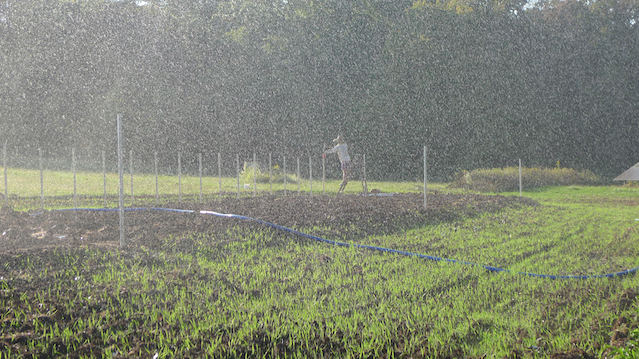
Swales around the replacement hoop tunnel are being watered again. The oats are thriving, but the regular grass seed wasn't too happy about the dry weather and 90 degree heat. At least the ground stakes are going in, hopefully straight/true/square/perfect.
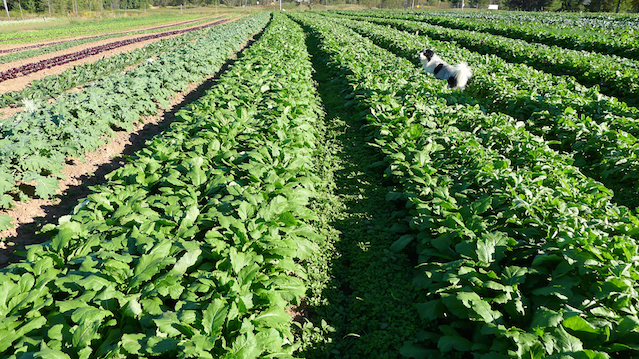
Farm dog Borchie contrasts the dark green salad turnip and radish greens. These crops are probably quite thirsty at this point. Plan is to overhead irrigate this field since most beds are smothered by canopies of greens, rendering application of drip tape impossible.
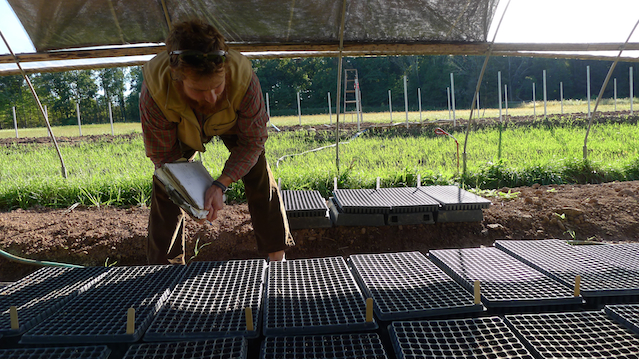
Checking on newly seeded crops for winter production: lettuce mix, claytonia, Swiss chard, spinach, mizuna, tatsoi, dill, and cilantro. These crops were seeded Friday 9/29, will be transplanted in early November, and harvested and eaten in December, January, and February. There are several successions of transplanted crops for the hoop house, hoop tunnel, and greenhouse, as well as a couple successions of direct seeded crops for the movable high tunnel (kale, arugula, mizuna, mustard greens).

September 24, 2017
Summer in Fall
By Derek McGeehan
Summer in Fall
By Derek McGeehan
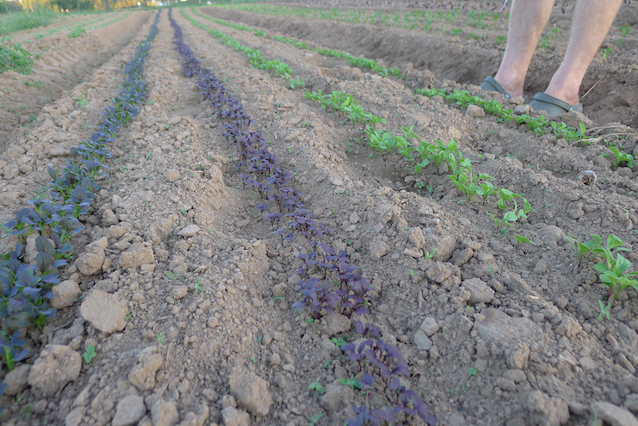
Two new beautiful varieties of mizuna/mild mustard greens in shades of red do look a bit thirsty.
This is the driest our soil has been all season long. We received just over an inch of rain almost 3 weeks ago and since then we've received .15 inches (which was almost 2 weeks ago). We added drip irrigation to the more sensitive water demanding crops of broccoli, cauliflower, and cabbage, mostly because they're all beginning to head up and reach maturity. Years ago I remember reading that the brassica family is less able to scavenge for moisture than, say, the lettuce family. Daily I think about adding water to all of the other crops but with this heat I'm a little worried that if I add water these late fall crops will grow too fast and reach maturity too soon. But, given the high temperatures and low humidity plus wind, crops and soil are drying out faster. For now, we wait and hope for some rainfall to take away this difficult decision.
Even though it is very dry, the sun is lower in the sky and is out for much less time than it would be in July. We also benefit from fields that face north, have high organic matter, and have good soil structure, properties that conserve moisture in the soil. As you can tell below, even after a hot and dry day the mature greens still look healthy and happy. That's a big field to have to irrigate!
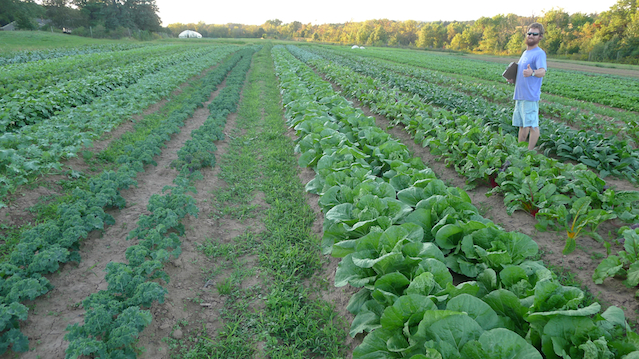

September 17, 2017
Covering the Equinox
By Derek McGeehan
Covering the Equinox
By Derek McGeehan
By this time of year a significant portion of the fields that grow our produce is already growing another type of crop that is fundamental to the health of our soil: a cover crop. It's a fairly generic term but is so important and vital to continued soil health and improvement that it warrants continual conversation, experimentation, and observation (and photos). We consider cover crops to be 'green manure' because they're a good substitute for traditional manure thanks to their ability to photosynthesize the sun's light energy and they're returned to the soil unharvested.
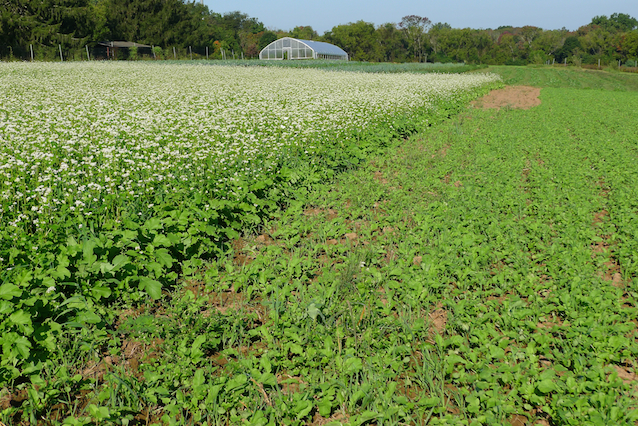
Above, a cover crop mixture of buckwheat, daikon radish, oats, and crimson clover was sown on August 11th and is next to the same mixture sown a few weeks later on August 29th. The older mix was sown after onions and the 3rd succession of summer squash and cucumbers. The younger mix was sown after the 1st planting of watermelon and the 2nd succession of summer squash and cucumbers. Because we use a tractor mounted spin spreader to sow the covers we wait until a minimum of 6 contiguous beds are empty of their cash crops.
The benefits of cover cropping were lodged into our brains a decade ago when we were aspiring new/young farmers. Over that succeeding decade we've developed and adapted a cover cropping scheme that works really well for us here, both in terms of our farming schedule and crop plan and probably most importantly in soil health and improvement. Along the way there was much trial by error and certain species were removed from out list of options. We still make some mistakes and learn, such as by allowing last year's buckwheat to go to seed and then dealing with the subsequent weed pressure of those volunteers this year.
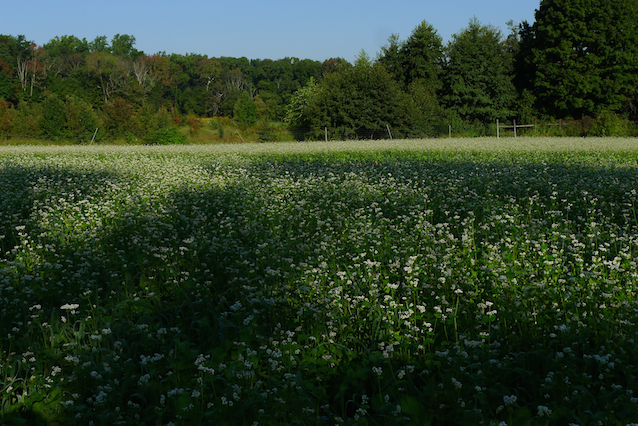
Above, this is an early morning scene of our favorite mix of buckwheat, daikon radish, oats, and crimson clover also sown on August 11th.
Sometimes it helps to work backwards when deciding on the species to sow. Ask: What are we planning to use this ground for later this season, next season, and does it need a long-term fallow rest? Later intentions help determine what to sow now. We've refined what we grow to a half dozen species: grasses/grains like oats, buckwheat, winter rye; legumes to fix nitrogen like peas and crimson clover; and a lone brassica, the mighty daikon radish. Our predominant fall/winter mix is buckwheat, oats, daikon, and crimson clover, mostly because everything but the clover dies off over the winter leaving the ground very usable in the spring. Depending on when we sow the clover it also dies in the winter. If we sow it mid-September or later it tends to regrow and flower profusely in late April or early May.
So, in relatively simple terms, our goals with a cover crop are: to protect the soil from compaction and erosion; scavenge for, incorporate, and then slowly release nutrients in the soil; transfer atmospheric nitrogen into the soil; flower to attract pollinators and beneficial insects; smother weeds; produce organic matter; and leave the soil in good condition for mild tillage in the spring.

September 10, 2017
Announcing: Late Fall CSA and Winter CSA Membership Now Available
By Derek McGeehan
Announcing: Late Fall CSA and Winter CSA Membership Now Available
By Derek McGeehan
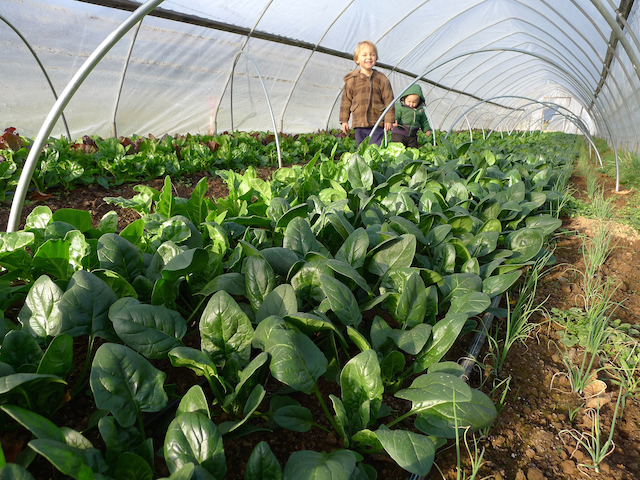
This photo was taken inside the hoop house on December 4th, 2016. Cold hardy spinach, chard, lettuce mix, Gabriel, and Abigail!
2017 Late Fall CSA
- Full, Medium, and Half Shares are available for the 6th annual 6-week season.
- Prices remain the same as last season: $180 for Full; $130 for Medium; $100 for Half.
- A deposit of $50 or full payment secures your share; full payment is due by November 1st; if you join after November 1st full payment is due to finalize registration.
- Pick up days are: Wednesday 1-8pm or Saturday 11am-12noon (you choose a day but you can switch temporarily by notifying us in advance).
- Begins immediately following conclusion of Main Season CSA Harvest Week #26 (Week B, week of November 5th).
- Late Fall Harvest #1 (Week A) is scheduled for week of November 12th.
- Concludes week of December 17th.
- No workshift discount/commitment.
- A cold hardy fall themed continuation of the Main Season share with tasty staples like chard, spinach, lettuce, radicchio, arugula, mizuna, tatsoi, bok choy, kale, collards, cabbage, Napa cabbage, cilantro, dill, parsley, leeks, garlic, scallions, onions, beets, radishes, turnips, carrots, celeriac, kohlrabi, potatoes, and sweet potatoes.
- Each cold season we make improvements to ensure a steady supply of fresh crops, not just storage ones. We now use 4 growing structures to extend the growing season; during our first Late Fall CSA back in 2012 we only had the high tunnel. So, our footprint has effectively tripled (each structure differs somewhat in size) and we now also add heat to the greenhouse for insurance/assurance.
- A Full Share receives approximately 8-12 pounds of produce weekly, a Half Share every other week, and a Medium Share receives 2/3 of a Full Share weekly.
- **During the week of Thanksgiving, Late Fall Harvest Week #2, Wednesday's pick up is on Tuesday, November 21st to accommodate travelers and holiday schedules (we'll accommodate your schedule, too)**. This is the only pick up anomaly.
- To join, log in to the website here; the 'join' button will be on the left hand side of your members page.
- Membership is limited and is at capacity at around 50% of the Main Season number so don't delay!
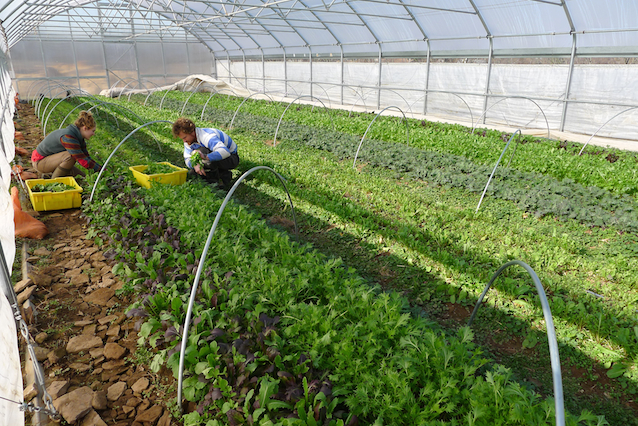
This photo was taken inside the high tunnel on February 18th, 2017. Look at those cold hardy tasty greens of mustard, mizuna, arugula, and kale (plus Hannah and Derek)!
2017-2018 Winter CSA
- Full, Medium, and Half Shares are available for the 2nd annual 10-week season (2 more weeks than last year).
- Prices remain the same as last season: $300 for Full; $220 for Medium; $165 for Half.
- A deposit of $75 or full payment secures your share; full payment is due by December 15th.
- Pick up days are: Wednesday 1-8pm or Saturday 11am-12noon (you choose a day but you can switch temporarily by notifying us in advance).
- Begins immediately following conclusion of Late Fall CSA Harvest Week #6 (Week B, week of December 17th).
- Winter Harvest #1 (Week A) is scheduled for week of December 24th - **This week only, Wednesday's pick up is moved to Thursday, December 28th, to accommodate travelers and holiday schedules (we'll accommodate your schedule, too)**. This is the only pick up anomaly.
- Concludes week of February 25th.
- No workshift discount/commitment.
- A cold hardy winter themed continuation of the Late Fall share with tasty staples like chard, spinach, lettuce, arugula, mizuna, tatsoi, bok choy, kale, collards, cabbage, Napa cabbage, herbs, leeks, garlic, scallions, onions, beets, radishes, turnips, carrots, celeriac, kohlrabi, and potatoes.
- Each cold season we make improvements to ensure a steady supply of fresh crops, not just storage ones. We now use 4 growing structures to extend the growing season; during our first Late Fall CSA back in 2012 we only had the high tunnel. So, our footprint has effectively tripled (each structure differs somewhat in size) and we now also add heat to the greenhouse for insurance/assurance.
- A Full Share receives approximately 8-12 pounds of produce weekly, a Half Share every other week, and a Medium Share receives 2/3 of a Full Share weekly.
- To join, log in to the website here; the 'join' button will be on the left hand side of your members page.
- Membership is limited and is at capacity at around 30% of the Main Season number so don't delay!

September 3, 2017
Out of Summer, Into September
By Derek McGeehan
Out of Summer, Into September
By Derek McGeehan
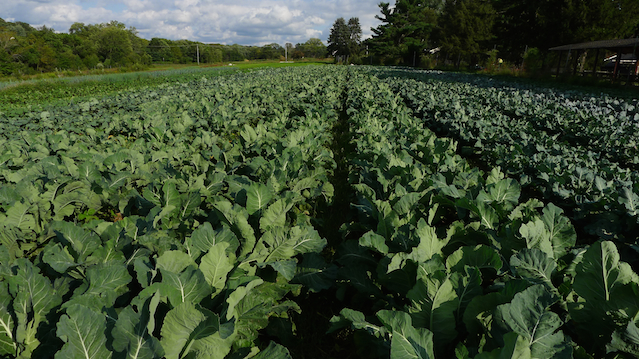
Fall crops doing well: cauliflower, broccoli, cabbage, kale, beets, leeks, chard, and celeriac.
Astronomically it remains summer, meteorologically we've moved to fall, and with a low of 44 degrees at the bottom of our field on Friday morning, one would assume that we're deep in October. Highs in the 60s for a few days, followed by forecast highs in the mid-80s to start this week, then a roller coaster plunge later in the week and the weather ride continues. Agronomically the summer crops are waning, the fall ones are thriving, and everything is growing a bit slower with the lower temperatures and reduced daylength. Internally, our thoughts drift more towards preparing for fall and winter harvests, knowing that our time to plant is coming to a close for another season. We're beginning to prepare the hoop house, greenhouse, and high tunnel areas for Late Fall and Winter CSA crops, even contemplating adding another tunnel to the farm. A cover crop mixture of oats, buckwheat, daikon radish, and crimson clover was sown over a significant portion of the farm last week, prior to the midweek rain event. That event plus yesterday's were the ideal way for rain to fall, slow and steady. Both deposited about a half-inch, a perfect amount for the farm and to get those cover crops up and growing. This season we've benefitted from practically an ideal amount of moisture without heat, approximately 4.5-6.5 inches per month from May through August. There was only one week in there that we had to wait until Friday to actively work with the soil. Thank you mother nature weather woman!

August 27, 2017
And the Potatoes Are...Harvested
By Derek McGeehan
And the Potatoes Are...Harvested
By Derek McGeehan
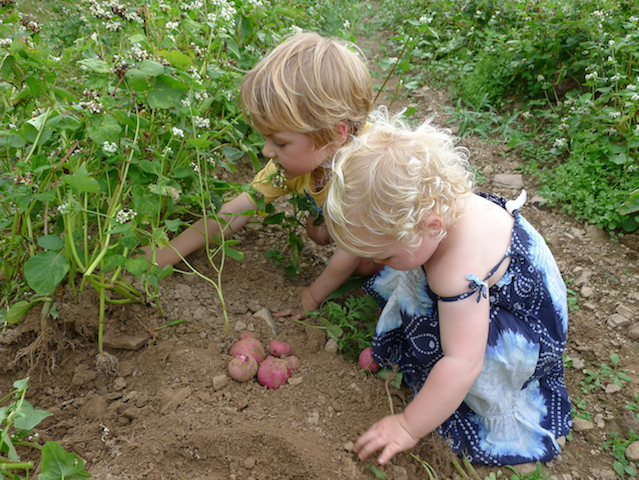
The above photo was actually taken a month or so ago when we were checking to see if the potatoes were ready to be harvested. In reality the kids didn't help harvest any potatoes this year, but about 60 CSA members and farm staff did, and we all are very thankful for the team effort.
A quick note on how to thoroughly enjoy the potatoes: cut in french fry shape, coat cookie sheet with olive oil, put potato slices on sheet single layer thick, drizzle a bit more olive oil on there, mix around with hands, sprinkle on salt, bake at 375 for an hour, and voila, the best homemade french fries ever (I promise)!
Some fun Anchor Run Farm potato facts:
- 8 varieties of potatoes were grown (Dark Red Norland, Satina, Nicola, Purple Viking, Harvest Moon, Elba, Strawberry Paw, and Butte). Two are early varieties, 3 are mid-season varieties, and 3 are late-season.
- 1750 pounds of potatoes were planted. 1500 pounds were purchased as official organic seed potato and 250 pounds were planted from our own stash.
- 6500 pounds of potatoes were harvested. The yield was just so-so this year, nothing epic. For us, an epic yield would be about 6 times the weight planted. The yield was much better in the part of the field that has been under our management longer, perhaps because of annual application of soil amendments. Blue potatoes yielded the worst while buff/yellow ones yielded the best (or perhaps are easier to see in soil).
- About 10,000 feet of raised beds were planted with a potato every foot on April 19th. The beds were cultivated in late-May and hilled in mid-June. Hilling the raised beds involves pulling an implement with that tractor that uses two sets of discs to pull the soil up onto the plants which gives the potatoes more room to grow.

August 20, 2017
Through the Fields We Go
By Derek McGeehan
Through the Fields We Go
By Derek McGeehan
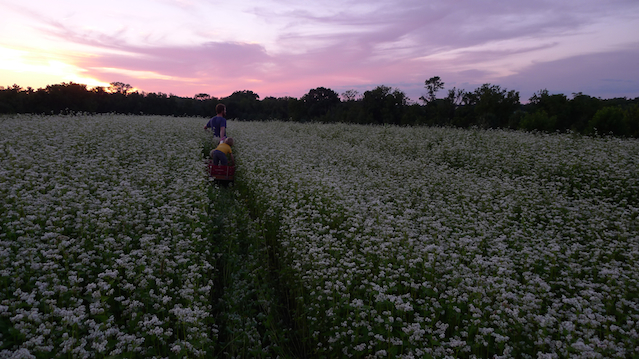
Meandering through a buckwheat field towing a wagon then playing hide-and-seek during sunset with the kids - what's better?
This could be my favorite time of year. The workload changes into more harvesting, clean up, and sowing of cover crops, which are all steps taken towards getting the farm ready for the 'off' season. Parts of the farm get put to sleep for six months or more. The end is in sight. The reward for many months of very hard work and long days under the sun and in the rain is the harvest and distribution of great produce. We slowly regain control (to our eyes and minds) by mowing 4-foot tall amaranth and lambs quarter that laugh at us because they dropped 10,000 seeds, offspring we'll battle with next year. Now, though, it's mowed, chiseled, and replaced by our intentional communities of buckwheat, daikon radish, oats, and clover. Instead of having to actively manage, say, 10 acres of actively growing produce, it's reduced to 5 acres. Our perspective, our focus, narrows. We can sit back, walk around the farm, admire more of its beauty that we participate in sculpting. We feel thankful for the enhanced biodiversity that our diversified farm allows for. This and that said, throw in a tropical storm and a hurricane, dump 24 inches of rain on us in my favorite two months like way back in 2011, and I might feel differently. For now, though, I feel lucky, thankful, fortunate. I hope you are able to enjoy the farm when you pick up and pick your produce.

August 13, 2017
Planting and Harvesting
By Derek McGeehan
Planting and Harvesting
By Derek McGeehan
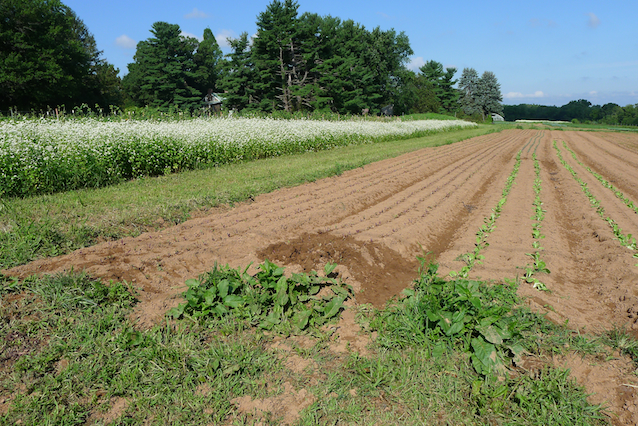
From our perspective as farmers it's been a good year of harvests so far, and hopefully you our members feel the same way. Chalk it up to the pretty decent overall weather we've had, plus soils that are really showing the responsiveness to years of tender loving care with additions of organic matter through cover cropping and compost, mineral amendments, appropriate diverse fertilizer applications, fallow periods, reduced and adjusted tillage techniques, timely cultivation and weed management, and just plain old accumulated experience and better decision making. Trust us, it takes time to really understand and work with the farm-as-ecosystem but we've put in our time here. However, much is weather derived of course, and this year (so far) we're reaping the benefit of a reasonably kind weather pattern, or we've just been plain lucky that some of the torrential rains have missed us. The farm also benefits from many hard workers, our staff, our work-traders, and our CSA members. Thank you for your continued support and trust!

August 6, 2017
Into August, Into Cooler Temperatures...
By Derek McGeehan
Into August, Into Cooler Temperatures...
By Derek McGeehan
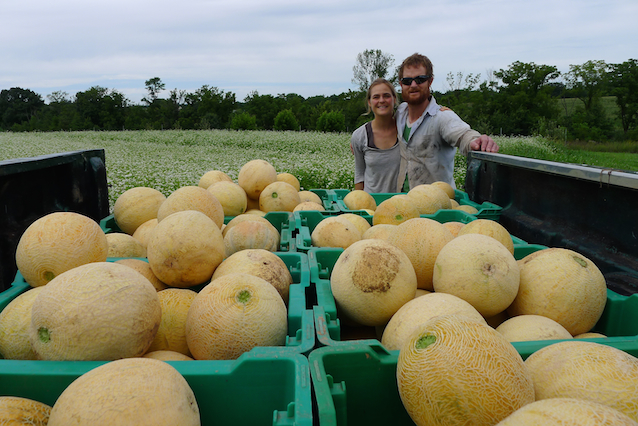
Snagging a photo of ourselves, sans kids, working outside on the farm, happens very infrequently these farming days, but this time we're all smiles after harvesting a satisfying amount of a cantaloupe-type melon, a crop we're still determined to grow successfully with good yields and good taste. The variety this year appears to be a winner, though there are so many variables affecting a crop that it's hard to say if it is specifically the variety. It could also be our extra attention, kind weather, fertile soil, or all of the above. When cantaloupe-type melons begin ripening the patch must be checked daily or every other day because they ripen very quickly, almost uniformly, and quickly deteriate outside.
Watermelon, on the other hand, are slightly less temperamental in our minds, tolerate slightly more stress, and can hold in the field much longer when ripe. Too much water on an almost mature crop, though, can quickly kill the plants leaving almost ripe fruit to fend for themselves under the sun. This year we grew two plantings of watermelon, one of which has already been successfully harvested and stowed and will be distributed over the next couple of weeks. Round two is about ready so hopefully it will tolerate the incoming moisture inundation.
Onions are 95% harvested and safely stored. Next on the harvest to-do list is embarking on the 10,000 feet of potatoes. We're anticipating a good crop this year.

July 30, 2017
Into August We Go
By Derek McGeehan
Into August We Go
By Derek McGeehan
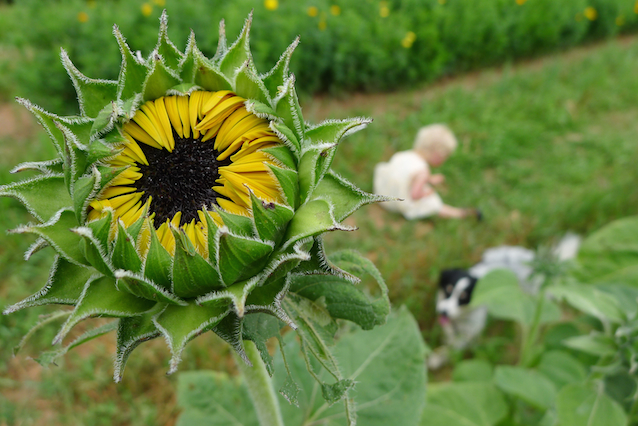
Today's weather feels like the best we've had in weeks. I'm very much looking forward to working with some dry soil early this week, getting the ground ready for more of our fall plantings. After being unable to do much with the soil last week due to the perpetual cloud cover, humidity, and cool weather which kept the ground moist, we did manage to transplant the 2nd round of broccoli, the first rounds of kale, beets, and chard, as well as the weekly lettuce planting on Friday afternoon.
We're also beginning to clean up spring and early summer crops and sow cover crops. Buckwheat was sown a couple of weeks ago where strawberries, kale, kohlrabi, cabbage, and lettuces once grew. Because of all the rain and heat and sun it's already 2 feet tall. Soon it will be covered in smelly flowers attracting all types of pollinating insects. Before it drops seed we'll incorporate it into the soil as a 'green manure' and then sow another cover crop, either an overwintering one like crimson clover or a winter killed one like daikon radish and oats. Very soon we'll embark on the potato harvest, which will be collected over a month or so.
Watermelons were retrieved last week and should be in the harvest for a few weeks. In about 2-3 weeks our 2nd planting of watermelon should be ready, as well as our cantaloupes, if all goes well. At the end of August the early varieties of winter squash should begin to grace our tables as well. Hooray for good food!

July 23, 2017
End of Steamy Heat Wave
By Derek McGeehan
End of Steamy Heat Wave
By Derek McGeehan
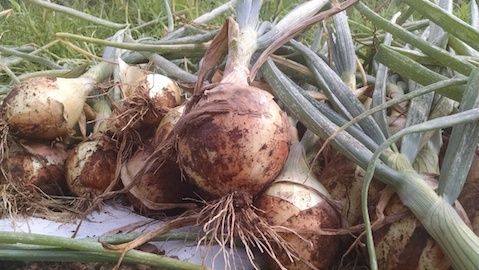
Amid this heat wave we had a satisfyingly productively sweaty week on the farm. Two thousand five hundred pounds of carrots were successfully harvested by the farm crew and CSA members after the tractor loosened the soil for ease of harvest. We'll all be enjoying this heirloom carrot variety known as Red Cored Chantenay for a couple of months. One thousand two hundred pounds of fresh sweet onions, also an heirloom variety, were pulled, trimmed, and stowed for distribution as well, about one-third of the total onion harvest.
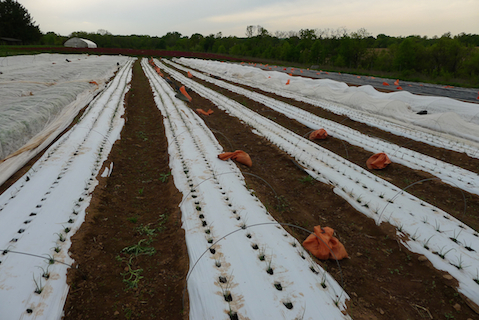
Carrots and onions are two of the most challenging and sensitive crops that we grow so we're thrilled and extremely happy when we harvest a successful crop. They're also two of the most beloved and common foods. I should add that they also used to be some of the most labor intensive crops to grow. After some tweaking of growing methods, especially with the onions, we've begun to realize important improvements in yields while improving farm efficiency. In an attempt to have enough onions for the CSA we used to just try to grow too many. Instead of doing that this year we reduced the amount we grow by 20%, grew two instead of one per hole (therefore reducing the onion patch footprint by half), planted them into white plastic which deters some bugs, used two lines of drip tape irrigation instead of one, and following transplanting used hoops and row cover to shield the plants from a new invasive pest for their first month outside in the ground. Above is what the patch looked like in mid-April and below is current.
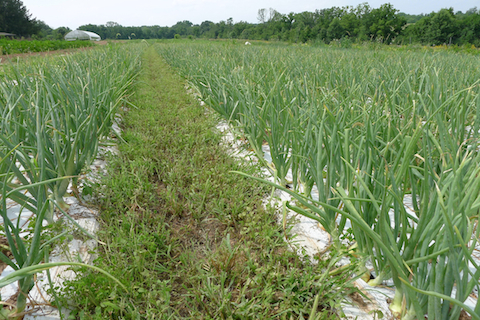
Regarding carrots, we've learned to use specific varieties that are somewhat shorter with tapered roots that perform well in heavy soils. We've also learned that if we seed them at appropriate spacing we may be able to avoid thinning, which takes A LOT of time. Carrots fortunately don't have much disease or pest pressure, so if we can stay on top of the weeds through cultivating and hand weeding we can generally rely on a crop (as long as we don't receive copious amounts of rain when they're practically mature and beckon for retrieval, which almost happened at the end of last week). Because they take up to 3 weeks to germinate and require the soil to remain moist we normally add a layer of row cover to slow down evaporation. Covering the soil, though, heats it up and can sometimes stimulate weed germination and growth that outpaces the carrots. So, some timely and very careful early cultivation is absolutely necessary to avoid losing the crop before it is barely established. The crop this year was cultivated three or four times and handweeded at least once.

July 17, 2017
Big Harvest Time
By Derek McGeehan
Big Harvest Time
By Derek McGeehan
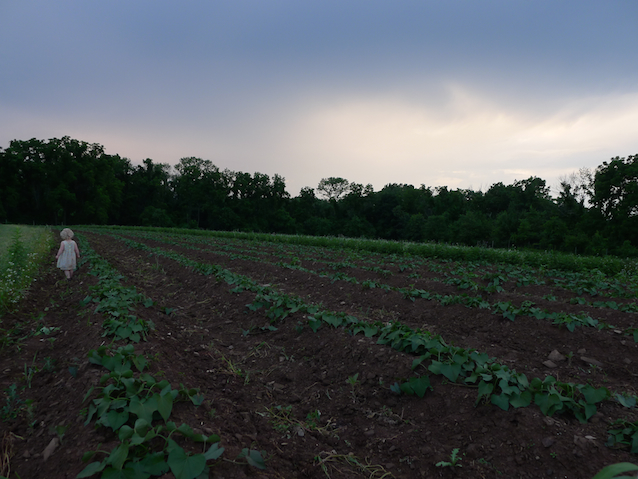
Sweet potatoes growing well on aggressively hilled beds. They've been weeded once with a workshift and cultivated twice with a tractor. Soon their vines should smother competitors, but not Abigail.
It's the time of year when we focus slightly more on the harvesting of crops that went into the ground months ago, were nurtured, cared for, protected, cultivated, weeded, and watered and now come out of the ground and fields to fill up the barn, the cooler, eventually your fridge and tummy. The garlic harvest symbolically commences the beginning of summer and fall bounty, but it really begins with the epic summer squash and cucumber yields that practically come all at once over a relatively short period of time, even though there are three plantings spaced a month apart. Soon these crops will deteriorate due to bug and disease pressure, so love them now!
Up next will be the great carrot harvest which will begin whenever the ground dries out enough after last week's rainfall, hopefully this week with the aid of heat. Following carrots will be watermelon, then onions, potatoes, winter squash, sweet potatoes, etc.
Sometime during the next couple of months tomatoes will hopefully peak in the upper single digits per member per week for some weeks and should be in the harvest for a few months. Look for gnarly and beautiful and richly flavored heirloom tomatoes from our high tunnel and red round traditional tomatoes grown in the field (which taste great too)!

July 9, 2017
Rainbow Tomato
By Derek McGeehan
Rainbow Tomato
By Derek McGeehan
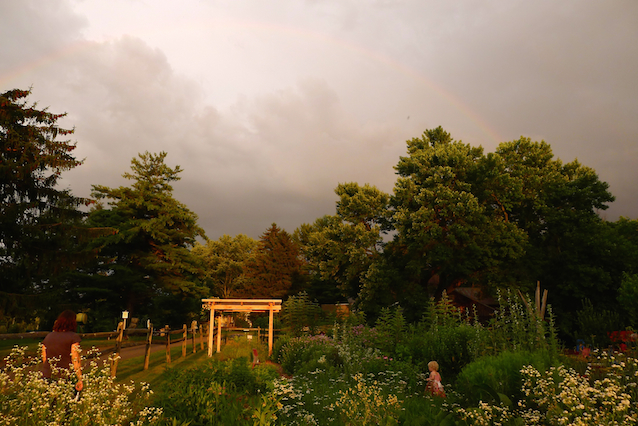
It was a busy, fun, and eventful week and weekend on the farm. It was a holiday week with some rain so we were able to slow down a bit and give the crew some time off. There's a brief period in early July when we're between the Big Planting and the Big Harvesting when there's an ever-so-slight lull where we can breathe easier and rest up a tad for the final push of the season. It was brief, however, and the Big Harvest began today with the garlic, always a good community endeavor. Last night we celebrated with the second potluck of the season, had a wonderful meal, learned about kefir making, and saw some rainbows. This week we'll begin planting cabbage, broccoli, and cauliflower for the fall; soon we'll harvest carrots and onions; and pretty soon potatoes will be ready. And, tomatoes are starting to ripen!

July 2, 2017
It's July
By Derek McGeehan
It's July
By Derek McGeehan
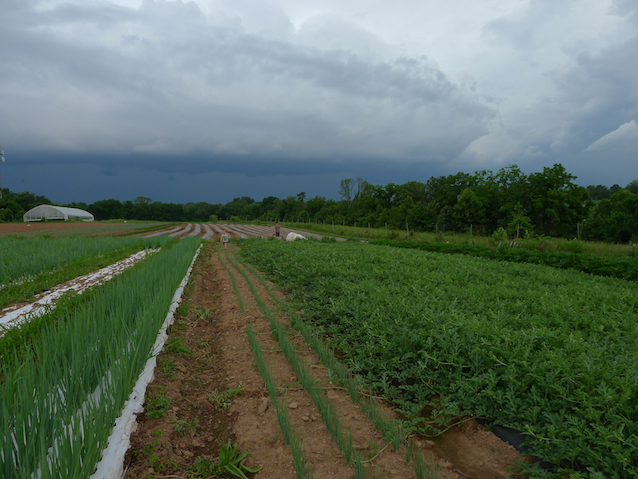
Rain was welcomed at the farm on Saturday evening and along with it we enjoyed some nice displays of lighting and a beautiful sky. It did chase us out of the field prematurely but safety always comes first. On the right in the photo is our monstrous bush of watermelon vines that appear to have been planted into some very fertile and well fed soil. Uphill and on the left is our allium patch of scallions, fresh onions, and storage onions. Thus far the health and vigor of the plants seems to have truly benefitted from the extra attention earlier in the season to deter various damaging insects. The white plastic repels some and the floating row cover was a barrier to others. The watermelon received extra attention as well. Of course it was started in the greenhouse, nurtured there for 4 weeks, then transplanted into raised beds covered in black plastic for heat and weed suppression. The aisles were manually covered with 4-foot wide landscape fabric that was stapled to the ground. Hoops and floating row cover then went over the entire patch to keep other bugs off the plants until they were truly established and flourishing. All of this is done in an attempt to have a great harvest. Growing organically is challenging and difficult, but with the right planning, tools, and resources, as well as a lot of extra work, it can be done successfully.

June 25, 2017
Introducing Lauren and Becky
Introducing Lauren and Becky
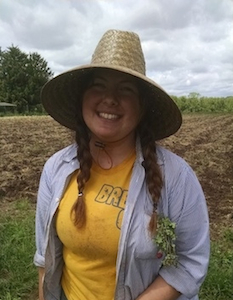
Lauren Rosse is excited to work as an intern at the farm and learn more about organic produce production. She was introduced to the farm by field manager Hannah and her family; Lauren's parents are now also members of the CSA. Lauren graduated from Council Rock North in 2014 and is currently an environmental studies major at the University of Pittsburgh. She has previously worked at Howell Living History Farm in Lambertville NJ, and Garfield Community Farm in Pittsburgh PA. Lauren hopes to continue working on organic farms and keep learning about sustainable farming practices.
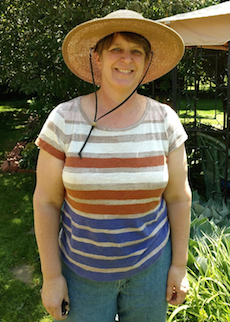
Becky Conner is a native of Newtown and has been a member of Anchor Run since the 2016 season. She discovered the farm when her daughter, Hannah, became the Field Manager and has now fully embraced CSA life! Becky is thrilled to be helping out in the pick up room and, as a long time gardener, looks forward to continuing to learn about growing food!

June 11, 2017
2017 Farm Crew
By Derek McGeehan
2017 Farm Crew
By Derek McGeehan
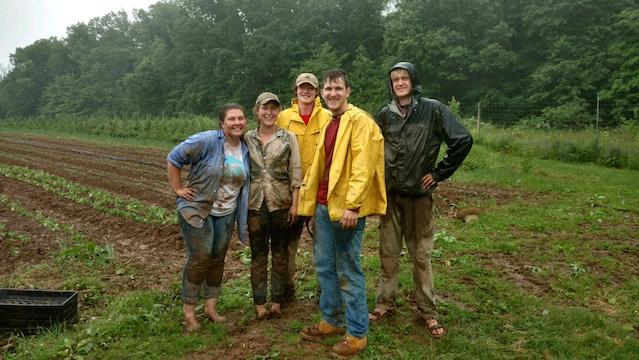
The 2017 Anchor Run CSA farm field crew smiling after transplanting beans in the warm rain: Lauren, Hannah, Pat, Joe, and John
Over the next few weeks we'll introduce individual members of the crew to the Anchor Run CSA community. For more information check out our Farmer Bio page.
Field manager and crew leader Hannah Stocker joined the team of growers at Anchor Run Farm in the winter of 2016. She and her husband, Jason, along with their dog, Honey, live on site in the White Pine Ranch. They are so happy to call Anchor Run their home, and they hope to be a part of the farm for years to come.
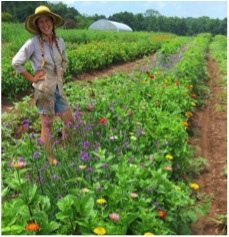
Hannah first cultivated her love of plants and fresh food in her grandfather's and mother's gardens at her childhood home in Newtown borough. Inspired by these memories, she explored her interest in the natural world by taking jobs doing landscaping and working at a perennial plant nursery and even a flower shop. Her passion for things that grow also lead her to pursue a degree in Horticulture. Like Derek and Dana, after acquiring her Bachelor of Science, she ventured to the Washington D.C. area. While there she became immersed in Organic CSA farming at Clagett Farm, operated by the Chesapeake Bay Foundation. After more than 3 years of honing her farming skills at Clagett, she decided to return to her roots and help feed the community she loves in Bucks County.
Hannah's role as field manager allows her to work closely with Dana and Derek and experience the scope of challenging and humbling tasks that are required to keep the farm running. As Derek once said, she is a wearer of many hats, requiring her to oversee everything from the seasonal staff to marketing to barn organization! Each day Hannah falls more in love with life here on the farm, and she is so thankful to the amazing community that allows Anchor Run to be so successful!
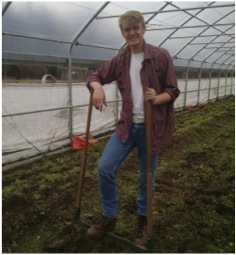
Assistant Farmer John Conner is a Bucks County native, heralding from down the road in Newtown. He first learned of Anchor Run CSA from his sister and field manager, Hannah. John graduated Council Rock High School North in 2012 and The Pennsylvania State University in 2016 with a Bachelors of Arts in English. Besides working at Anchor Run, he is currently undergoing discernment for a vocation to the priesthood in the Episcopal Diocese of Pennsylvania. He is an avid reader, runner, and Dungeon Master and is excited to be helping the members of his community by providing them with fresh food.

June 4, 2017
A Week's Worth
By Derek McGeehan
A Week's Worth
By Derek McGeehan
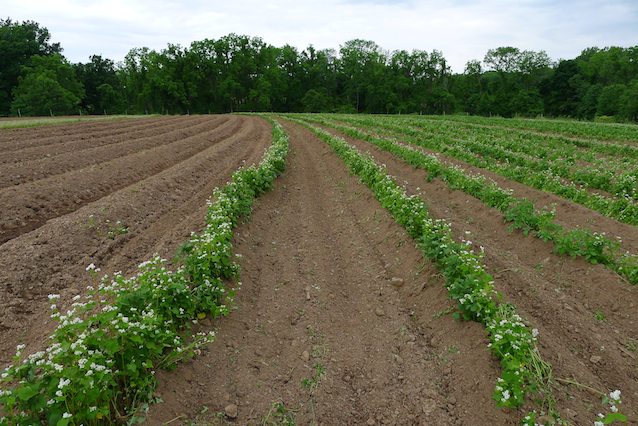
Above, those are freshly hilled potatoes mixed with a volunteer stand of flowering buckwheat, which sprouted and grew this spring following last year's cover crop that went to seed during the warm autumn. By the way, properly hilled potatoes support additional growth for the tubers, since they mainly grow around and above the seed potato. Around 2 miles of potatoes were hilled yesterday, and each bed was hit twice in opposing directions, so I basically drove the tractor for 4 miles in the field on a blindingly sunny day. I did miss my misplaced sunglasses. South or to the left of the greenery are fairly aggressively hilled beds that were just planted with 3000 sweet potato slips/seedlings. Those will appreciate the anticipated moisture arriving Sunday-Monday.
The sun returned last week and we were finally able to cultivate many, many crops and transplant a multitude of new ones including edamame, lettuces, summer squash, cucumbers, as well as the aforementioned sweet potatoes. Here's a list of what was cultivated: basil, dill, cilantro, two bean plantings, flowers, lettuces, beets, and chard.
Some big upcoming jobs include pruning and trellising tomatoes, continued cultivation, harvesting of course, a lot of ground preparation for current and mid-summer plantings, as well as transplanting winter squash, cantaloupe, watermelon #2, beans #3, tomatoes #2, lettuces #11, basil #2, dill #3, cilantro #3, parsley #3, and sunflowers #2.

May 28, 2017
At the end of May
By Derek McGeehan
At the end of May
By Derek McGeehan
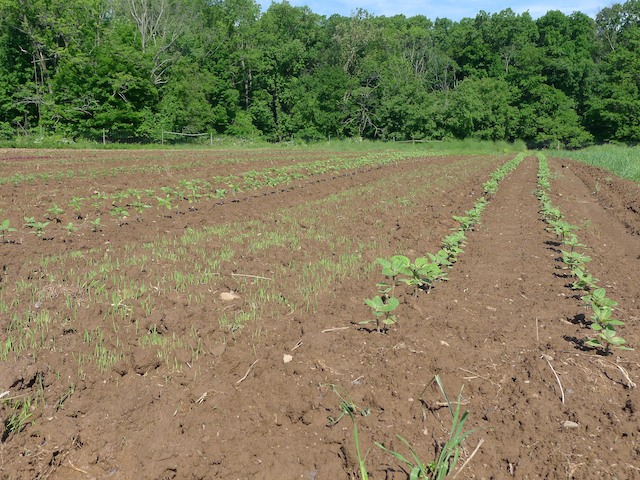
Seen above, the u-pick flower garden is up in Field 1 this year, the original CSA field first cultivated in 2004, and should begin flowering in late June or early July. Most u-pick crops will be in Field 1 this season including strawberries, peas, beans, edamame, tomatillos, husk cherries, cherry tomatoes, basil, dill, cilantro, and parsley. Raspberries and perennial herbs are closer to the parking lot. Last year we began rotating the flowers along with the other u-pick crops in order to keep everything closer together, as well as to be able to increase the amount of flowers grown and provide greater space between rows and raised beds. This year, we even went a step further and sowed oats on the off beds to feed and protect the soil and have more control over what is growing there. After mowing, it will hopefully provide more comfortable conditions in the field for you the members. We also took the same steps for the vining and sprawling tomatillos and husk cherries.
We're still firmly in spring but summer crops aren't far away. Summer squash is starting to flower and will probably arrive in shares in a week or two. Perpetual favorite hakurei turnips will begin arriving in shares later this week and beets will grace us either next week or the week after. Lettuces are also going to arrive in earnest this week, along with all of the other tasty spring greens. Baby kale will be here and probably the last of the spinach, which doesn't enjoy wet feet and all of last week's rain. Speaking of rain, we've had over 6 inches in May, which is a lot. That is the most in May here since 2009. Either way, the crops and farmers are thriving.

May 14, 2017
A Day in the Farm Life
By Derek McGeehan
A Day in the Farm Life
By Derek McGeehan
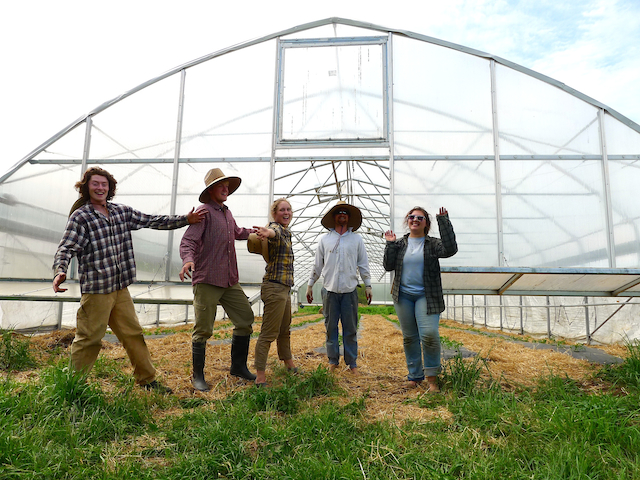
As you can see we were quite excited and relieved to have successfully pushed the 30'x96' high tunnel 200' uphill into an easterly wind with 6 strong farmers (Dana took the photo). Under protection are the heirloom tomatoes. This moveable beast allows us to properly rotate crops using the three positions; lets the soil interact with the weather and climate when not covered; and gives us 2 or 3 protected moves a season. After the heirloom tomatoes wrap up in late summer we'll slide it to another position to protect greens for the winter and then sow a nourishing cover crop of rye and vetch where the tomatoes were.
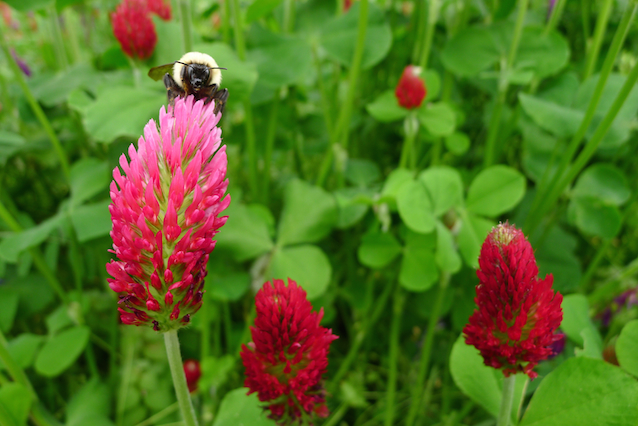
It was with heavy heart that we had to say goodbye to our flowering crimson clover last Friday before the big rain event. This cover crop was sown along with oats and buckwheat last fall. The oats and buckwheat winter kill from the cold while the crimson clover hibernates and begins growing again in the spring, flowering in late April or early May. The bumblebee enjoyed the blossoms. Fortunately for the nectar loving pollinators there are patches of the clover left around the farm, as well as volunteering buckwheat, and soon our 2.5 acre pollinator habitat should be blooming with a variety of flowers.

April 30, 2017
Welcoming Incoming May
By Derek McGeehan
Welcoming Incoming May
By Derek McGeehan
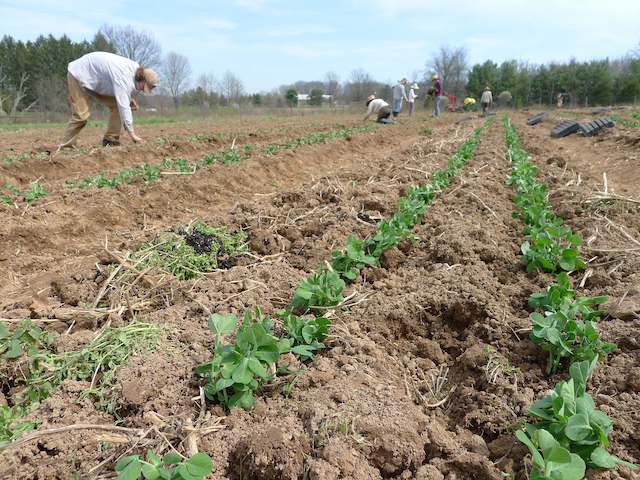
Transplanting patient peas a week later than normal due to the wet weather.
May arrives this week which means we're almost halfway through spring already. It seems like just yesterday we had snow on the ground, received too much subsequent rainfall, and desperately waited for the ground to dry out enough for planting. Just when we couldn't wait any longer the weather pattern changed and we had a few weeks of relatively dry weather. Because of the wet second half of March and the first week of April we basically had to do a month's worth of work in about two weeks time. Early April through mid-May is probably our busiest ground preparation and planting time. A lot of crops go in the ground during this timeframe, both for early and middle of the season harvest. Many crops go in successionally either weekly or biweekly or monthly like lettuces, beets, chard, spinach, scallions, dill, cilantro, parsley, summer squash, cucumbers, and greens, but many large plantings of one-timers go in also such as onions, potatoes, peas, tomatoes, peppers, cabbage, kale, radicchio, and winter squash. We're extremely busy and it feels good to be outside planting and making progress towards the upcoming harvest season.
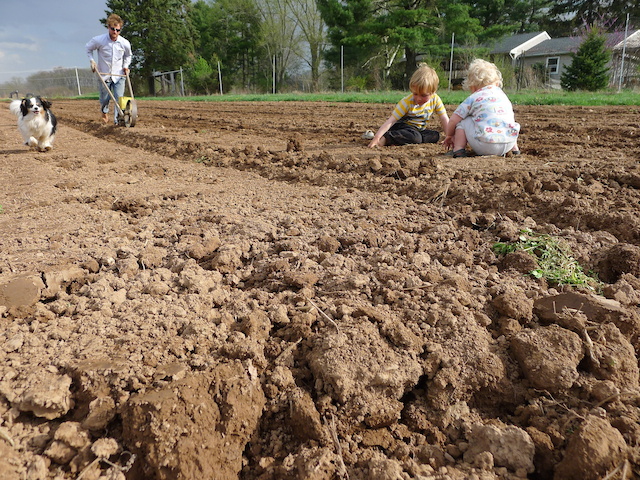
Direct seeding kale, arugula, broccoli raab, mizuna, mustard, radishes, and turnips.

March 31, 2017
Spring is Here
By Derek McGeehan
Spring is Here
By Derek McGeehan
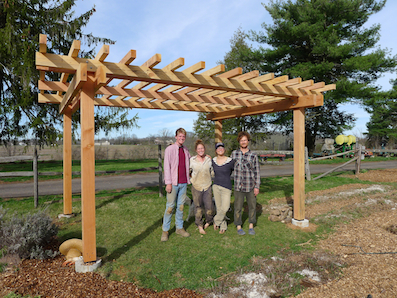
Early season crew, John, Hannah, Dana, and Derek, under the newly completed pergola built in honor of our beloved friend, herb gardener, herbalist, Jeannine Vannais, who passed away in early 2015.
Welcome to the 2017 Main Season CSA at Anchor Run Farm
It's the first full week in April and that means that the race is about to commence. We're worshipping the sun whenever it graces our skies and are hopeful for a solid week of glorious sunshine accompanied by a few windy days to dry out the soil just enough in order to begin preparing raised beds and planting our anxiously awaiting transplants. Over the past nine seasons we've begun our outside springtime growing adventures during the first week or two of April. What began as an early spring in February transformed into a late spring in March and as we enter April we're at least safely into springtime temperatures albeit with plenty of moisture. With increased warmth, longer day length, a higher-in-the-sky sun, and perhaps the waking of the perennial vegetation we're eagerly hoping the ground dries out faster.
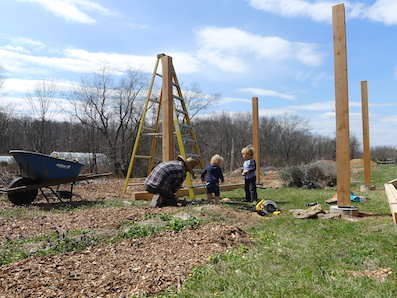
Pergola in progress
Because we're unable to transplant or directly sow seeds into the fields we've been able to focus our springtime energy on other areas of the farm that would ordinarily lose priority to the field crops. Extreme sprucing up of the herb garden, creating a new flower garden right outside of the pick up room, building a pergola, and beautifying the pick up room are some of the jobs we've been immersed in.
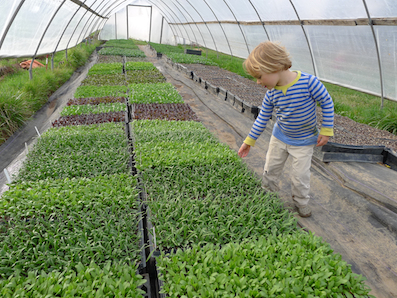
Patient transplants hardening off in the hoop house
We're looking forward to welcoming you back to the farm this spring - hopefully CSA pick ups will begin in mid-to-late May. Open House/Orientation Day is scheduled for Sunday May 7th 10am-2pm. Workshift opportunities should begin sometime in April. See you soon!

February 20, 2017
Grateful For Our CSA Members
Grateful For Our CSA Members
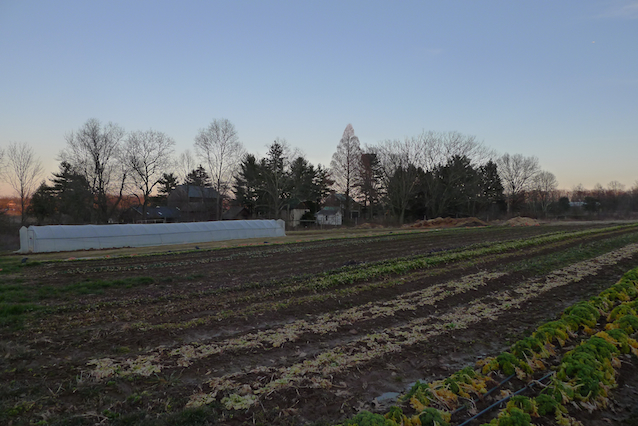
Perhaps it is fitting that the final week of the 2017 Winter CSA will feature April temperatures and really invoke that springtime feeling. It's hard to not become a bit more energized and anxious to begin the next growing season. Typically we fire up the greenhouse and begin seeding in there the week of March 1st and begin transplanting and sowing outside the week of April 1st. With this weather it's quite easy to want to expedite the schedule and get started now. We will begin preparing the high tunnel beds for a March 1st carrot sowing. We'll have to mow and remove most of the leftover organic matter from the winter greens in order to sow the carrots on the raised beds. Last year was the first time we sowed carrots a full month earlier than our typical April 1st date and they did very well in the rocky raised beds of the high tunnel.
Thank you Winter CSA members for supporting us during the inaugural 8-week January and February share - we truly couldn't have done it without you!
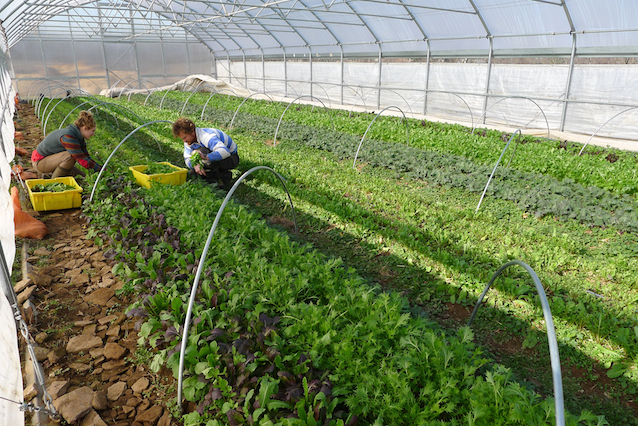
The final week of harvesting high tunnel greens!

February 12, 2017
All in a Week
All in a Week
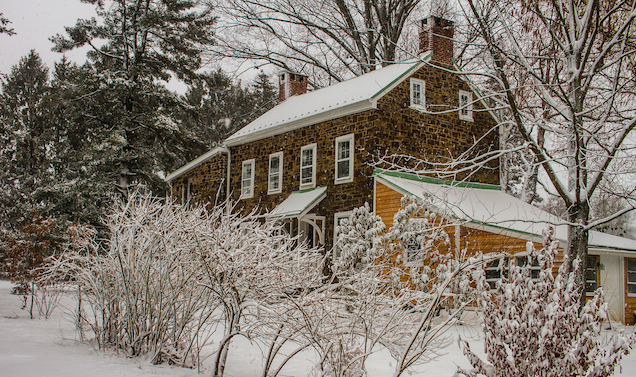
A Bucks County winter farmhouse scene (photo courtesy of Jason Stocker).
A couple days near 60 degrees with a snowstorm sandwiched between. A return to cold and dreary today, but at least the snowfall looked appealing for a day or two. Inside the growing structures springtime has arrived. The higher-in-the-sky sunshine significantly warms the insides and, unopened, reach 80 degrees easily. Pretty soon some of our earlier sowings may begin thinking about reproduction, changing their flavor profile from sweet to bitter, reminding us of their goals during their brief existence. We thank them for enriching our lives this winter by providing a steady flow of greenery and nourishment. One final frontier of experimentation this time of year is observing whether or not the winter greens can sustain their viability through the month of March. We want to determine the feasibility of a Winter CSA running mid-November through March next time around the sun, potentially combining the Late Fall and Winter shares into one longer 20-week season.
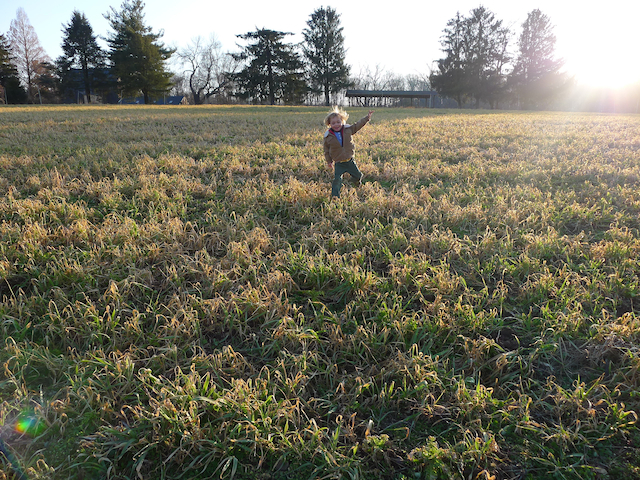
Before the snow and cold arrived we enjoyed an early spring-like evening walking (and frolicking) around the fields in anticipation of the upcoming 2017 growing season.

February 5, 2017
Classic Winter Morning
Classic Winter Morning
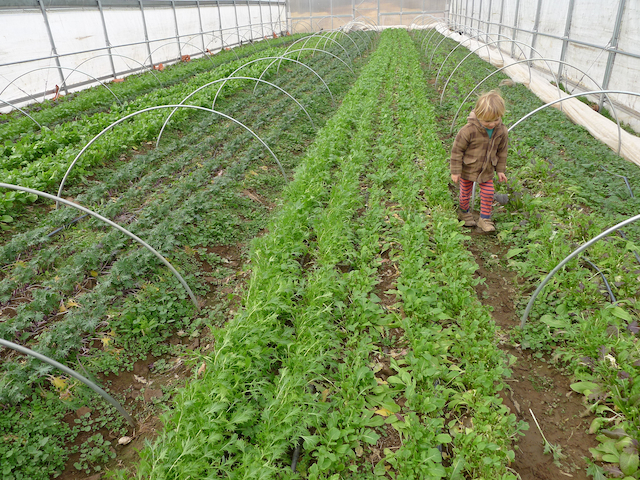
Gabriel walks down the aisle between the second seeding of of mizuna, arugula, mix, and kale.
Crisp, clear, and cold on an early February morning, how it should be once in a while at least. Temperatures returned to the teens for the first time in a while but at least the sun has risen and is shining. Day length is noticeably longer now. Seems to me that just in the past week we've added about an hour though of course it steadily lengthens. Pretty soon there'll be an extra bounce in our steps as we meander the farm and prepare for the upcoming growing season. Fortunately there's another solid month of winter but once March arrives the 2017 Main Season officially commences with seeding in the greenhouse and direct seeding carrots in the high tunnel. Between now and then we'll continue harvesting fresh greens from both structures plus the hoop house and in between freezes during thaws we'll check outside hardy crops like spinach and kale for potential distribution.

January 29, 2017
Here Comes February
Here Comes February
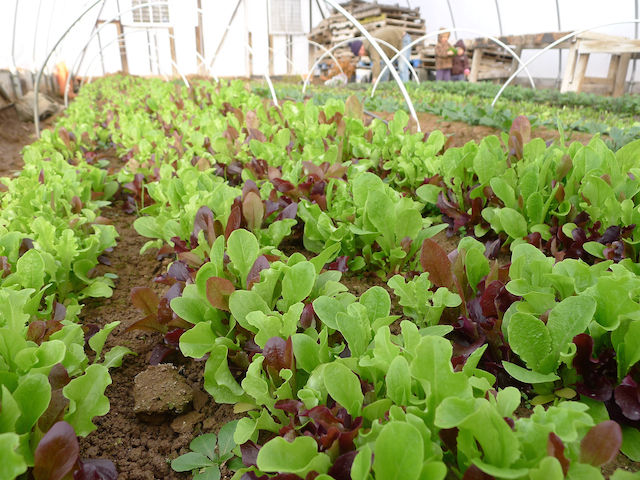
Yankee Hardy Lettuce Mix Blend looking vibrant in the greenhouse; its 1st cutting should take place this week. We'll also probably take a second cutting from the hoop house shown below if needed. Spinach should come from the field - amazingly - as well as the hoop house.
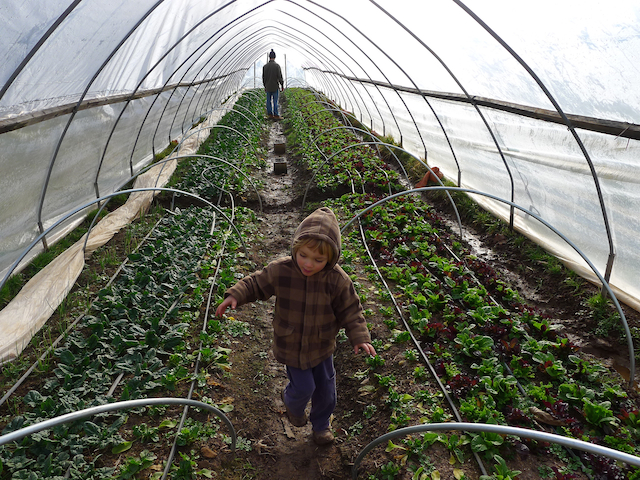
With the arrival of a new month, a calendar page flip, winter's midpoint, seasonal unexceptional cold returns, descends. Crop structures will need to be closed and sealed up before nighttime to trap daytime heat. We'll probably also add interior covers as well, as added insurance. All of these crops have experienced deep lows already so they should be prepared for this round of cold. Very soon daylight will lengthen beyond the 10-hour mark and will increase rapidly to the 12-hour equinox in March. During February we're anticipating accelerated crop growth which will hopefully translate into additional fresh greens in the share.
We hope you've been enjoyed the winter share thus far. If you have any comments or suggestions (or criticisms) for us please send them our way!

January 22, 2017
Continued Growth
Continued Growth
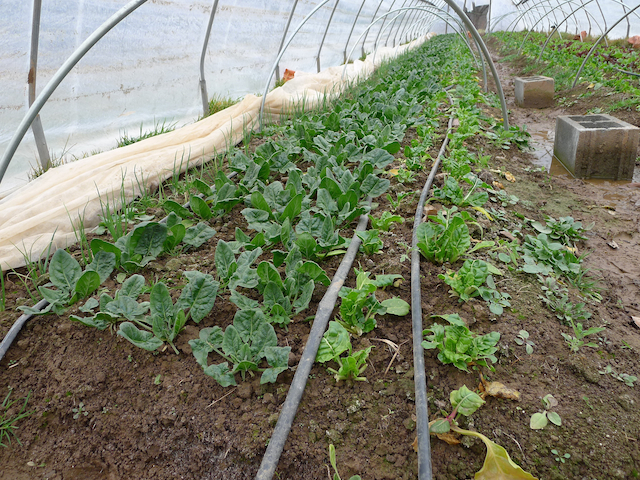
Spinach and chard re-growth in the hoop house; slow growing scallions, too
Is this a mild winter or a mild stretch of weather? I think I can remember a few nights of single digits. We're almost at the end of January and March is only a month away, which basically signifies the beginning of mental spring. The northeasterly winds of last winter dumped two feet of snow but today we're looking at rain. Protected crops are growing and we're keeping records and collecting growth data to better plan for future seasons. We're busy contemplating improvements for the 2017 Main Season and wrapping up leftover jobs from this past year. The warmer weather and unfrozen, albeit constantly wet and squishy, ground enables us to spend more time outside. Crops are easier to harvest when our fingers aren't frozen. Washing is manageable when pipes aren't blocked with ice. Are we spoiled this year or would some deep and long cold be good for the fields and spirit? Of course we have to take what comes, what we're given. All we can really do is plan, assess, reflect, and act. What will the rest of 2017 bring?
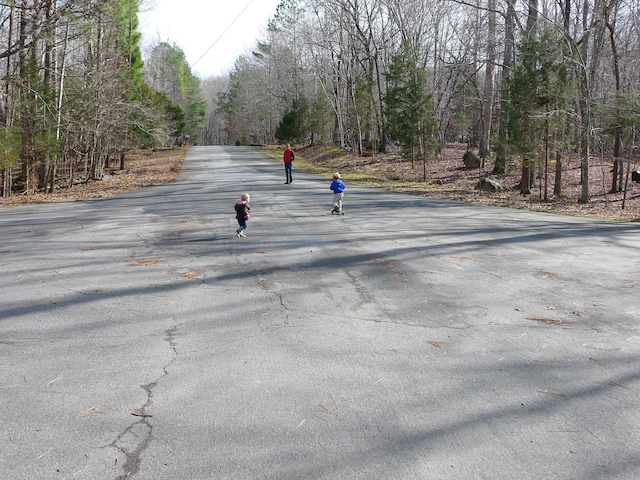
We enjoyed a short family trip to balmy NC to greet a new niece and play outside!

January 15, 2017
Whether We Weather The Weather
By Derek McGeehan
Whether We Weather The Weather
By Derek McGeehan
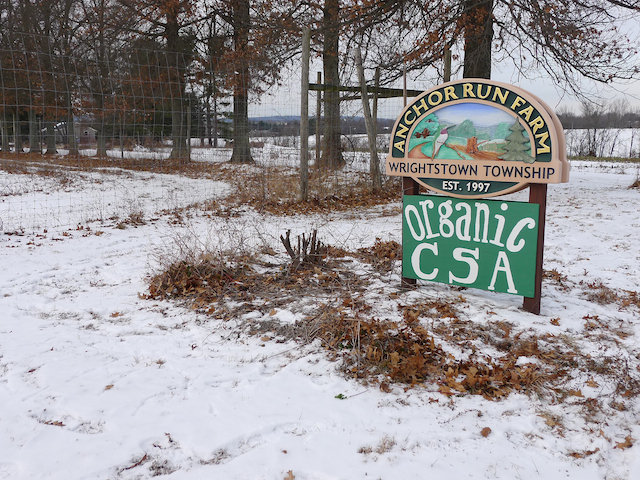
The new addition to the Anchor Run Farm sign thanks to field manager Hannah.
Is it winter or not? For a few days it feels, sounds, and smells that way, then the next round of a thaw arrives and with it a beckoning to be outside, a solitary confused peeping frog, and the smell of decomposing daikon radish cover crop. On the one hand I want it to be cold to set back bugs and diseases for the following season, but on the other hand mild weather is pleasant and productive. Thermal fluctuations are probably normal and happen most seasons but going from a low of 2 degrees to a high of 65 degrees a few days apart is extreme. Give me one month with temperatures consistently below freezing with a long autumn and spring on either side and I would be happy. With an extended forecast of above freezing temperatures and daylight slowly getting back to 10 hours a day, thinking about spring and earnestly getting ready for the next growing season will probably commence.
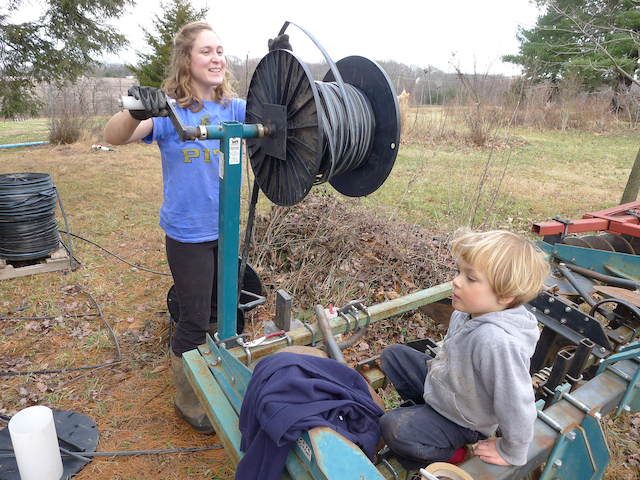
Under Gabe's watchful supervision aka meaningful distractions Hannah winds up last season's irrigation drip tape for next season's use.

January 8, 2017
It's Winter
By Derek McGeehan
It's Winter
By Derek McGeehan
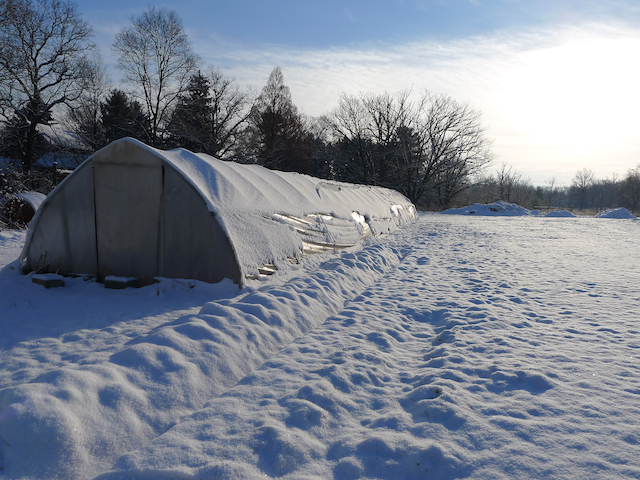
And it's cold! At 7:30am Monday morning it was 2 degrees outside, 10 degrees inside the high tunnel, 25 degrees under the two layers of inner row cover in the high tunnel, and 30 degrees in the greenhouse, thanks to some subtle propane heat. This was our 3rd single digit morning this fall/winter and probably won't be our last. By 3:00pm Monday afternoon it warmed up to a balmy 23 degrees outside, 42 degrees inside the high tunnel, 46 degrees under the two inner covers, and was 47 degrees in the greenhouse. Fortunately, miraculously, marvelously all of the unheated greens survived and looked happily content by this afternoon. Quite a rebound since this morning, but they were only exposed to 25 degrees or so, which is tolerable, apparently. It's pretty amazing that the simple addition of inner covers protects crops this much, all passively without added heat. This cold arrived on the back of a warm spell, so the leftover warmth of the soil is probably getting trapped under the covers. Twenty-five is low, especially for relatively mature greens that need to be harvested soon. These greens began their lives at the end of October and should be around for a second cutting at the end of February. After we're through with the first cutting in the high tunnel we'll begin cutting in the greenhouse and around then we'll also take a second cutting from the lettuce mix, spinach, and chard in the hoop house. These are our goals anyway. Please enjoy these nurtured organic greens!
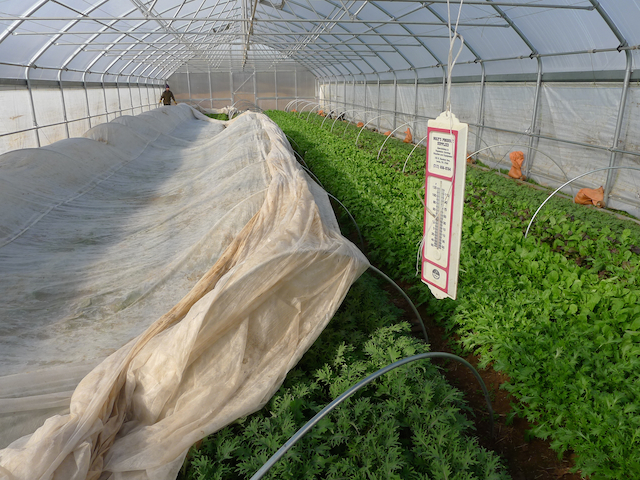
Covering and uncovering the protected crops are typical winter growing tasks

January 1, 2017
The Calendar Flips
By Derek McGeehan
The Calendar Flips
By Derek McGeehan
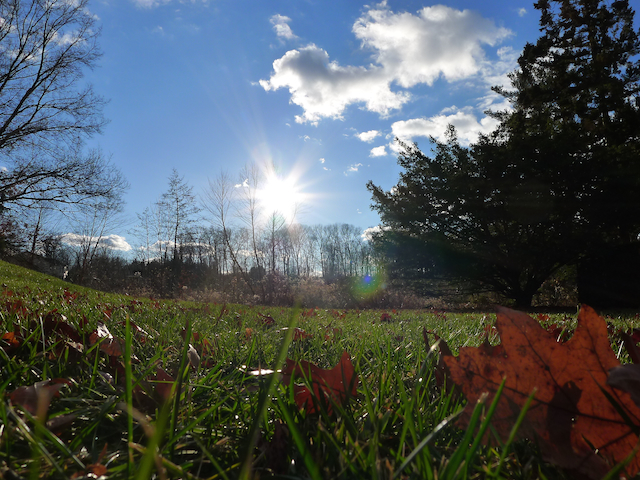
Sunlight is perfect this time of year for a good photo, as is Dana's eye.
Welcome to the 2017 Winter CSA! Share distribution begins this Wednesday 1/4/17 1-8pm for Full Shares and Week A Half Shares. Week B Half Shares begin next Wednesday 1/11/17. To find out what week you are, log in to your account. If you participated in the Late Fall CSA as a Half Share, your pick up week is the same.
It's been two weeks since our last CSA pick up; our first week off since mid-May. Thirty-two weeks of harvest and pick up in a row. Not that this week was a week without work, but the gap in harvests allowed additional focus in other areas, or time off from work. On the farm there is almost always a job or task begging for completion, beginning, or a brainstorm. At least there were some holidays spent away from the farm, when it is possible to separate oneself from the responsibility. Either way, the crops look great. I'm excited to harvest fresh greens again this week: baby kale, arugula, mizuna, and greens mix.
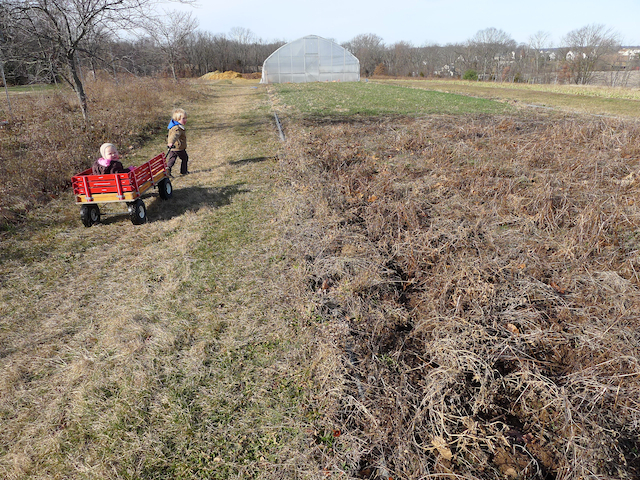
Enjoying the first of the new year outside; a warm spring-teaser.

December 18, 2016
Challenging Cold
By Derek McGeehan
Challenging Cold
By Derek McGeehan
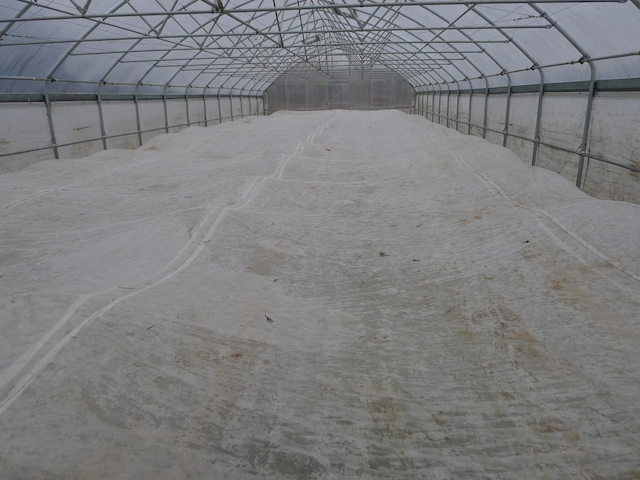
Some good news: we think most of our crops survived the first round of deep freeze. Another round is settling in now but at least the sun is shining to temporarily warm the plants and air space inside the protective fabric and structures. It's not supposed to be as cold as it was last week but may not rise above freezing today or tomorrow. We were quite nervous early last week as we tried to determine the best way to ensure our fresh crops survived. Trial by error, experimentation, data collection, and research led us to use two layers of our lightweight fabric row cover on top of large interior hoops to protect the crops in the high tunnel. This is where the majority of our greens will come from over the next two months. The picture above shows the interior of the high tunnel and the photograph below shows the healthy green crops that survived under the two sheets of cover. When it was 9 degrees outside on Friday morning the interior of the high tunnel was 12 degrees, cold enough to have killed the crops. Under the 2 layers of fabric, amazingly, the temperature was a steamy 27 degrees, cold enough to freeze the crops but not cold enough to kill them or damage them. No additional heat was added. The crops survived because warm air was trapped under the covers, radiating off the earth.
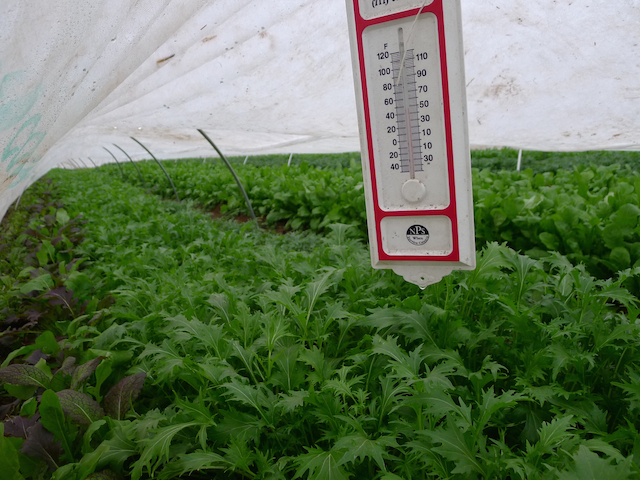
Before the deep cold we finished harvesting the first round of cutting of baby chard, lettuce mix, and spinach from the hoop house. In there we erected hoops and covered with one layer of fabric in hopes of regrowth and another cutting in a month or so. Those crops appear to have survived. For added security and insurance, we turned on the propane heat in our greenhouse and set the thermostat to 34 degrees. During the 2nd night of deep cold, when the outside low was 9 degrees, a gust of wind blew out the pilot so upon early morning inspection there was no heat in the greenhouse and the air temperature inside was 20 degrees. Disaster? Plants were thoroughly frozen but thawed in a few hours and as of today still seem to have survived.
In summary, we can continue to enjoy fresh organic greens this winter. Happy Solstice!

December 11, 2016
Real Cold Has Descended
By Derek McGeehan
Real Cold Has Descended
By Derek McGeehan
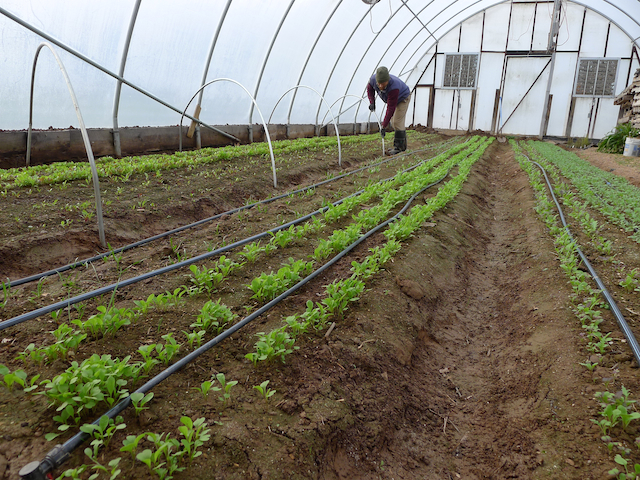
The feeling of winter has arrived, and the feeling of the arctic is supposed to greet us mid-week. These types of temperature dips truly test the cold tolerance of the various crops still growing on the farm, as well as our willingness to get outside and do some necessary farm work. Remembering to bundle up properly makes most work managable. Sunshine helps, too, though that has been mostly absent of late, or the clouds clear up right as the sun descends below tree line. Just in time for a nighttime of clear crisp cold. Since this is the first deep freeze of the fall season, we're curious to observe the varying cold intolerance thresholds that will be crossed. Probably the outside lettuces will be damaged. Under big hoops and fabric row cover are kales, arugula, lettuce mix, spinach, and baby chard (see expected harvest photo). I don't know if that is enough protection. The greenhouse was two layers of plastic and an inflatable air layer between. Inside the greenhouse we erected big hoops with row cover on top (see above photo). The hoop house and high tunnel are covered with a single layer of plastic but also have big hoops and fabric row cover inside (see below photo). The pockets of air are important protection. Next week I'll probably write about what survived and will hopefully be amazed and enthused by the resiliency of plants in the face of teenage temperatures.
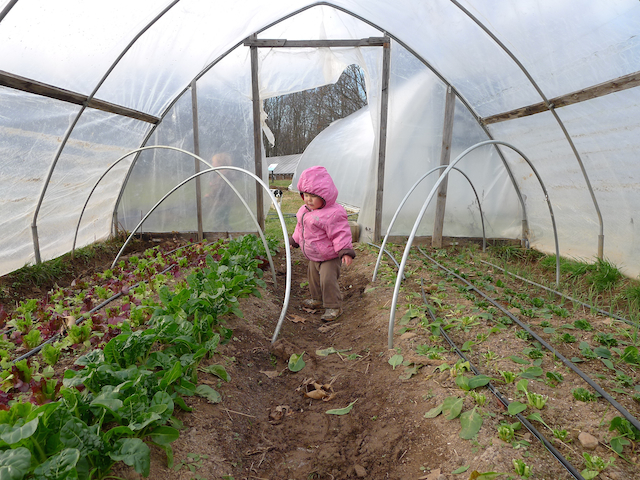
Abigail surveys the regrowth of the lettuce mix, hoping it will endure the upcoming cold.

December 4, 2016
Go With The Flow
By Derek McGeehan
Go With The Flow
By Derek McGeehan
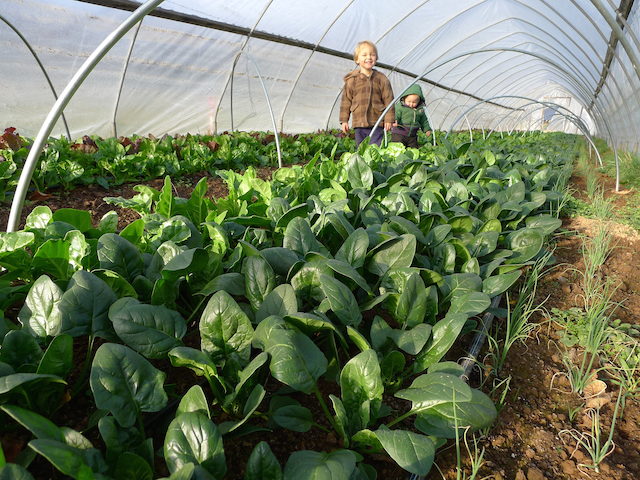
Gabriel and Abigail pose in the hoop house behind beautiful spinach and chard.
Water returned to the farm last week in the form of abundant rainfall; almost 3 inches fell over a couple of days. Most of it appears to have soaked in, but the ponds are full again so some of it ran off and was caught there. Overall November was definitely a dry month; until that storm we had only received about half an inch of rain. This time of year our crops hardly need any water to maintain their health, so a dry fall is better than a wet one. During a typical Bucks County fall and winter the soil in the covered structures absorbs enough moisture from outside rainfall to keep those crops happy. This fall, however, we've had to add water every couple of weeks. Soon enough (probably) adding water from the well won't be an option, assuming frozen pipes could become a reality. We began harvesting lettuce mix from the hoop house last week and will begin harvesting chard and spinach there as well this week. We will also begin harvesting arugula, mizuna, and greens mix from the high tunnel. Cutting it now should allow it enough time to regrow for another harvest or two in January and February. Field crops are still growing slowly and have been cold tolerant. We'll probably have to do a bit of scrambling whenever forecasts begin to call for lows in the low 20s or teens but by then most of the field crops will be cleared. Hope you are enjoying all of the fresh greens!

November 27, 2016
A Continued Green Autumn
By Derek McGeehan
A Continued Green Autumn
By Derek McGeehan
December commences this week as we move slowly towards the end of the calendar year. I believe some folks refer to December as the beginning of meteorological winter. Another few weeks of lessening daylight, then with official start of astronomical winter on December 21st daylight will begin to slowly lengthen. It probably won't feel like winter until January. The winter winds were working their way around last week, though, removing whatever warmth hung around with the prior week's minor heat wave and also quickly dismantled whatever leaves hung around so that now it looks like winter. There are a few move leaves clinging desperately to the large trees surrounding our house and I'm hoping they've finished their gravitationally induced fall before I attempt to clean our gutters prior to the forecast significant rainfall midweek, the first in a very long time. It has been a mostly lovely autumn and I'm glad for the return of some sustained sunshine today. Outside crops are still thriving, though a few of the more cold sensitive ones show a bit of stress from the wind and the subsequent drop into the mid-20s last week.
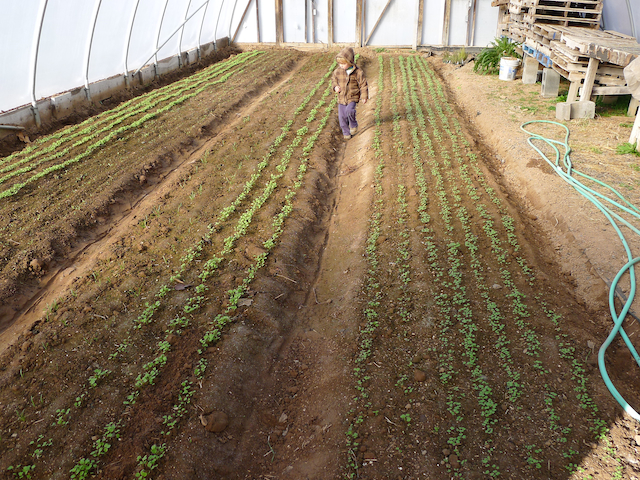
Gabriel inspects raised beds of winter greens inside the greenhouse.
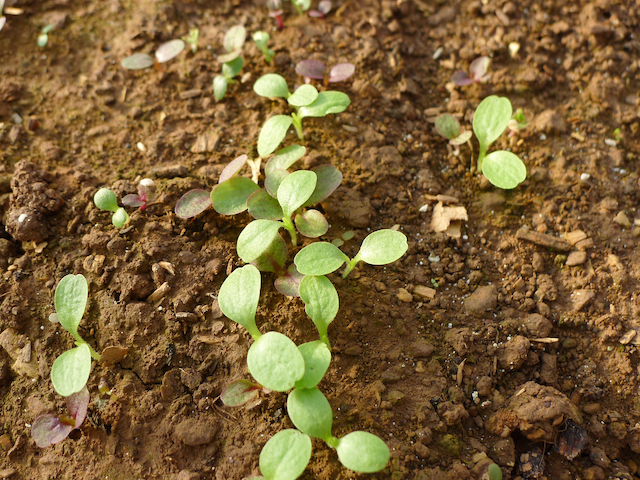
Baby lettuce mix seedlings slowly beginning their life above the soil.

November 20, 2016
Blowing in the Wind
By Derek McGeehan
Blowing in the Wind
By Derek McGeehan
I love this time of year (most of the time, when the weather is good, and crops are healthy). The amount and pace of work is manageable, and with one main pick up day per week with approximately 30% of the Main Season membership, harvesting is much easier. Besides continuing the growing season and protecting crops, we reflect on the successes and failures that occurred over the past 9 months and begin to think about possible improvements. Our thoughts begin to meander towards the 2017 growing season, what new crops to try, what perennial plantings to invest in, what crops to quit growing, how to improve members' CSA experience. I love the time and space relationship between planning and planting for future harvests. Investing in an additional 40 fruit trees, 300 raspberry bushes, and 3000 strawberry plants requires a vision of the future. Where will the crops go? What's the soil like? When will harvests begin? What will pest pressure be like? If it's a u-pick crop, can it be grown near the central area? Is it worth the investment? It's quite easy to dream and be hopeful this time of year, especially after a satisfying and successful growing season. We feel safe.
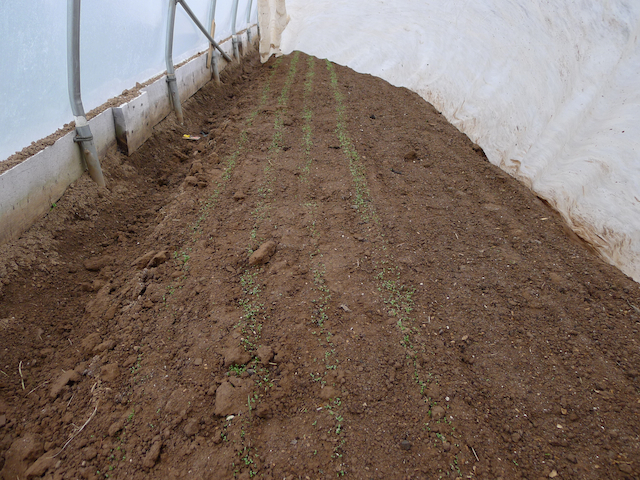
Very, very young lettuce mix under triple protection in the optionally heated greenhouse for January and February harvests.
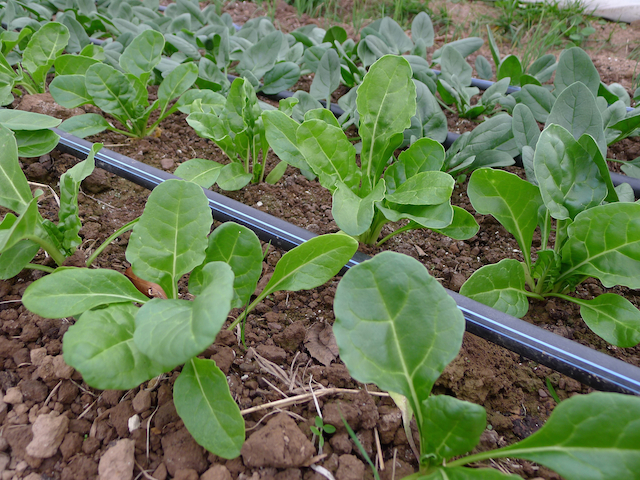
Under protection in the unheated hoop house, chard and spinach look healthy and happy.

November 13, 2016
5th Annual Late Fall CSA Begins
By Derek McGeehan
5th Annual Late Fall CSA Begins
By Derek McGeehan
Technically a new CSA season but really an extension of the continued growing season, the 2016 Late Fall CSA begins this Wednesday 1-8pm for Full Shares and Week A Half Shares. Week B Half Shares start next Tuesday, November 22nd, 1-8pm. Wednesday is the main pick up day, but there is also a Saturday 11am-12noon option for those of you with busy weekdays. You must e-mail us to choose the Saturday option permanently, or to request a temporary switch. If you're a Late Fall Half Share owner, log in here to find out what week of pick up you are. If you were a half share owner during the main season your pick up week is the same unless you requested a different week for this current season.
We're very much looking forward to and excited about the continued harvests. Cold hardy crops thrive this time of year. Greens only get sweeter after a touch of frost and a freeze. This fall so far has been particularly kind to us; we've had numerous widespread heavy frosts but no deep freezes yet. In fact, the temperature has only bottomed out in the upper 20s a few times. Even the least cold-hardy unprotected greens like head lettuces aren't showing damage yet. Either way, we took necessary steps to cover a good portion of the crops for the continued growing season, assuming eventually they'll need the added protection. After it gets truly cold, perhaps not until January, we'll begin harvesting from the larger protective structures. See the bottom picture below for the various cold protective strategies.
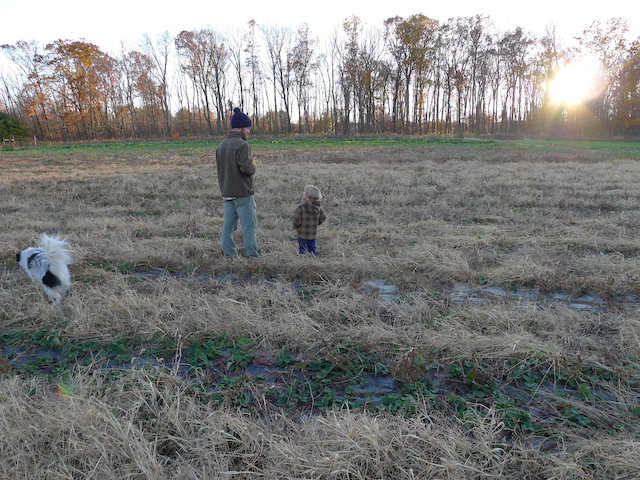
After a very rough beginning during an extremely wet (and hot) July followed by an extremely dry (and hot) August, our 2017 strawberry patch plants seem to have pulled through successfully (they're in green in the foreground).
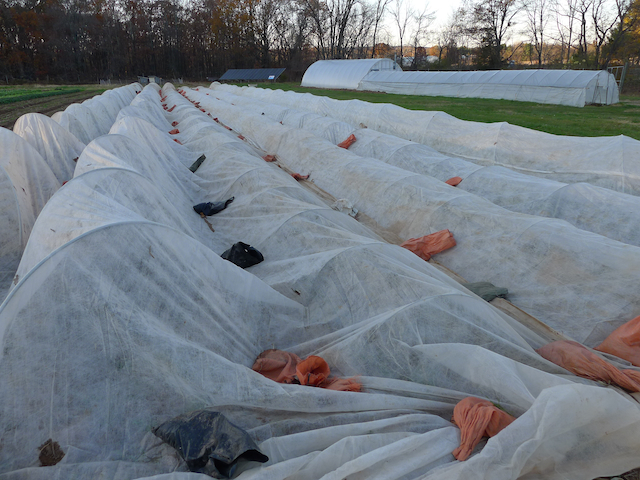
Low hoops made from bent 10-foot 1/2-inch electrical conduit plus even lower hoops made from heavy gauge wire covered with fabric and anchored with sandbags will hopefully protect scallions, lettuces, yukina savory, chard, spinach, kale, and arugula for another month or two. In the background the greenhouse and hoop house protect additional crops for winter harvests.

November 6, 2016
With Heartfelt Thanks
By Derek McGeehan
With Heartfelt Thanks
By Derek McGeehan
So, we're at the end of the 2016 Main Season CSA already. It surely flew by. It feels like a successful season and we're thankful for all of our members/friends/neighbors that participated, supported, and helped along the way. We're also very thankful (and lucky and fortunate) to have had a great, hardworking, enthusiastic, intelligent, diligent, knowledgable farm crew this year. Hannah and Mary Liz were here for the full length of the season, Mark was here for the summer months. They were an indispensable component of the farm's success this year. Hannah is returning for another season on the farm; Mary Liz is moving to the Boston area and will pursue work on another organic CSA farm.
We hope as an Anchor Run CSA member you feel satisfied with your experience this year and will return for future seasons. Stay connected - to the farm, to your farmers, to the soil and the food that is grown here. As of now you can sign up for the 2016 Late Fall CSA, the 2017 Winter CSA, and the 2017 Main Season CSA here. Thank you, and have a good great offseason!
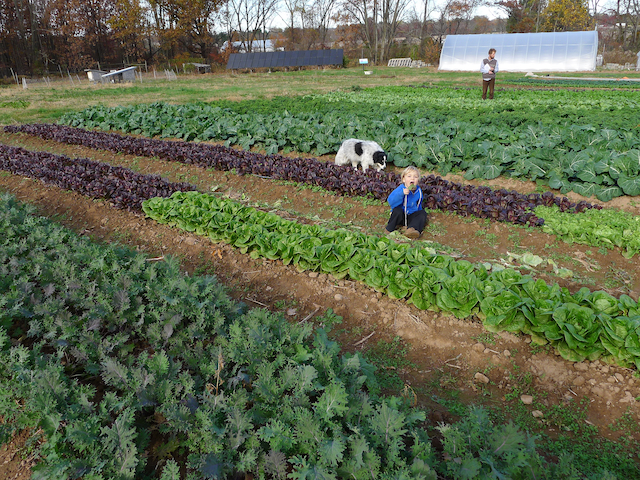
Checking out the Late Fall and Winter crops, planning harvests, sampling along the way, reconnecting after being away for a couple of days.

October 30, 2016
Frosty Mornings and Another Round of Summer
By Derek McGeehan
Frosty Mornings and Another Round of Summer
By Derek McGeehan
We sustained our first widespread heavy frost this week and all of the crops made it through unscathed and hopefully sweeter. The fact that we're almost into November and haven't experienced a damaging low in the 20s is soothing, but it will come soon enough. Putting out mini-hoops and floating row cover is a task that is easily put off until absolutely necessary. Forecasted temporary dips in temperature always seem to be preceded by a very windy day which renders floating row covers into large unmanageable kites. This is one main reason we're fully embracing growing in all of our larger plastic covered structures this fall and winter. The hoop house, high tunnel, and greenhouse will protect much of our fresh crops during the Late Fall CSA and Winter CSA seasons. The size of these structures makes harvesting easier and the thick plastic gives plants an additional 5-10 degree buffer. We can also add another layer of hoops and row cover on the inside that adds further insulation. Crops are also protected from wind, rain, and snow. Because the greenhouse has an inflatable layer of plastic and the option of supplemental heat, we can grow certain crops in there that aren't quite as cold tolerant as others. Crops like beet greens, chard, and lettuce aren't quite as cold hardy as kale, arugula, and spinach. To enjoy the winter delicacies you should join our Late Fall CSA and Winter CSA!
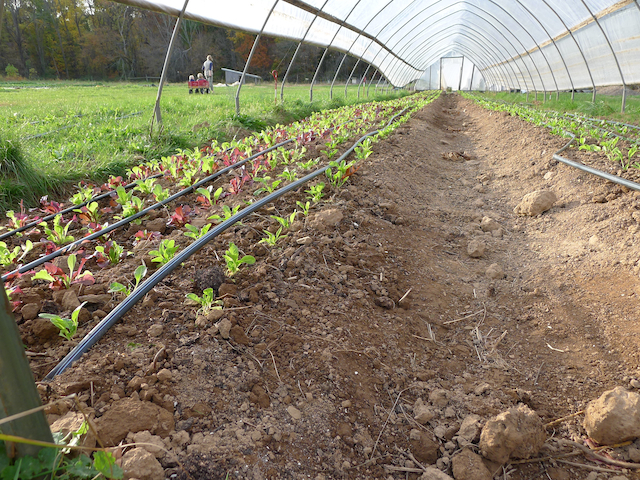
Lettuce mix, chard, spinach, and scallions under protection inside the hoop house.

October 23, 2016
Three More Weeks of Main Season CSA
By Derek McGeehan
Three More Weeks of Main Season CSA
By Derek McGeehan
The brief return to summer-like weather is over, thankfully, and some much needed rain fell as the cold front made its way through the area. We irrigated some thirsty crops earlier in the week and would have had to add water to other crops had the rain missed us. We transplanted lettuce mix, spinach, scallions, and chard into the hoop house for December harvest and direct seeded arugula, kale, mizuna, and mustard mix into the high tunnel for January and February harvest. We sowed winter rye and hairy vetch cover crop into the heirloom tomato, cherry tomato, sweet potato, and field tomato areas; this was probably the final cover crop sowing of the season. We have one more outside crop to plant - garlic - sometime over the next few weeks and will direct seed another round of greens in the high tunnel within a week or two. We're preparing the greenhouse for mid-winter growing where we can control the temperature with supplemental heat, if needed. Last week we also finished harvesting celeriac and kohlrabi for distribution over the next few months. Thanks to the wonderful CoolBot, our cold storage area is almost double what it was last winter. And this coming week we'll have the pleasure of dealing with the first potentially heavy frost of the fall as lows are forecast to drop into the low 30s, wich probably means upper 20s here.
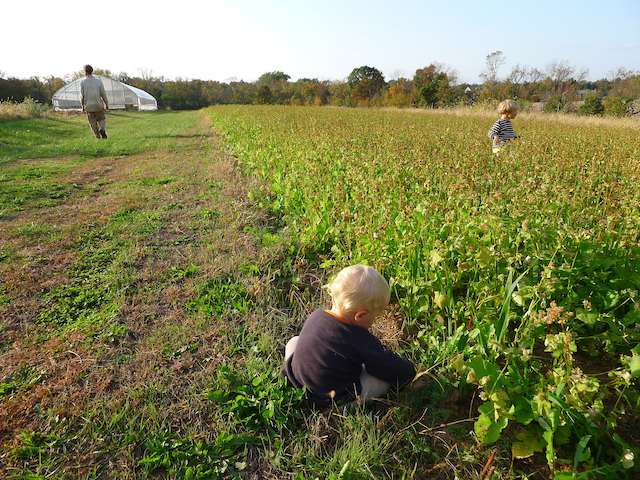
A warm summer day in fall beckons the kids to trundle through the daikon, buckwheat, and oat cover crop.

October 16, 2016
A Dry and Lovely Start to Autumn
By Derek McGeehan
A Dry and Lovely Start to Autumn
By Derek McGeehan
It's dry but it's tolerable this time of year with the low sun angle and diminished daylight and cooler temperatures. We've had enough precipitation to keep the crops happy but are curiously wondering when the cauliflower will head up. Typically we transition straight from the broccoli harvest into the cauliflower one, but this year, either due to bug pressure or some other factor, the cauliflower is a bit behind schedule. It could be thirsty. Greens are abundant right now as they should be with these cool days and nights. Infrequent light frosts are occurring as temperatures dip into the upper 30s, hopefully sweetening the flavor of many crops. White pines are beginning to turn some green needles to brown and will add a beautiful golden carpet to the landscape as they fall to the ground. Deciduous trees are also just starting to turn from green to gold and red. I feel like we only just departed summer and may feel like we have a brief return as temperatures climb to 80 degrees this week. That sounds okay; I'm not ready for the heating season just yet. Hope you are able to enjoy the great weather!
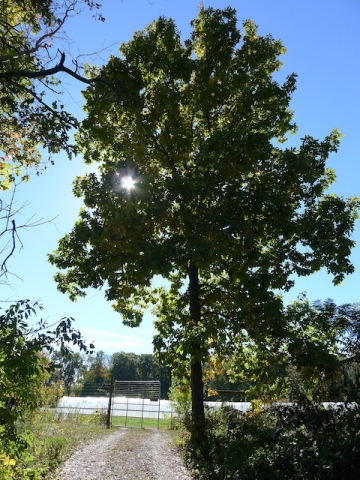
A majestic hickory on the way to Field 1.

October 9, 2016
Harvesting and Getting Ready for Winter
By Derek McGeehan
Harvesting and Getting Ready for Winter
By Derek McGeehan
Including this coming week there are five more weeks of pick up for the Main Season 26-week share. Directly after the conclusion of this season the 6-week Late Fall CSA begins. Planting and production has already commenced for fall and winter harvests; crops need to be in the ground and growing well before cold and dark descend upon our latitude. Days to maturity of crops will eventually double and perhaps triple when we're nestled in winter. Soon we'll employ hoops and row cover to keep outside crops blemish free from the adverse effects of a heavy frost. Eventually - think January and February - we'll only harvest fresh crops from the protection of the high tunnel, hoop house, and greenhouse. That's well down the road, but we have to plan for and prepare soil now, as well as sow and transplant. Our managed farm footprint slowly dwindles each week as we wrap up harvesting of certain crops and sow the hibernating soil with cover crops. Our mental map of the farm becomes easier to comprehend when we're only actively maintaining a small portion of what was managed at the growing peak of June, July, and August. Much of the farm fields still radiate a brilliant green with the cool weather suited cover crop mixes and will do so until we receive hard frosts and freezes with regularity. These cover crops are soaking up leftover nutrients from the soil as they gather sunlight and transform it into additional soil food for next year's cash crops. As they protect the soil over the winter they'll slowly degrade into next spring and release stored energy and the cycle will continue.
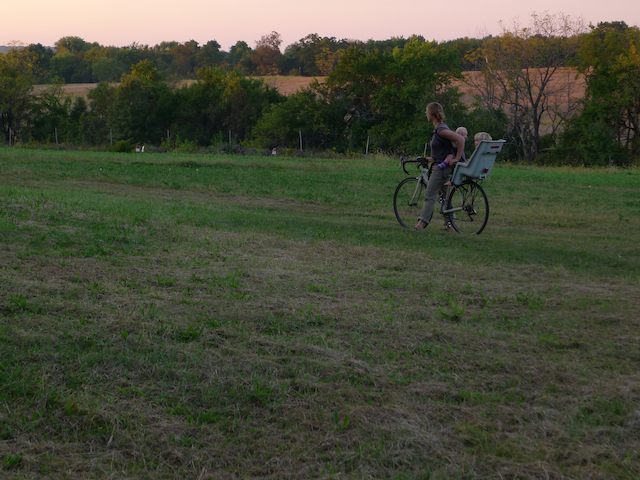
A fun favored method for meandering around the farm...sunset glows in the background.

October 2, 2016
Finally a Fall Feeling
By Derek McGeehan
Finally a Fall Feeling
By Derek McGeehan
We're safely into October and we haven't seen the sun in half a week, received a nice light soaking rain, and are beginning to say goodbye to the last of the summer vegetable staples like tomatoes and peppers. We're transitioning away from sowing warm season annual cover crop mixes of buckwheat and daikon radish on finished fields and for a brief period will hope to establish oats and crimson clover before switching completely to winter rye and hairy vetch. Cover crops we sow after cash crops will largely determine what we can plant where next spring, summer, and fall. Buckwheat, daikon, and oats will winter kill and slowly desiccate and decompose over the cold months and should leave the soil in an almost perfect state of planting condition next season. Clover, rye, and vetch will go dormant over the winter, regrow in the spring, and will be turned into the soil after flowering in May. The clover and vetch will also fix nitrogen in the soil. Rye produces so much organic matter that we'll either fallow those fields or plant fall crops, giving the soil and organic matter time to process into a workable condition. Also affecting what goes where in the spring will be what was where the past 3-5 years. Crop rotation is an essential part of organic farming, crop and soil health. With good record keeping and ample land for proper rotation and resting, the pieces of the puzzle become easier to fit into place.
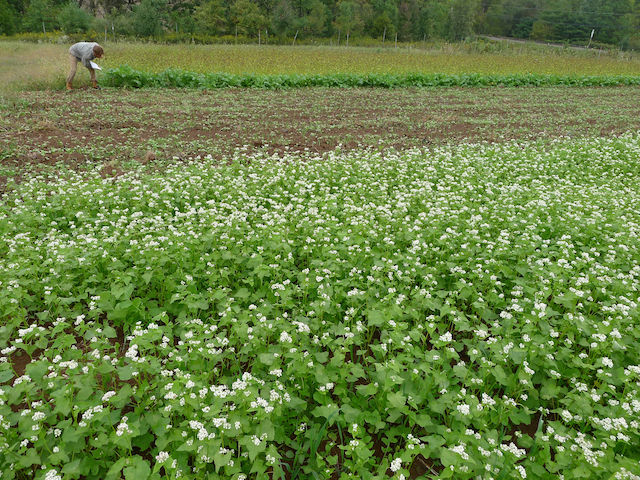
Three stages of growth of buckwheat and daikon radish cover crops are seen here. I'm looking at a 3-inch thick and growing daikon taproot in a patch where the buckwheat has finished flowering and is beginning to senesce. Buckwheat grows quickly to suppress weeds, attracts pollinators, then dies back to allow the daikon understory to take over.

September 25, 2016
Truly Autumn
By Derek McGeehan
Truly Autumn
By Derek McGeehan
Lows last night bottomed out in the upper 40s and highs this weekend will stay in the mid-70s. In fact I don't see temperatures reaching the 80s in the 10-day forecast. This surely sounds like autumn to me. Fall crops such as greens in the brassica and amaranth families are really beginning to beg for harvest and will be seen in the pick up room this week. After mostly being absent for the past few weeks due to erratic germination and a lack of love for heat, lettuce finally appears to have made a continued return into the foreseeable future. Broccoli, cabbage, and kale are thriving, even with the bug pressure. So many crops on the farm appear to be in perfect states of pick-ability that it will be difficult to choose which ones go in the share and which ones we should hold. Most likely storage crops already out of the field and protected in the barn will be the ones we hold on to until the fresh greens slow down or we catch up. I don't know about you, but I am very much looking forward to a return of these delicate delectable greens.
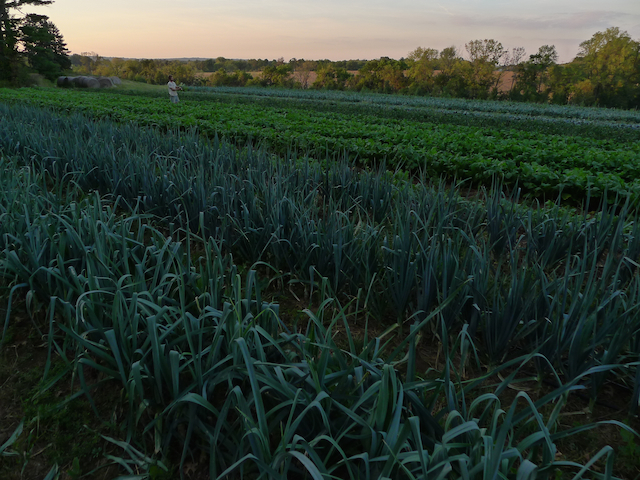
A scene of autumn colors and crops - leeks, radishes, turnips, celeriac, cabbage, broccoli, and cauliflower - with a golden field of desiccated soybeans and a purply-pink skyline.

September 18, 2016
Certified Organic
By Derek McGeehan
Certified Organic
By Derek McGeehan
We took the plunge and it's now official: we're Certified Organic. After a lengthy application, solid record keeping, a thorough onsite inspection, as well as using organic practices since the inception of the CSA 13 years ago, Anchor Run is certifiably organically growing produce. We're happy to have the outside approval, though our true certifiers all these years have been our CSA members who pick up at and work on the farm with us, and continue to trust our growing practices. Thank you for your support!
Some big outside jobs in the field from last week were prepping for and sowing cover crops in anticipation of tonight's potential rain event as well as the removal of all of the plastic and landscape fabric from the winter squash patch. We transplanted another round of spinach, the first round of winter scallions, and some bok choy. Winter carrots and another round of arugula, kale, and mustard greens were direct seeded. This coming week we'll begin preparing the hoop house and greenhouse for winter growing, as well as go dancing in the rain.
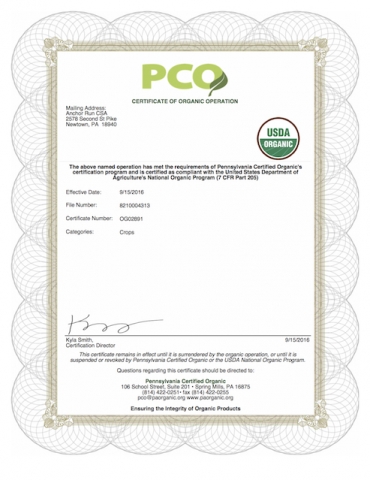
After farming "organically" at Anchor Run for the past 8 seasons, we took the next step to become officially recognized as Certified Organic and were approved last week. The CSA was managed "organically" for the 5 seasons prior to our arrival as well, so after 13 total seasons it's now official.

September 11, 2016
The Ability to Add Water
By Derek McGeehan
The Ability to Add Water
By Derek McGeehan
We're fortunate to have the ability to add the quantities of water that are needed to grow healthy crops at this stage of the growing season. I know there are farms and farmers out there that are unable to do so, therefore I'm thankful for our relatively new and deep well that is tapped into a clean and reliable aquifer at a depth of 300 feet. The pressure and flow rate is adequate for our needs. In the spring of 2013 we installed 3000 feet of underground 3 inch pipe to move water around the farm to 12 access point risers where we can more easily attach above ground pipes and tubes to carry water to the crops. This infrastructure is essential right now considering we've had just over an inch of rain since July with many hot and sunny days. This is the driest weather I can remember at Anchor Run. Because of our heavy soils and north facing slopes, our crops are mostly happy and healthy after several rounds of irrigation. When you're eating the produce over the next couple of weeks think about what is required to grow nourishing food, and how we shouldn't take any part of the process for granted. In our culture of misleading abundance it is quite easy to overlook the precariousness of our tethered connection to a healthy and providing clean earth and environment. Let's remember that.
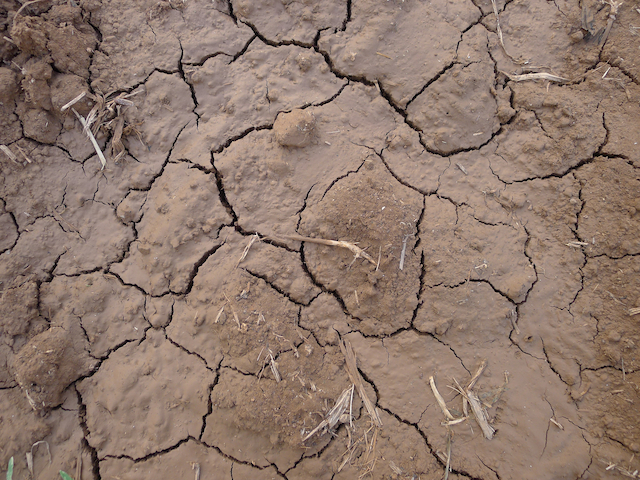
Thirsty soil! When we're initially making drip tape connections into the perpendicular 1.5 inch line, some water spills briefly, and because of the high clay content in our soil coupled with quick evaporation and drying, cracks like these can occur.

September 4, 2016
10 More Weeks of Harvest
By Derek McGeehan
10 More Weeks of Harvest
By Derek McGeehan
September is here and we're beginning harvest week #17 out of 26, so there are 10 more weeks to come to the farm for your Main Season CSA shares. What's after that? Soon we'll announce sign ups for our 6-week Late Fall CSA season which runs mid-November to the end of December as well as our inaugural 8-week Winter CSA season which will run from the beginning of January through the end of February. Details and additional information are forthcoming.
Besides thinking about and planning for late summer, fall, and winter, we're continually busy retrieving storage crops, helping the crops battle weed pressures, and putting fields to rest for the colder seasons. We've now retrieved about 90% of the potatoes and will gather the rest this week. 100% of the #1 grade winter squash are safely in storage. With the help of workshifts all of the fall cabbage, broccoli, cauliflower, leeks, and celeriac were successfully weeded and look healthy. Next up for weeding are beets, chard, kale, and asparagus. Fields of spring peas, summer beans, edamame, lettuce, and herbs, as well as potatoes, have been transitioned to a cover crop mix of oats, buckwheat, daikon, and clover to scavenge nutrients and protect the soil over the winter. Each time there is an anticipated rain event we make an effort to establish a cover crop wherever is available. The lack of rain this past month has been a challenge but amazingly it has been enough to initiate germination and enable the plants to grow.
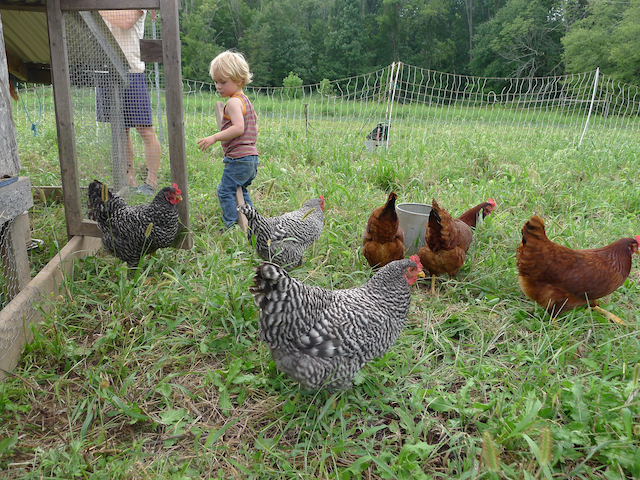
This past Saturday we moved our pastured laying hen flock to a new 4-week location. I'm installing crisscrossing wire over the area to deter hawks while the electrified netting theoretically fends off foxes, raccoons, skunks, dogs, and weasels.

August 28, 2016
Dry and Hot, Again
By Derek McGeehan
Dry and Hot, Again
By Derek McGeehan
Having received under an inch of rain in all of August we've been forced to return to regularly irrigating as much of the farm as possible. Like July, when we received 12 inches of liquid, August is also testing our resolve, but for the obvious opposite reason. The boom and bust cycle continues, Mother Nature and Father Geology grin and play games, we march on, trying our best to keep the farm productive and the CSA shares satisfying. During dry weather we are very lucky to have soils that drain very slowly, hold moisture well, and face north. For these reasons July was a difficult month but the farm survived with only a relatively small noticeable amount of loss. If anything, the stress is probably worse for us than the crops, but that's how it goes. After spending a solid 20 hours setting up irrigation infrastructure last week for all of the crops that need it, we're a bit more comfortable. We were eagerly looking forward to last Sunday's hypothetical rain event to water in newly sown cover crops and the .2 inches received looks to have sprouted some of the seeds. Now we hope that they can tolerate the dry heat and hold on until we receive more rain, whenever that may be. Farming is not for the faint of heart.
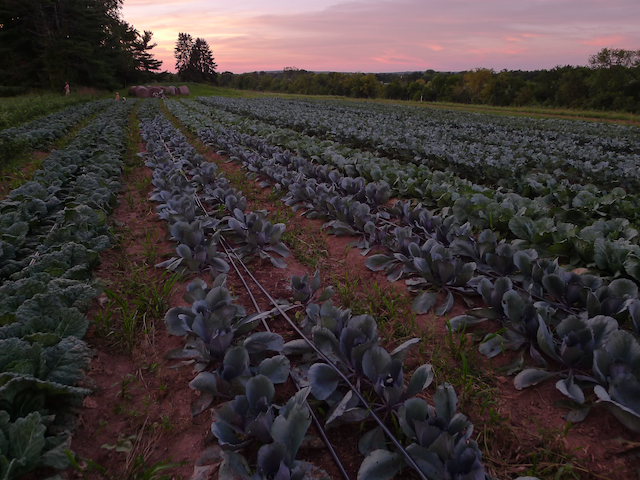
A sunset scene of our fall cabbage, broccoli, and cauliflower with freshly applied drip tape trickle irrigation to keep these crops happy and healthy.

August 21, 2016
Perhaps a Brief Respite
By Derek McGeehan
Perhaps a Brief Respite
By Derek McGeehan
With daylight slowly diminishing, the sun perceptibly getting lower in the sky, shadows getting longer, summer crops and weeds showing their age, and the upcoming lows in the 50s, thoughts are beginning to meander towards fall. Today, we're still in August in the heat and humidity of summer, but with changing seasons on the distant horizon the scramble to collect as much sunlight and photosynthesize it into edible food is palpable. We're busy harvesting and securing long-season crops. Onions were just completed, potatoes are perhaps halfway finished, and all of the winter squash except for butternut has been stowed. We're busy putting fields to sleep for the winter by mowing and plowing spring and summer crops and sowing mixes of cover crops to protect and gather up nutrients from the soil before winter. Cover crops are an essential part of an organic produce farm to replenish soil health, increase organic matter, add nitrogen, and provide pollinator habitat. We've already sowed a buckwheat and daikon radish mix that is up and growing. We're hoping tonight's rain event triggers the growth of the buckwheat, daikon, crimson clover, and oat mix that we sowed over a large part of the farm on Friday. If the seeds germinate and the cover crop successfully grows, that part of the farm can be removed from most of our thoughts until the spring.
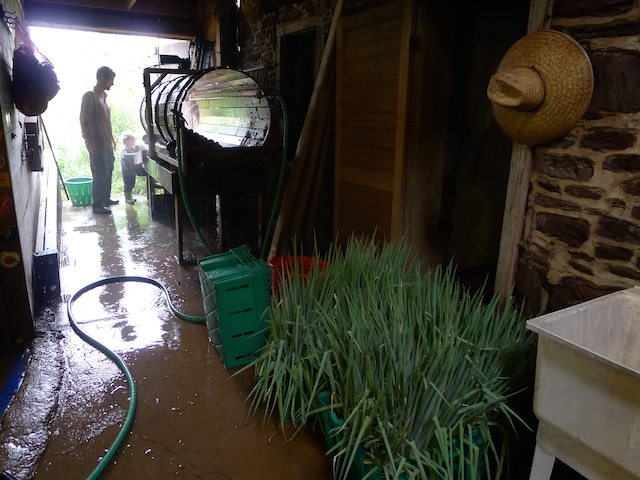
Future farmer Gabe monitors the potatoes as they roll out of our spinning root washer, making sure they correctly end up in the clean bin.

August 14, 2016
Another Blast of Heat
By Derek McGeehan
Another Blast of Heat
By Derek McGeehan
For a brief period of time last week the weather forecast showed highs in the upper 70s at the end of next week, which temporarily helped us to tolerate this current furnace blast. The forecast has changed, and the heat swelters on. We're back to mildly hoping for rain after wishing it would stop raining, and so far the thunderstorms have missed us the past few days. I reluctantly turned on the irrigation yesterday for many of the crops that are currently being harvested on a continual basis. The boom and bust rain cycle leaves us pleasantly bewildered. The dry weather and soil combination is allowing us to catch up and get ahead with certain tasks like harvesting potatoes and onions, subduing grass and sowing cover crops, and perpetually working towards the common goal of successfully completing the 26-week CSA season. I feel very close to mother nature as I sit here and write these notes in a lingering sweaty mess in an un-air-conditioned house and am thankful for the solar panels providing some of the needed power to our 2 window AC units and walk-in cooler refrigerator in the barn. The window AC units are set for 60 degrees and are currently protecting potatoes, tomatoes, and winter squash, as well as some seeded flats of colder-germinating crops like spinach, lettuces, and collards. The walk-in is set for 36-40 degrees and houses everything else we harvest. I wouldn't mind sleeping out there.

There is something eternally appealing about a sunflower blossom, except in this heat it may look too much like the sun furnace.

August 7, 2016
With Help From CSA Members
By Derek McGeehan
With Help From CSA Members
By Derek McGeehan
Once again I'm amazed by how much work can be accomplished when we have large groups helping out with farm tasks. Besides all of the necessary weeding, cultivating, and transplanting that needs to be done every week on the farm, this time of year the harvesting of crops like potatoes, onions, and winter squash as well as the cleaning up of watermelon, squash, cucumber, and pea patches truly benefit from strength in numbers. Last week, with the help of workshifts, we were able to harvest 40% of the onions, both varieties of spaghetti squash, about 20% of the potatoes, as well as remove all of the weed suppression fabric from the cucurbit crops. From the farm management and functionality perspective this is great, but I hope that it is also valuable to you, our members, to come out to the farm and work with your food community. To us, this is an extremely important tenet of the CSA model. You're involved in your own food production, learn some specifics about growing crops, get some exercise outside, and work alongside other folks who are also trying to eat healthy food. For those of you that cannot contribute physically but instead contribute financially, your support is meaningfully felt as well, and we're glad this is an option for you. Because we're a CSA-only farm, in the end we're all in this together.

Saturday's potato harvesting workshift moved so quickly that I had a hard time staying ahead with the mowing and digging of the potatoes - but that is a good thing!

July 31, 2016
Into August We Ascend, Floating
By Derek McGeehan
Into August We Ascend, Floating
By Derek McGeehan
Well well well, we don't have to use the well. After 4 more inches of rain the past few days July 2016 is officially the second wettest month in the 8 years we have been at Anchor Run. Before the end of today our monthly total is 11.7, surpassing September of 2011 when we endured tropical storm Lee (August of 2011 still prevails with 15 inches). Besides the deluges, we dealt with quite a heat wave this month. Overall, to say the least, it has been a challenge, mentally and physically. We're still hopeful for the crops to pull through mostly intact and without a noticeable yield deficiency in the pick up room. We always grow extra amounts of crops, depend on a diversity of crops, as insurances when weather is unfriendly and sometimes these extras turn into excess bounty and sometimes we lean heavily upon them. Besides our battles with the heat and rain, we're also plagued by creatures eating our high-sugar content crops like watermelon, cantaloupes, and sweet corn. The damage on the sweet corn was extensive enough to reduce the yield so much that we aren't able to give it out for two weeks, our goal. The damage to the watermelon, coupled with the deleterious effects of too much soil moisture and dying vines, means only enough watermelon for two weeks, not four like last season. So far the cantaloupe vines are alive, but slowly but surely the ripe orbs are being eaten. Is it a raccoon, a skunk, an opossum, crows, or all of the above? Adversity is part of life, right, right, right.
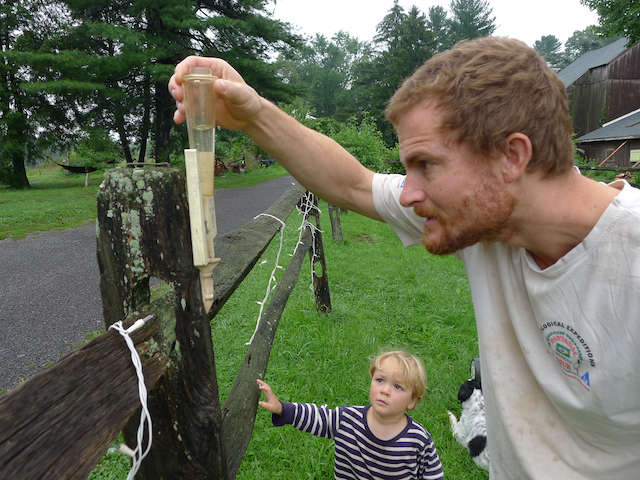
2.8 inches of rain on Saturday, after 1.1 inches on Thursday night and Friday morning, means soil is saturated and we grin/grimace and bear/beer it.

July 24, 2016
Potent Heat Wave
By Derek McGeehan
Potent Heat Wave
By Derek McGeehan
Five inches of rain followed by this incredibly long heat wave means that, mostly, weeds are growing like mad. It also means crops are maturing fast, early summer crops are waning, and irrigation needs to be considered again. We're all doing our best to stay cool (not), tolerate the constant furnace, and stay hydrated. It's a minor and hopefully temporary challenge. With the heat comes watermelon, sweet corn, and sweet peppers, as well as an increase in tomatoes, both large and small. Carrots were safely harvested and stowed with a workshift this morning while celery and fennel are coming to an end. Onions will arrive soon as well as the wonderful husk cherry, a new farm favorite. With mid-summer upon us soon the arrival of diseases will commence, first with cucumber and squash family afflictions and eventually tomato family blights. So far, though, the tomatoes look happier at this time of year than they have in a few seasons and I'm sure some of us will be happy for a break from squash and cucumbers (or just the harvesting of). Thank you and see you soon.
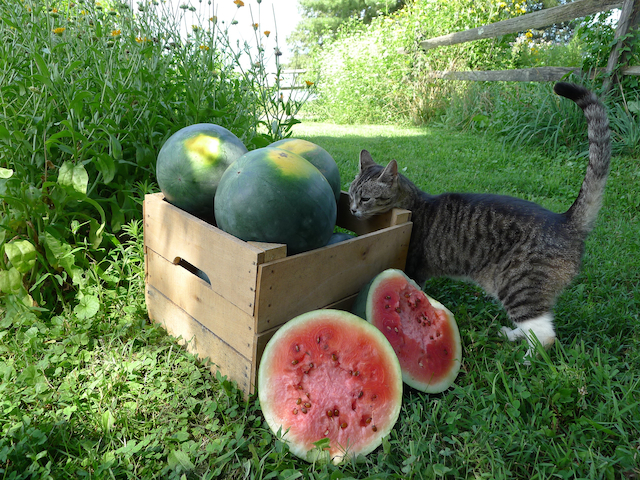
Grrrl Cat surveys part of the watermelon haul and approves rubbingly.

July 17, 2016
Hot and Steamy
By Derek McGeehan
Hot and Steamy
By Derek McGeehan
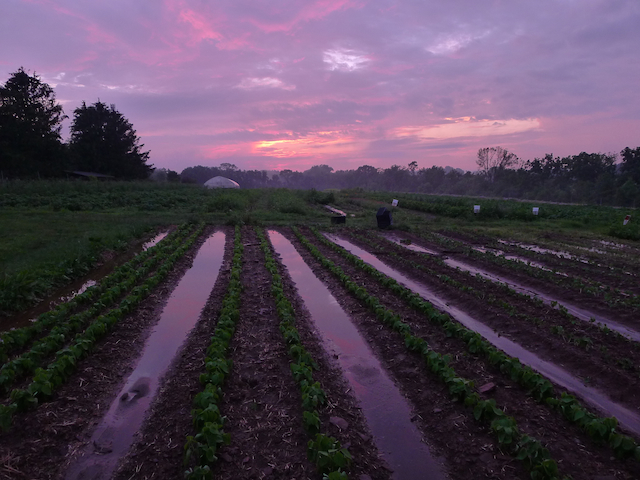
The farm received 5 inches of rain in 6 days last week, culminating with a 2-inch event that began while we were desperately trying to finish transplanting on Wednesday. Fortunately we were about 90% of the way through planting lettuces, beans, beets, cabbage, broccoli, and cauliflower and managed to plant the final few beds as the rain began to fall lightly. What we thought was going to be a short-lived light rain middle-of-the-day rainstorm turned into 5-hour almost-deluge. Or, maybe it felt that way since the soil was near its saturation point. We were very lucky the ground was workable to prepare the raised beds for planting into following the 3 inches that came down over the prior weekend. Because much of the rain fell hard and fast, a lot of it rain off, and unfortunately took soil with it. We've been meeting with folks from the USDA's Natural Resources Conservation Service to help us figure out a longterm solution to abate the erosion in some particularly problematic locations. For now, we have to grimace, but try to at least appreciate the moisture for the crops.
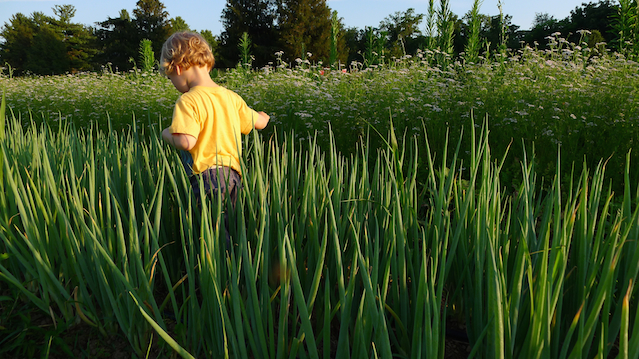
Gabe inspects the 2nd scallion planting with flowering cilantro in the background.

July 10, 2016
Wellspring of Successful CSA
By Derek McGeehan
Wellspring of Successful CSA
By Derek McGeehan
With approximately 60 CSA members scattered over 3 2-hour overlapping shifts - with an added hour to finish up at the end - all of the 2016 garlic was harvested and either hung to cure or pruned and put in the cooler. This was truly a community endeavor with so many helping hands taking part in the process. We had a few hiccups such as a flat truck tire and wood beams collapsing in the barn under the weight of the garlic. But, we all came together to see the job through. We're sincerely thankful for the help of the community to see this accomplished and especially to have some help at the end with the barn problem - that was a bit unnerving to say the least. Farm work and life is frantic this time of year but the support of the community of members helps the farm get through these very busy times.
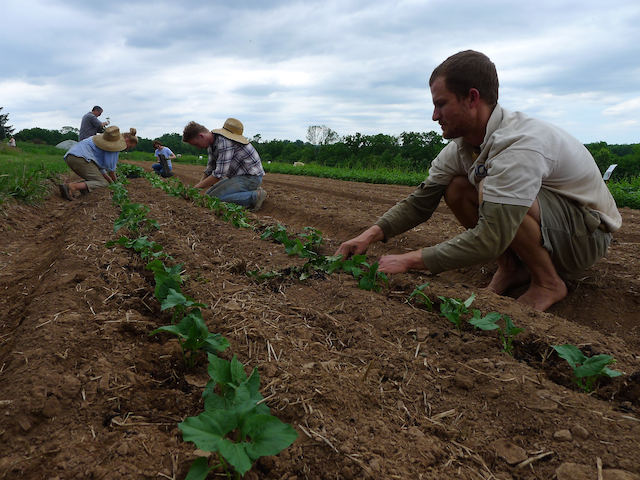
Earlier this week on Independence Day a workshift helped transplant beans, dill, cilantro, and parsley.
Over the weekend we received 3 inches of rain, more than we received in the whole month of June, and the same amount we received in March and April combined. We needed the rain for sure, but not so fast in such a short burst. When it falls that quickly the ground cannot accept it, so a lot of runs off and carries soil with it, most unfortunately. A couple of the fields acquired a minor gully where there was a natural swale present that ran through the field. It hurts to see soil wash downhill but we'll do what we can to pull it back up with the help of our tractors. We'll also adjust our bed lengths to end where the swale begins and leave a permanent cover of grass there to mitigate future erosion. It was quite an eventful weekend. Thanks again to our wonderful CSA members!

July 3, 2016
Water Does Fall From the Sky
By Derek McGeehan
Water Does Fall From the Sky
By Derek McGeehan
The farm fortunately received about 1.8" of rain last week, with the majority falling in about an hour on Tuesday night. Rain that falls early on in the work week sometimes feels like a mixed blessing because although we earnestly want and need the rain, we know we have a lot of outside work to do and don't want to be kept from the fields for too long. The 1.3" we received Tuesday night came right after we planted 3,000 of the 6,000 strawberry plants, so we still had a lot more to do the following day. The ground was parched enough that it swallowed up most of the moisture pretty quickly and by Wednesday afternoon we were able to resume planting. Many thanks go out to the CSA members that helped with this very large task!
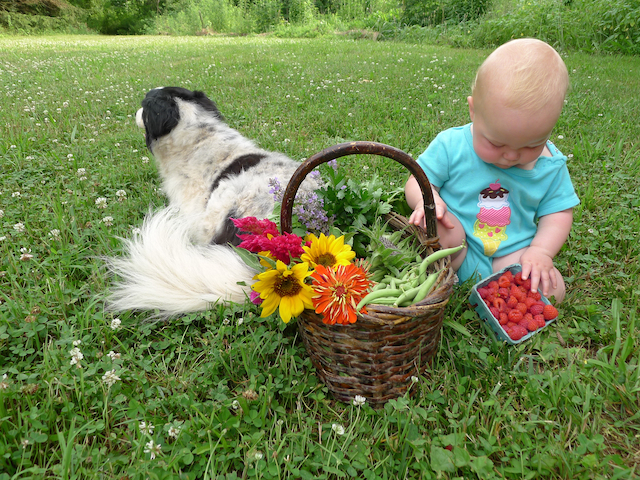 Abigail and Borchie relax with last week's u-pick haul which included a 1/2-pint of raspberries, 2 quarts of green beans, 10-stem flower bouquet, and 2-handfuls from the herb garden.
Abigail and Borchie relax with last week's u-pick haul which included a 1/2-pint of raspberries, 2 quarts of green beans, 10-stem flower bouquet, and 2-handfuls from the herb garden.During this upcoming week we're planning to transplant the 5th succession of beans, the 13th and 14th installments of lettuces, and the 4th iteration of cilantro, dill, and parsley. We're also hoping to retrieve the rest of the cabbage from the field and begin harvesting the next round of carrots, which were seeded about a month after the high tunnel patch. If all goes well, it looks like carrots will be a part of the share for another month or more. We're striving for another seeding in early August that will be harvested in October or November. This seeding will happen after weed seeds discontinue their germination due to the waning daylight and their lack of ability to mature in time before the first frost and freeze. Carrots take painfully long to germinate and have a very difficult time outcompeting weed pressure. Regardless, enjoy your Independence Day celebrations!

June 26, 2016
Still Hot, Still Dry, But...
By Derek McGeehan
Still Hot, Still Dry, But...
By Derek McGeehan
We did receive a tenth of an inch of rain at the farm on Tuesday evening, after a full day of transplanting lettuces, beans, summer squash, cucumbers, celeriac, chard, and leeks. It might have been enough moisture to quell some stress for us farmers and our plants for about twenty minutes and at least provide for a dramatic sunset amid steamy evaporation. Two weeks in a row now forecasters and their computer models have predicted rain on a Thursday and have been incorrect. Let's hope they don't make it three in a row this Tuesday because I want a day off from irrigating. Of course, what we truly need is an all day light rain soaker so the water can percolate down through the soil to the roots. What we'll actually probably receive is a downpour that departs as quickly as it dumps. Alas, most of the crops are happy and it has been a great season thus far, so ultimately there is nothing much to complain about. We're slowing moving away from some spring greens (very slowly) and will continue to see the arrival of traditional summer crops over the next few weeks. Rain dance anyone?
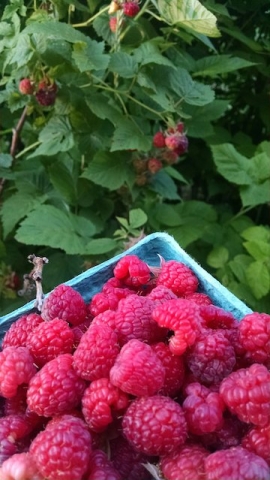
On the heels of strawberries come summer bearing red raspberries, albeit in much smaller quantities (1/2 pint).

June 19, 2016
Let's Irrigate
By Derek McGeehan
Let's Irrigate
By Derek McGeehan
Strong and dry winds, a missed rain event, and mid-90 degree heat forces us to extract water from our well for plants' water needs once again. We try to rely on irrigation as a last resort and this is one of those times. No serious rain is in the 10-day forecast which means we'll probably be irrigating for a while. Our 300-feet deep well and 1.5 horsepower pump provides about 75 gallons per minute of water. A few years ago we installed 3000 feet of 3 inch underground pipe with about 12 multi-head risers to more easily access water and keep necessary water pipes out of the way. The underground pvc pipes also reduce friction and pressure loss compared to the 2 inch flexible flat tubes that we previously had to use to move water long distances. Still, setting up and moving around drip tape, sprinklers, the water cannon, and tubing as well as all of the necessary connecting equipment means less time for other jobs and/or no time or days off (which is rare anyway this time of year). Spending time setting up all of the infrastructure feels like lateral movement and not necessarily progress towards the end of the season, but observing satisfactory results from the addition of water and subsequent higher crop yields makes it worthwhile.
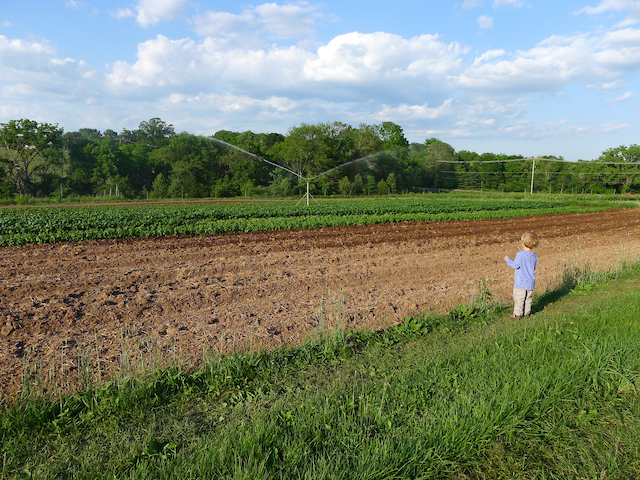
Gabe watches as our rotating 100+ feet diameter water cannon irrigates the soon-to-be u-pick field that includes snap beans, edamame, and annual herbs.

June 12, 2016
The Next Phase
By Derek McGeehan
The Next Phase
By Derek McGeehan
Summer is about to officially begin but we're already thinking about fall, oddly enough. This week in the greenhouse we seeded fall cabbages and beets which won't be mature until September and October and some will be stored to get us through the winter. As CSA farmers it feels like we live in the past, present, and future because we're always managing diverse crops with varying maturities while preparing fields for plantings weeks and months and years in advance. Spring crops are still rolling in, summer crops are about to start, fall crops are now being seeded and planted, and 2017 strawberry plants will go in the ground later this month. Years? Well, on Friday with the help of a workshift we transplanted asparagus plugs that were started from seed the first week of March. Before we were able to plant we had to meticulously scout for the eggs and larvae of the asparagus beetle and squish these critters with our fingers. These asparagus spears won't be harvested until 2018 or 2019. This part of the farm had been fallow since 2014 and was slowly transitioned to raised beds starting in March. It takes a long while to eradicate the grass species that slowly take over fallowed fields.
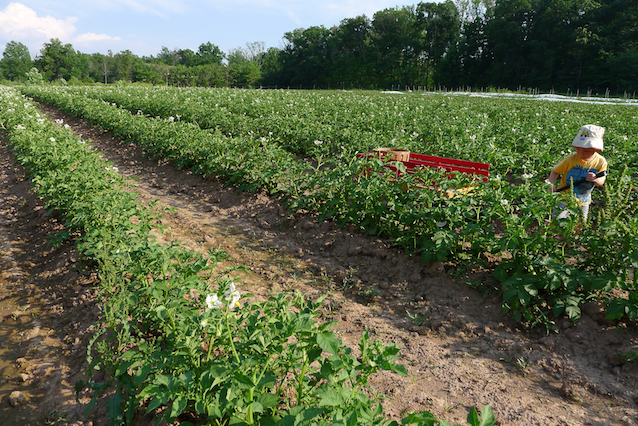
Potato plants are flowering and need another round of cultivating and hilling with the tractor. Gabe mingles.
Speaking of the blending and mixing of seasons, sweet potato slips as well as succession plantings of beans, lettuces, basil, dill, cilantro, and parsley were planted last week with tremendous help from farm members. One of the best aspects of a CSA farm is the involvement of the community to help the farm succeed which in turn feeds its members. This is an essential tenet of CSA but of course the CSA model is fluid like everything else and can be interpreted in a multitude of ways. Personally, I love the CSA model because it benefits members and farmers equally well and is centered around growing healthy food, which feels good deep down in the bones and bellies of our bodies as well as somewhere in our minds.

June 5, 2016
In the Midst of the Busiest
By Derek McGeehan
In the Midst of the Busiest
By Derek McGeehan
Last week the quantity and pace of work seemed to double and our amazing crew responded in kind. Everything has been growing exponentially with the long days, heat, and little bit of rain. Weeds, crops, bugs, everything has recognized that it is truly safely late spring and is attempting to maximize activity during the brief months between frosts and cold. Our job is to stay on pace and to forever try to get ahead. It is very easy to feel overwhelmed and get behind on the job list. But, after walking the farm this morning while making our weekly job list, it feels like we're currently in a safe position. If the rain skips us today, or the storms are too severe for our liking, we may reevaluate. This time of year the job list is basically infinite, but with proper planning and prioritizing - which is aided by the experience of farming here for 8 seasons now - we're able to cope and hopefully mostly keep our cool.
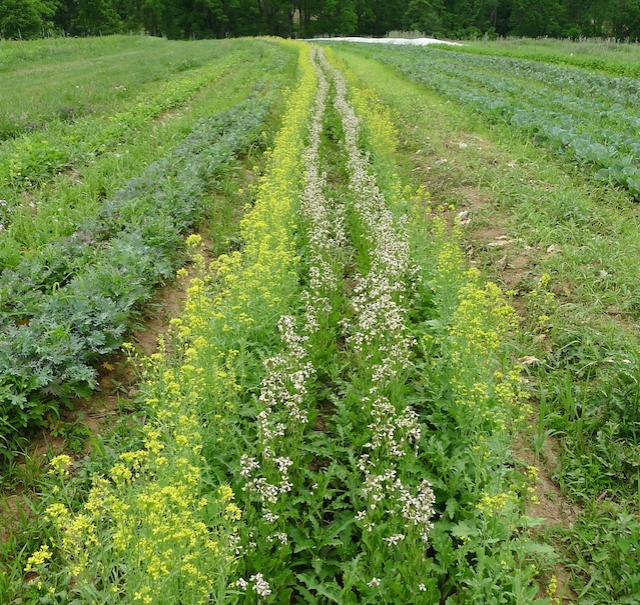
What happens to those spring greens after they're cut? Like most living things they try to reproduce, and at least the mizuna, arugula, and broccoli raab pictured above attract beneficial insects and are nice to look at.
Soon we'll transition from a lot of planting to a lot of harvesting, crops like garlic, onions, potatoes, squash, tomatoes, peppers, eggplant, that only go in the ground once but are harvested over extended periods of time. So far the season feels like a good one and hopefully it will stay that way. Give us ample rainfall, normal bug and disease pressure, few 90 degree days, no 90+ degree days, no hurricanes or tropical storms, and we'll make it through with robust yields of healthy organic crops. I'm excited that beets are here, carrots are close, garlic scapes are starting to show, and peas are ripening. What better way is there to spend one's time than around the immediate gratification derived from fresh and tasty food?

May 29, 2016
Respite from the Heat
By Derek McGeehan
Respite from the Heat
By Derek McGeehan
I haven't checked the rain gauge yet this morning, but I'm almost desperately hoping we received something close to the amount that was predicted (1-2"). I didn't hear any heavy rain overnight, so I'm preparing to be disappointed. I spent a lot of the weekend doing this week's worth of tractor work and field preparations anticipating wet soil all week. We have about 5000 feet of winter squash, melon, summer squash, and cucumber to plant this week, along with 800 feet of edamame and the weekly 175 feet of lettuces. To stay on schedule, which is of the utmost importance for farm sanity, all of the planting space had to be readied prior to the rain event. For all of the crops that means mowing cover crops, chisel plowing once or twice, raised bed shaping three times while adding soil nutrients, drop spreading minerals, laying plastic mulch for the vining crops, and then pre-making holes in that mulch for water penetration. Even if the rain turns into a dud and disappointment, at least some work is checked off the to-do list. And at least the heat wave is over. And strawberries are here. And peas will be here soon, too!

Abigail is the motivator for quick and thorough washing of these delectable spring radishes.

May 22, 2016
A Farm Scene
By Derek McGeehan
A Farm Scene
By Derek McGeehan
A wonderful perk of living and working on an organic produce farm is our daily interaction with wildlife/nature/creatures/critters/other inhabitants of earth. The contrast between winter and summer is so apparent with the return of spring and summer that the quietness and solitude of winter feels and seems so drastically drab and dreary (but of course carries other types of perks). As farmers, we constantly and consistently interact with the world in a way that coaxes food from the soil for us to eat. Whenever we plow, bed shape, cultivate, or pull weeds we're mingling with that 'natural' world that occurs whether or not we participate. The cycle of life begins and ends every day around us and we try to understand and appreciate it, respect it, while simultaneously understanding the need to run a sustainable small farm business. Farm-scapes, farm-scenes are an interplay of humans' sculpting their environment and that persistent other component, nature. It's a pleasure, and humbling, to be in the middle.
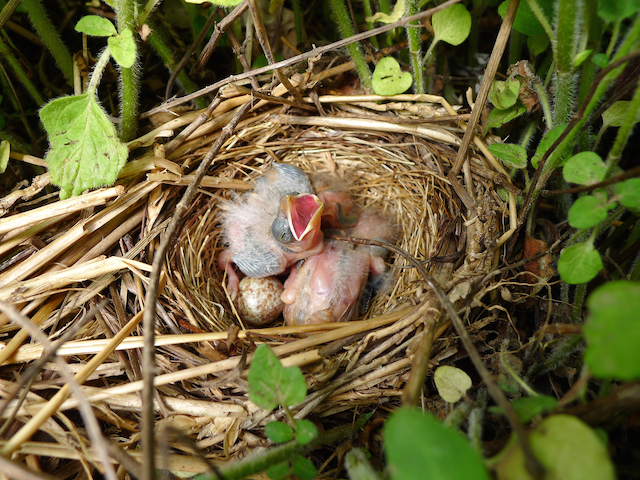
Nestled inside the oregano patch in the herb garden, freshly hatched song sparrows await mama's return with some grub(s).

May 15, 2016
First Harvest, Last Frost
By Derek McGeehan
First Harvest, Last Frost
By Derek McGeehan
Good feelings and a bit of anxious energy permeate the start of the new harvest season as we grow accustomed to the new routine of harvesting several days each week. It is a pleasure to begin retrieving the fruits of our labor from the past several months and especially to begin eating all of the tasty produce. This year we're also dealing with a potential late final frost that of course falls on the first harvest day of the season. And of course we spent many hours last week transplanting many of our summer frost-sensitive crops like tomatoes, peppers, beans, basil, and corn. So, besides getting ready to begin the harvest season amid the myriad of work that that entails, today we also get to scramble around trying to cover as many susceptible crops as we can. At least the sun is shining and it looks like it will be a beautiful spring day.
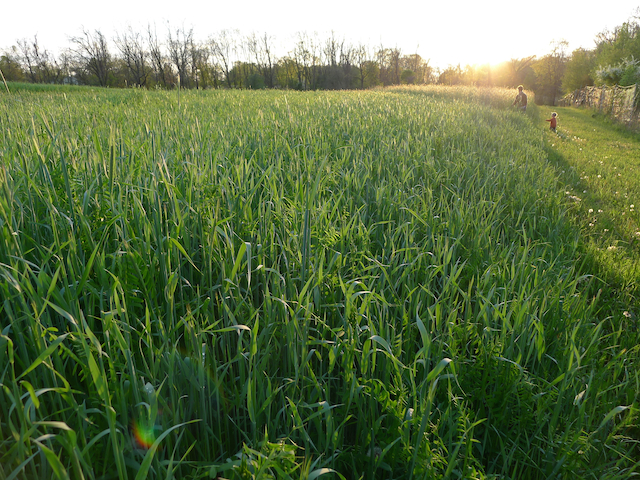
A cover crop of winter rye and hairy vetch protects the soil, adds organic matter, fixes nitrogen, and is fun to walk through at sunset.

April 8, 2016
Into April We Go
By Derek McGeehan
Into April We Go
By Derek McGeehan
March was very kind to us. April? Well, let's just say every season presents a new set of challenges to deal with. Our crop seeding and planting schedule is based on the local climate and temperature averages as well as good old experience (with mistakes), and for our first seven seasons here during the first week of April we've been able to transplant the first round of crops outside and move other crops from the heated greenhouse to the unheated hoop house to harden off under one layer of plastic for protection. Surprise, surprise. This year we had a low of 22 degrees on Wednesday morning. Ground that had been opened up with the chisel plow to dry out was frozen solid enough that our disk harrow wasn't able to penetrate. However, after the sun had sufficiently warmed the air and the soil of the raised beds they'll call home over the next two months, Adam, Hannah, Mary Liz, and I were able to officially commence the 2016 growing season with the first round of transplants (peas) going into the ground. After peas we transplanted spinach, beets, kohlrabi, cabbage, kale, collards, and chard. Then, at about 6pm we spent the next hour or so covering with row cover anchored by sandbags the 23,000 square feet we just planted. With another forecasted low in the mid-20s on Saturday, as well as snow, we're hoping, desperately, that the spun polyester fabric cover will protect the plants enough to keep them above the cold-death temperature threshold. As of now the jet stream roller coaster is forecast to continue through the end of next week. Alas, there is hardly a dull moment on the farm this time of year but we have been able to mostly stay on the planting schedule. The aster family crops (lettuces, chicories) were the only ones we postponed this week but should have ample time to transplant them this coming Monday before the next round of precipitation.
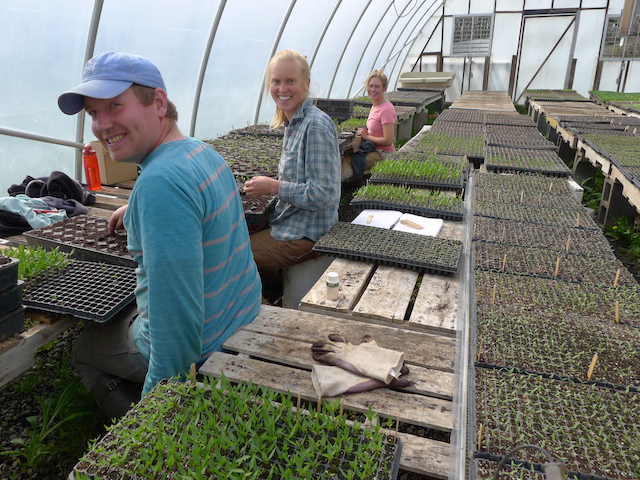
After a physically exhausting 10 hour day of transplanting, a brief respite of greenhouse work does the body good. Here, Adam, Mary Liz, and Hannah pot up heirloom tomatoes, sweet and hot peppers, asparagus, and celery.

February 23, 2016
Farm Upgrades and Updates
By Derek McGeehan
Farm Upgrades and Updates
By Derek McGeehan
This winter is quickly coming to a close and the 2016 growing season is about to be officially underway. Over this past month we welcomed our first 2016 crew member and farm manager, Hannah, to the farm. She will be living onsite with her husband in the White Pine Ranch and has been very busy helping out already. A Bucks County native, she arrives with three years of CSA farming experience in Maryland and hopes to run her own small farming business in the future. We're hoping we can help her along that path while also learning from her while she is here. Already it has been very helpful to us having someone onsite with a lot of prior CSA farming experience. Over the next couple of months we'll post more detailed bios of our 2016 farm staff, who we're very excited and enthusiastic about, and will be welcoming to the workload in March, April, and May.
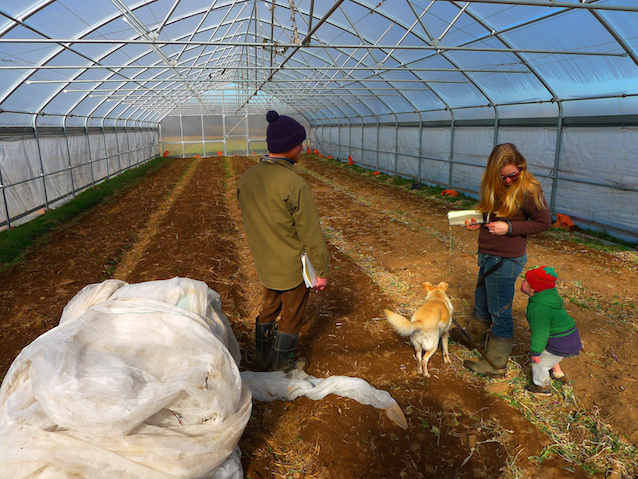
A view of the inside of the high tunnel where carrots will soon make their home. Gabe plays peekaboo.
Over the past month the greenhouse has been cleaned up, organized, and weeded so we can begin seeding our spring crops next week. Five to six weeks later they'll be planted outside in the fields after hard freezes are over, typically in early April. The five beds in the high tunnel are almost ready to house a carrot seeding. The debris left over from our winter greens was removed and raised beds were re-prepared. After hoping to trick some weed seeds into germination over the next week, we're planning to cultivate the beds one final time and then seed carrots for late spring or very early summer harvest. Typically we seed carrots outside in early April, so this will give us a 6-week head start. Hopefully this experiment works!

February 1, 2016
An Early Start To The Season
By Derek McGeehan
An Early Start To The Season
By Derek McGeehan
In less than a month the greenhouse will be in full production mode as we begin seeding and nurturing crops for the 2016 season. This will be our 8th season at Anchor Run (13th overall CSA season) which has come and gone in the blink of an eye. We're looking forward to making small improvements around the farm, in the pick up room, in the fields, everywhere we can. We have a good crew lined up to work here this year; all have prior farming experience and aspire to be involved in farming in their futures. This puts a bit more pressure on us as employers and farmers to make sure we can provide a good learning experience, live up to expectations and satisfy the reputation of Anchor Run CSA. Pretty soon we'll finalize our crop seeding, planting, and ground preparation schedules as well as the crop rotation master plan. By the end of this month we'll have to decide the number of members we want to have picking up at the farm each week. Last year we had around 250; this year we're considering 200 or 225. This number is important because it determines how much produce to grow. Of course, growing extra is our best insurance policy to ensure members receive enough.

January 17, 2016
Authentically Winter
By Derek McGeehan
Authentically Winter
By Derek McGeehan
About now it feels the way a Bucks County winter should and in the forecast could be our first real snow of the season. Weekly it seems that temperatures dive into the teens one or two nights with a couple of days staying below the freezing mark as well. As part of the jet stream roller coaster we also are able to thaw out over a couple of days in the mid and upper 40s. The sustained cold of the last two winters was a bit drab, but I am thankful that at least the month of January has provided a break between growing seasons with some real cold. This week we're hoping to make a serious dent in the high tunnel kale when it warms up enough during the day to thaw it out and make it harvestable. It basically freezes and wilts and lays almost flat at night but after the warmth of the sun's rays heat up the high tunnel it perks up and is ready for harvesting.
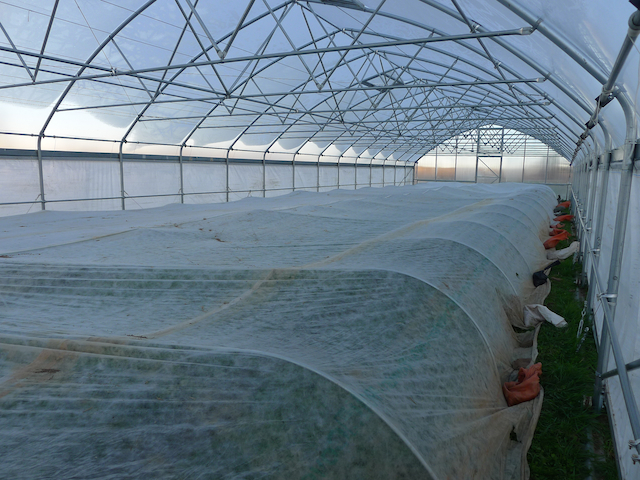
Two layers of protection almost guarantees the survival of greens in the high tunnel, without any supplemental heat.

January 9, 2016
Survived The Deep Freeze
By Derek McGeehan
Survived The Deep Freeze
By Derek McGeehan
The bitter cold was bittersweet and just part of the weather rollercoaster ride that we have fun experiencing as farmers. We need deep cold to kill some of our cover crops like oats and daikon radish so that we can use those field areas in the early spring without extra tractor work that live plants would require. The cold also sets back bad bugs and hopefully rids the area of plant diseases that affect our cucurbits and nightshades among others. It also gives us farmers a mental break between seasons and reminds us that winter isn't so bad. The cold did finally end the lives of many farm crops that were lingering but spared some roots and all of the high tunnel greens. Before this blast of cold we harvested all of the remaining field crops that we didn't think would survive as well as the mature arugula from the high tunnel. We added hoops and another layer of fabric protection in the high tunnel to preserve the mixed greens, kale, and arugula in there. As daylight slowly increases and approaches 10 hours we'll see new growth from crops that did survive.
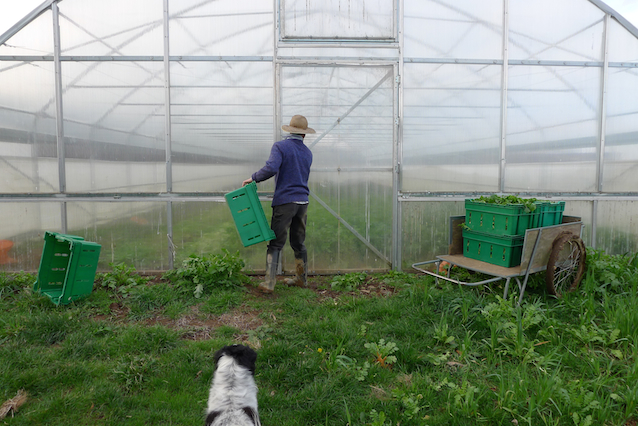
Rescuing the arugula from the high tunnel right before the deep freeze occurred. Due to its maturity it would have been damaged so we harvested all of it as fast as we could. The plants themselves survived and should regrow.

December 20, 2015
At The Winter Solstice
By Derek McGeehan
At The Winter Solstice
By Derek McGeehan
As we approach the winter solstice it almost feels like winter is actually arriving this weekend, but next week temperatures are supposed to climb right back up into the 60s. I'm basically used to the balmy weather now and easily forget what time of year it is. For example, last night a low of 28 degrees was forecast and I was thinking about shutting the drop down sides of the high tunnel. I quickly forgot to do so, hopefully because I haven't had to shut it in about a month. I woke up suddenly this morning around 5am realizing I forgot, raced out to the tunnel with a headlamp expecting to see cold and frozen greens, but was welcomed by perky and happy kale and arugula. I shut it anyway just to be safe, but then noticed one of our young barn chickens was missing so the warm and fuzzy feeling evaporated with another concern. Now that it is actually light out hopefully she'll come out of hiding.
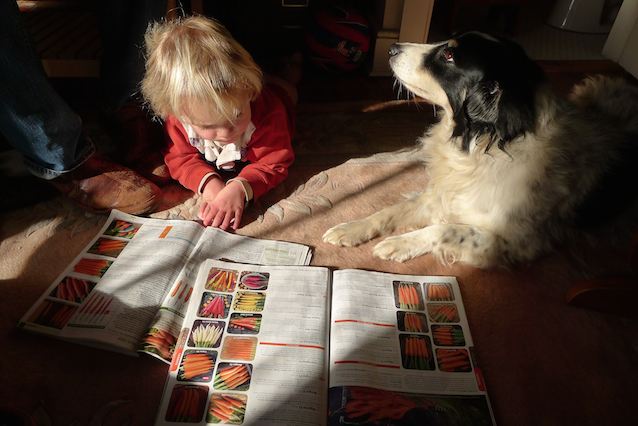 Gabe and Borci ponder the many carrot varieties to choose from. Required qualities for us to grow: tolerate heavy soil; strong tops to ease harvest; sweet, great flavor; organic, non-GMO; and around 6" long.
Gabe and Borci ponder the many carrot varieties to choose from. Required qualities for us to grow: tolerate heavy soil; strong tops to ease harvest; sweet, great flavor; organic, non-GMO; and around 6" long.Coinciding with the solstice this week is our 32nd and final harvest pick up of 2015. Thirty-two weeks sounds like a long time and takes us all the way back to May. It has been a fun, challenging, rewarding, edible ride and now we can look forward to 2016. Our work is starting to reflect the change of seasons and years; we're beginning our seed order and starting to think about our crop plans for next year as well as interviewing and hiring our farm crew. Working on the seed order is a mostly pleasant job. It involves dreaming about a perfect season with perfect growing conditions and nice, bountiful harvests. We have to temper unrealistic expectations (like carrots in the share every week) but really realistically brainstorm ways to improve (like having carrots in the share for perhaps 8, 10, or 12 weeks). We need to decide what no one but us and maybe a few other members enjoy eating (like dandelion greens) and ask ourselves "is it worth growing?". How do we improve the share and fully satisfy our CSA members? Does everyone like this or should it be a choice? Should we try spinach again? What do members really want each week? How can we please everyone? Are the shares too big? It is the time of year to dream, because, in theory, this is when we make most of our decisions for the following season. Ah, those airbrushed and enhanced veggies in the catalogues look so appealing, but do they taste good? Thanks everyone for another great year!

December 13, 2015
Springtime in December
By Derek McGeehan
Springtime in December
By Derek McGeehan
A record breaking high temperature today of 70 degrees, windows on the house open, only 9 hours or so of daylight, the sun extremely low on the horizon, and no chirping insects or birds. Quite an interesting combination for the middle of December, though I'll repeat that continuing to harvest fresh outside greens is a very nice treat. This will be the final week for lettuces, however, because the mature heads did sustain some frost damage whenever it was actually cold enough to do that and their quality is going downhill. Fear not, though, because kale, arugula, collards, cabbage, spinach, and a few other fresh greens are still looking grade A and harvestable. I do wonder if we will ever have an actual winter this year and we must, right? Can we rely on that consistency, or will this season fully blend into next season without an end to the growing season? I see in the news media that leaders from around the world got together to figure out the climate change issue and perhaps devise some way to curb global temperature rise at 3.6 degrees fahrenheit. Right now that feels relevant but last year at this time when the northeast US was the only place in the world with below average temperatures I was definitely wondering.
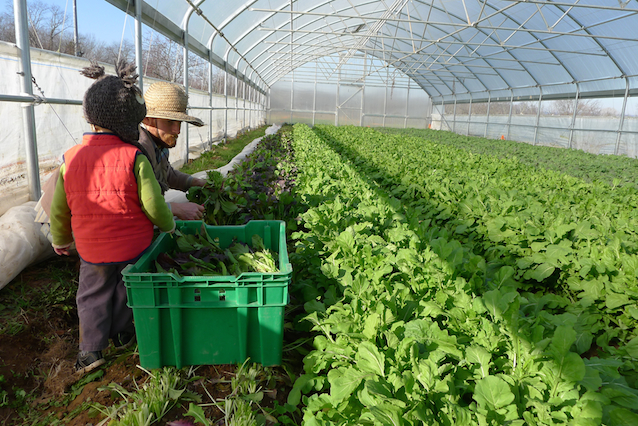
The greens in the high tunnel are holding their beauty. Meanwhile I show Gabriel how to harvest mixed greens.
Here on the farm we're mainly focused on growing crops organically (only certified by you) and trying to improve and sustain soil health and quality while also attempting to limit our fossil fuel reliance. We don't use draft horses yet but Dana does keep bringing that up. In a perfect world it would be nice to farm completely in balance with Mother Nature but someone will have to define for me what that means exactly. Let's all do our best to keep the planet healthy for our kids and theirs.

December 6, 2015
Thanking El Nino
By Derek McGeehan
Thanking El Nino
By Derek McGeehan
A mild winter may hurt us next season in the form of bugs and crop diseases and perhaps less hibernation, but it sure feels nice to continue harvesting fresh crops this late in the year. Every time I look at the 10-day forecast and there are no temperatures predicted to drop much below 30 degrees - as well as highs in the 50s - I feel a little giddy, especially now since that puts us safely into the middle of December and closer to the Solstice. I really wouldn't mind extending the harvest beyond the end of this month and if the weather allows us to do so we just might take that leap. If we have crops in storage and crops outside that have continued to survive and thrive, why shouldn't we continue the CSA? Of course, we will need to identify a pick up schedule and all of that, but we're hoping that at least some of you, our members, would want to continue to eat nutritious produce from just down the road after the New Year.
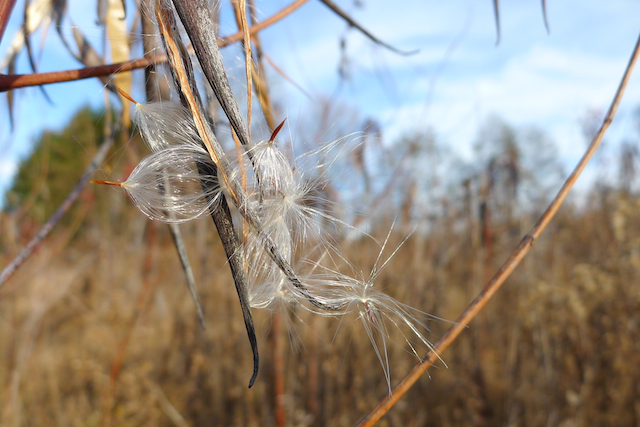
These seeds are ready to take flight from an unknown plant that is found in large numbers in one of our meadows.
At some point it will get colder and it will become harder to keep the fresh crops alive, but we have the ability to cover them with hoops and fabric. The greens in the high tunnel will survive outside lows in the teens and most of the cold-hardy unprotected crops are good into the mid-twenties. Roots like rutabaga and radishes will probably survive even lower. Somewhere in our minds we've always wanted a year-round CSA and four years ago began offering the 6-week Late Fall CSA, which was an initial venture. The next step would be experimentation with growing and distributing later in the winter and into spring. I love the idea of a continued harvest and if this allowed the farm to scale back somewhat during the extremely busy time of year by balancing out income throughout the calendar, I think that would contribute to the long-term viability of the CSA. We'll keep you updated.

November 29, 2015
Into December We Go
By Derek McGeehan
Into December We Go
By Derek McGeehan
December arrives this week with a continued forecast of above average and mild temperatures. We're definitely not complaining because it is wonderful to continue harvesting fresh crops from the fields. Some crops that we've been seeing for a while come to an end this week: cauliflower, radicchio, probably sweet potatoes. A few crops make a triumphant return, too: greens mix, collards, beets. The kale you'll be receiving this week is the curly leaf variety that is harvested with one cut on the stem. Most of the cold hardy crops that have survived this far into the season that remain unprotected (curly and russian kale, collards, napa cabbage, regular cabbage, rutabaga, turnips, radishes) appear to be set to make it into January. The greens mix this week comes from the high tunnel. This crop, when mature, doesn't tolerate low temperatures as well as the arugula and kale that it shares the space with so we're harvesting it now while it looks perfect. Next week we'll start on the arugula in there, too, after we finish the patch that remains in the field. We hope all of you had a nice Thanksgiving!
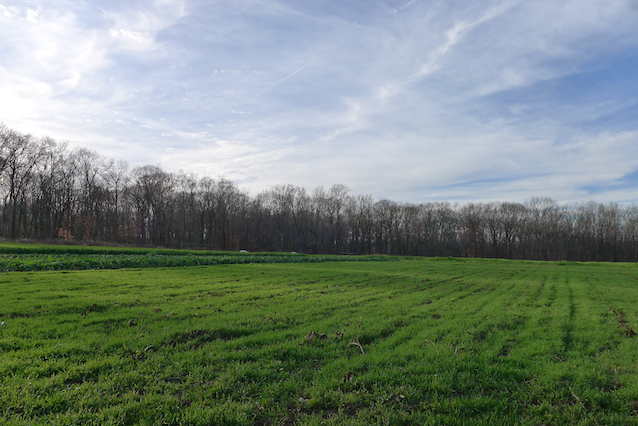
A big sky and a protective winter rye and hairy vetch cover crop, a scene from late fall.

November 22, 2015
Cold Heading Our Way
By Derek McGeehan
Cold Heading Our Way
By Derek McGeehan
The deepest cold of the season thus far is forecast for early this week, followed by a return to above average temperatures. It will be interesting to observe what the actual low bottoms out at here at the farm; normally we're below the forecasted low. We will also be wondering if the next magical temperature threshold will be passed - about 25 degrees - where mildly sensitive cold hardy crops with a higher water content are damaged. I think they'll be okay. Soon it will be December and by then only the toughest and strongest should survive anyway. Plus, having a reduced footprint to think and worry about is always a slight relief.
I'm still measuring rainfall at the farm, which feels rare for this late in the season. I normally cease when we either begin to receive snow and/or frequent heavy frost or I mentally feel tractor work is completed for the season. I must still be holding out for some final flail mowing and light tillage of some fall crops to either break up the pest cycle or get a jump on spring growing. That last part I really don't want to fully acknowledge now because it is way too early to begin thinking about the next growing season. Of course pretty soon we will fully embrace planning and preparing for next year by buying seeds, ordering supplies, updating our crop rotation and planting schedules, as well as finalizing our CSA plans and employment needs. For now, though, we're thankful for the 1.2 inches of rainfall, bright starry night skies, drying wind, continued harvests, and of course family time. Happy Thanksgiving!

November 15, 2015
The Next Chapter
By Derek McGeehan
The Next Chapter
By Derek McGeehan
We're embarking on the 4th annual Winter CSA this week amid what feels like a mild autumn. This was the type of autumn that initially inspired us to extend the growing season and offer additional CSA shares and was also what we enjoyed during the first season, 2012. The two years in between this year and the first felt more like growing produce in January and February, not November and December. Can we thank El Nino? Or is this more normal? I'm not sure. After 7 seasons at Anchor Run I've come to expect the unexpected, weather wise. Having too many rigid expectations would narrow our vision and allow the farm to become totally mechanized and streamlined, I perceive. We're able to withstand the vagaries of the weather and its forecast because we're diverse; we grow hundreds of varieties of crops over 9 months on perhaps 13 acres, fallowing 5 acres, rotating plant families around the farm. Crops tolerate different conditions, temperatures, moisture, so having diversity guarantees something will survive, or thrive. We're always thankful for good growing conditions.

POSTS BY TYPE
POSTS BY MONTH

